|
Meinem Lehrer und Freund Prof. Dr. Heinrich von Stietencron in Dankbarkeit gewidmet. |
Zitierweise | cite as: Amarasiṃha <6./8. Jhdt. n. Chr.>: Nāmaliṅgānuśāsana (Amarakośa) / übersetzt von Alois Payer <1944 - >. -- 2. Dvitīyaṃ kāṇḍam. -- 5. vanauṣadhivargaḥ II. -- 2. Vers 23 - 43. -- Fassung vom 2010-12-31. -- URL: http://www.payer.de/amarakosa/amara205b.htm
Erstmals hier publiziert: 2010-10-26
Überarbeitungen: 2010-12-31 [Verbesserungen] ; 2010-11-16 [Ergänzungen] ; 2010-11-01 bis 03 [Ergänzungen] ; 2010-10-19 [Verbesserungen]
©opyright: Creative Commons Lizenz (Namensnennung, keine kommerzielle Nutzung, share alike)
Dieser Text ist Teil der Abteilung Sanskrit von Tüpfli's Global Village Library
|
Meinem Lehrer und Freund Prof. Dr. Heinrich von Stietencron in Dankbarkeit gewidmet. |
Falls Sie die diakritischen Zeichen nicht dargestellt bekommen, installieren Sie eine Schrift mit Diakritika wie z.B. Tahoma.
Die Devanāgarī-Zeichen sind in Unicode kodiert. Sie benötigen also eine Unicode-Devanāgarī-Schrift.
"Those who have never considered the subject are little aware how much the appearance and habit of a plant become altered by the influence of its position. It requires much observation to speak authoritatively on the distinction in point of stature between many trees and shrubs. Shrubs in the low country, small and stunted in growth, become handsome and goodly trees on higher lands, and to an inexperienced eye they appear to be different plants. The Jatropha curcas grows to a tree some 15 or 20 feet on the Neilgherries, while the Datura alba is three or four times the size in>n the hills that it is on the plains. It is therefore with much diffidence that I have occasionally presumed to insert the height of a tree or shrub. The same remark may be applied to flowers and the flowering seasons, especially the latter. I have seen the Lagerstroemia Reginae, whose proper time of flowering is March and April, previous to the commencement of the rains, in blossom more or less all the year in gardens in Travancore. I have endeavoured to give the real or natural flowering seasons, in contradistinction to the chance ones, but, I am afraid, with little success; and it should be recollected that to aim at precision in such a part of the description of plants is almost hopeless, without that prolonged study of their local habits for which a lifetime would scarcely suffice."
[Quelle: Drury, Heber <1819 - 1872>: The useful plants of India : with notices of their chief value in commerce, medicine, and the arts. -- 2d ed. with additions and corrections. London : Allen, 1873. -- xvi, 512 p. ; 22 cm. -- S. VIII f.]
Bei der Identifikation der lateinischen Pflanzennamen folge ich, wenn immer es möglich ist:
Bhāvamiśra <16. Jhdt.>: Bhāvaprakāśa of Bhāvamiśra : (text, English translation, notes, appendences and index) / translated by K. R. (Kalale Rangaswamaiah) Srikantha Murthy. -- Chowkhamba Varanasi : Krishnadas Academy, 1998 - 2000. -- (Krishnadas ayurveda series ; 45). -- 2 Bde. -- Enthält in Bd. 1 das SEHR nützliche Lexikon (nigaṇṭhu) Bhāvamiśras.
Pandey, Gyanendra: Dravyaguṇa vijñāna : materia medica-vegetable drugs : English-Sanskrit. -- 3. ed. -- Varanasi : Chowkhamba Krishnadas Academy, 2005. -- 3 Bde. ; 23 cm. -- ISBN: 81-218-0088-9 (set)
Wo möglich, erfolgt die aktuelle Benennung von Pflanzen nach:
Zander, Robert <1892 - 1969> [Begründer]: Der große Zander : Enzyklopädie der Pflanzennamen / Walter Erhardt ... -- Stuttgart : Ulmer, ©2008. -- 2 Bde ; 2103 S. -- ISBN 978-3-8001-5406-7.
 WARNUNG: dies ist der Versuch einer
Übersetzung und Interpretation eines altindischen Textes. Es ist keine
medizinische Anleitung. Vor dem Gebrauch aller hier genannten Heilmittel wird
darum ausdrücklich gewarnt. Nur ein erfahrener, gut ausgebildeter ayurvedischer
Arzt kann Verschreibungen und Behandlungen machen! Die
Bestimmung der Pflanzennamen beruht weitgehend auf Vermutungen kompetenter Āyurvedaspezialisten.
WARNUNG: dies ist der Versuch einer
Übersetzung und Interpretation eines altindischen Textes. Es ist keine
medizinische Anleitung. Vor dem Gebrauch aller hier genannten Heilmittel wird
darum ausdrücklich gewarnt. Nur ein erfahrener, gut ausgebildeter ayurvedischer
Arzt kann Verschreibungen und Behandlungen machen! Die
Bestimmung der Pflanzennamen beruht weitgehend auf Vermutungen kompetenter Āyurvedaspezialisten.
Hortus malabaricus
Hortus Indicus Malabaricus : continens regni Malabarici apud Indos cereberrimi onmis generis plantas rariores, Latinas, Malabaricis, Arabicis, Brachmanum charactareibus hominibusque expressas ... / adornatus per Henricum van Rheede, van Draakenstein, ... et Johannem Casearium ... ; notis adauxit, & commentariis illustravit Arnoldus Syen ... -- 11 Bde. -- Amstelaedami : sumptibus Johannis van Someren, et Joannis van Dyck, 1678-1703. -- Online: http://www.biodiversitylibrary.org/bibliography/b11939795. -- Zugriff am 2010-01-01
Zu den Identifikationen siehe:
Dillwyn, L. W. (Lewis Weston) <1778-1855>: A review of the references to the Hortus malabaricus of Henry Van Rheede Van Draakenstein [sic]. -- Swansea : Printed at the Cambrian-Office, by Murray and Rees, 1839.
Roxburgh
Roxburgh, William <1751-1815>: Plants of the coast of Coromandel, selected from drawings and descriptions presented to the hon. court of directors of the East India company / by William Roxburgh. Published by their order under the direction of Sir Joseph Banks <1743 - 1820> ... -- London : Printed by W. Bulmer for G. Nicol, 1795-1819. -- 3 Bde. : 300 kolorierte Tafeln ; 59 cm. -- Online: http://www.botanicus.org/title/b12006488 usw. -- Zugriff am 2009-09-19
Wight Icones
Wight, Robert <1796 - 1872>: Icones plantarum Indiae Orientalis :or figures of Indian plants. -- 6 Bde. -- Madras : published by J.B. Pharoah for the author, 1840-1853. -- Online: http://www.biodiversitylibrary.org/bibliography/92. -- Zugriff am 2010-01-01
Wight Illustrations
Wight, Robert <1796 - 1872>: Illustrations of Indian botany :or figures illustrative of each of the natural orders of Indian plants, described in the author's prodromus florae peninsulae Indiae orientalis. -- 2 Bde. + Suppl. -- Madras : published by J. B. Pharoah for the author, 1840-1850. -- Online: http://www.biodiversitylibrary.org/bibliography/9603. -- Zugriff am 2010-01-01
Kirtikar-Basu
Kirtikar, K. R. ; Basu, B. D.: Indian medical plants with illustrations. Ed., revised, enlarged and mostly rewritten by E. Blatter, J. F. Caius and K. S. Mhaskar. -- 2. ed. -- Dehra Dun : Oriental Enterprises. -- 2003. -- 11 Bde : 3846 S. : Ill. ; 26 cm. -- Unentbehrlich! -- Reprint der Ausgabe von 1933, die Abbildungen stammen aus der Ausgabe von 1918
Anacardiaceae (Sumachgewächse)
Bis 13 m hoher Baum.
| 23. a./b. vīravṛkṣo 'ruṣkaro 'gnimukhī bhallātakī triṣu वीरवृक्षो ऽरुष्करो ऽग्निमुखी भल्लातकी त्रिषु ।२३ क। [Bezeichnungen für Semecarpus anacardium L. f. 1782 - Ostindischer Tintenbaum - Marking Nut:]
|
Colebrooke (1807): "Marking nut. Semecarpus anacardium."
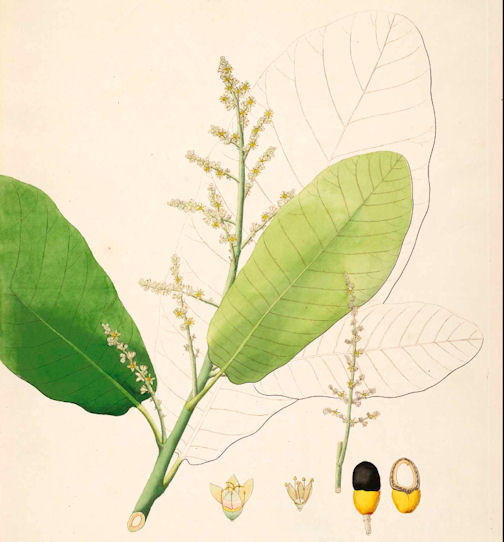
Abb.: भल्लातकी । Semecarpus anacardium L. - Ostindischer Tintenbaum - Marking Nut
[Bildquelle: Roxburgh. -- Vol I. -- 1795. -- Image courtesy Missouri Botanical
Garden. http://www.botanicus.org. --
Creative Commons Lizenz
(Namensnennung, keine kommerzielle Nutzung)]
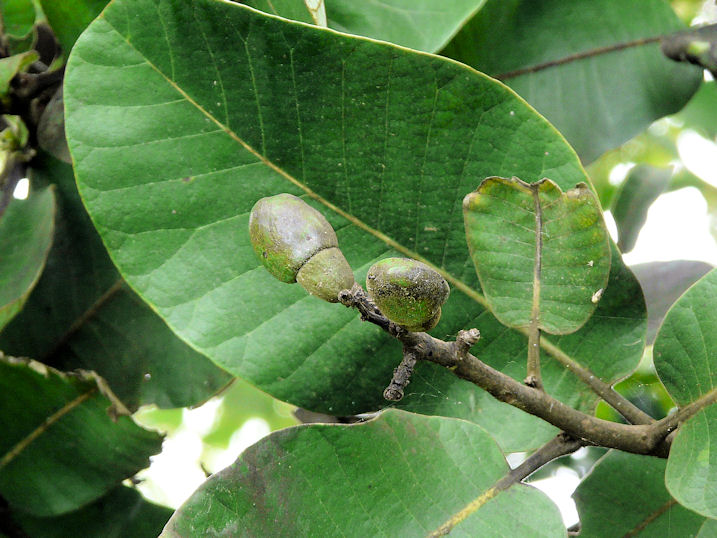
Abb.: अग्निमुखी । Semecarpus anacardium L. - Ostindischer Tintenbaum - Marking Nut
[Bildquelle: dinesh_valke. --
http://www.flickr.com/photos/dinesh_valke/2876166930/. -- Zugriff am
2010-10-02. --
Creative
Commons Lizenz (Namensnennung, keine kommerzielle Nutzung, share alike)]
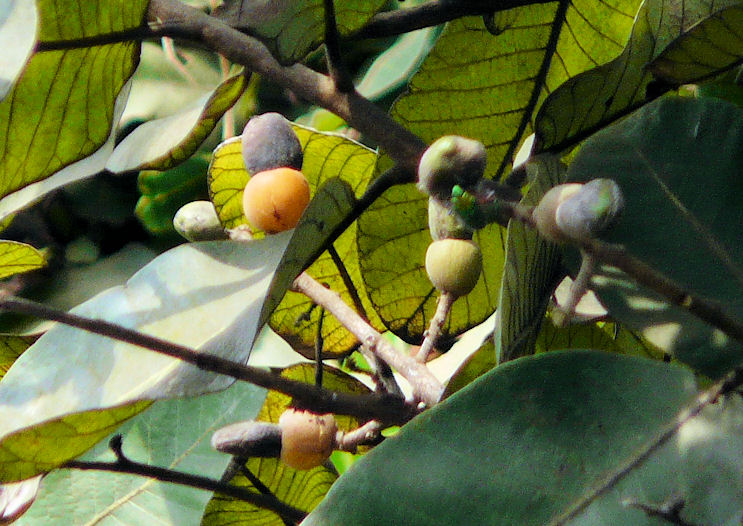
Abb.: अग्निमुखी । Semecarpus anacardium L. - Ostindischer Tintenbaum - Marking Nut
[Bildquelle: dinesh_valke. --
http://www.flickr.com/photos/dinesh_valke/3031130607/ . -- Zugriff am
2010-10-13. --
Creative
Commons Lizenz (Namensnennung, keine kommerzielle Nutzung, share alike)]
"Semecarpus Anacardium. Corom. pl. 1. No. 12. Willd. 1. I476.
[...]
Sans. Arushkara, also Bhela.
[...]
Anacardium of the Materia Medica.
A tree, bearing male or male-hermaphrodite flowers on one and hermaphrodite on another ; which circumstance might remove it from the fifth, to the twenty-third class of the Linnaean system. It is a native of all the mountainous parts of India; flowering time from May to August. Seed ripe in January and February.
Dr. König, my predecessor, who was the first that described this tree, had never met with the male, otherwise so particular a circumstance would not have been omitted by so accurate a describer as the Doctor was.
[...]
The wood of this tree is reckoned of no use, not only on account old its softness, but also on account of its containing much acrid juice, which renders it dangerous to cut down and work upon it. The fleshy receptacle on which the seed rests are roasted in the ashes, and eaten by the natives ; the taste is exceedingly like that of roasted apples. Before roasted they are astringent, and acrid ; leaving a painful sensation on the tongue for some time. The kernels are rarely eaten.
The green nuts well pounded into a pulp make good lime.
The pure black, acrid juice of the cells is employed by the natives externally to remove rheumatic pains, aches, and sprains. A little is well rubbed over the part affected. But in tender constitutions it often produces inflammation and swelling, doing much more harm than good ; but I think where it has not this disagreeable effect, which is generally the case, it is an efficacious remedy.
It is universally employed to mark, all sorts of cotton cloth. The colour is improved, prevented from running, and fixed by a mixture of quick lime and water.
The juice or resinous balsam, is not soluble in water, and is only diffusible in spirits of wine, for it soon falls to the bottom, unless the menstruum be previously alkalized ; the solution is then pretty complete, and of deep black colour. It sinks in but soon unites perfectly with expressed oils. Alkaline livixia act upon it with no better success than plain water.
It is employed by the Telinga Physicians for the cure of almost every sort of venereal complaint, and is commonly prepared as follows :
Take of this black balsam, and expressed juice of garlic, each one ounce. Expressed juice of fresh Tamarind-tree leaves ; cocoanut oil and sugar, of each two ounces ; mix and boil them for a few minutes. A table-spoonful is given to the patient twice a day. I know nothing of the efficacy of this composition.
The bark is mildly astringent, gives out in decoction a deep colour, which dies brown of various shades.
From wounds made in the bark, a dirty looking, brownish soft gum is procured, which dissolves slowly in the mouth without much taste."
[Quelle: Roxburgh, William <1751-1815>: Flora indica, or, Descriptions of Indian plants / by the late William Roxburgh. -- Serampore : Printed for W. Thacker, 1832. -- Vol. 2, S. 83ff.]
"Semecarpus Anacardium (Linn.) N. O. Anacardiaceae Marking nut.
Description.--Tree, 50 feet; [...]
Fl. May-July.
W. & A. Prod. i, 168. -- Wight Icon. t. 558. -- Roxb. Cor. i. t. 12. -- Fl. Ind. ii. 83.
Concans. Coromandel. Courtallum. Guzerat. Bengal. Travancore.
Medical Uses.—The receptacle of the fruit when ripe is yellow, about the size of the nut, which is black. The latter contains the black, corrosive, resinous juice so well known. This juice is employed by the natives to remove rheumatic pains, aches, and sprains; in tender constitutions it often produces inflammation and swelling. It is employed by the Telinga physicians in the cure of almost every kind of venereal complaint It is also given in small doses in leprous and scrofulous affections. An oil is also prepared from the kernels, used externally in rheumatism and sprains; undiluted it acts as a blister. The juice of the nut should always be cautiously handled. —(Ainslie. Roxb.) Bhilawa is the nut of a large forest-tree, which is common throughout Ifadia. The acrid viscid oil which the nut contains is used as an escharotic and counter-irritant. It leaves a mark for life. It creates great pain, and often very intractable sores; but ignorant natives, unacquainted with the blisters of Europe, have a greater dread of them than of the Bhilawa. It is given medicinally in small doses, and is considered a stimulant and narcotic, and is much used in the Masalehs of elephants. Given in large doses, it renders these animals furious. The farina of the anthers of the flowers is very narcotic and irritating; people of a peculiar habit accidentally sleeping under the tree when in blossom, or even going near the flowers, are stupefied, and have their faces and limbs swollen. The use of the Bhilawa as a counter-irritant frequently causes the whole body and face to swell with erythematous inflammation and much constitutional disturbance. The mature corolla and receptacle are fleshy and of a sweetish-sour taste, and are eaten roasted.—Irvine Med. Tap. of Ajmere.
Economic Uses.—The wood of the tree is of no use, not only on account of its softness, but also because it contains much acrid juice, which renders it dangerous to cut down and work upon. The kernels are rarely eaten. The green fruit, well pounded into a pulp, makes good bird-lime. The juice is in general use for marking cotton cloths; the colour is improved and prevented from running by the mixture of a little quicklime and water. The juice is not soluble in water, and only diffusible in spirits of wine. It sinks in expressed oils, but unites perfectly with them.—Roxb."
[Quelle: Drury, Heber <1819 - 1872>: The useful plants of India : with notices of their chief value in commerce, medicine, and the arts. -- 2d ed. with additions and corrections. London : Allen, 1873. -- xvi, 512 p. ; 22 cm. -- s.v.]
"SEMECARPUS ANACARDIUM, Linn.
History, Uses, &C.—The marking-nut, in Sanskrit Bhallataka and Arushkara (causing sores), is regarded by the Hindus as acrid, heating, stimulant, digestive, nervine and escharotic, and is used in dyspepsia, piles, skin diseases, and nervous debility. It is prepared for internal use by being boiled with cowdung and afterwards washed with cold water. The nut is also used to produce the appearance of a bruise in support of criminal charges preferred through enmity (Its application in a diluted form produces great oedematous swelling and redness of the skin), and the juice is sometimes applied to the body out of revenge, the victim having first been made insensible by the administration of narcotics. In Sanskrit medicinal works a section is often devoted to the treatment of ulcerations thus produced. When given internally the juice of the pericarp is always mixed with oil or melted butter. It is the Anacardia of Serapion. The Arabic name for the nut is Baladar, or Hab-el-talb, in allusion to its heart-shaped form.
Ibn Baitar says—
(Baladar in the Indian language is Ancardia in Greek, which means " heart-shaped.") Mahometan writers order the juice to be always mixed with oil, butter, or some oily seed when used for internal administration. They consider it. to be hot and dry, useful in all kinds of skin diseases, palsy, epilepsy, and other affections of the nervous system, the dose being from 1/4 to 1/2 a dirhem. Externally they apply it to cold swellings, such as piles; the Tuhfat notices the use of the vapour of the burning pericarp for this purpose, a practice known in Bombay; it causes sloughing of the tumours. When too large a quantity has been taken, oily and mucilaginous remedies should be prescribed. Two dirhems is considered a poisonous dose. Some persons are much more readily affected by the drug than others. Garcia d'Orta remarks that the poisonous properties of the marking-nut have been much exaggerated by Serapion, and goes on to say that in Goa it is administered internally in asthma after having been steeped in buttermilk, and is also given as a vermifuge : and moreover says he, we (the Portuguese) salt the young green fruit and use them like olives. Ainslie gives the following account of its use in Southern India: " The Hindus give the juice in scrofulous, venereal and leprous affections in very small doses; an oil is also prepared with the taut by boiling, which is used externally in rheumatism and sprains, it is of a very stimulating nature; undiluted it acts as a blister. The Telingoos have the following prescription:--Juice of marking-nut and garlic of each 1 ounce, juice of fresh tamarind leaves, cocoanut oil and sugar of each 2 ounces; mix, and boil for a few minutes. Dose—One table spoonful twice daily in syphilis, aches, sprains, " &c. Mixed with a little quicklime and water the juice is used all over India for marking linen, and the stain is far more durable than that of the marking inks of Europe.
In the Concan a single fruit is heated in the flame of a lamp and the oil allowed to drop into a quarter ser of milk; this draught is given daily in cough caused by relaxation of the uvula and palate. As an application to scrofulous glands of the neck equal parts of the juice of the marking nut, Plumbago zeylanica, Baliospermum montanum, Euphorbia neriifolia, Asclepias gigantea, sulphate of iron, and molasses are used. The juice of the root-bark is also used medicinally on account of its acrid properties."
[Quelle: Pharmacographia indica : a history of the principal drugs of vegetable origin met with in British India / by William Dymock [1834-1892], C. J. H. Warden and David Hooper [1858-1947]. -- Bd. 1. -- London, 1890. -- S. 389ff.]
Malvaceae (Malvengewächse)
Immergrüner Strauch oder bis 8 m hoher Baum.
| 23. c./d. gardabhāṇḍe kandarāla-kapītana-supārśvakāḥ 24. a./b. plakṣaś ca tintiḍī ciñcāmlikātho pītasārake
गर्दभाण्डे कन्दराल-कपीतन-सुपार्श्वकाः ॥२३ ख॥ Bezeichnungen für गर्दभाण्ड - gardabhāṇḍa m.: "Ware des / für den Hungrigen"1 - Thespesia populnea (L.) Sol. ex Corrêa 1807 - Küsten-Tropeneibisch - Portia Tree:
|
Colebrooke (1807): "Parspipal. Hibiscus populneoides, R[oxb]. [= Thespesia populnoides] Some confound these Sanskrit names with those of the Ficus venosa."
1 "Ware des / für den Hungrigen"
"Junge Blätter und Blüten werden in Indien als Gemüse oder Salat gegessen." (http://de.wikipedia.org/wiki/Portiabaum. -- Zugriff am 2010-10-14)
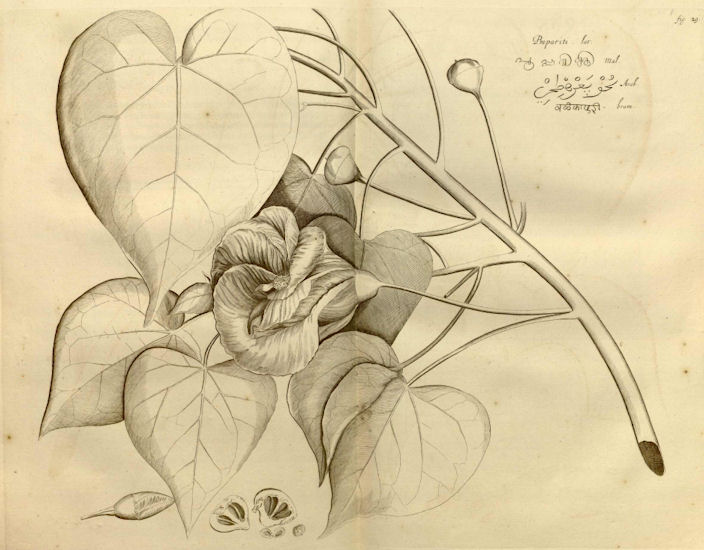
Abb.: प्लक्षः । Thespesia populnea (L.) Sol. ex
Corrêa 1807 - Küsten-Tropeneibisch - Portia Tree
[Bildquelle: Hortus malabaricus I. Fig. 29,
1678]
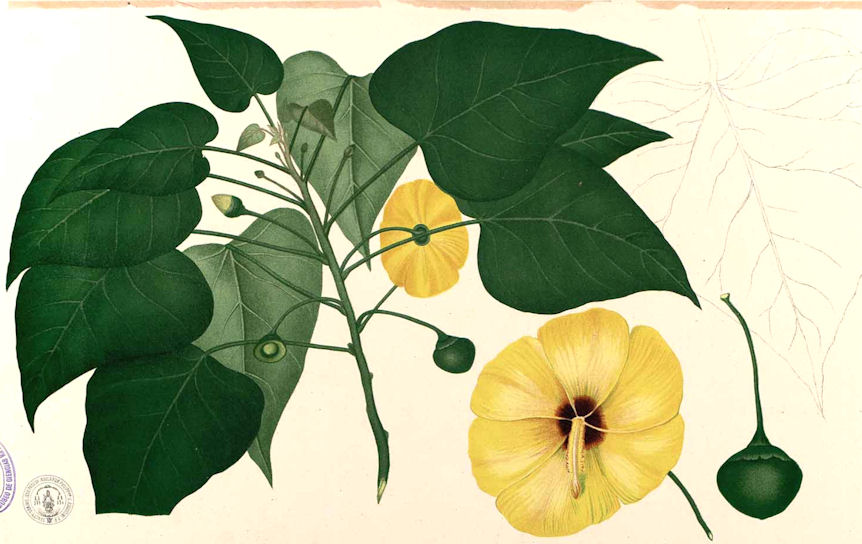
Abb.: प्लक्षः । Thespesia populnea (L.) Sol. ex
Corrêa 1807 - Küsten-Tropeneibisch - Portia Tree
[Bildquelle: Flora de Filipinas, 1880 / Wikipedia. -- Public domain]
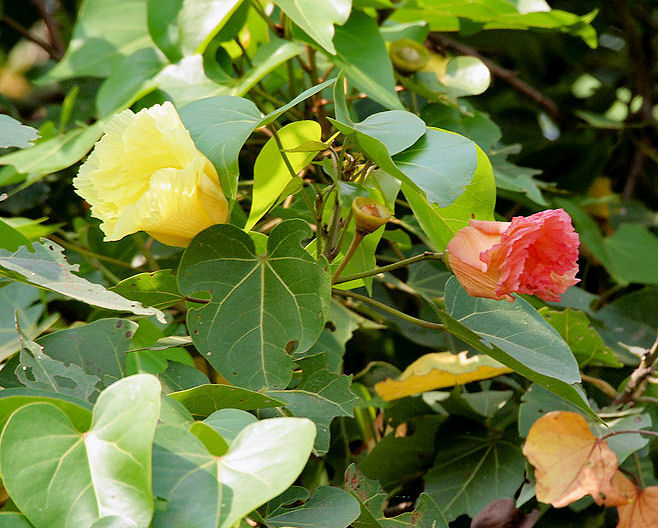
Abb.: गर्दभाण्डः । Thespesia populnea (L.) Sol. ex
Corrêa 1807 - Küsten-Tropeneibisch - Portia Tree, Krishna Wildlife Sanctuary,
Andhra Pradesh
[Bildquelle: J. M. Garg / Wikipedia.
-- GNU FDLicense]
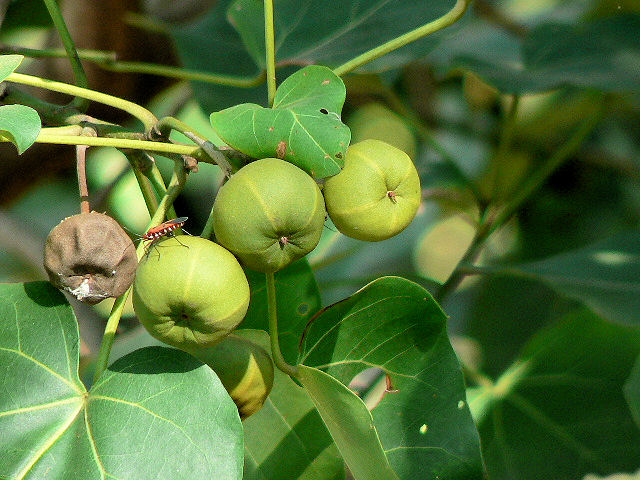
Abb.: कपीतनः । Thespesia populnea (L.) Sol. ex
Corrêa 1807 - Küsten-Tropeneibisch - Portia Tree
[Bildquelle: dinesh_valke. --
http://www.flickr.com/photos/dinesh_valke/2095676520/. -- Zugriff am
2010-10-13. --
Creative
Commons Lizenz (Namensnennung, keine kommerzielle Nutzung, keine Bearbeitung)]
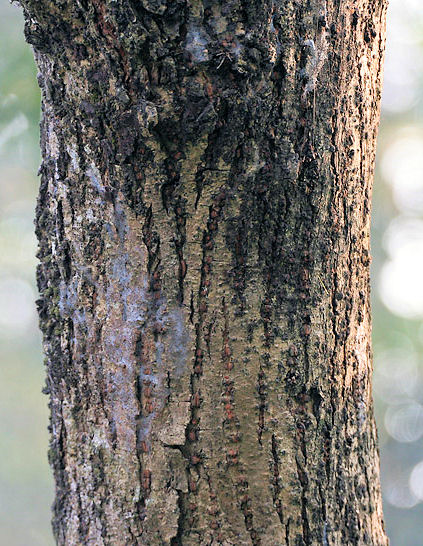
Abb.: सुपार्श्वकः । Thespesia populnea (L.) Sol. ex
Corrêa 1807 - Küsten-Tropeneibisch - Portia Tree, Kolkata - কলকাতা, West
Bengal
[Bildquelle: J. M. Garg / Wikipedia.
-- GNU FDLicense]
"Hibiscus populneoides. R. [...]
Gorda-chanda, the Sanscrit name.
[...]
This species is much like the former [Hibiscus populneus], I have found it in a few of the gardens of the natives near Samulcota ; it flowers during the wet and cold seasons.
[...]
This species is immediately to be distinguished from populneus by the glands in the axills of the nerves of the leaves, their waved border and long- points, and by the double integument of the capsule; the innermost of which requires force and a sharp knife to open it ; whereas in populneus it is single, and can be easily broken by the pressure of the thumb and finger.
This tree will answer better for avenues, parks, &c. than populneus, because it is much higher to the branches, consequently gives a free circulation to the air.
When wounded there discharges the some yellow juice as in populneus.
As both these trees want the most essential character, the double calyx on Hibiscus, I should imagine they would, with more propriety, form a new genus."
[Quelle: Roxburgh, William <1751-1815>: Flora indica, or, Descriptions of Indian plants / by the late William Roxburgh. -- Serampore : Printed for W. Thacker, 1832. -- Vol. 3, S. 191f.]
"Thespesia populnea (Lam.) N. O. Malvaceae. Portia tree.
Description.--Tree;
W. & A. Prod. i. 54.--Wight Icon. t. 8.
Hibiscus populneus, Linn.--Roxb. Fl. Ind. iii, 190.--Rheede i. t. 29.
Travancore. Courtallum. Bengal.
Medical Uses.—The capsule is filled with a yellow pigment like liquid gamboge, which is a good external application in scabies and other cutaneous diseases, the juice being simply applied to the parts affected. The bark boiled in water is used as a wash for the same purposes with the best effect The bark in decoction is given as an alterative internally. The Cingalese dye yellow with the capsules. —Ainslie. Pers. Obs.
Economic Uses.—The wood is used for making rollers, and other purposes where closeness of grain is required. It is also an excellent wood for gun-stocks. The tree is remarkable for its easy and rapid growth from cuttings. It is frequently used on this account as a tree for roadside avenues. Its wood makes pretty furniture, and is much used for the ribs of the roofs of the cabin-boats at Cochin.— Ainslie. J. Grah."
[Quelle: Drury, Heber <1819 - 1872>: The useful plants of India : with notices of their chief value in commerce, medicine, and the arts. -- 2d ed. with additions and corrections. London : Allen, 1873. -- xvi, 512 p. ; 22 cm. -- s.v.]
"THESPESIA POPULNEA, Corr.
[...]
History, Uses, &C.-—This tree is much valued on account of the toughness of its timber, which is used for carriage building. It is the Hibiscus populneus of Rumphius (III. 31), who speaks highly of the value of the heart-wood as a remedy in bilious attacks and colic, and in a kind of pleurodynia from which the Malays often suffer. The fruit abounds in a viscid yellow juice of the colour of gamboge, which the natives use as an external application in psoriasis. The leaves are applied to inflamed and swollen joints. The tree is called in Sanskrit Parisa and Gardhabhanda; it is noticed by Ainslie, who says that a decoction of the bark is given internally as an alterative to the extent of 3—4 ounces twice daily. The author of the Bengal Dispensatory also notices it, but expresses no opinion as to its properties. Several trials with this remedy were made by the Editor of the Pharmacopoeia of India in scabies and other cutaneous diseases; in some cases it exercised a favourable influence, but in the majority it was productive of little or no benefit.
According to Brannt (Animal and Veget. Fats and Oils) the seeds contain a dark red oil, known as "huile amère" which is stated to be used for medicinal purposes."
[Quelle: Pharmacographia indica : a history of the principal drugs of vegetable origin met with in British India / by William Dymock [1834-1892], C. J. H. Warden and David Hooper [1858-1947]. -- Bd. 1. -- London, 1890. -- S. 213f.]
Caesalpiniaceae (Johannisbrotgewächse)
Bis 25 m hoher, immergrüner Baum.
| 24. a./b. plakṣaś ca tintiḍī ciñcāmlikātha pītasārake प्लक्षश् च तिन्तिडी चिञ्चाम्लिकाथ पीतसारके ।२४ क। [Bezeichnungen für Tamarindus indica L. 1753 - Tamarinde - Tamarind]
|
Colebrooke (1807): "Tamarind."
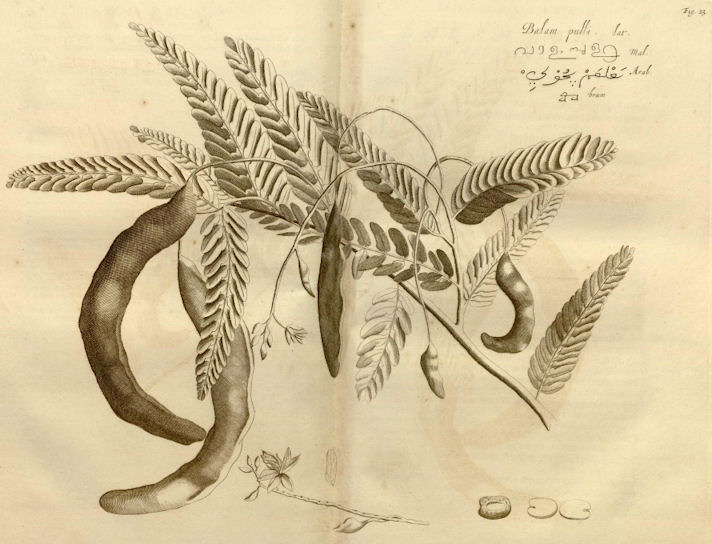
Abb.: तिन्तिडी । Tamarindus indica L. 1753 - Tamarinde - Tamarind
[Bildquelle: Hortus malabaricus I. Fig. 23,
1678]
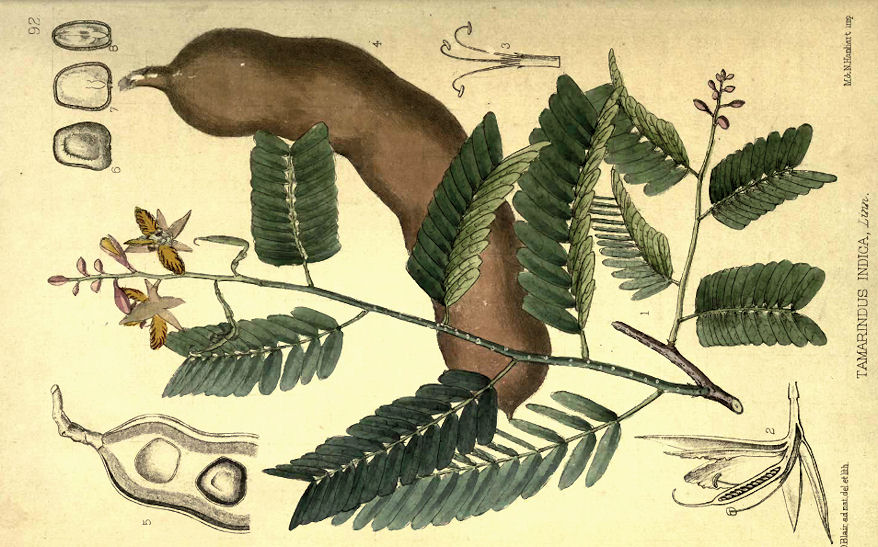
Abb.: तिन्तिडी । Tamarindus indica L. 1753 - Tamarinde - Tamarind
[Bildquelle: Medicinal plants. Being descriptions with original figures of the
principal plants employed in medicine and an account of the characters,
properties, and uses of their parts and products of medicinal value. / by Robert
Bentley and Henry Trimen. Plates by David Blair. In four volumes., 1880. -- vol.
1, pl. 92]
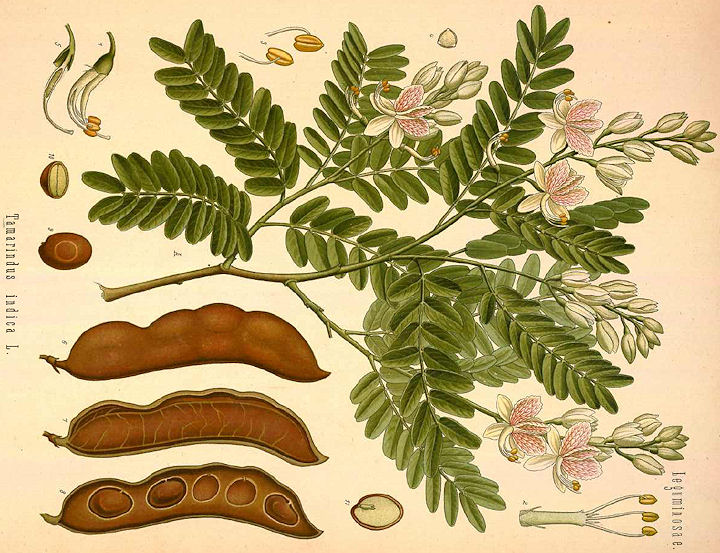
Abb.: तिन्तिडी । Tamarindus indica L. 1753 - Tamarinde - Tamarind
[Bildquelle: Köhler, 1883-1914]
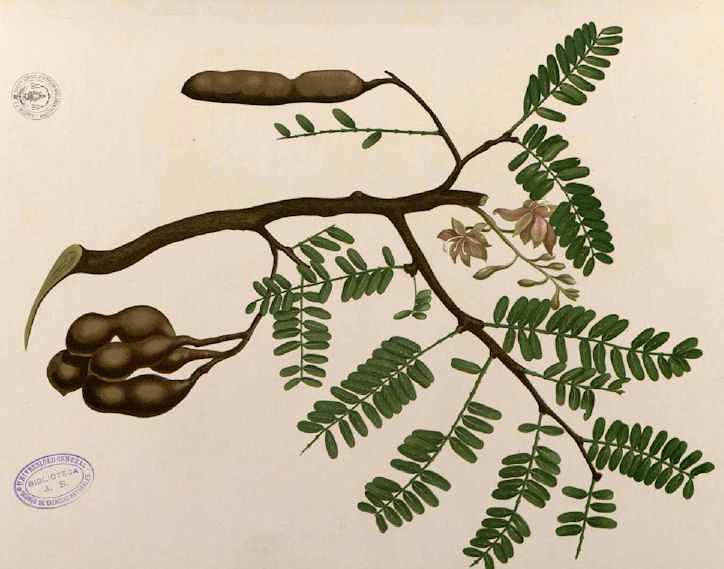
Abb.:
तिन्तिडी । Tamarindus indica L. 1753 - Tamarinde - Tamarind
[Bildquelle: Flora de Filipinas, 1880 / Wikipedia. -- Public domain]
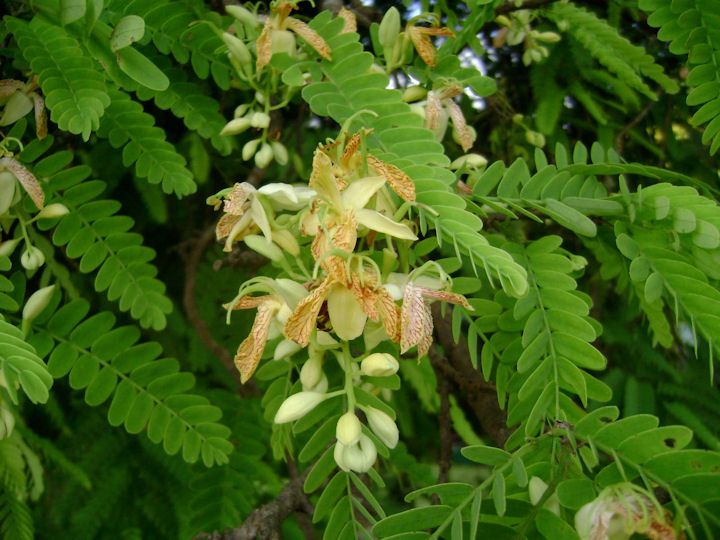
Abb.: चिञ्चा । Tamarindus indica L. 1753 - Tamarinde - Tamarind,
Tonga
[Bildquelle:
Tauʻolunga / Wikimedia. -- GNU FDLicense]
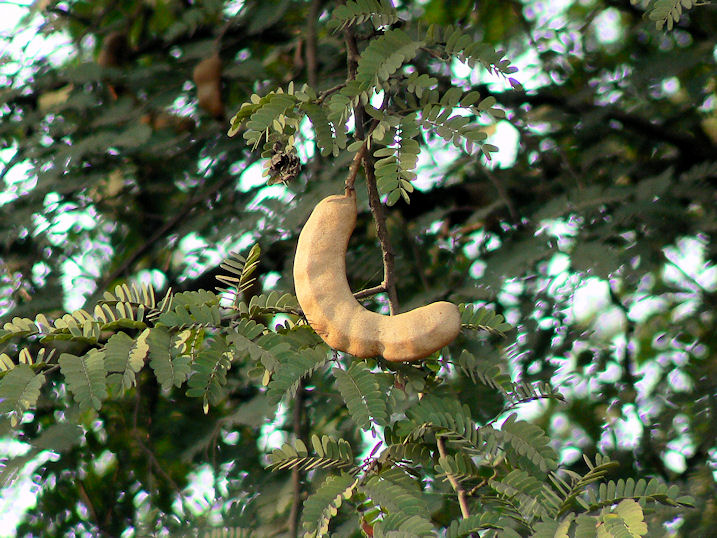
Abb.: अम्लिका । Tamarindus indica L. 1753 - Tamarinde - Tamarind
[Bildquelle: dinesh_valke. --
http://www.flickr.com/photos/dinesh_valke/2174726661/. -- Zugriff am
2010-10-13. --
Creative
Commons Lizenz (Namensnennung, keine kommerzielle Nutzung, keine
Bearbeitung)]
"Tamarindus indica. Willd. iii. 577. [...]
Tintri, or Tintiree, are also Sanscrit names.
[...]
This most magnificent tree is so common and so generally known, as to require little or no description. I however suspect our East India tree differs, probably specifically, from that of the West Indies ; besides I have in view, the reducing of it to its proper place in the Sexual System, which I conceive to be in the Class Diadelphia, and not Monadelphia, as arranged by Schreber, Willdenow, &c. It possesses the natural classic character of the former in an eminent degree, and scarcely any part of the latter ; should the single circumstance of the filaments being united in one body towards the bottom, constitute the essential murk, it would undoubtedly be a monadephous plant, but we know that almost one half of the genera of this, (the 17th Class) have the stamens connected into one body towards their base; yet I do not know of any one who has attempted to remove such, or even to consider them as monadelphous.
Flowering time the hottest part of the year, which is generally in May. Fruit ripens during the cold season, or from December till February.
The tree is one of the largest in India, with a most extensive, large, shady head, or coma, the bark dark-coloured, and scabrous, the wood hard, very durable, and most beautifully veined.
[...]
Extract of a letter from Captain (now Colonel) Pringle at Lucknow.
"Enclosed I beg leave to send you a specimen of the red Tamarind, which I believe is unknown in Bengal ; at least I never saw it until I came to this part of the country.
"This Tamarind makes a very fine preserve, and yields a beautiful deep red colour, approaching to a purple."
The leaves are eaten in the curries of the natives, the pulp of the fruit is universally known. The seeds ground into a flour, are boiled into thick conjee, and used as an article of diet by the poor in times of scarcity or famine ; of the same flour a tenacious paste is made, which serves for various economical uses.
The kernels of the Mango are large, and seem to contain much nourishment ; however they are made no use of, except like those of the Tamarind, in times of scarcity and famine ; they then are boiled in steam, and used as an article of diet."
[Quelle: Roxburgh, William <1751-1815>: Flora indica, or, Descriptions of Indian plants / by the late William Roxburgh. -- Serampore : Printed for W. Thacker, 1832. -- Vol. 3, S. 216ff.]
"Tamarindus Indica (Linn.) N. O. Leguminosae. Tamarind or Indian Date
Description.--Tree, 80 feet; [...]
Fl. May-June.
W. & A. Prod. i. 285.--Roxb. Fl. Ind. iii. 215. -- Rheede i. 23.
Peninsula. Bengal.
Medical Uses.—The pulp of the pods is used both in food and in medicine. It has a pleasant juice, which contains a larger proportion of acid with the saccharine matter than is usually found in acid fruit. Tamarinds are preserved in two ways : first, by throwing hot sugar from the boiler on the ripe pulp; but a better way is to put alternate layers of tamarinds and powdered sugar into a stone jar. By this means they preserve their colour, and taste better. They contain sugar, mucilage, citric acid, tartaric and malic acids. In medicine, the pulp taken in quantity of half an ounce or more proves gently laxative and stomachic, and at the same time quenches the thirst. It increases the action of the sweet purgatives cassia and manna, and weakens that of resinous cathartics. The seed is sometimes given by the Yytians in cases of dysentery, and also as a tonic, and in the form of an electuary. In times of scarcity the poor eat the tamarind-stones. After being roasted and soaked for a few hours in water, the dark outer skin comes off, and they are thon boiled or fried. In Ceylon, a confection prepared with the flowers is supposed to have virtues in obstructions of the liver and spleen. A decoction of the acid leaves of the tree is employed externally in cases requiring repellent fomentation. They are also used for preparing collyria, and taken internally are supposed a remedy in jaundice. The natives have a prejudice against sleeping under the tree, and the acid damp does certainly affect the cloth of tents if they are pitched under them for any length of time. Many plants do not grow under its shade, but it is a mistake to suppose that this applies to all herbs and shrubs. In sore-throat the pulp has been found beneficial as a powerful cleanser. The gum reduced to fine powder is applied to ulcers; the leaves in infusion to country sore eyes and foul ulcers. The stones, pulverised and made into thick paste with water, have the property when applied to the skin of promoting suppuration in indolent boils.—A indie. Thornton. Don,
Economic Uses.—The timber is heavy, firm, and hard, and is converted to many useful purposes in building. An infusion of the leaves is used in Bengal in preparing a fine fixed yellow dye, to give those silks a green colour which have been previously dyed with indigo. Used also simply as a red dye for woolen stuffs. In S. India a strong infusion of the fruit mixed with sea-salt is used by silversmiths in preparing a mixture for cleaning and brightening silver. The pulverised seeds boiled into a paste with thin glue form one of the strongest wood-cements. The tree is one of those preferred for making charcoal for gunpowder—(Lindley. Roxb.). The tree is of slow growth, but is longer-lived than most trees. The timber is used for mills and the teeth of wheels, and whenever very hard timber is requisite. It is much prized as fuel for bricks. Its seeds should be sown where it is to remain, and it may be planted in avenues alternately with short-lived trees of quicker growth. From the liability of this tree to become hollow in the centre, it is extremely difficult to get a tamarind-plank of any width.—(Best's Report to Bomb. Govt., 1863.) There is a considerable export trade of tamarinds from Bombay and Madras. In 1869-70 were exported from the latter Presidency 10,071 cwt., valued at Es. 33,009 ; and from the former 6232 cwt., valued at Rs. 26,209.—Trade Reports."
[Quelle: Drury, Heber <1819 - 1872>: The useful plants of India : with notices of their chief value in commerce, medicine, and the arts. -- 2d ed. with additions and corrections. London : Allen, 1873. -- xvi, 512 p. ; 22 cm. -- s.v.]
"TAMARINDUS INDICA, Linn.
[...]
History, Uses, &C—There would appear to be little doubt that the Tamarind tree is a native of some part of India, probably the South. It is found in a cultivated or semi-cultivated state almost everywhere, and the fruit, besides being an important article of diet, is valued by the Hindus as a refrigerant, digestive, carminative and laxative, useful in febrile states of the system, costiveness, &c. The ashes of the burnt suber are used as an alkaline medicine in acidity of the urine and gonorrhoea, the pulp and also the leaves (puliyam-gali, Tam.), are applied externally in the form of a poultice to inflammatory swellings.
The Sanskrit names of the Tamarind are Tintidi and Amlika. The word 'Tamarind' appears to be derived from the Arabic Tamar-Hindi (Indian date), and it was doubtless through the Arabians that a knowledge of the fruit passed during the Middle Ages into Europe, where, until correctly described by Garcia d'Orta, it was supposed to be produced by a kind of Indian palm.
The author of the Makhzan-el-Adwiya describes two kinds, viz., the red, small-seeded Guzerat variety, and the common reddish brown. The first is by far the best. Mahometan physicians consider the pulp to be cardiacal, astringent and aperient, useful for checking bilious vomiting, and for purging the system of bile and adust humours; when used as an aperient it should be given with a very small quantity of fluid. A gargle of Tamarind water is recommended in sore throat. The seeds are said to be a good astringent, boiled they are used as a poultice to boils, pounded with water they are applied to the crown of the head in cough and relaxation of the uvula. The leaves crushed with water and expressed yield an acid fluid, which is said to be useful in bilious fever, and scalding of the urine; made into a poultice they are applied to reduce inflammatory swellings and to relieve pain. A poultice of the flowers is used in inflammatory affections of the conjunctiva; their juice is given internally for bleeding piles. The bark is considered to have astringent and tonic properties. (Makhzan-el-Adwiya.)
The natives consider the acid exhalations of the Tamarind tree to be injurious to health, and it is stated that the cloth of tents allowed to remain long under the trees becomes rotten. Plants also are said not to grow under them, but this is not universally the case, as we have often seen fine crops of Andrographis paniculata and other shade loving plants growing under Tamarind trees. Mr. J. G. Prebble has brought to our notice a peculiar exudation from an old tamarind tree. It consists almost entirely of oxalate of calcium, and flows from the tree in a liquid or syrupy state, but afterwards dries into white crystalline masses."
[Quelle: Pharmacographia indica : a history of the principal drugs of vegetable origin met with in British India / by William Dymock [1834-1892], C. J. H. Warden and David Hooper [1858-1947]. -- Bd. 1. -- London, 1890. -- S. 532f.]
"Tamarindi.
Tamarindi,
Oxyphœnica.
frantzösisch, Tamarinds.
teutsch, Tamarinden.
Ist das Fleisch, oder ein schwartz und saures Wesen, das ziemlich lieblich schmeckt und in den Früchten eines indianischen Baumes sich befindet, welcher genennet wird
Tamarindus, Raji Hist. Pit. Tournef.
Tamarindus Derelside appellata, G. Alp.
Balam-pulli seu Maderam-pulli, H. M.
Siliqua Arabica, quæ Damarindus, C. B.
Tamarindi, J. B.
frantzösisch, Tamarin.
teutsch, Tamarindenbaum.
Ist so groß wie ein Nußbaum, nur daß er buschiger. Der hat einen schönen Wuchs, ist gerade, und also dicke, daß ihn zwey Mann genau umklafftern mögen. Er ist mit einer sehr dicken, braunen und aufgesprungenen Rinde überzogen. Sein Holtz ist harte und wie geflammet. Die Zweige breiten sich fein ordentlich auf allen Seiten aus, und sind in andre Seiten- und Beyzweige abgetheilet, welche mit einer zarten, braungrünen Haut überzogen und mit einer Hand grossen Blättern besetzet sind, die ziemlich dichte bey einander und wechselsweise stehen. Ein jedes Blatt bestehet aus 9. 10. 12. und wol aus 15. Paaren kleiner Blätter, so an einem vier bis fünff Zoll langen Stiele sitzen. Diese kleinen Blättlein sind acht oder neun Linien lang, und drey bis viere breit. Vorne an der Spitze sind sie abgestümpfet, und runder als wie hinten; dann, an denselben Orte, gegen den Stiel hinzu, haben sie eine Krümme. Sie sind dünne und gar schön grün, am Rande etwas rauch, und oben laufft der Länge nach, als wie kleiner Faden, mit sehr zarten Zweiglein, durch: sie schmecken angenehme säuerlich. Der Blüten wachsen neun und zehen bey einander, aus den Winckeln, zwischen den Blättern und den Zweigen heraus, auch auf der Zweige ihren Spitzen, wie Büschlein eines halben Fusses lang, stehen gar weitläufftig von einander, und haben fast gar keinen Geruch. Jedwede sitzt auf einem Stielgen, welches vier bis fünff Linien lang ist, und eine jede Blüte bestehet aus drey Blätterlein, in Rösleinform, mit blutrothen Adern durchzogen: das eine Blättlein ist gemeiniglich viel kleiner dann die andern, welche ungefehr des halben Zolles lang und viel Linien breit sind, am Rande kraus und als wie Wellen geformiret. Ihr Kelch ist eine fleischige und grünlichte, kleine Birne, mit vier weissen oder röthlichten Blätterlein oben auf, die etwas länger sind als wie die Blätterlein der Blüte, und meistentheils herunter gekehret. Dieser Kelch wird länger, wann die Blüte vergangen ist, so daß er von dem Stiel gar wenig unterschieden.
Die Tamarindenfrucht ist der pistillus, der mitten aus der Blüte hervor spriesset, etwa des halben Zolles lang, grünlicht und krumm ist, als wie die Klauen eines Vogels. Er wird ungefehr vier Zoll lang und einen breit, und ist schier so gestalt als wie die Bonen in den Gärten vor der Stadt Paris, wird braunroth, wann er reiffet. Auf der einen Seite sind zwey oder drey gar tieffe Einschnitte, und auf jeder Seite findet sich als wie eine gar merckliche Ribbe, die laufft von einem Ende bis zum andern, oben auf ist dieselbe etwas flammig, und die Spitze ist ein wenig rund, auch mehrentheils formiret wie ein Schnabel. Die Frucht bestehet aus zwey Schalen, deren eine in der andern stecket. Die äussere ist fleischig, und einer Linie dick, so lange als sie grüne bleibet. Die innere ist wie ein zartes Pergament. Die Wand zwischen beyden Schalen ist drey biß vier Linien dicke, und als wie eine Diplöe in der Hirnschale, voll schwartzes und marckhaftes Wesen, das auf frantzösisch Tamarinds genennet wird. Es ist wie Leim und sauer; queer durch dasselbige hinweg lauffen drey dicke, vest und holtzige Faden, deren einer nach der Länge durch die Schote hingehet, die andern beydẽ sind auf der Seite gegen über zu befinden; und unter ietzt ermeldten Seiten oder Fäden, befindẽ sich noch einige kleinere, welche auf eben derselbigen Seite hinlauffen. Die Aestlein dieser Ader führen nicht alleine den sauern und weinhaftigen Saft, der hernachmahls dicke wird wie Marck; sondern sie geben auch den Samen ihre Nahrung, deren drey oder viere an der Zahl in der Schote beschlossen liegen. Diese Samen sind platt und hart, bey nahe so groß als wie die von der Casia, jedoch ein wenig platter und irregular; dann einige sind schier gar viereckigt und haben etwas runde Ecken, andere sind dreyeckigt, andere sind an der einen Seiten spitziger und eckigter als wie an der andern. Obenher sind sie glatt und gleissend, von Farbe röthlicht und in etwas falb, auf jeder Seite mit einem braunen Fleck gezeichnet. Unter ihrer Haut, die eben nicht gar dicke ist, liegen zwey weisse, dicke lobi oder Stücklein, die sondern sich gar leichtlich von einander und schmecken lieblich, wie ein Mandelkern: sie umgeben den Keimen, der nicht viel über eine Linie lang ist: er stecket in dem Grüblein, das oben über beyden lobis zu befinden ist. Des Baumes Wurtzel ist lang und dick, in einen Hauffen Seitenwurtzeln abgetheilet, die sehr weit um sich greiffen und voller Haare, auch mit einer baumrothen Rinde überzogen sind, die gar sehr herbe schmecket. Dieser Baum wächst an vielen Orten in Ostindien, in Africa, in der Landschaft Senegal, in Arabien und in den americanischen Inseln, von dannen sie die Spanier herüber führeten, nachdem sie diese Orte einzunehmen angefangen hatten. Die Reisenden versehen sich bisweilen mit diesen Früchten, sich damit des Durstes bey grosser Hitze zu erwehren, und legen sie auch mit Zucker ein.
Die Indianer thun die Schale und die holtzigen Zasern aus den Tamarinden und trocknen sie zuvor ein wenig, hernach legen sie dieselben dichte auf einander und übersenden sie zu uns. Man soll die frischen nehmen, die wie ein ziemlich harter Kuchen sind, voll Marck und schwartz, die säuerlich und lieblich schmecken, die als ein Wein riechen und nicht im Keller gelegen haben: welches letzte daran zu erkennen, wann sie zu feuchte sind, und einen Geruch bekommen haben, auch, wann die Samen aufgelauffen sind. Sie führen viel sauer Saltz, Oel und phlegma.
Sie reinigen, laxieren gantz gelinde und halten alsdann an. Durch ihre Säure hemmen sie die allzuheftige Bewegung der Feuchtigkeiten in dem Leibe, dämpfen das Fieber, erfrischen und löschen den Durst. Sie werden bey anhaltenden Fiebern gebrauchet, auch zum Durchfall, und darzu abgesotten oder in forma boli gebrauchet. Das Marck wird aus denenselben, gleichwie aus der Caßia, in einem Siebe ausgezogen. Vor diesem habe ich auch rothe Tamarinden bey den Materialisten gesehen, sie wurden aber nicht so viel geachtet wie die schwartzen, dieweil ihr Schmack nicht also angenehm und sauer war: anjetzo ist es etwas rares, wann man sie in Franckreich zu Gesichte bekommt.
Das Tamarindenlaub, abgesotten, ist gut in hitzigen Fiebern den Durst zu löschen und zu erfrischen. Die durch solche Orte reisen, wo dieser Baum zu wachsen pfleget, die nehmen das Laub, kauen es und stillen damit den Durst.
Tamarindi kommt von tamar, welches so viel heist als dactylus, eine Dattel, ein Finger, weil diese Früchte schier als wie ein Finger, oder als wie eine Dattel sehen; und, weil Mesue, samt vielen Arabern noch mehr, vermeinet hat, obschon ohn allen Grund, die Tamarinden wären Früchte von einem wilden Dattelbaume.
Oxyphœnica kommt von ὀξὺ, acidum, sauer, und φὀινιξ, ruber, roth, als ob es solte heissen, eine rothe Dattel."
[Quelle: Lemery, Nicholas: Vollständiges Materialien-Lexicon. Zu erst in Frantzösischer Sprache entworffen, nunmehro aber nach der dritten, um ein grosses vermehreten Edition [...] ins Hochteutsche übersetzt / Von Christoph Friedrich Richtern, [...]. Leipzig: Johann Friedrich Braun, 1721. -- DVD-Ausgabe: Berlin : Directmedia Publ., 2007. -- s. v.]
Fabaceae (Hülsenfrüchtler)
Bis 30 m hoher Baum.
| 24. plakṣaś ca tintiḍī ciñcāmlikātha pītasārake sarjakāsana-bandhūkapuṣpa-priyaka-jīvakāḥ
प्लक्षश् च तिन्तिडी चिञ्चाम्लिकाथ
पीतसारके । Bezeichnungen für पीतसारक - pītasāraka m.: gelber Sāraka - Pterocarpus marsupium Roxb. 1799 - Indische Flügelfrucht - Indian Kino:
|
Colebrooke (1807): "Asan. Terminalia alata tomentosa, R[oxb]." [= Pentaptera tomentosa Roxb. ex DC. = Terminalia elliptica Willd.]
Pterocarpus marsupium Roxb. - Indische Flügelfrucht - Indian Kino
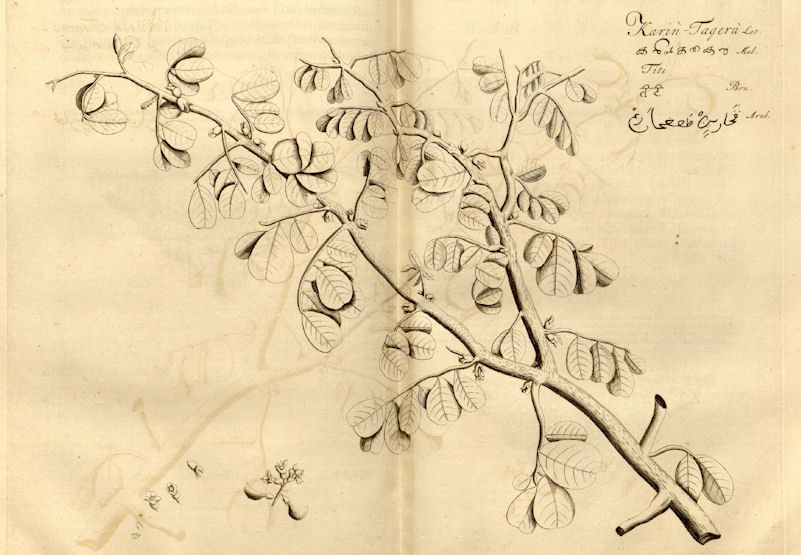
Abb.: पीतसारकः
। Pterocarpus marsupium Roxb. - Indische Flügelfrucht - Indian
Kino
[Bildquelle: Hortus malabaricus VI. Fig. 25,
1686]
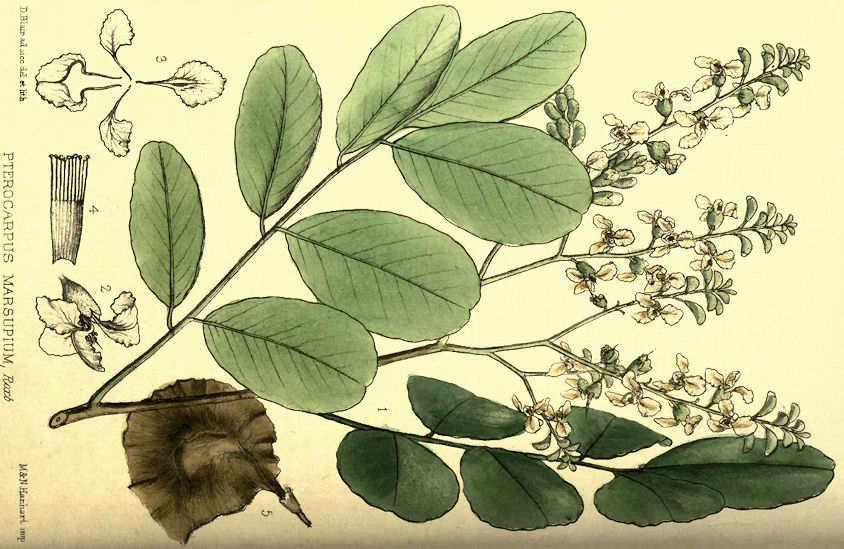
Abb.: पीतसारकः
। Pterocarpus marsupium Roxb. - Indische Flügelfrucht - Indian
Kino
[Bildquelle: Medicinal plants. Being descriptions with original figures of the
principal plants employed in medicine and an account of the characters,
properties, and uses of their parts and products of medicinal value. / by Robert
Bentley and Henry Trimen. Plates by David Blair. In four volumes., 1880. -- vol.
2, pl. 81]
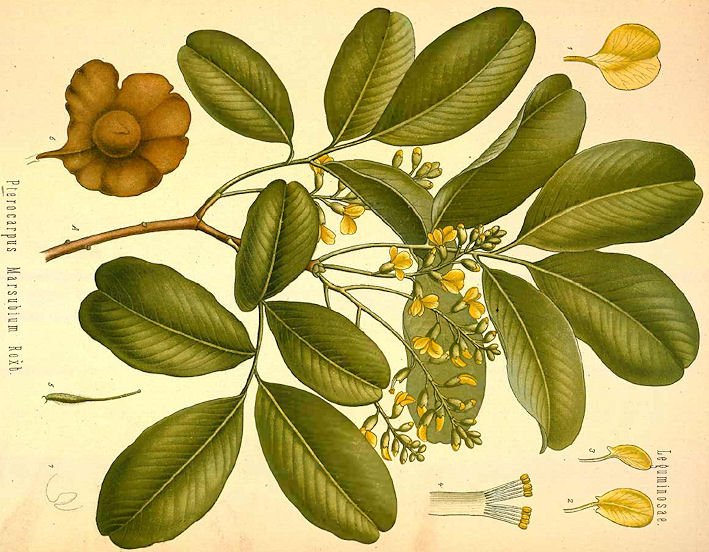
Abb.: पीतसारकः
। Pterocarpus marsupium Roxb. - Indische Flügelfrucht - Indian
Kino
[Bildquelle: Köhler, 1883-1914]
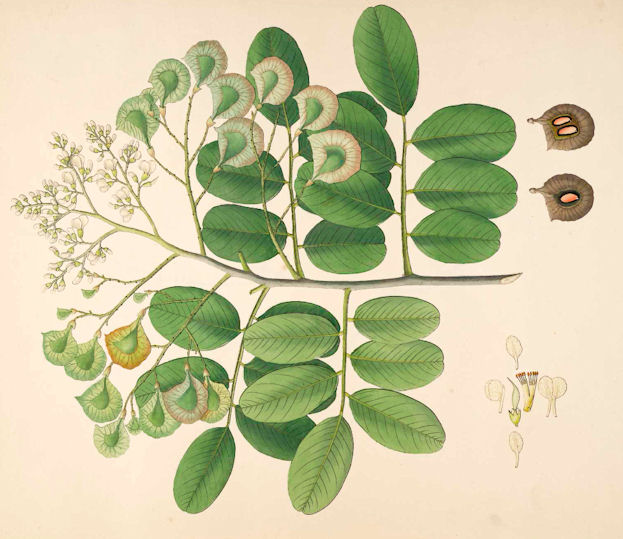
Abb.: पीतसारकः
। Pterocarpus marsupium Roxb. - Indische Flügelfrucht - Indian
Kino
[Bildquelle: Roxburgh. -- Vol II. -- 1795. -- Image courtesy Missouri Botanical
Garden. http://www.botanicus.org. --
Creative Commons Lizenz
(Namensnennung, keine kommerzielle Nutzung)]
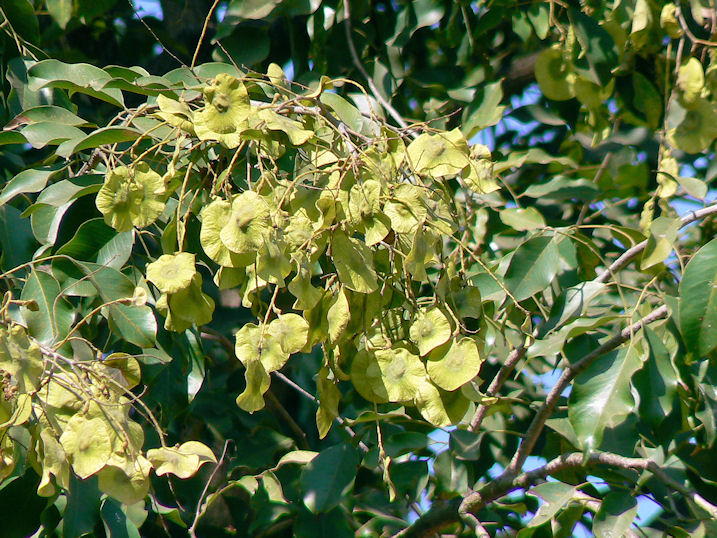
Abb.: असनः । Pterocarpus marsupium Roxb. - Indische Flügelfrucht - Indian
Kino
[Bildquelle: dinesh_valke. --
http://www.flickr.com/photos/dinesh_valke/2139120746/. -- Zugriff am
2010-10-13. --
Creative
Commons Lizenz (Namensnennung, keine kommerzielle Nutzung, keine
Bearbeitung)]
"Pterocarpus marsupium. Willd. iii. 905. R. Corom. pi. ii. No. 116.
[...]
This species, which grows to be a very large tree, seems not to have been taken notice of by any writer that I have met with. It is a native of the Circar mountains. Flowering time, the beginning of the rains, and the seed ripens about the close of the year.
[...]
From wounds in the bark, there issues a red juice, which hardens in the open air into a dark red, very brittle, gummy resin, on being powdered it changes to a light brown, not unlike powdered peruvian bark. In the flame of a candle it burns with difficulty, and without cracking, swelling, noise, or any peculiar smell, into fine white ashes. In the mouth it melts away like the simple gums. Its taste is strongly, but simply astringent; as much so, I think, as that of the gum of the Butea, which it resembles much. It tinges the spittle but little ; heat does not soften it.
It is readily, and almost totally soluble in either water or spirit; the solutions are a pretty deep, but dull red, the spirituous one was rather more transparent, yet with a martial solution it shows considerably less astringency than the watery solution, here it differs from Butea gum ; for the spirituous solution of that, although seemingly less perfect than this, shows rather more astringency with the chalybeate proof than the watery solution. The solutions bear beings mixed without decomposition. Vinegar added to them makes no immediate chance: mineral acids debase their colour ; alkalies heighten them. In short, this substance is so exceedingly like the gum of the Buteas, that one analysis may serve for both. The solutions after being kept ten days showed no signs of change, and the same experiments were then repeated, with the same success.
Note. It is highly necessary to observe that the above analysis was made with the gum resin fresh from the tree, (how long it had adhered thereto I cannot say ;) because I find, that when the gum of Butea frondosa is kept one year or two, it is less soluble in water than in spirit, and the watery solution grows sooner turbid ; but at the same time this turbid solution continues as when recent, to show with a martial solution, more astringency than the spirituous.
The specimen of the Gum-Kino tree in the Banksian herharium, is perfectly like this. It is probable these are the same, or very nearly allied."
[Quelle: Roxburgh, William <1751-1815>: Flora indica, or, Descriptions of Indian plants / by the late William Roxburgh. -- Serampore : Printed for W. Thacker, 1832. -- Vol. 3, S. 234ff.]
"Pterocarpus marsupium (Roxb.) Red Sanders.
Description.--Tree, 40-80 feet;
Fl. Aug.-Sept.
W. & A. Prod. i. 266.--Roxb. Fl. Ind. 234.--Cor. ii. t. 116.
Pterocarpus bilobus, Don's Mill. ii. 376. -- Rheede vi. t. 25.
Neilgherries. Concans. Travancore.
Medical Uses.—A reddish gum-resin exudes from the bark of this tree known as one of the gum Kinos* of commerce. It becomes very brittle on hardening, and is very astringent. It is exported in considerable quantities from Malabar. Its properties are similar to those of catechu, but being milder in its operation, is better adapted for children and delicate females.—Pharm. of India.
* The origin of E. I. Kino was long unknown; the history of the discovery will be found in an interesting paper by Dr Royle. See Pharm. Jour. iv. 510, and y. 498
Economic Uses.—The wood is employed for house-building purposes, and is little inferior to teak.—(Roxb. Ainslie. Dr Gibson.) The timber is dark-coloured. Mr Rohde asserts it is the best timber for exposed Venetian-blinds and weather-boards. It is attacked by the Teredo navalis when used for ships' bottoms, and is apt to warp if sawn green.—Bedd. Flor. Sylv. t. 21.
The tree is singularly local in its distribution, being found only • in quantity on the gravelly slopes of the rocky hills in North Arcot and Cuddapah, and the southern parts of Kurnool. It is now comparatively rare in the first of these districts. Some years ago two officers of the forest department made various attempts to raise the Red Sanders in the Cuddapah district, but there was no result; the curious flat-winged seed appears to have been planted too deep. The seeds are washed down in the north-east monsoon, and are partially covered with sand in the rocky nullahs. The stem is valued for house-posts beyond any other, being impervious to white ants. The smaller portions* are carved into images, &c. The leaves are the favourite food of cattle and goats, and are much in demand. The wood is extremely hard, finely grained, and of a garnet-red colour, which deepens on exposure. It is employed to dye a permanent reddish-brown colour. It communicates a deep red to alcohol and ether, but gives no tinge to water. In the cold season, large heaps of short billets (2 feet to 3 feet) or gnarled roots may be seen on the Madras beach, where it is sold by weight, and being heavy is used as dunnage. The North-West line traverses the native habitat, and the supply has been diminishing. The seigniorage in Cuddapah was raised from 1 rupee to 6 rupees per cartload, to prevent its extermination. As the value of a post is not less than 2 1/2 rupees, and there are often 26 in a cart, the value of the cartload is often 50 rupees. Price of the roots keeps steadily at £3, 10s., sometimes £4 per ton.—(Conservator of Forests Report to Madras Government, 1867.) A very large tree, affording excellent shade and timber. The latter is of a dark-brown, and dyes yellow. It cannot be used for lintels of doors, windows, &c., as it discolours the white-wash. It grows luxuriantly on the Eastern Ghauts, on the hills between Vellore and Salem, and on the Malabar and Canara Ghauts, where large quantities of the Kino it yields are collected and sent to England. The tree is very plentiful in the forests of Cuddapah and North Arcot. It is indispensable for cart - building, and eagerly sought after for that purpose. It is considered unlucky to use it for house-building. The estimated number in the Cuddapah forests is about 50,000 trees.—Cleghom's Forests of India."
[Quelle: Roxburgh, William <1751-1815>: Flora indica, or, Descriptions of Indian plants / by the late William Roxburgh. -- Serampore : Printed for W. Thacker, 1832. -- Vol. 2, S. 547f.]
"PTEROCARPUS MARSUPIUM, Roxb. [...]
History, Uses, &C.—Neither Hindu or Mahometan medical writers appear to notice Malabar kino. Rumphius (iii., 24,) calls the tree Pterocarpus indicus, and remarks that, the gum looks like dried blood, and cures diarrhoea; he also says that the bruised leaves are applied to boils, sores, and skin eruptions.
Ainslie notices the use of the gum by the natives on the Coromandel Coast as a remedy for toothache, but does not call it kino, and it would appear not to have been an article of export to Europe in his time. From the Pharmacographia we learn that kino originally came from the river Gambia in West Africa under the name of Gummi rubrum astringens Gambiense, and that it was produced by a tree called in the Mandingo language Kuno, and which was afterwards identified with the Pterocarpus erinaceus of Poiret. In the Edinburgh Dispensatory of 1803, kino is described as coming from Africa and Jamaica, but in the 1811 edition, Duncan says that the African drug is no longer to be met with, its place being supplied by kinos from Jamaica, the East Indies, and New South Wales. After this date the East Indian drug appears to have been principallv used, and when Wight and Royle (1844-46) proved its botanical origin it became recognised as the legitimate kino of the principal Pharmacopoeias of Europe. A description of its collection on the Malabar Coast will be found in the Pharmacographia. In the Canara District of the Bombay Presidency it is collected in little cups made with leaves, and consequently assumes the form of concavo-convex cakes, 3 to 4 inches in diameter; these are always broken up and garbled by the wholesale dealers. Malabar kino is mostly reserved for the European market, there is little demand for it in native practice, Dragon's blood and Butea kino taking its place. The bark of the tree is used in Goa as an astringent, but the gum is not collected. Kino is more lenitive than other astringents, in consequence, probably, of the phlobophene it contains; it is chiefly used in the treatment of diarrhoea and pyrosis."
[Quelle: Pharmacographia indica : a history of the principal drugs of vegetable origin met with in British India / by William Dymock [1834-1892], C. J. H. Warden and David Hooper [1858-1947]. -- Bd. 1. -- London, 1890. -- S. 464f.]
Terminalia elliptica Willd.
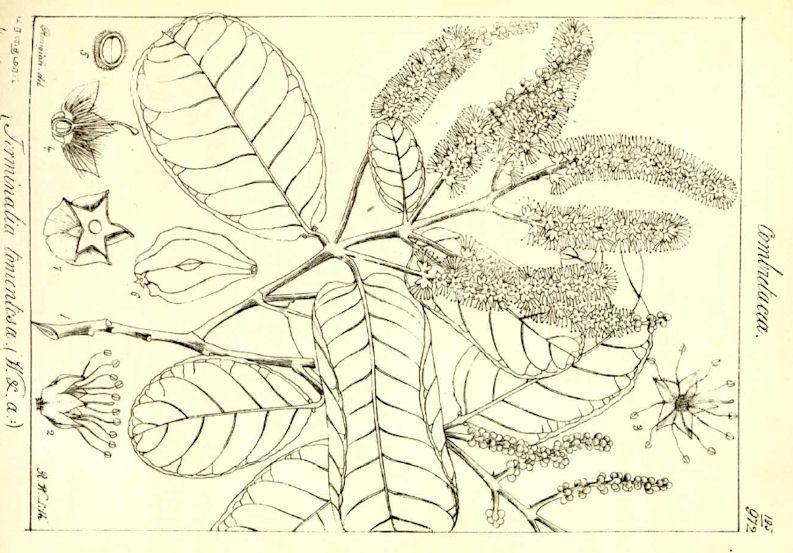
Abb.: Terminalia elliptica Willd.
[Wight Icones I, Tab. 195, 1840]
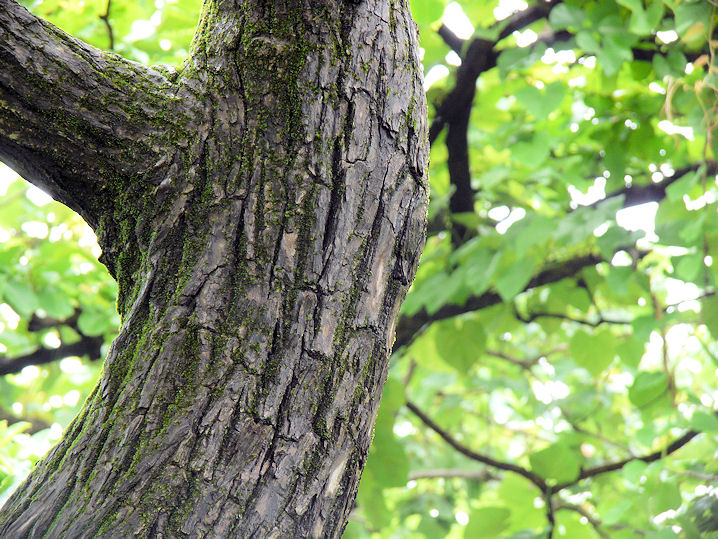
Abb.: Terminalia elliptica Willd., Maharashtra
[Bildquelle: dinesh_valke. --
http://www.flickr.com/photos/dinesh_valke/2661321272/. -- Zugriff am
2010-10-29. --
Creative
Commons Lizenz (Namensnennung, keine kommerzielle Nutzung, share alike)]
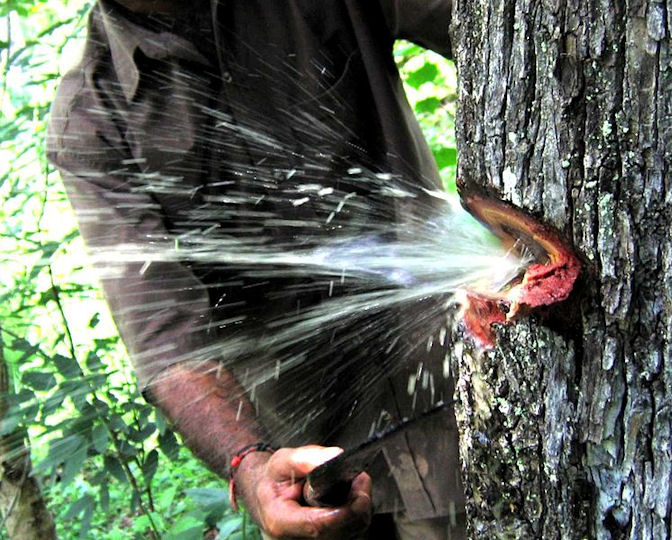
Abb.: Terminalia elliptica Willd.
[Bildquelle: Wikipedia. -- Public domain]
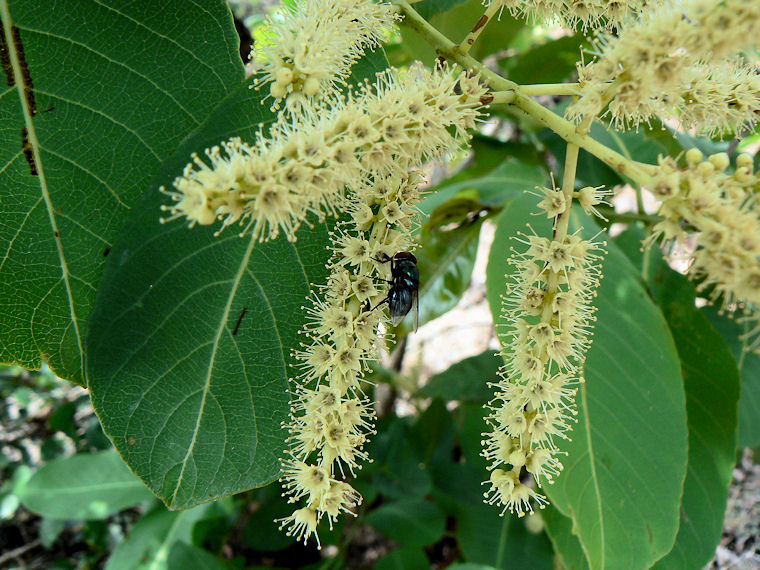
Abb.: Terminalia elliptica Willd., Lohagad,
Maharashtra
[Bildquelle: dinesh_valke. --
http://www.flickr.com/photos/dinesh_valke/517713786/. -- Zugriff am
2010-10-29. --
Creative
Commons Lizenz (Namensnennung, keine kommerzielle Nutzung, keine
Bearbeitung)]
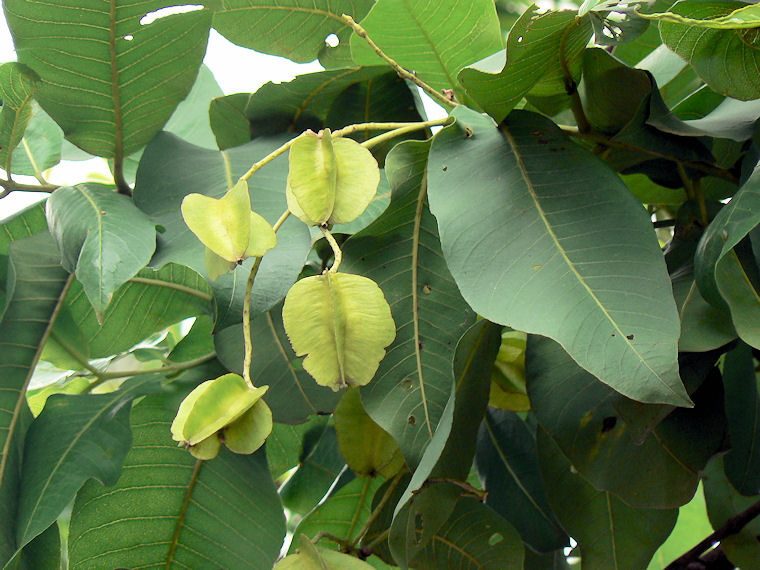
Abb.: Terminalia elliptica Willd., Maharashtra
[Bildquelle: dinesh_valke. --
http://www.flickr.com/photos/dinesh_valke/817738076/. -- Zugriff am
2010-10-29. --
Creative
Commons Lizenz (Namensnennung, keine kommerzielle Nutzung, keine
Bearbeitung)]
"Pentaptera tomentosa. Roxb. [...]
Sans. Usna, Pecata-saluka.
[...]
Found in various parts of India, grows to be a large timber tree of much utility. Flowering time April and May, the seed ripens in the cool season."
[Quelle: Roxburgh, William <1751-1815>: Flora indica, or, Descriptions of Indian plants / by the late William Roxburgh. -- Serampore : Printed for W. Thacker, 1832. -- Vol. 2, S. 440]
"Terminalia tomentosa (W. & A.) Description.--Tree; bark deeply cracked; [...]
Fl. April-June.
W. & A. Prod. i. 314.--Wight Icon. t. 195.
Pentaptera tomentosa, Roxb. Fl. Ind. ii. 440.
Concan. Oude. Monghyr.
Medical Uses.—The bark is astringent, and in the form of decoction is useful internally in atonic diarrhoea, and locally as an application to indolent ulcers. The dose of the decoction (two ounces of the bruised bark to a pint of water) is two ounces thrice daily.—Pharm. of India.
Economic Uses.—The timber is valuable, and is much used for making shafts of gigs, and other things where toughness of fibre is required. The bark is astringent and used for dyeing black.— (.Roxb.) The bark, in addition to yielding a black dye, is so charged with calcareous matter, that its ashes, when burnt, afford a substitute for the lime which the natives in Ceylon chew with their betel.— (Tennent's Ceylon, i. 99.) It yields a gum used as an incense and cosmetic. It costs 27 to 30 rupees the maund. The trees are plentiful in the Kurnool forests."
[Quelle: Roxburgh, William <1751-1815>: Flora indica, or, Descriptions of Indian plants / by the late William Roxburgh. -- Serampore : Printed for W. Thacker, 1832. -- Vol. 2, S. 547f.]
"Terminalia tomentosa, Bedd. Fl. 8ylv.,t. 17, and its variety, T. glabra, Vern.—Asan (Hind.), Am (Mar.), Kurrupu-maruta-maram (Tarn.), Piasal (Beng.), Nalla-maddichettu (Tel), Tembavu (Mai), trees common in most parts of India have an astringent bark which is used for tanning, and has been recommended for medicinal use by Dr. M. Ross. Powdered and mixed with oil it is used for aphthae. The ash of the bark contains much potash and is eaten by the natives, and the leaves are used for manuring rice fields. (Bourdillon). Paul found 5.97 per cent, of tannin in the bark, and Hummel 4.0 per cent. We find that the bark of the variety glabra contains moisture 9.59, ash 14.94, and tannin 7.2 per cent. The alcoholic extract contained 13.9 per cent, of tannin and colouring matters precipitated by lead. The tannin gave a blue-black precipitate with ferric salts." [Quelle: Pharmacographia indica : a history of the principal drugs of vegetable origin met with in British India / by William Dymock [1834-1892], C. J. H. Warden and David Hooper [1858-1947]. -- Bd. 2. -- London, 1891. -- S. 16.]
Dipterocarpaceae (Flügelnussgewächse)
Bis 35 m hoher Baum.
| 25 a./b. sāle tu sarjakārśyāśvakarṇakāḥ sasyasambaraḥ साले तु सर्ज-कार्श्याश्वकर्णकाः सस्यसम्बरः ।२५ क। Bezeichnungen für den साल - sāla m.: Sāla, Baum: Shorea robusta C. F. Gaertn. 1805 - Salharzbaum - Sal Tree:
|
Colebrooke (1807): Sakhwa or Sal. A common timber tree described (Polyandria monogyna) but not yet named by botanists."
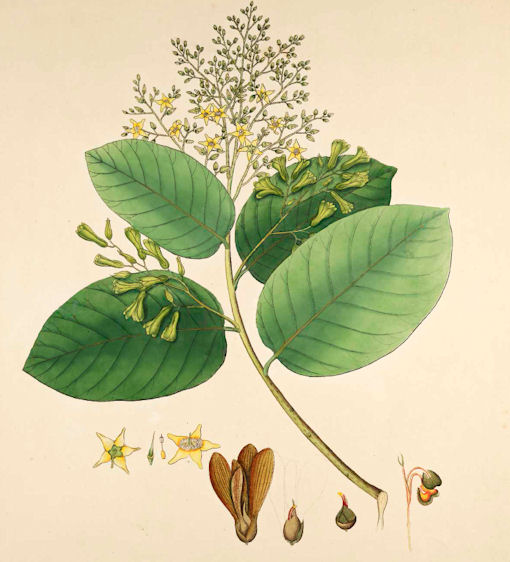
Abb.: अश्वकर्णकः । Shorea robusta C. F. Gaertn. - Salharzbaum - Sal Tree
[Bildquelle: Roxburgh. -- Vol III. -- 1819. -- Image courtesy Missouri Botanical
Garden. http://www.botanicus.org. --
Creative Commons Lizenz
(Namensnennung, keine kommerzielle Nutzung)]
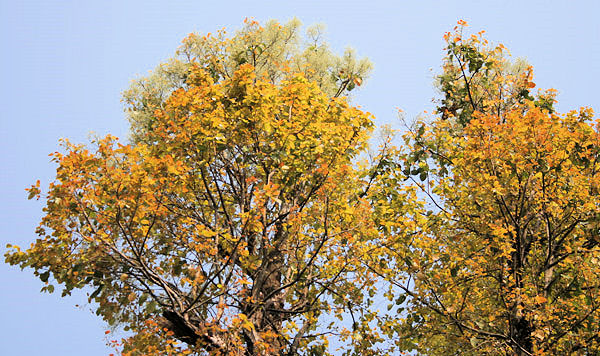
Abb.: सालः । Shorea robusta C. F. Gaertn. - Salharzbaum - Sal Tree, Buxa National Park
- বক্সা জাতীয় উদ্যান,
West Bengal
[Bildquelle: J. M. Garg / Wikimedia.
-- GNU FDLicense]
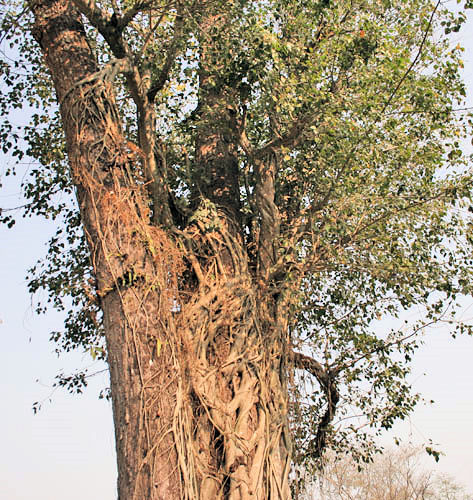
Abb.: सालः । Shorea robusta C. F. Gaertn. - Salharzbaum - Sal Tree,
von Würgfeige umwachsen, Buxa National Park
- বক্সা জাতীয় উদ্যান,
West Bengal
[Bildquelle: J. M. Garg / Wikimedia.
-- GNU FDLicense]
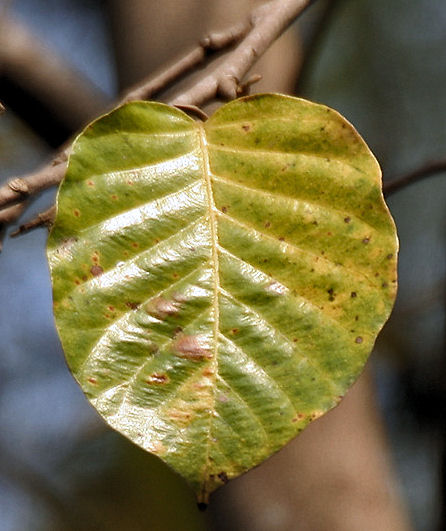
Abb.: अश्वकर्णकः । Shorea robusta C. F. Gaertn. - Salharzbaum - Sal Tree, Buxa National Park
- বক্সা জাতীয় উদ্যান,
West Bengal
[Bildquelle: J. M. Garg / Wikimedia.
-- GNU FDLicense]
"Shorea robusta. Gaert. Sem. 3. 1. 186. Cor. pl. 3. N. 212. [..]
Sala, Uswukurnika, the Sanscrit names.
Beng. and Hind. Sal.
An immense timber tree, a native of Morung. Flowers during the hot season. Seed ripens in June.
In April 1810, a young tree flowered in the Botanic garden at Calcutta, and is the first that has blossomed, though there are young trees in the garden of from twelve to thirteen years growth. The original description of this tree is very correct."
[Quelle: Roxburgh, William <1751-1815>: Flora indica, or, Descriptions of Indian plants / by the late William Roxburgh. -- Serampore : Printed for W. Thacker, 1832. -- Vol. 2, S. 615]
"Shorea robusta (Roxb.) Description.--Tree, 100-150 feet; [...]
Fl. March-April.
Rooxb. Cor. iii. t. 212; Fl. Ind. ii.615.--Bedd. Flor. Sylv. t. 4.
Foot of the Himalaya. Godavary forests. Goomsur. Orissa.
Medical Uses.—A resin exudes from this tree known as the Dammer in the bazaars in Bengal The colour ranges from pale amber to dark brown. It is devoid of taste or smell, sparingly soluble in alcohol, entirely so in ether, and perfectly in turpentine and the fixed oils. It unites with the fixed oils and forms plasters. The superior kinds are efficient substitutes for the pine-resins of the European pharmacopoeias.—(Beng. Disp. p. 221.) The resin is applied medicinally to ulcers and chilblains, acting as a stimulant Sulphuric acid dissolves and gives it a red colour. Two parts of colourless dammer and two and a half parts of oil of turpentine make the best varnish for lithographic drawings.—Jury Rep. Mad. Exhib. Powell's Punj. Prod.
Economic Uses.—The wood of this tree is in very general use in Bengal for beams, rafters, gun-carriages, and for various other economical purposes. It is close-grained and heavy, but does not appear to be very durable, and on that account inferior to teak; but in strength it surpasses the latter, and deserves to be considered the second-best timber-tree in India. It yields a large quantity of resin- dammer known as the Bal or Dhooma, which is extensively used as a substitute for pitch in the marine yard. It is also burnt for incense in Hindoo temples. Boyle observed these trees forming extensive forests of themselves, frequently unmixed with any other tree.—(Roxb. Royle.) All attempts to grow it from seed have failed. The timber is used in Madras in the gun-carriage manufactory, also for house-building and ships, but it warps in planks. It lasts a long time under water, and is unequalled for sleepers, and is proof against white ants.
The Sal tree of Hindustan extends in a nearly unbroken belt of forest along the Terai, from the Ganges at Hurdwar to the Brahmaputra. The seed has the utmost susceptibility of germination, with a vitality so limited in duration, that it will not survive many days unplanted. The Sal seed ripens at the commencement of the rains, and after the first shower falls actually sprouting from the tree. In consequence, young plants come up in the utmost profusion, often so thick as to choke each other. They form patches of forest, literally impenetrable. — (Falconer.) The most important and accessible of Sal forests are in the district of Goomsur and in the zemindary of Bodogoda, both of which are traversed by rivers which admit of rafting timber to the coast during the freshes. The tree grows remarkably tall and straight Thousands of young trees are removed to form pools for native houses and telegraph poles; others of a larger size are useful for public works and officers' houses; and if sawn longitudinally, they give excellent half-round sleepers. On measurement, the straight stump shoot of two years' growth was found to be twelve feet high and three inches in diameter at the base.— (Cleghorn's Forests of S. India.) Captain Wood has considered the question of the growth of Sal wood in the Oude forests, and has arrived at the conclusion that at sixty-five years of age a tree reaches the second-class dimensions, and that it requires thirty-three years more of growth to reach the first-class size. Dr Brandis had before assumed fifty and eighty years as the ages of second and first class trees respectively.—(Forest Reports in Oude, 1867-68, by Captain Wood.) The Sal is very abundant about Russelcondah. Many tracts of forest are here composed almost entirely of Sal, it growing thick and to the exclusion of every other tree. There is no timber equal to it for engineering purposes. It is durable under water, and quite proof against white ants.—Beddome's Reports, 1864."
[Quelle: Drury, Heber <1819 - 1872>: The useful plants of India : with notices of their chief value in commerce, medicine, and the arts. -- 2d ed. with additions and corrections. London : Allen, 1873. -- xvi, 512 p. ; 22 cm. -- s.v.]
"SHOREA ROBUSTA, Gärtn. f. The Saul tree
[...]
The Sāl tree, called in Sanskrit Sāla and Asvakarna, is of interest from a mythological point of view, as the mother of Buddha is represented as holding a branch of the tree in her hand when Buddha was born, and it was under the shade of a Sāla tree that Buddha passed the last night of his life on earth. The small branches of the Sāla are used by Indian villagers to detect witches; they write the name of every woman over 12 years of age in the village upon a branch; the branches are then placed in water and left for 4 1/2 hours; if any woman's branch withers, she is the witch.
This tree is very widely distributed throughout India, and is undoubtly the source of the Rosin or Rāl of Hindu and Mahometan writers on Materia Indica. Rāl, in Sanskrit Rāla and Sāla-veshta, is regarded by the Hindus as attenuant, detergent, and astringent, and is sometimes prescribed internally mixed with sugar, honey or treacle; as resin does with us, it enters into the composition of stimulating plasters and ointments; it is also used for fumigating rooms occupied by the sick. The seeds of the Saul tree are eaten in times of scarcity with Mahwa flowers by the wild tribes of India. Mahometan writers give a similar account of its properties and uses. The author of the Makhzan-el-Adwiya (vide article Kaikahr) notices the fact that more than one kind of Rāl is met with, but names the Sakoh or Sāl as the source from which the genuine article is obtained. In another part of his work (vide article Sakoh) he describes the tree, and says that when old the bark becomes separated from the trunk by the deposit of Rāl beneath it. Ainslie mentions three kinds of resin or dammar as common in the bazaars of Southern India, but is in doubt as to the sources from whence the different kinds are obatained. He observes that a great portion of the dammar used in India is imported from Java, Bornea, Joanna, and several of the Soloo Islands. The author of the Bengal Dispensatory, after conducting a series of experiments with genuine Sāl resin, pronounced it to be an efficient substitutw for pine resin. In Bombay, at the present time, American resin is to a great extent displacing Indian Rāl. Dr. Sakharam Arjun states (Bomb. Drugs) that he has seen Shorea resin mixed with sugar, given with good effect in dysentery. The oil of the seeds is extracted in Malabar. In the Wynaad Shorea Talara, Roxb. (S. laccifera, Heynne), yields a fragrant resin, known as Sambrani, which is burnt as an incense."
[Quelle: Pharmacographia indica : a history of the principal drugs of vegetable origin met with in British India / by William Dymock [1834-1892], C. J. H. Warden and David Hooper [1858-1947]. -- Bd. 1. -- London, 1890. -- S. 195f.]
Combretaceae (Flügelsamengewächse)
Bis 15 m hoher Baum.
| 25. c./d. nadīsarjo vīratarurindradruḥ kakubho 'rjunaḥ नदीसर्जो वीरतरुर् इन्द्रद्रुः ककुभो ऽर्जुनः ॥२५ ख॥ [Bezeichnungen für Terminalia arjuna W. & A.:]
|
Colebrooke (1807): "Kahua. Terminalia alata glabra, R[oxb.]."
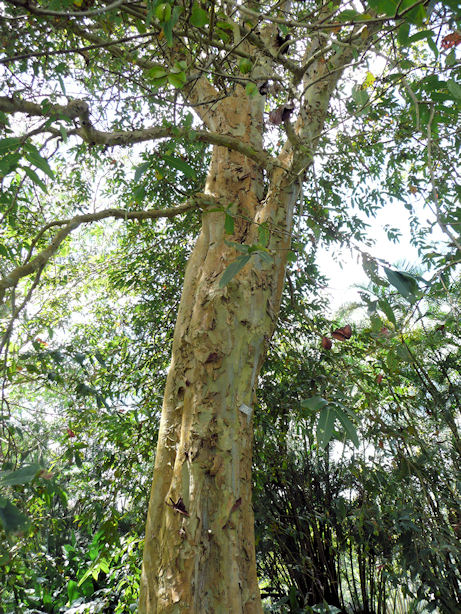
Abb.: अर्जुनः । Terminalia arjuna W. & A
[Bildquelle: Liné1 / Wikipedia. -- GNU FDLicense]
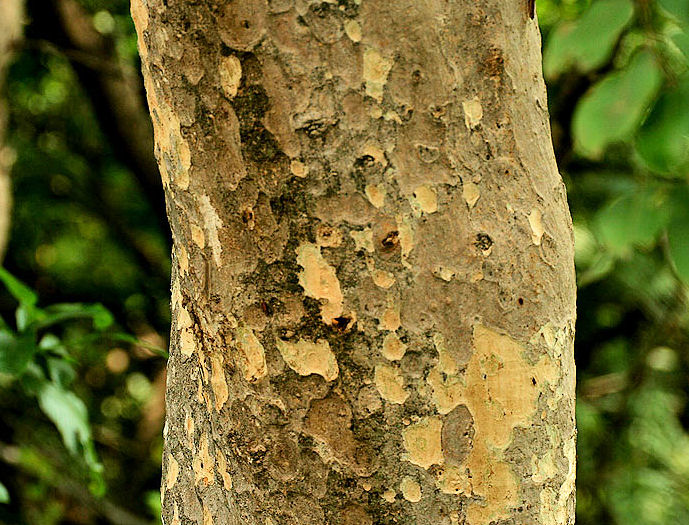
Abb.: अर्जुनः । Terminalia arjuna W. & A.,
Rangareddy District -
రంగా రెడ్డి జిల్లా,
Andhra Pradesh
[Bildquelle: J. M. Garg / Wikipedia.
-- GNU FDLicense]
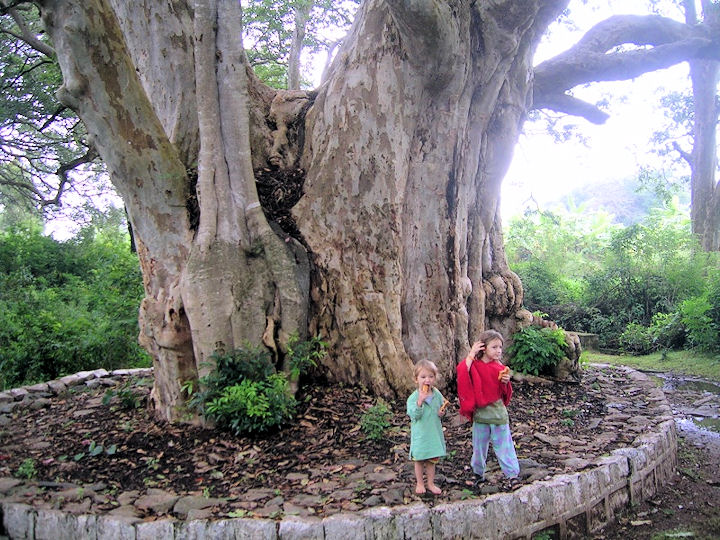
Abb.: ककुभः । Terminalia arjuna W. & A.,
Javadi Hills, Tamil Nadu
[Bildquelle: Shyamal / Wikimedia. --
Creative Commons
Lizenz (Namensnennung)]
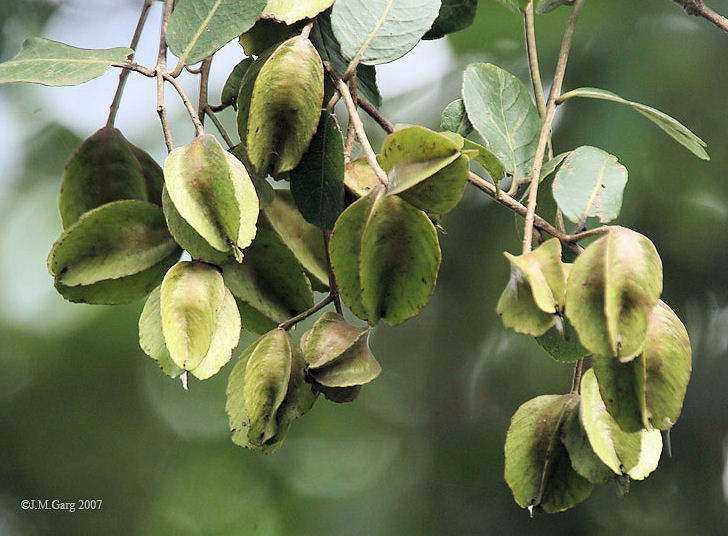
Abb.: अर्जुनः । Terminalia arjuna W. & A.,
Kolkata -
কলকাতা,
West Bengal
[Bildquelle: J. M. Garg / Wikipedia.
-- GNU FDLicense]
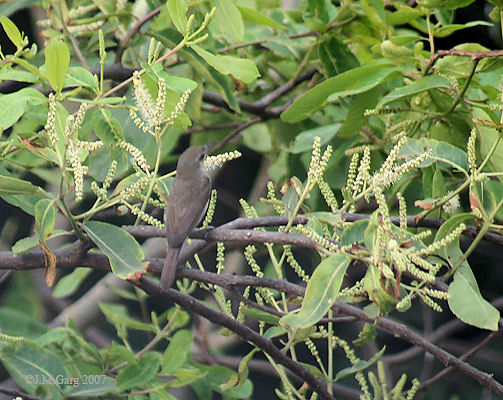
Abb.: अर्जुनः । Sykes' Warbler (Iduna rama) mit
Blüten von Terminalia arjuna W. & A., Kolkata - কলকাতা, West
Bengal
[Bildquelle: J. M. Garg / Wikipedia.
-- GNU FDLicense]
"Pentaptera Arjuna. R. [...]
Sans. Urjoona, also Kukooubha.
[...]
A stout quick growing timber tree, a native of various parts of India. It flowers in April and May, and the seed ripens about the close of the year. The margins of the leaves are often slightly crenulate, and the two glands underneath the base are only conspicuous on the under side, whereas in P. angustifolia, which this resembles most, they are equally conspicuous in viewing either surface."
[Quelle: Roxburgh, William <1751-1815>: Flora indica, or, Descriptions of Indian plants / by the late William Roxburgh. -- Serampore : Printed for W. Thacker, 1832. -- Vol. 2, S. 438]
"Pentaptera Arjuna (Roxb.) N. O. Combretaceae. Description.--Tree, 50 feet; [...]
Fl. April-May.
Roxb. Flor. Ind. ii. 438.
Terminalia Arjuna, W. & A. Prod. i. 314, ann.
Bengal. Surat jungles.
Medical Uses.—The bark is in great repute among the natives as a tonic taken internally, and a vulnerary externally applied. It is sold by most druggists in the bazaars.—(Roxb. Dr Gibson.) It is useful in bilious affections, and as an antidote to poisons. The fruit is tonic and deobstruent. The juice of the leaves is given in ear-ache.—Powell's Punj. Prod.
Economic Uses.—The heart-wood is dark, heavy, and strong, but splits on exposure to the sun, and is liable to the attacks of white ants.—Powell's Punj. Prod."
[Quelle: Drury, Heber <1819 - 1872>: The useful plants of India : with notices of their chief value in commerce, medicine, and the arts. -- 2d ed. with additions and corrections. London : Allen, 1873. -- xvi, 512 p. ; 22 cm. -- s.v.]
"TERMINALIA ARJUNA, Bedd. [...]
This tree is the Arjuna and Kukubha of Chakradatta, who describes it as tonic, astringent, and cooling, and prescribes it in heart disease and for those purposes for which astringent are generally applied. He recommends it to be given in milk, treacle or water when used internally, or as a ghrita (medicinal butter) made with the decoction and powder of the bark.
Hindu physicians think that the bark has some special virtue in promoting the union of fractures, and the dispersion of ecchymosis when given internally. It is considered to be Asmari-hara, or lithontripic, and a reference to the chemical composition will show that the ash of the bark contains an extraordinarily large proportion of calcium carbonate. Externally it is used in the form of an astringent wash to ulcers."
[Quelle: Pharmacographia indica : a history of the principal drugs of vegetable origin met with in British India / by William Dymock [1834-1892], C. J. H. Warden and David Hooper [1858-1947]. -- Bd. 2. -- London, 1891. -- S. 11f.]
Siehe:
Carakasaṃhitā: Ausgewählte Texte aus der Carakasaṃhitā / übersetzt und erläutert von Alois Payer <1944 - >. -- Anhang A: Pflanzenbeschreibungen. -- Terminalia arjuna W. & A. -- URL: http://www.payer.de/ayurveda/pflanzen/terminalia_arjuna.htm
Sapotaceae (Breiapfelgewächse)
Strauch oder bis 12 m hoher Baum.
| 26. a./b. rājādanaḥ phalādhyakṣaḥ kṣīrikāyām atha dvayoḥ राजादनः फलाध्यक्षः क्षीरिकायाम् अथ द्वयोः ।२६ क। Bezeichnungen für क्षीरिका - kṣīrikā f.: Milchige, Manilkara hexandra (Roxb.) Dubard 1915 - Breiapfelbaum:
|
Colebrooke (1807): "Khirant. Perhaps a species of Mimusops. Mimusops kanki."
Manilkara hexandra (Roxb. = Mimusops hexandra) Dubard - Breiapfelbaum
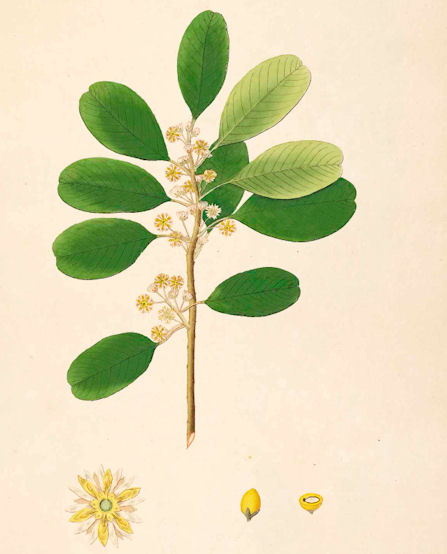
Abb.: क्षीरिका । Manilkara hexandra (Roxb. = Mimusops hexandra) Dubard -
Breiapfelbaum
[Bildquelle: Roxburgh. -- Vol I. -- 1795. -- Image courtesy Missouri Botanical
Garden. http://www.botanicus.org. --
Creative Commons Lizenz
(Namensnennung, keine kommerzielle Nutzung)]
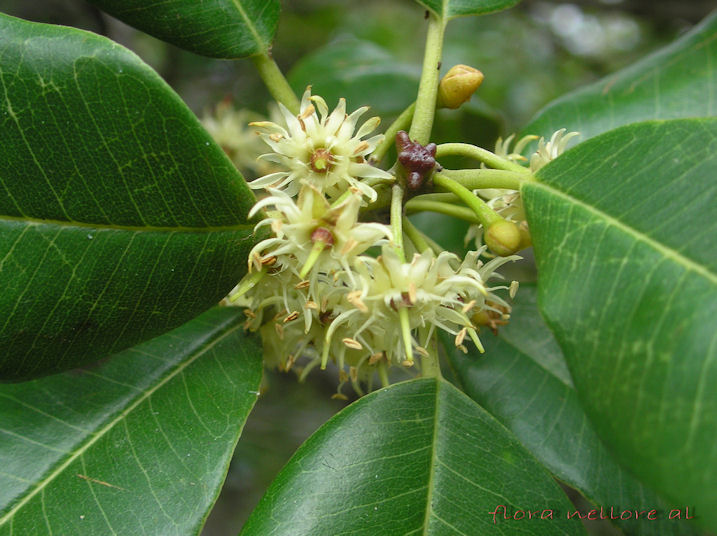
Abb.: क्षीरिका । Manilkara hexandra Dubard -
Breiapfelbaum
[Bildquelle:
Lalithamba. --
http://www.flickr.com/photos/45835639@N04/4586385521/. -- Zugriff am
2010-10-13. --
Creative Commons Lizenz (Namensnennung)]
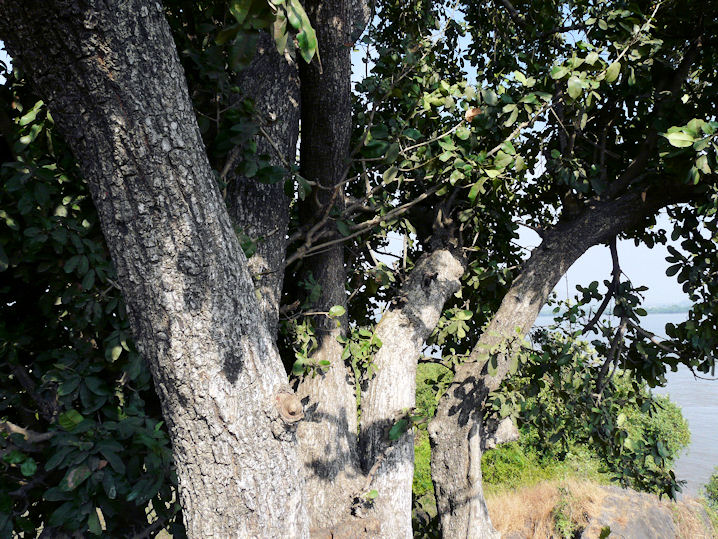
Abb.: फलाध्यक्षः । Manilkara hexandra Dubard -
Breiapfelbaum
[Bildquelle: dinesh_valke. --
http://www.flickr.com/photos/dinesh_valke/3127283452/. -- Zugriff am
2010-10-13. --
Creative
Commons Lizenz (Namensnennung, keine kommerzielle Nutzung, share alike)]
"Mimusops hexandra. Willd. 2. 326. R. Corom. pl. I. N. 15. [...]
This tree is a native of the mountainous parts of the Circars ; it is never cultivated, nor have I seen it near cultivated places. It flowers during the hot, and beginning of the wet season."
[Quelle: Roxburgh, William <1751-1815>: Flora indica, or, Descriptions of Indian plants / by the late William Roxburgh. -- Serampore : Printed for W. Thacker, 1832. -- Vol. 2, S. 238]
"Mimusops hexandra (Roxb.) Description.--Tree; [...]
Fl. March-April.
Roxb. Fl. Ind. ii. 238.--Cor. i. t. 15.--Wight Icon. t. 1587.
Mountains of the Circars. Bombay.
Economic Uses.—The wood is much used in Guzerat for a variety of purposes, such as sugar-mill beams and well-frames. It is also much used by washermen to beetle their cloths on, being remarkably heavy and tough. The fruit is eatable.—Roxb. Dr Gibson."
[Quelle: Drury, Heber <1819 - 1872>: The useful plants of India : with notices of their chief value in commerce, medicine, and the arts. -- 2d ed. with additions and corrections. London : Allen, 1873. -- xvi, 512 p. ; 22 cm. -- s.v.]
"Mimusops hexandra, Roxb. [...] ; a native of the Deccan Peninsula and Ceylon, cultivated in Northern India, has much the same properties as M. Elengi. [...] The Sanskrit name is Rajadani. The dried fruit is known as Kakadia in Guzerat, and the fresh fruit is sold in the streets in Bombay under the name of Ahmaddbadi-mewa.
It is a handsome tree, with rigid branches and broad wedge-shaped leaves, and is often found planted in groves near Mahometan towns and buildings. The wood is tough, and is much used for making sugar mill beams, well-frames, &c. The ripe fruit is eaten both fresh and dried, and the bark which much resembles that of M. Elengi is used medicinally on account of its astringent properties. In the Concan the white milky juice, which exudes when the tree is wounded, is made into a paste with the leaves of Cassia Fistula and seeds of Calophyllum inophyllum, and applied as a maturant to boils. The seeds yield an oil which, according to Dr. Mootooswamy, is used as a demulcent, emollient, tonic and alterative in South India."
[Quelle: Pharmacographia indica : a history of the principal drugs of vegetable origin met with in British India / by William Dymock [1834-1892], C. J. H. Warden and David Hooper [1858-1947]. -- Bd. 2. -- London, 1891. -- S. 364.]
Mimusops kanki Willd.
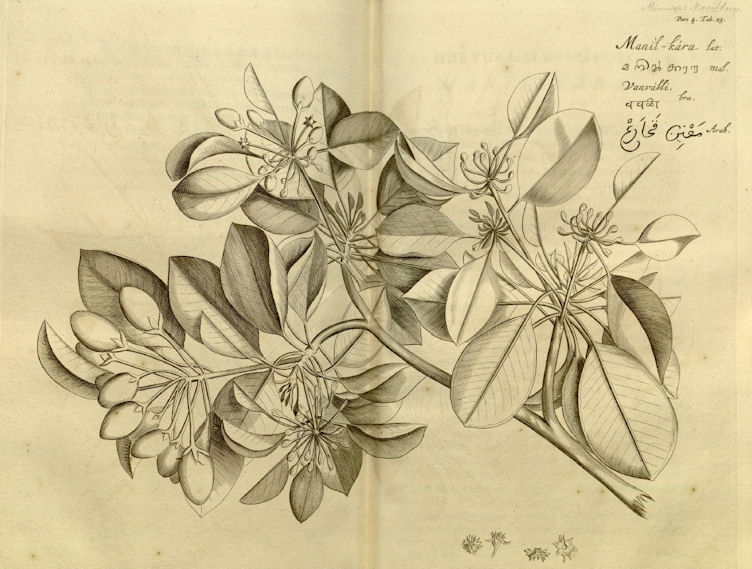
Abb.: Mimusops kanki Willd.
[Bildquelle: Hortus malabaricus IV. Fig. 25, 1683]
"Mimusops Kanki. Willd. 2. 326. [...]
Metrosideros macassarensis. Rumph. Amb. 3. t. 8.
Manil-kara. Rheed. Mal. 4. t. 25.
Malay. Booa-sow.
Achras dissecta. Linn. Supp. 210. Forsl. pl. escul. N. 13.
A native of the Malay Islands, Malabar, &c. It flowers during the hot season ; the fruit is edible, and large."
[Quelle: Roxburgh, William <1751-1815>: Flora indica, or, Descriptions of Indian plants / by the late William Roxburgh. -- Serampore : Printed for W. Thacker, 1832. -- Vol. 2, S. 238]
"Mimusops Kanki (Linn.) Description.--Tree; [...]
Fl. March-April.
Roxb. Fl. Ind. ii. 238.--Rheede iv. t.35 [richtig: 25].
Malabar.
Medical Uses.—The bark is astringent, and yields a kind of gummy fluid. The leaves ground and mixed with the root of Curcuma and ginger are used as cataplasm for tumours. The tree is extensively cultivated in China and Malabar on account of its acid and esculent fruit, which is said to increase the appetite. The leaves boiled in gingely oil and added to the pulverised barks are reckoned a good remedy in Beriberi—(Rheede. Hooker.) The seeds yield an oil which is applied to the eyes in ophthalmia, and also internally as an anthelmintic.—Powel's Punj. Prod."
[Quelle: Drury, Heber <1819 - 1872>: The useful plants of India : with notices of their chief value in commerce, medicine, and the arts. -- 2d ed. with additions and corrections. London : Allen, 1873. -- xvi, 512 p. ; 22 cm. -- s.v.]
Bis 10 m hoher, dorniger Baum.
| 26. a./b. rājādanaḥ phalādhyakṣaḥ kṣīrikāyām atha dvayoḥ iṅgudī tāpasatarur bhūrje carmi-mṛdutvacau
राजादनः फलाध्यक्षः क्षीरिकायाम्
अथ द्वयोः । [Bezeichnungen für Balanites aegyptiaca (L.) Delile 1813 - Zachunbaum - Desert Date1:]
|
Colebrooke (1807): "Ingua"
PW: "eine in allen Teilen medizinisch gebrauchte Pflanze; nach Ainsle, Mat. ind. 2, 230 Terminalia catappa [L., Combreatceae (Flügelsamengewächse)], ein Baum, der wohlschmeckende Nüsse trägt; wird in Bengalen, wie Śkdr. angibt, irriger Weise mit पुत्रजीव (Putranjiva roxburghii Wall.) verwechselt."
1 Achtung! Balanites aegyptiaca (L.) Delile 1813 ist ursprünglich ein Baum Afrikas und des mittleren Ostens!
Balanites aegyptiaca (L.) Delile 1813 - Zachunbaum - Desert Date
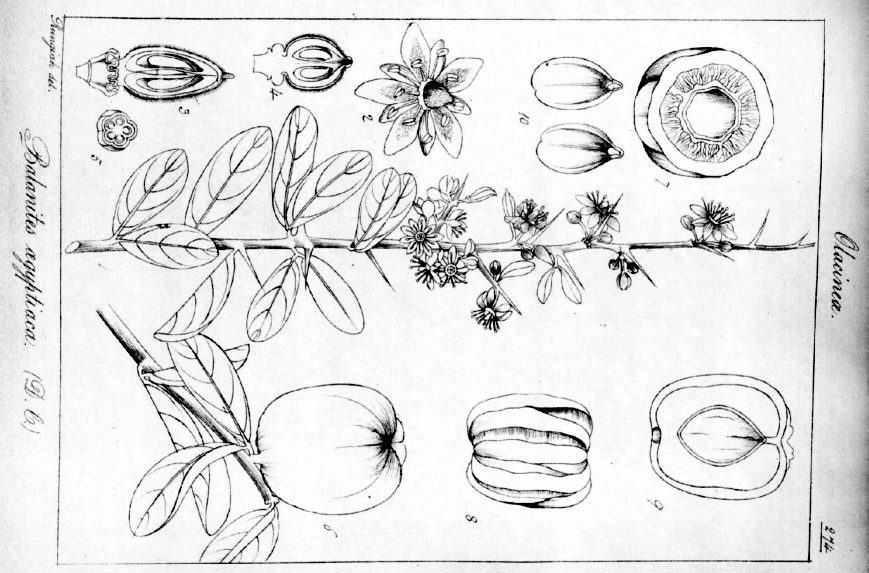
Abb.: इङ्गुदी
। Balanites aegyptiaca (L.)
Delile 1813 - Zachunbaum - Desert Date
[Wight Icones I, Tab. 274, 1840]
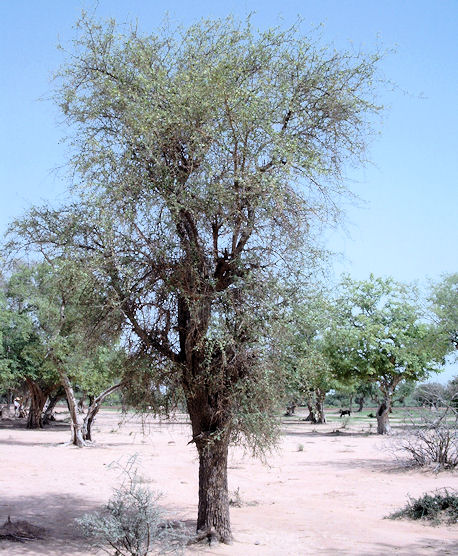
Abb.: तापसतरुः
। Balanites aegyptiaca (L.)
Delile 1813 - Zachunbaum - Desert Date, Thar Desert -
थार मरुधर
[Bildquelle: Marco Schmidt / Wikipedia. --
Creative Commons
Lizenz (Namensnennung, share alike)]
"BALANITES ROXBURGHII, Planch,.
Fig.—Wight Icon. 274. Egyptian myrobalan
Hab.—Drier parts of India, Egypt. The fruit.
[...]
History, Uses, &C.—This plant is sacred to Isis, who is represented with a crown of it in her hand. In Egypt it was also a symbol of farewell and hope given to dying people. The seeds are found along with other fruit seeds in the Egyptian tombs. The Greeks appear to have become acquainted with the tree through the Egyptians, and it is mentioned by Hippocrates, Theophrastus, Strabo and Dioscorides under the name of Persea—περσεα. Dioscorides says that the dried leaves are applied to blood eruptions, and that the fruit is often infested by an insect celled κρανοκολαπτον. Latin writers also notice the tree being sacred to Isis, and Pliny (15, 13,) says that Alexander gave orders that the victors should be crowned with it in the games which he instituted in honour of Perseus at Memphis. The fruit appears to have been occasionally confounded by the ancients with the Persica or peach, as it is sometimes described as edible. Baillon says that in Egypt the ripe fruit is called "desert date" and the unripe "Egyptian myrobalan." The African Arabs call the tree El Heglyg, and use the pulp as a detergent, and the bark to poison fish. In Senegambia the leaves are used as a vermifuge, and the roots and fruit as a purgative. (Carre et Lejanne,) In India Balanites is the Ingudi or Ingua of Sanskrit writers, who also call it Tapasa-taru and Munipadapa, "anchorite's tree," because the Gurus prepare from the seeds an oil for the lamp which they use in the ceremony of Guru-upasana, or initiation of a Hindu by his spiritual guide. Another name for the fruit is Gauri-tvac, which seems to connect it with the worship of Gauri or Isani, the Indian goddess of abundance, the earth, the sakti or power of Isvara or Mahadeva, in whose honour bombs made with the shell are exploded. The festival of this goddess, called Katyayanivrat, is conducted by women at the vernal equinox; an interesting description of it under the name of the Gangore festival will be found in Tod's Rajasthan (Vol. I., p. 570). In all parts of India a boat is used as described by Herodotus in the Isis worship at Busiris, and by Tacitus in the Ertha worship among the Suevi in Germany. At the Ganpati festival in India, Gauri is worshipped in the form of a cornucopoeia-shaped bouquet of leaves and flowers, and a similar emblem appertained to the Demeter or Ceres of the Greeks. Gauri also holds in her hand a Lotus flower as emblematic of reproduction. The leaves of Balanites are the Hingupatri of modern Sanskrit writers, but the true Hingu-patri was doubtless the Asafoetida leaf. In the Concan and in other parts of India where this tree is unknown, the oil for the Guru-upasana ceremony is obtained from Terminalia Catappa, a tree which is not a native of any part of India except perhaps the eastern borders of Bengal."
The unripe fruit of Balanites is found in the druggist's shops in many parts of India, and is used as a purgative and anthelmintic, the dose being half of the pulp of a single fruit; in smaller doses of from 2—20 grains it is expectorant. The bark, unripe fruit, and leaves are given to cattle as an anthelmintic. The physiological action of the bark and fruit is similar to that of the genus Polygala, and a few drops of a tincture of the fruit is as efficient an emulsifier as Tincture of Senega. The kernel yields a bland fatty yellow tasteless oil, which is applied to burns and sores."
[Quelle: Pharmacographia indica : a history of the principal drugs of vegetable origin met with in British India / by William Dymock [1834-1892], C. J. H. Warden and David Hooper [1858-1947]. -- Bd. 1. -- London, 1890. -- S. 284ff.]
Terminalia catappa L.
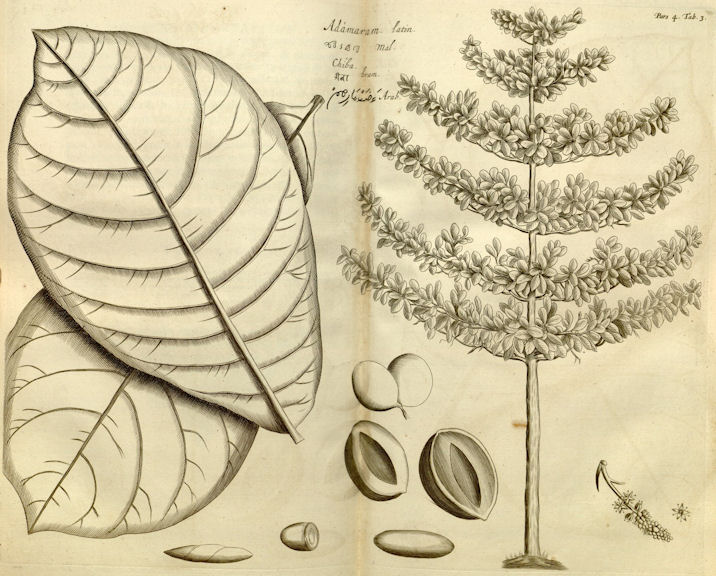
Abb.: Terminalia
catappa L.
[Bildquelle: Hortus malabaricus IV. Fig. 3, 1683]
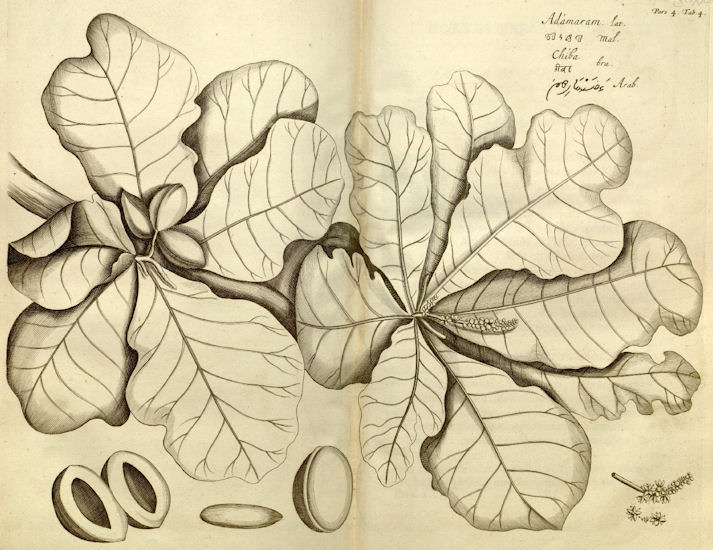
Abb.: Terminalia
catappa L.
[Bildquelle: Hortus malabaricus IV. Fig. 3, 1683]
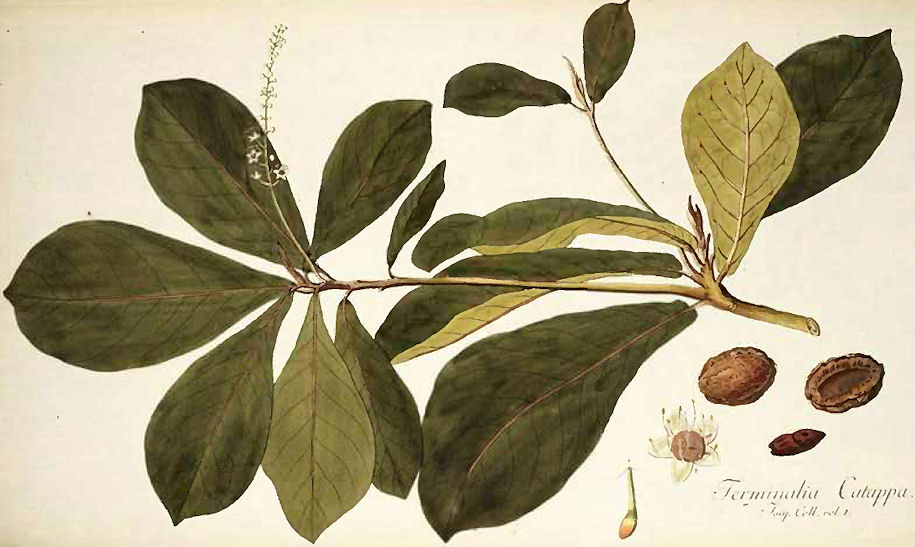
Abb.: Terminalia
catappa L.
[Bildquelle: Icones plantarum rariorum / editae Nicolao Josepho
Jacquin. -- Vol. 1. -- 1786 - 1793. -- Tab. 197]
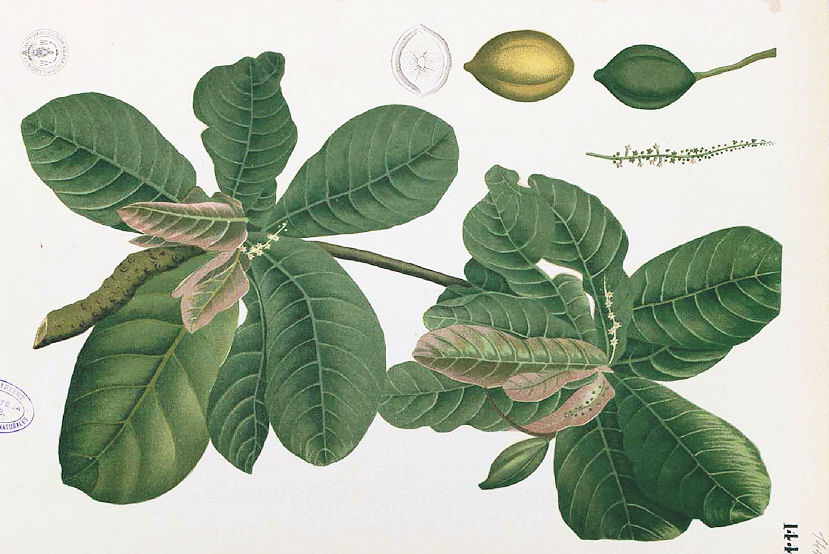
Abb.: इङ्गुदी
। Terminalia
catappa L.
[Bildquelle: Flora de Filipinas, 1880 / Wikipedia. -- Public domain]
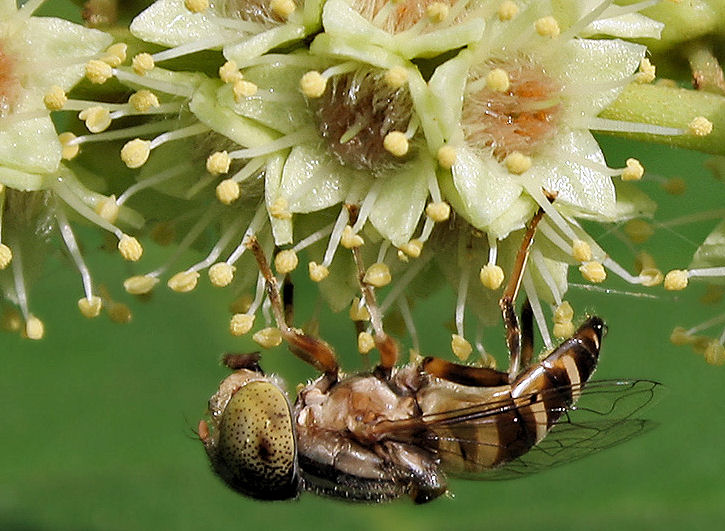
Abb.: इङ्गुदी
। Terminalia
catappa L., Hyderabad -
హైదరాబాద్ -
حیدرآباد, Andhra Pradesh
[Bildquelle: J. M. Garg / Wikipedia.
-- GNU FDLicense]
"Terminalia Catappa. Willd. 4. 967. [...]
A most beautiful, large tree, found in gardens, &c. near towns and villages, where indigenous, I have not been able to ascertain. On the Coromandel coast it is in flower and fruit almost the whole year.
[...]
The kernels are fully as palatable as the best filberts, or even almonds, and I have every reason to think they are equally wholesome, and nutritive. The tree is highly ornamental, few surpassing it in elegance and beauty. The wood is also useful."
[Quelle: Roxburgh, William <1751-1815>: Flora indica, or, Descriptions of Indian plants / by the late William Roxburgh. -- Serampore : Printed for W. Thacker, 1832. -- Vol. 2, S. 430f.]
"Terminalia catappa (Linn.) Indian Almond.
Description.--Tree, 50 feet; [...]
Fl. March-April.
W. & A. Prod. i. 313.--Rheede iv. t. 3,4.--Roxb. Fl. Ind. ii. 430.--Wight Icon. t. 172.
Cultivated.
Medical Uses.—The bark is astringent. The kernels, known as country almonds, might probably be used as a substitute for the officinal almond. They yield upwards of fifty per cent of pure bland oiL After being kept for some time, this oil deposits a large proportion of stearine.—(Journ. of Agri. Hort. Soc. of India, ii. 539.) The oil which is expressed from the seeds is edible and pleasant- tasted. To extract it, the fruit is gathered and allowed to dry in the sun for a few days, when the kernels are cleaned, and bruised in a mill. Six seers of almonds will produce 3 pucka seers of oil. The colour is a deep straw. It is very like Europe almond-oil both in taste and smell, but becomes turbid by keeping. It only requires care and attention in its preparation to render it of greater commercial value and importance.—Ainslie. Pharm. of India.
Economic Uses.—The tree is handsome and ornamental, and answers well for avenues. The timber is light but lasting, and is useful for many purposes. The bark and leaves yield a Hack pigment, with which the natives dye their teeth and make Indian ink. The levers of Pakottahs are usually made of the timber of this tree. Tussah-silk worms feed on the leaves. Rheede says the tree bears fruit three times a year on the Malabar coast. It is a native of the Moluccas.—Roxb. Ainslie."
[Quelle: Drury, Heber <1819 - 1872>: The useful plants of India : with notices of their chief value in commerce, medicine, and the arts. -- 2d ed. with additions and corrections. London : Allen, 1873. -- xvi, 512 p. ; 22 cm. -- s.v.]
"Terminalia Catappa, Linn., [...] the Catappa of the Malays, is now cultivated all over India, and is known as the almond tree (Badam) to both natives and Europeans. The fruit is an oval, compressed, smooth drupe, with two elevated grooved margins; it is about 2 inches long and of a dull purple colour when ripe, the pulp being bright purple. The nut is rough, hard and the kernel which is about half the size of an almond and nearly cylindrical, is in common use in Bengal, amongst Europeans under the name of "leaf nut." According to Brannt the almonds contain 28 per cent, of oil, which excels almond oil as regards flavour and mildness, and has the further advantage of keeping well. It is of a pale yellowish colour and entirely inodorous. Its specific gravity is 918 at 15° C, and it is composed chiefly of stearin and olein, the stearin separating at 5° C. The bark is astringent, and has been recommended for internal administration in the form of decoction as a remedy for gonorrhoea and leucorrhcea. (Pharm. de St. Domingo.) The tree yields a gum of the Bassora type."
[Quelle: Pharmacographia indica : a history of the principal drugs of vegetable origin met with in British India / by William Dymock [1834-1892], C. J. H. Warden and David Hooper [1858-1947]. -- Bd. 2. -- London, 1891. -- S. 16f.]
Betulaceae (Birkengewächse)
Strauch oder bis 20 m hoher Baum.
| 26. c./d.
iṅgudī tāpasatarur bhūrje carmi-mṛdutvacau इङ्गुदी तापसतरुर् भूर्जे चर्म्मि-मृदुत्वचौ ॥२६ ख॥ Bezeichnungen für भूर्ज - bhūrja m.: Birke, Betula utilis D. Don. 1825 - Himalaya-Birke - Himalayan Silver Birch:
|
Colebrooke (1807): "Bhojapatr. The bark is used."
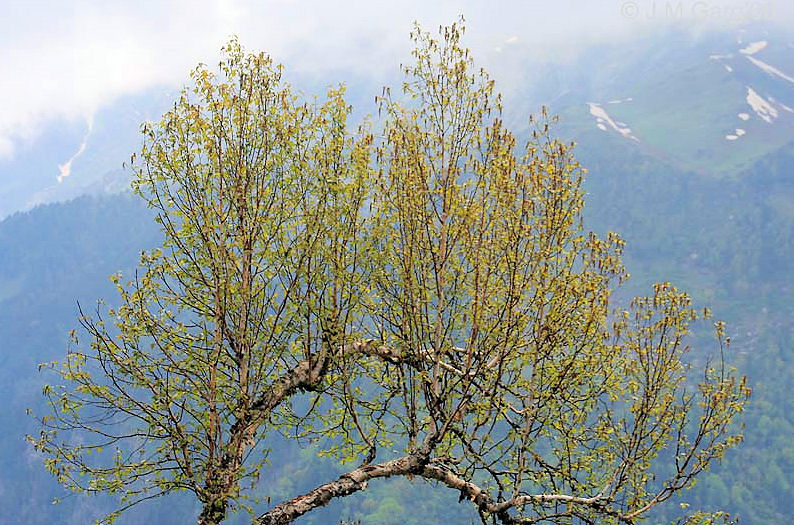
Abb.: भूर्जः । Betula utilis D. Don. 1825 - Himalaya-Birke -
Himalayan Silver Birch, Kullu -
कुल्लू, Himachal Pradesh
[Bildquelle: J. M. Garg / Wikipedia.
-- GNU FDLicense]
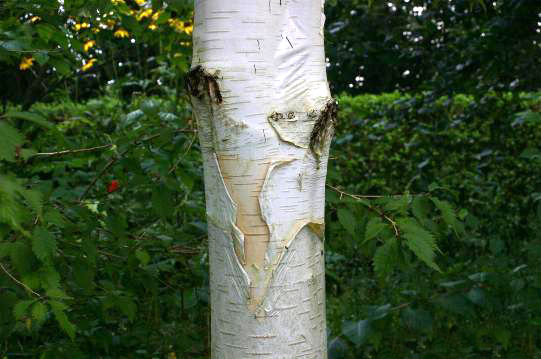
Abb.: चर्मी । Betula utilis D. Don. 1825 - Himalaya-Birke -
Himalayan Silver Birch
[Bildquelle: Sten / Wikipedia. -- GNU FDLicense]
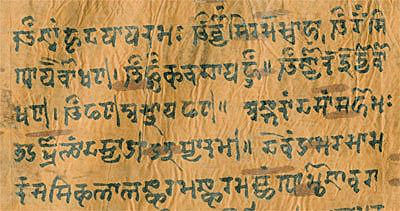
Abb.: मृदुत्वचः । Manuskript auf Birkenrinde, UB Tübingen, ca. 17. Khdt. n.
Chr.
[Bildquelle: Wikipedia. -- Public domain]
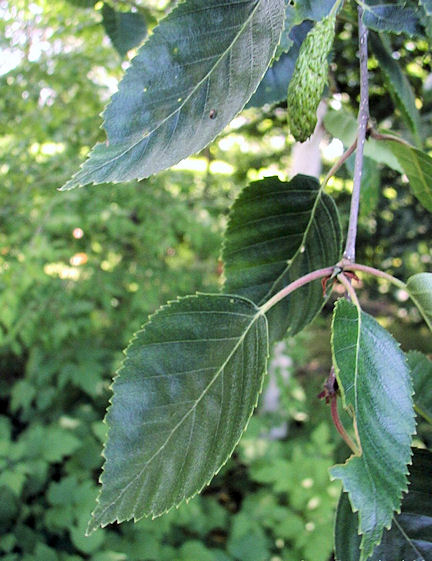
Abb.: भूर्जः । Betula utilis D. Don. 1825 - Himalaya-Birke -
Himalayan Silver Birch
[Bildquelle: Sten Porse / Wikimedia. -- GNU FDLicense]
"BETULA UTILIS, Don. Himalayan Birch
Hab.—Temperate Himalaya, Afghanistan,
BETULA ALNOIDES, Ham.
Hab.—Temperate and subtropical Himalaya. The bark.
Vernacular.— Bhujpatar (Ind. Bazaars).
History, Uses, &c.--Those trees require a brief notice, as the bark, in Sanskrit Bhurjapatra, is much used all over the country for writing medicinal charms on, and is to be found in every druggist's shop. This bark is well-known as the material upon which the ancient Sanskrit manuscripts of Northern India are written.
Dr. Bühler, in his account of a tour in Cashmere in search of Sanskrit manuscripts, says: -
"The Bhurja MSS. are written on specially prepared thin sheets of the inner bark of the Himalayan birch, and invariably in Sārada characters. The lines run always parallel to the narrow side of the leaf, and the MSS. present, therefore, the appearance of European books, not of Indian MSS., which owe their form to an imitation of the Talapartas. The Himalayas seem to contain an inexhaustible supply of birch-bark, which in Cashmere and other hill countries is used both instead of paper by the shop-keepers in the bazaars, and for lining the roofs of houses in order to make them water-tight. It is also exported to India, where in many places it is likewise used for wrapping up parcels, and plays an important part in the manufacture of the flexible pipe-stems used by hukā-smokers. To give an idea of the quantities which are brought into Srinagar, I may mention that on one single day I counted fourteen large barges with birch-bark on the river, and that I have never moved about without seeing some boats laden with it. None of the boats carried, I should say, less than three of four tons' weight."
"The use of birch-bark for literary purposes is attested by the earliest classical Sanskrit writers. Kalidāsa mentions it in his dramas and epics; Suśruta, Varahāmihira (circa 500-550 A.D.) know it likewise. Akbar introduced the manufacture of paper, and thus created an industry for which Cashmere is now famous in India. From that time the use of birch-bark for the purpose of writing was discontinued, and the method of preparing it has been lost. The preparation of the ink, which was used for Bhūrja MSS., is known. It was made by converting almonds into charcoal and boiling the coal thus obtained with gomūtra (urina bovis); this ink is not affected by damp or water." (Journal, Bombay Branch Royal Asiatic Society, Vol. XII., No. XXXIV. A.)"
[Quelle: Pharmacographia indica : a history of the principal drugs of vegetable origin met with in British India / by William Dymock [1834-1892], C. J. H. Warden and David Hooper [1858-1947]. -- Bd. 3. -- London, 1883. -- S. 359f.]
Bombacaceae (Wollbaumgewächse)
Bis 25 m hoher Baum.
| 27. picchilā pūraṇī mocā sthirāyuḥ śālmalir dvayoḥ picchā tu śālmalīveṣṭe rocanaḥ kūṭaśālmaliḥ
पिच्छिला पूरणी मोचा स्थिरायुः शाल्मलिर् द्वयोः । [Bezeichnungen für Bombax ceiba L. 1753 - Roter Seidenwollbaum - Red Silk Cotton Tree:]
Das Harz des Śālmali heißt पिच्छा - picchā f.: Schleim |
Colebrooke (1807): "Silk cotton. [27d:] Its gum. Bombax heptaphyllum [= Bombax ceiba L. 1753]."
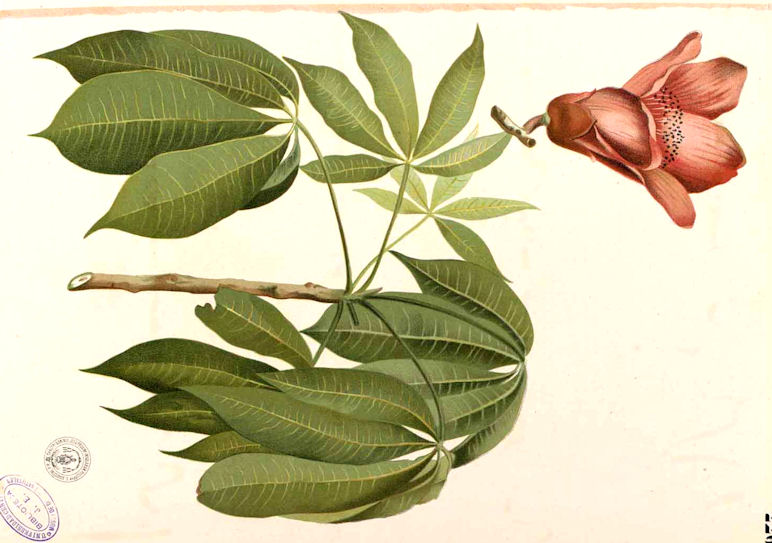
Abb.: शाल्मलिः । Bombax ceiba L. 1753 - Roter Seidenwollbaum -
Red Silk Cotton Tree
[Bildquelle: Flora de Filipinas, 1880 / Wikipedia. -- Public domain]

Abb.: पिच्छिला । Bombax ceiba L. 1753 - Roter Seidenwollbaum -
Red Silk Cotton Tree, Kolkata - কলকাতা, West
Bengal
[Bildquelle: J. M. Garg / Wikipedia.
-- GNU FDLicense]
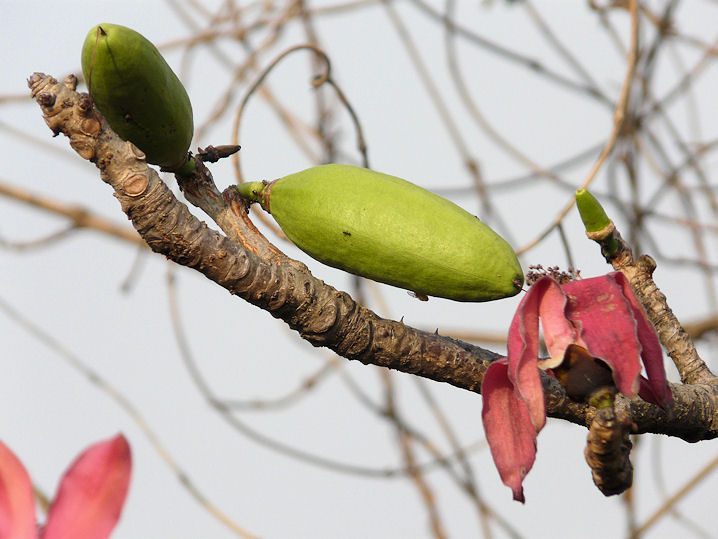
Abb.: मोचा । Bombax ceiba L. 1753 - Roter Seidenwollbaum -
Red Silk Cotton Tree, Thane -
ठाणे,
Maharashtra
[Bildquelle: dinesh_valke. --
http://www.flickr.com/photos/dinesh_valke/2318599903/s. -- Zugriff am
2010-10-13. --
Creative
Commons Lizenz (Namensnennung, keine kommerzielle Nutzung, keine
Bearbeitung)]
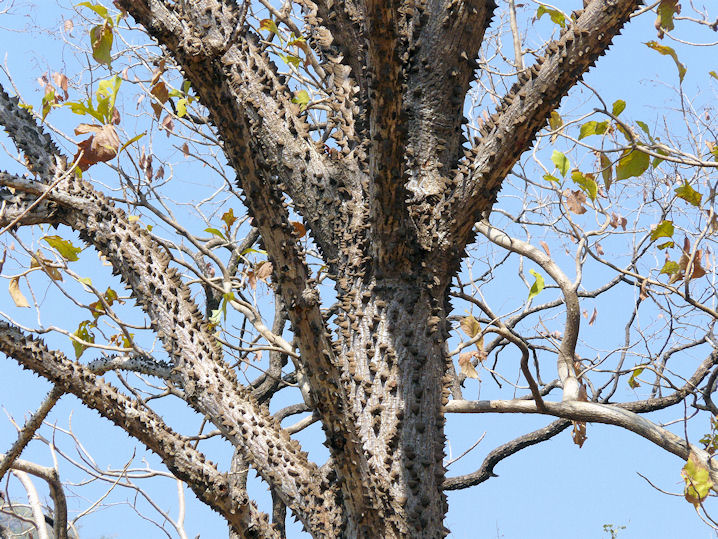
Abb.: शाल्मलिः । Bombax ceiba L. 1753 - Roter Seidenwollbaum -
Red Silk Cotton Tree
[Bildquelle: dinesh_valke. --
http://www.flickr.com/photos/dinesh_valke/3272409614/. -- Zugriff am
2010-10-13. --
Creative
Commons Lizenz (Namensnennung, keine kommerzielle Nutzung, share alike)]
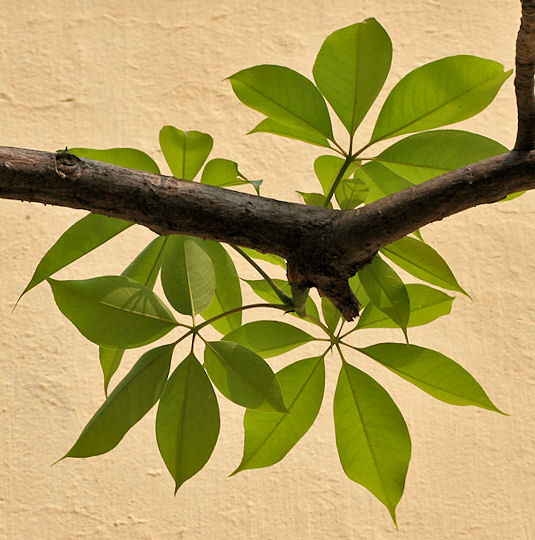
Abb.: शाल्मलिः । Bombax ceiba L. 1753 - Roter Seidenwollbaum -
Red Silk Cotton Tree, Kolkata - কলকাতা, West
Bengal
[Bildquelle: J. M. Garg / Wikipedia.
-- GNU FDLicense]
"Bombax heptaphylla. Willd. iii. 732. [...]
Salmuli, the Sanscrit name; see Asiat. Res. iv. 296.
[...]
This is one of the largest of our Indian trees and is found almost every where; over the northern Circars, near the mountains, they grow to a greater size than I have seen them any where else, often about one hundred feet high, the trunk thick and ramous in proportion. Flowering time, the end of winter, when the tree is totally destitute of leaves. The great numbers of very large, bright red flowers with which it is then covered, makes it remarkably conspicuous at a very great distance.
[...]
In my description of this tree, I have been particularly full, because I am inclined to think it differs essentially from the West Indian species, which Linnaeus called Ceiba Jacquin's full, and I presume, accurate description of that tree is now before me, and leaves in my mind little doubt of their being very different. This and the former pentandrum, are the only species of this genus I have hitherto met with in India, except B. gossypinum, which is polyandrous. If this be not what Linnaeus calls B. heptaphyllum, and Jacquin, Septenatum, I cannot say what it is. He quotes Moul elavou of the Hortus Malabaricus for it; and at the same time points it out to be an American tree. Be that as it may, there can be no doubt of Rheed's plant being the one I have now described and figured.
The wood is white, light and spongy, fit for very few purposes. In India the wool is used to stuff beds and pillows, and to put between the folds of quilted cloth."
[Quelle: Roxburgh, William <1751-1815>: Flora indica, or, Descriptions of Indian plants / by the late William Roxburgh. -- Serampore : Printed for W. Thacker, 1832. -- Vol. 3, S. 167ff.]
"BOMBAX MALABARICUM, DC. Red silk-cotton tree.
[...]
History, Uses, &c--B. malabaricum, in Sanskrit Sālmali, and Mocha, is a large tree, covered with stout, hard conical prickles, on which account it bears the Sanskrit synonym of Kantakadruma. In the Mahābhārata it is related that Pitāmāha after having created the world, reposed under the tree Sālmali, and in the code of Yajnavalkya it is mentioned as one of the trees of the infernal regions (yamadruma), because it makes a great show of flowers, but produces no fruit fit to eat. At the end of the cold season this tree is a very remarkable object, being entirely destitute of leaves, and loaded with large, red, cup-shaped flowers, which are followed by egg-shaped, green capsules, containing numerous brown seeds having an average weight of 4-5th of a grain, and a quantity of fine silky cotton. Hindu and Mahometan writers state that the root of the young tree (mūsla-semul), when about as large as a carrot, has restorative, astringent and alterative properties; powdered and mixed with sugar, ghi and the juice of the fresh root, it is made into a pāk or confection which has a reputation as an aphrodisiac, and as a restorative in phthisis and other wasting diseases. In some parts of India the root of the white silk-cotton tree (Eriodendron anfractuosum) is preferred for this purpose. This tree is the Lanifera arbor of Clusius, the pods of which were first brought to Holland about the end of the 16th century; its cotton is the Capock fibre of the Dutch, and the tree, like the Bombax, yields a dark-coloured opaque gum, insoluble in water, which is used as an astringent in bowel complaints. The natives regard E. anfractuosum as a variety of the Bombax, and call it śveta-sālmali or "white śālmali" in Sanskrit. In Hindi it is Safed-semul, in Marathi Pāndhra-saur, in Guzerati Dolo-shemalo, &c., all names which have a similar meaning. In Madras the young fruits are dried and used as a demulcent and astringent. The gum of the Bombax is very astringent, and is used by both Hindus and Mahometans in diarrhoea, dysentery, and menorrhagia in doses of from 40-50 grains for an adult. Sālmali voshta or Mocha-ras (juice of mocha) only exudes from portions of the bark which have been injured by decay or insects; incisions in the healthy bark produce nothing."
[Quelle: Pharmacographia indica : a history of the principal drugs of vegetable origin met with in British India / by William Dymock [1834-1892], C. J. H. Warden and David Hooper [1858-1947]. -- Bd. 1. -- London, 1890. -- S. 215f.]
Bombacaceae (Wollbaumgewächse)
Bis 60 m hoher Baum.
| 27. c./d. picchā tu śālmalīveṣṭe rocanaḥ kūṭaśālmaliḥ पिच्छा तु शाल्मलिवेष्टे रोचनः कूटशाल्मलिः ॥२७ ख॥ [Bezeichnungen für Ceiba pentandra (L.) Gaertn. 1791 - Weißer Kapokbaum - Silk Cotton Tree:]
|
Colebrooke (1807): "Another sort of silk-cotton."
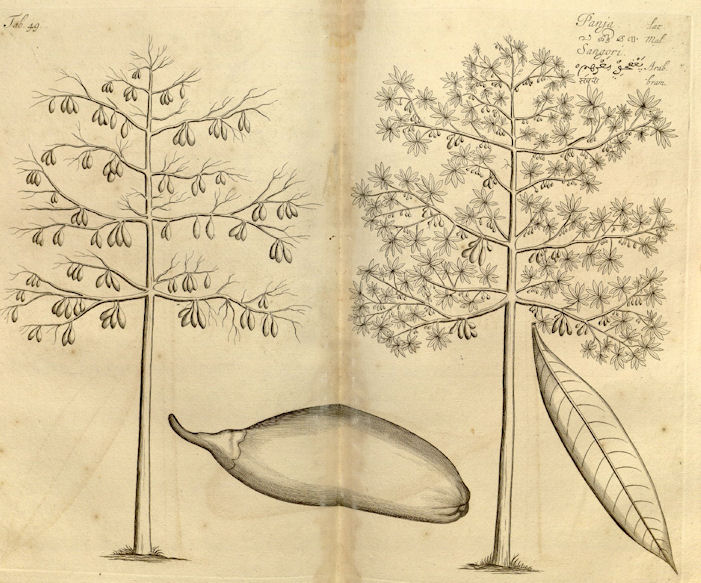
Abb.: कूटशाल्मलिः । Ceiba pentandra (L.) Gaertn. 1791 - Weißer
Kapokbaum - Silk Cotton Tree
[Bildquelle: Hortus malabaricus III. Fig. 49, 1682]
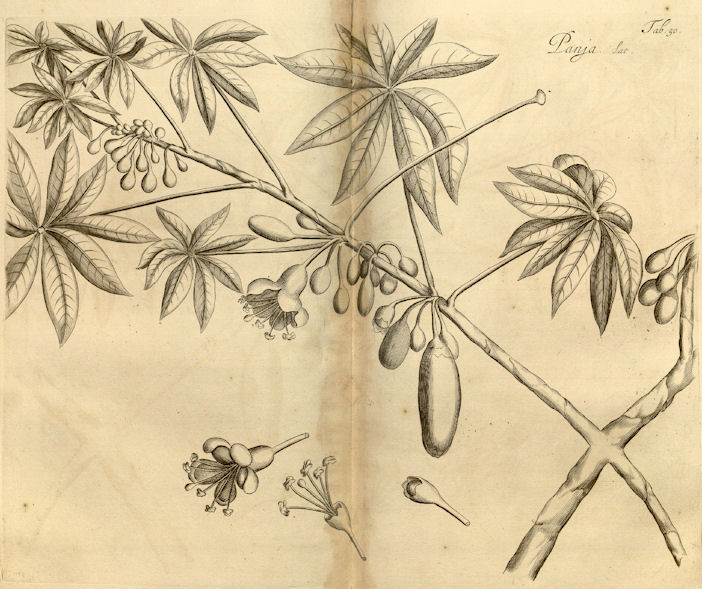
Abb.: कूटशाल्मलिः । Ceiba pentandra (L.) Gaertn. 1791 - Weißer
Kapokbaum - Silk Cotton Tree
[Bildquelle: Hortus malabaricus III. Fig. 50, 1682]
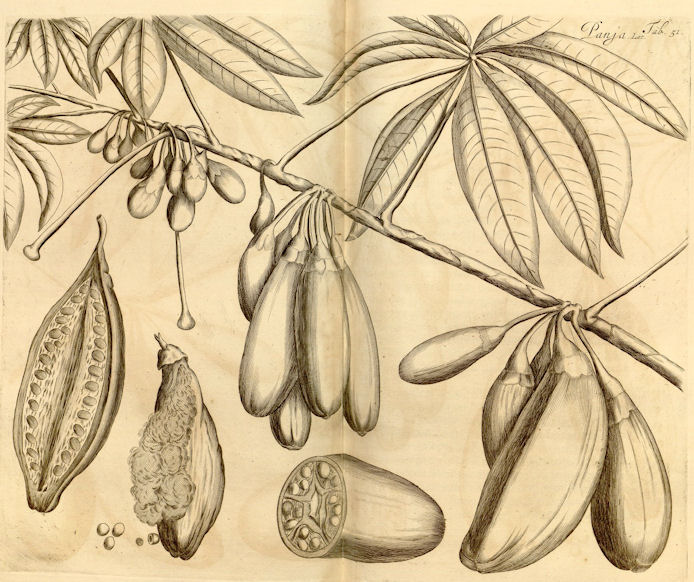
Abb.: कूटशाल्मलिः । Ceiba pentandra (L.) Gaertn. 1791 - Weißer
Kapokbaum - Silk Cotton Tree
[Bildquelle: Hortus malabaricus III. Fig. 51, 1682]
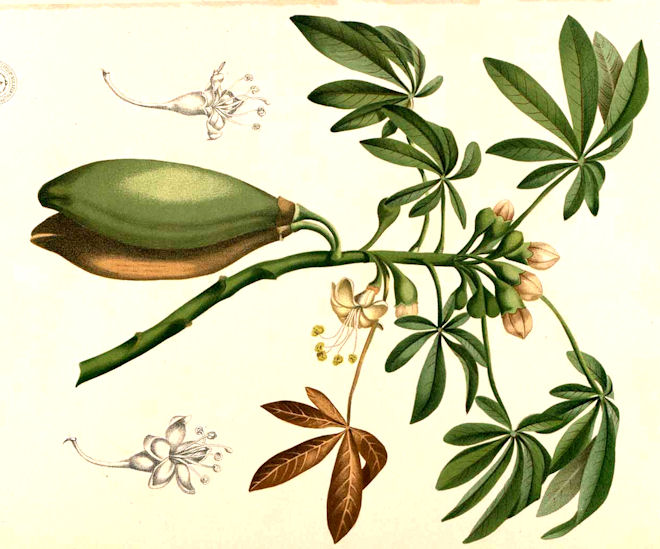
Abb.: कूटशाल्मलिः । Ceiba pentandra (L.) Gaertn. 1791 - Weißer
Kapokbaum - Silk Cotton Tree
[Bildquelle: Flora de Filipinas, 1880 / Wikipedia. -- Public domain]
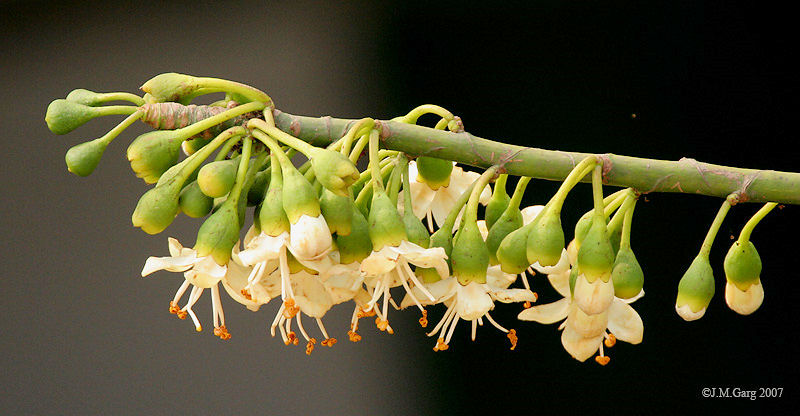
Abb.: रोचनः । Ceiba pentandra (L.) Gaertn. 1791 - Weißer
Kapokbaum - Silk Cotton Tree, Kolkata - কলকাতা, West
Bengal
[Bildquelle: J. M. Garg / Wikipedia.
-- GNU FDLicense]
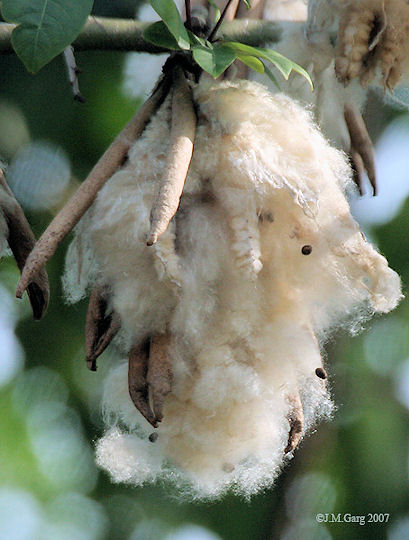
Abb.: रोचनः । Ceiba pentandra (L.) Gaertn. 1791 - Weißer
Kapokbaum - Silk Cotton Tree, Kolkata - কলকাতা, West
Bengal
[Bildquelle: J. M. Garg / Wikipedia.
-- GNU FDLicense]
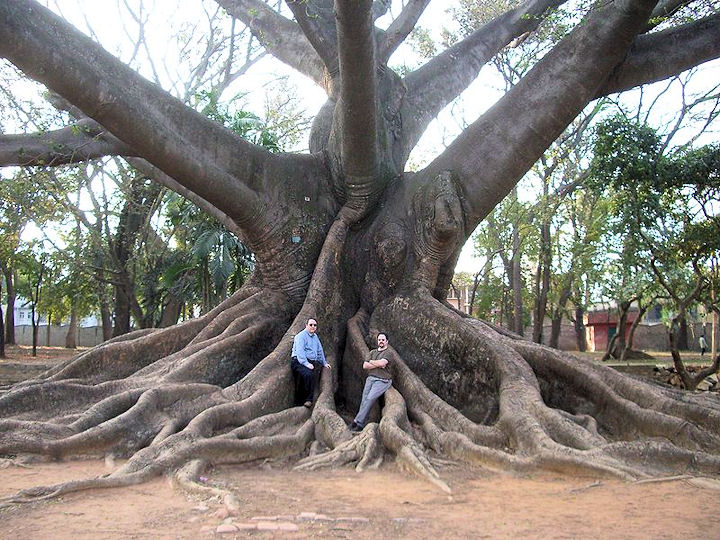
Abb.: कूटशाल्मलिः । Ceiba pentandra (L.) Gaertn. 1791 - Weißer
Kapokbaum - Silk Cotton Tree, Bangalore -
ಬೆಂಗಳೂರು,
Karnataka
[Bildquelle: Chris Hibbard / Wikipedia. -- Public domain]
"Bombax pentandrum. Willd. iii. 731. [...]
Ceiba pentandra. Gaert. Sem. ii. 244. t. 133.
[...]
This elegant, straight, sub-verticelled tree, seems to differ from the West India species, probably specifically; it is found in every part of India. On the Coromandel coast, the Tamuls plant them about their temples. In Bengal, where the winters are colder, the leaves drop off during the cold season. In February, when destitute of foliage, the blossoms appear, and soon afterwards the leaves ; and the seed ripens in May."
[Quelle: Roxburgh, William <1751-1815>: Flora indica, or, Descriptions of Indian plants / by the late William Roxburgh. -- Serampore : Printed for W. Thacker, 1832. -- Vol. 3, S. 165.]
Fabaceae (Hülsenfrüchtler)
Bis 25 m hoher, laubabwerfender Baum.
| 28. a./b. cirabilvo naktamālaḥ karajaś ca karañjake चिरबिल्वो नक्तमालः करजश् च करञ्जके ।२८ क। Bezeichnungen für करञ्जक - karañjaka m.: Karañjaka, Millettia pinnata (L.) Panigrahi - Pongamia:
|
Colebrooke (1807): "Caranj. Galedupa arborea or Robinia mitis [L.] [= Millettia pinnata (L.) Panigrahi]."
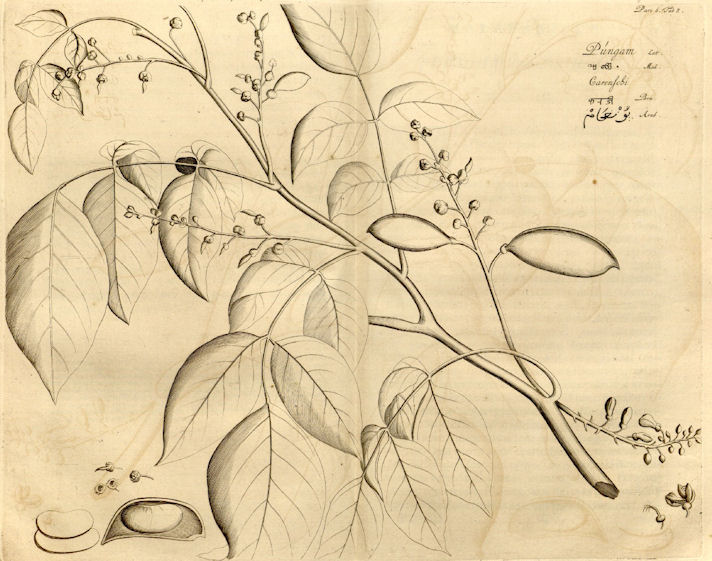
Abb.: करञ्जकः । Millettia pinnata (L.) Panigrahi - Pongamia
[Bildquelle: Hortus malabaricus VI. Fig. 3,
1686]
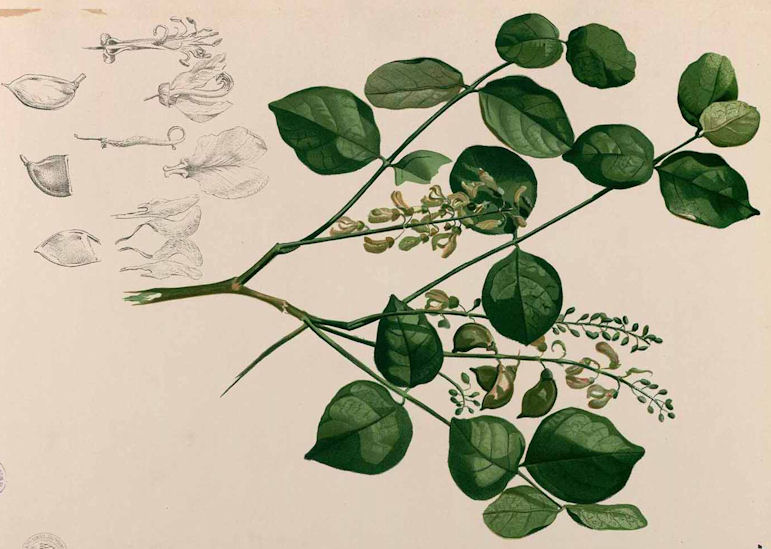 S
S
Abb.: करञ्जकः । Millettia pinnata (L.) Panigrahi - Pongamia
[Bildquelle: Flora de Filipinas, 1880 / Wikipedia. -- Public domain]
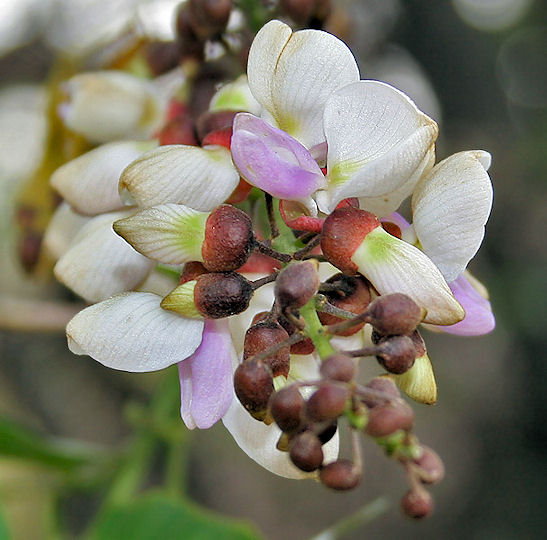
Abb.: नक्तमालः । Millettia pinnata (L.) Panigrahi - Pongamia,
Sharmipet - షామీర్పేట్, Andhra Pradesh
[Bildquelle: J. M. Garg / Wikipedia.
-- GNU FDLicense]
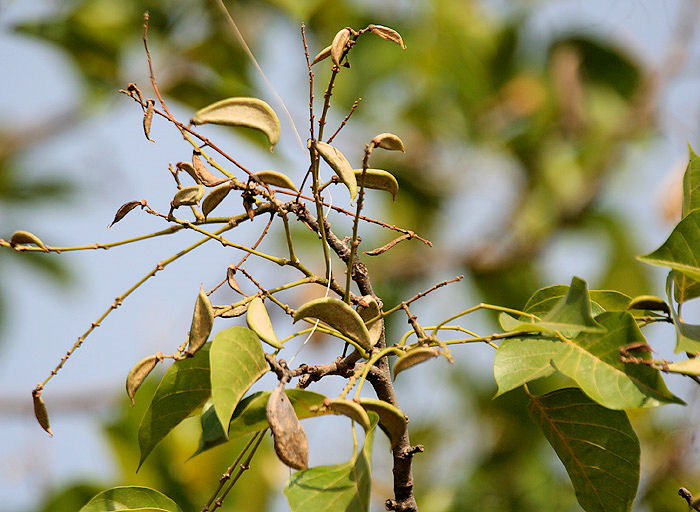
Abb.: करजः । Millettia pinnata (L.) Panigrahi - Pongamia,
Hyderabad -
హైదరాబాద్ -
حیدرآباد, Andhra Pradesh
[Bildquelle: J. M. Garg / Wikipedia.
-- GNU FDLicense]
"Galedupa indica. Lamarck. Encycl. ii. 594. [...]
Sans. Karunjuka.
Hind, and Beng. Kurunja, or Kenja.
Robinia mitis. Linn. sp. 1044.
[...]
A pretty large timber tree, from forty to fifty feet high, common over all the coast, Bengal, &c. Leaves deciduous at the end of the cold season, and in about a month are succeeded by the new foliage. Flowers during the hot season; and the seed ripens toward the dose of the year.
[...]
The wood of this tree is light, white, and firm; it serves for a variety of economical purposes. Branches stuck in the ground to fence round some Cinnamon trees, grew readily ; grass and almost every thing else grows well under its shade The seeds yield an useful oil ; and cattle are fond of the leaves."
[Quelle: Roxburgh, William <1751-1815>: Flora indica, or, Descriptions of Indian plants / by the late William Roxburgh. -- Serampore : Printed for W. Thacker, 1832. -- Vol. 3, S. 239f.]
"Pongamia glabra (Vent.) N. O. Leguminosae. Indian Beech.
Description.--Tree; [...]
Fl. April-May.
W. & A. Prod. i. 262.--Wight Icon. t. 59.
Robinia mitis, Linn.
Dalbergia arborea, Willd.--Rheede vi. t. 3.
Coromandel. Concans. Travancore. Bengal.
Medical Uses
.—The seeds yield by expression a fixed oil, which the natives use externally in eruptive diseases.—(Roxb.) It holds a high place as an application in scabies, herpes, and other cutaneous diseases. Dr Gibson asserts that he knows no article of the vegetable kingdom possessed of more marked properties in such cases than the above. The oil is much used as an embrocation in rheumatism. Dr Crosse (Journ. Agri.-Hort. Soc., 1858, x. pt. ii p. 223) has made some valuable remarks on the physical characters and properties of this oil.—Pharm. of India.Economic Uses
.—The wood, which is light, white, and firm, is used for many economical purposes. The oil is used in lamps , among the poorer classes. The leaves are eaten by cattle, and are valuable as a strong manure, especially for the sugar-cane.—Roxb."[Quelle: Drury, Heber <1819 - 1872>: The useful plants of India : with notices of their chief value in commerce, medicine, and the arts. -- 2d ed. with additions and corrections. London : Allen, 1873. -- xvi, 512 p. ; 22 cm. -- s.v.]
"PONGAMIA GLABRA, Vent. [...]
History, Uses, &c.--This is a handsome flowering tree with foliage like the Beech. Sanskrit writers call it Karanja and Naktamāla or Naktamālaka, "garland of the night," and in Hindi it is sometimes called Sukhchain, "affording perfect satisfaction to the senses"; indeed, it well deserves these names, as nothing can be more beautiful than its drooping branches of shining green leaves laden with racemes of rose-coloured flowers. The seeds, leaves, and oil are used in Hindu medicine as a remedy for skin diseases and rheumatism and to destroy worms in sores. Chakradatta mentions a paste made of the seeds along with those of Cassia Tora and the root of Saussurea Lappa as a useful application to skin diseases. He also gives prescriptions for a compound oil and ghrita to be used for the same purpose (see Dutt's Mat. Med., p. 153), where the original prescriptions are given with a translation.
Rheede notices the use of a bath prepared with the leaves, to remove rheumatic pains; and they appear to be in general use for this purpose. Ainslie says that the juice of the root is used for cleansing foul ulcers, and closing fistulous soles. He also notices the oil and its use in itch and rheumatism. Gibson speaks very highly of the oil as a remedy in scabies, herpes, and other cutaneous diseases of a similar nature; it should be mixed with an equal quantity of lemon juice and be well shaken, when it forms a rich yellow liniment which we have used successfully in porrigo capitis, pityriasis and psoriasis. In leprosy the natives prescribe the leaves with those of Plumbago, along with some pepper and salt, to be powdered and given in curds. Karanja is also an ingredient in several complicated prescriptions for epilepsy and abdominal enlargements. Dr. P. S. Mootooswamy mentions the use of the juice of the root with cocoanut milk and lime water as a remedy for gonorrhoea in Tanjore, and of the leaves (Ponga-illai, Tamil) in flatulency, dyspepsia, and diarrhoea. He also informs us that the broken rice is boiled with the leaves and those of Morinda citrifolia, dried in the shade, cleaned and crushed, and from this preparation a thin salt gruel is made to feed young children with instead of cow's milk, which is supposed to cause glandular enlargements of the abdomen. He has noticed the use of the flowers as a remedy for diabetes, and of the pods worn round the neck as a protective against whooping cough. (Indian Med. Gaz., 1888.) Dr. B. Evers has seen the seeds administered internally for the last named affection. The oil is in general use amongst the agricultural classes as a lamp oil."
[Quelle: Pharmacographia indica : a history of the principal drugs of vegetable origin met with in British India / by William Dymock [1834-1892], C. J. H. Warden and David Hooper [1858-1947]. -- Bd. 1. -- London, 1890. -- S. 468f.]
Siehe:
Carakasaṃhitā: Ausgewählte Texte aus der Carakasaṃhitā / übersetzt und erläutert von Alois Payer <1944 - >. -- Anhang A: Pflanzenbeschreibungen. -- Pongamia pinnata (L.) Merr. -- URL: http://www.payer.de/ayurveda/pflanzen/pongamia_pinnata.htm
Caesalpiniaceae (Johannisbrotgewächse)
Strauch oder bis über 10 m langes Rankengewächs
| 28. c./d. prakīryaḥ pūtikarajaḥ pūtikaḥ kalimārakaḥ प्रकीर्यः पूतिकरजः पूतिकः कलिमारकः ॥२८ ख॥ [Bezeichnungen für Caesalpinia crista L. - Bonduc Nut:]
|
Colebrooke (1807): "Gray Bonduc. Caesalpinia, or Guilandia, bonducella [= Caesalpinia crista L.]"
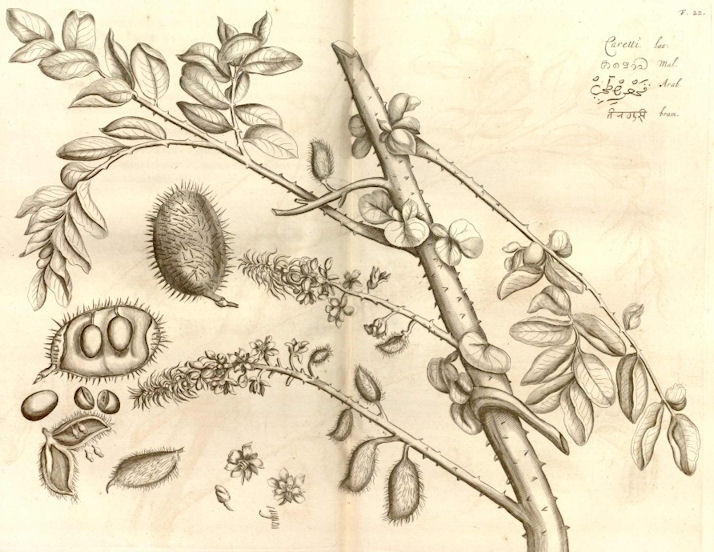
Abb.: पूतिकरजः
। Caesalpinia crista L. - Bonduc Nut
[Bildquelle: Hortus malabaricus II. Fig. 22,
1679]
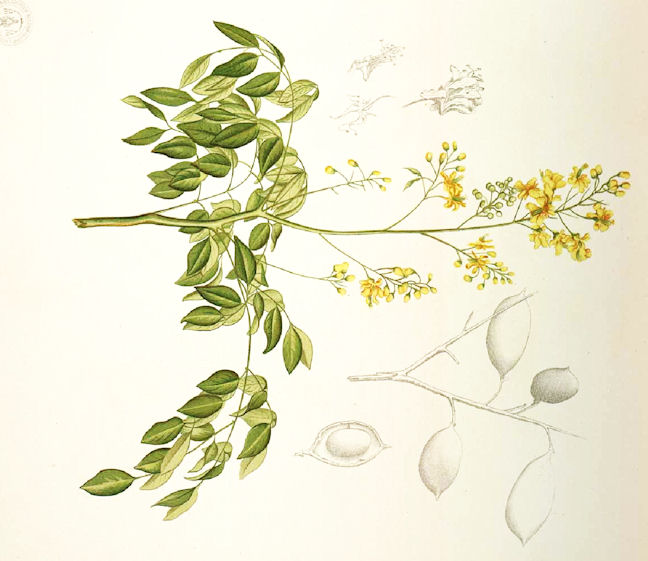
Abb.: पूतिकरजः
। Caesalpinia crista L. - Bonduc Nut
[Bildquelle: Flora de Filipinas, 1880 / Wikipedia. -- Public domain]
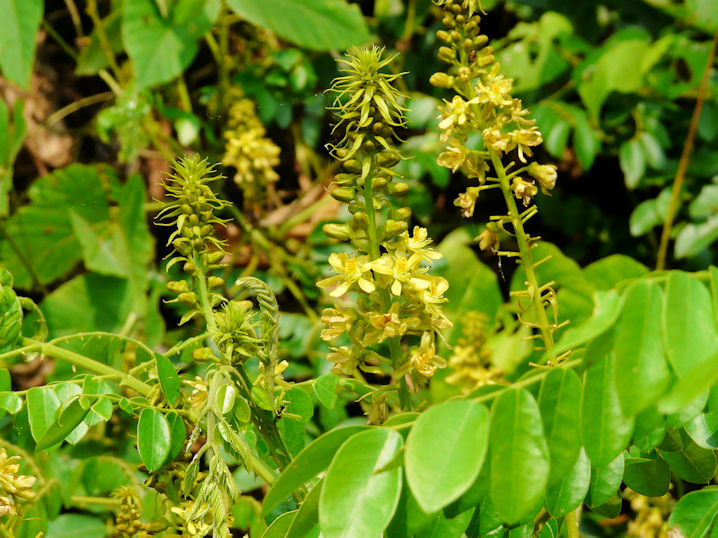
Abb.: पूतिकः
। Caesalpinia crista L. - Bonduc Nut
[Bildquelle: dinesh_valke. --
http://www.flickr.com/photos/dinesh_valke/2912827338/. -- Zugriff am
2010-10-13. --
Creative
Commons Lizenz (Namensnennung, keine kommerzielle Nutzung, share alike)]
"Caesalpinia Bonduccella. R. Fleming in Asiat. Res. 11. 159.
[...]
Puticaraja. Asiat. Res. 2. p- 351 ; also 4. p, 276, and 11.159.
Guilandina bonduccella. Linn. Lamarck, &c.
[...]
The plants reared from seed from the West Indies, proved to be exactly the same. The seed is a powerful tonic."
[Quelle: Roxburgh, William <1751-1815>: Flora indica, or, Descriptions of Indian plants / by the late William Roxburgh. -- Serampore : Printed for W. Thacker, 1832. -- Vol. 2, S. 357.]
"Guilandina bonduc (Linn.) N. O. Leguminosae. Description.--Climbing shrub; [...]
Fl. Aug.-Oct.
W. & A. Prod. i. 280.
G. bonducella, Linn.
Caesalpinia bonduc, Roxb. Fl. Ind. ii. 362.--Rheede ii. t. 22.
Coromandel. Travancore. Bomby. Bengal.
Medical Uses.—The kernels of the nuts are very bitter, and said by the native doctors to be powerfully tonic. They are given in cases of intermittent fevers mixed with spices in the form of powder. Pounded and mixed with castor-oil, they are applied externally in hydrocele. At Amboyna the seeds are considered as anthelmintic, and the root tonic in dyspepsia. In Cochin China the leaves are reckoned as deobstruent and emmenagogue, and the root astringent. The oil from the former is useful in convulsions, palsy, and similar complaints. In Scotland, where they are frequently thrown upon the sea-shore, they are known as Molucca beans. Piddington has detected in the nuts, oil, starch, sugar, and resin.—Ainslie. Lour. Humph."
[Quelle: Drury, Heber <1819 - 1872>: The useful plants of India : with notices of their chief value in commerce, medicine, and the arts. -- 2d ed. with additions and corrections. London : Allen, 1873. -- xvi, 512 p. ; 22 cm. -- s.v.]
"CAESALPINIA BONDUCELLA, Fleming.
[...]
History, Uses, &c.—This plant, called in Sanskrit Putikaranja, in Arabic Akitmakit, and bearing in Persia the vulgar name- of Khaya-i-Iblis (Devil's testicles), has long been well known both to the Hindus and Mahometans as having medicinal properties; it appears to be found near the coast in all hot countries, its extensive distribution being caused by the transportation of its seeds from one country to another by means of oceanic currents. Ibn Sina says that its medicinal properties resemble those of the Peony. Clusius has a figure of the pods under the name of Lobus εχινωδησ. Rumphius, who calls it Frutex globulorum, says that the seeds are vermifuge, and the leaves, roots and seeds emmenagogue, deobstruent and febrifuge. In Persia and India the seeds are considered to be hot and dry, useful for dispersing swellings, restraining hemorrhage, and keeping off infectious diseases. Half a seed rubbed up with several cloves is said to relieve the pain of colic, and with long pepper to be a valuable remedy for malarious fevers. The seeds roasted and powdered are administered for hydrocele internally, and at the same time applied externally, spread upon castor-oil leaves. They are also given internally in leprosy, and are thought to be anthelmintic. The oil in which they have been boiled for a long time is applied to wounds to promote cicatrization. The oil expressed from the seeds is used as a cosmetic; it is said to soften the skin and remove pimples, &c. Necklaces of the seeds strung upon red silk are worn by pregnant women as a charm to prevent abortion, and are hung upon trees to prevent their fruit falling off. Ainslie notices the use of the seeds in conjunction with spice as a tonic by native practitioners, also their use as an external application to hydrocele. He besides draws attention to the root and leaves as having similar properties. In the Concan the juice of the leaves with yellow zedoary and Butea frondosa seeds is given to children for intestinal worms. Four tolas of the juice is given as an antiperiodic in fever, and the seeds with gur (molasses) in hysteria. In 1868 the seeds were made official in the Pharmacopoeia of India as a tonic and antiperiodic, and in the compound powder (also official) the native form of administration with black pepper has been adopted. From the notes at the end of the Parmacopoeia it will be seen that the general tenor of the reports from medical officers in India is in favour of the antiperiodic and tonic effects of the remedy. The seeds are always kept in the druggists' shops, and are much used by native practitioners in the various ways above described. In Gambia, where they are called "Coorie seeds," the expressed oil is used for ear discharges, and a decoction of the roasted seed for consumption or asthma. The specific name of the plant is derived from the word Bunduk, an Arabic form of the Persian Finduk. The Arabs also call the seeds Hajar-el-ukab, or "eagle stones.""
[Quelle: Pharmacographia indica : a history of the principal drugs of vegetable origin met with in British India / by William Dymock [1834-1892], C. J. H. Warden and David Hooper [1858-1947]. -- Bd. 1. -- London, 1890. -- S. 496f.]
Siehe:
Carakasaṃhitā: Ausgewählte Texte aus der Carakasaṃhitā / übersetzt und erläutert von Alois Payer <1944 - >. -- Anhang A: Pflanzenbeschreibungen. -- Caesalpinia crista L. -- URL: http://www.payer.de/ayurveda/pflanzen/caesalpinia_crista.htm
Ulmaceae (Ulmengewächse)
Bis über 30 m hoher Baum.
| 29. a./b. karañjabhedāḥ ṣaḍgrantho markaṭy aṅgāravallarī करञ्जभेदाः षड्ग्रन्थो मर्कट्य् अङ्गारवल्लरी ।२९ क। Varietäten von Karañja (Millettia pinnata (L.) Panigrahi - Pongamia, siehe oben) (= Holoptelea integrifolia Planch. - Indian elm) sind:
|
Colebrooke (1807): "Other sorts. Seemingly varieties of the Bonduc."
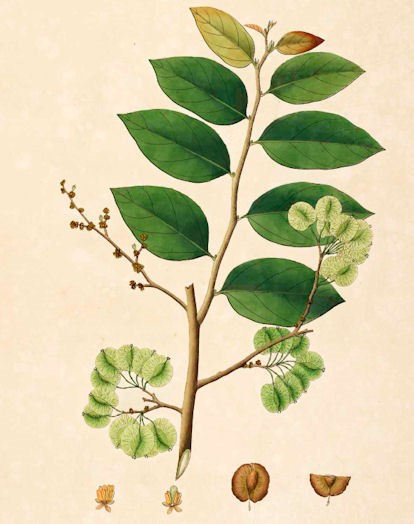
Abb.: षड्ग्रन्थः । Holoptelea
integrifolia (Roxb.) Planch.
[Bildquelle: Roxburgh. -- Vol. I. -- 1795. -- Image courtesy Missouri
Botanical Garden. http://www.botanicus.org.
-- Creative Commons
Lizenz (Namensnennung, keine kommerzielle Nutzung)]
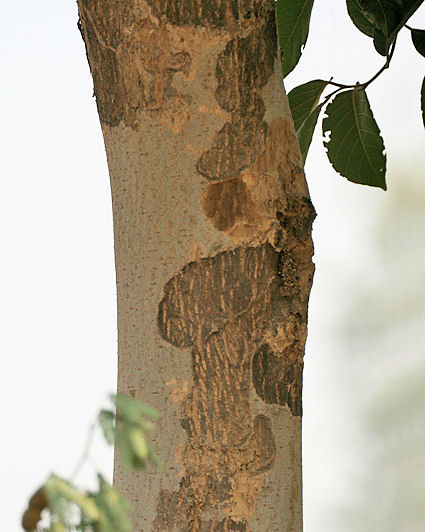
Abb.: षड्ग्रन्थः । Holoptelea
integrifolia (Roxb.) Planch., Hodal - होडाल, Haryana
[Bildquelle: J. M. Garg / Wikimedia.
-- GNU FDLicense]
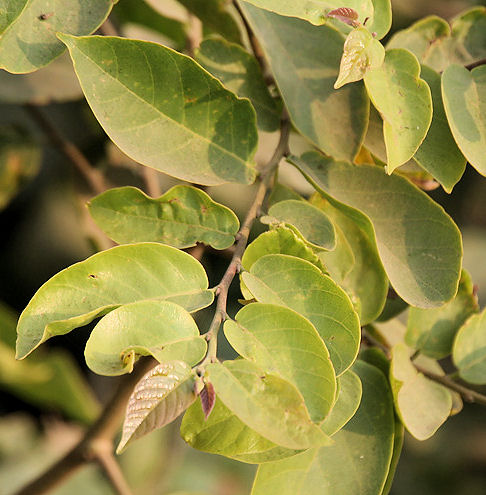
Abb.: षड्ग्रन्थः । Holoptelea
integrifolia (Roxb.) Planch., Hodal - होडाल, Haryana
[Bildquelle: J. M. Garg / Wikimedia.
-- GNU FDLicense]
"Ulmus integrifolia. Willd. 1. 1326. Corom. pl. 1. N. 78. [...]
A large timber tree, a native of the Circar mountains. It flowers during the cold season. Leaves deciduous about the close of the wet season ; they come out again in March.
[...]
Observation. The first part of the flowers that appears, is the anthers ; they are then reddish ; next the calyx increases, and becomes visible to the naked eye, but is at all times small, and unless looked for, is seldom observed.
The wood of this tree is reckoned of a good quality by the natives, and is employed for a variety of uses."
[Quelle: Roxburgh, William <1751-1815>: Flora indica, or, Descriptions of Indian plants / by the late William Roxburgh. -- Serampore : Printed for W. Thacker, 1832. -- Vol. 2, S. 68f.]
"Ulmus integrifolia (Roxb.) N. O. Ulmaceae. Indian Elm.
Description.--Large tree; [...]
Fl. Nov.-March.
Roxb. Fl. Ind. ii. 68.--Cor. i. t. 78.--Wight Icon. t. 1968.
Circar mountains. Foot of the Himalaya. Ghauts near Arcot.
Economic Uses.—The timber is of good quality, and employed for various purposes, as carts and door-frames. The forks of the branches are used by the natives to protect their straw against cattle. —Roxb. J. Grah."
[Quelle: Drury, Heber <1819 - 1872>: The useful plants of India : with notices of their chief value in commerce, medicine, and the arts. -- 2d ed. with additions and corrections. London : Allen, 1873. -- xvi, 512 p. ; 22 cm. -- s.v.]
"Holoptelea integrifolia, Planch., [...] a tree extending from the Lower Himalayas to Travancore, has a mucilaginous bark, which is boiled and the juice squeezed out and applied to rheumatic swellings; the exhausted bark is then powdered and applied over the parts covered by the sticky juice." [Quelle: Pharmacographia indica : a history of the principal drugs of vegetable origin met with in British India / by William Dymock [1834-1892], C. J. H. Warden and David Hooper [1858-1947]. -- Bd. 3. -- London, 1893. -- S. 318]
Bignoniaceae (Trompetenbaumgewächse)
Strauch oder kleiner Baum.
| 29. c./d. rohī rohitakaḥ plīhaśatrur dāḍimapuṣpakaḥ रोही रोहितकः प्लीहशत्रुर् दाडिमपुष्पकः ॥२९ ख॥ [Bezeichnungen für Tecomella undulata Seem.:]
|
Colebrooke (1807): "Rohin. A medical plant so called."
Synonyma: Bignonia undulata Roxb.; Tecoma undulata (Roxb.) G. Don.
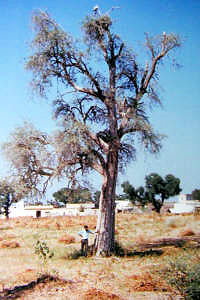
Abb.: रोही । Tecomella undulata Seem., Harsawa - हरसावा, Rajasthan
[Bildquelle: LRBurdak / Wikipedia. -- GNU FDLicense]
"Tecomella undulata ist eine Pflanzenart aus der Familie der Trompetenbaumgewächse (Bignoniaceae). Sie ist die einzige Art der Gattung Tecomella. Das Verbreitungsgebiet der Art reicht von der Arabischen Halbinsel bis ins westliche Indien. Beschreibung
Tecomella undulata ist ein Strauch oder kleiner Baum, dessen Sprossachse unterschiedlich behaart sein kann. Die Laubblätter stehen gegenständig oder oftmals in Wirteln, sind einfach und lanzettlich geformt.
Die Blütenstände sind aus wenigen Blüten bestehende Thyrsen, die endständig an kurzen Zweigen stehen. Der Blütenkelch ist glockenförmig und mit fünf Zähnen besetzt. Die Krone ist orange gefärbt, röhrig bis glockenförmig und mit einem breiten Schlund versehen. Die vier Staubblätter ragen über die Krone hinaus. Die Staubbeutel sind unbehaart, ihre Theken stehen auseinander. Neben den Staubblättern wird ein Staminodium gebildet. Der Fruchtknoten ist langgestreckt-lanzettlich, feinschuppig besetzt und besitzt eine Vielzahl an Samenanlagen. Der Fruchtknoten steht auf einem becherförmigen Blütenboden.
Die Früchte sind linealische, lederige Kapseln, an denen der Kelch nicht beständig ist. Sie sind leicht vierrippig, besitzen flache Klappen. Die Samen sind elliptisch und mit einem Flügel versehen, der nur am Rand häutig ist.
VerbreitungDie Art kommt von der Arabischen Halbinsel bis ins westliche Indien vor.
LiteraturE. Fischer, I. Theisen und L.G. Lohmann: Bignoniaceae. In: Klaus Kubitzki, Joachim W. Kadereit (Hrsg.): Flowering Plants, Dicotyledons: Lamiales (except Acanthaceae Including Avicenniaceae), Springer Verlag, 2004. ISBN 978-3-540-40593-1. S. 22."
[Quelle: http://de.wikipedia.org/wiki/Tecomella_undulata. -- Zugriff am 2010-11-03]
Mimosaceae (Mimosengewächse)
Bis 15 m hoher, laubabwerfender, dorniger Baum.
| 30. a./b. gāyatrī bālatanayaḥ khadiro dantadhāvanaḥ गायत्री बालतनयः खदिरो दन्तधावनः ।३० क। [Bezeichnungen für Acacia catechu (L. f.) Willd. - Cachou-Akazie - Black Catechu:]
|
Colebrooke (1807): "Khayar. Mimosa catechu (Khayar) L. [= Acacia catechu (L. f.) Willd.]"
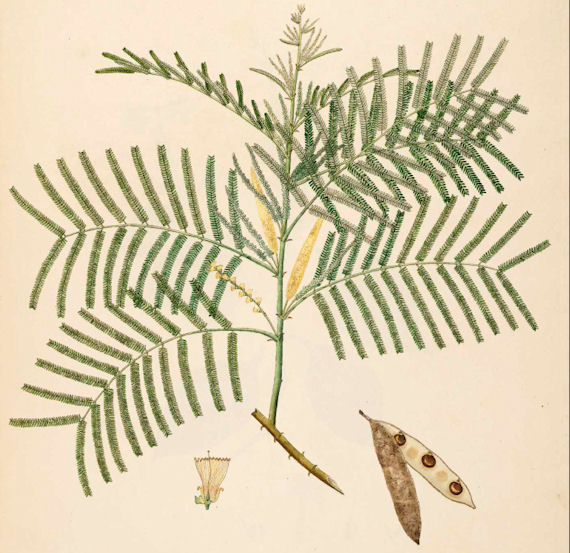
Abb.: गायत्री । Acacia catechu (L. f.) Willd. - Cachou-Akazie - Black Catechu
[Bildquelle: Roxburgh. -- Vol I. -- 1795. -- Image courtesy Missouri Botanical
Garden. http://www.botanicus.org. --
Creative Commons Lizenz
(Namensnennung, keine kommerzielle Nutzung) (Roxb. = Mimosa catechu)]
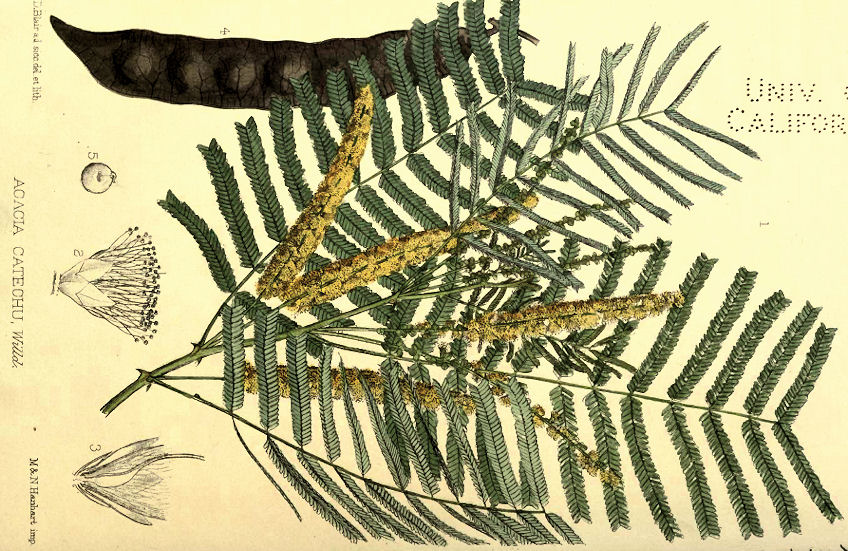
Abb.: खदिरः । Acacia catechu (L. f.) Willd. - Cachou-Akazie - Black Catechu
[Bildquelle: Medicinal plants. Being
descriptions with original figures of the principal plants employed in medicine
and an account of the characters, properties, and uses of their parts and
products of medicinal value. / by Robert Bentley and Henry Trimen. Plates by
David Blair. In four volumes., 1880. -- vol. 1, pl. 95]
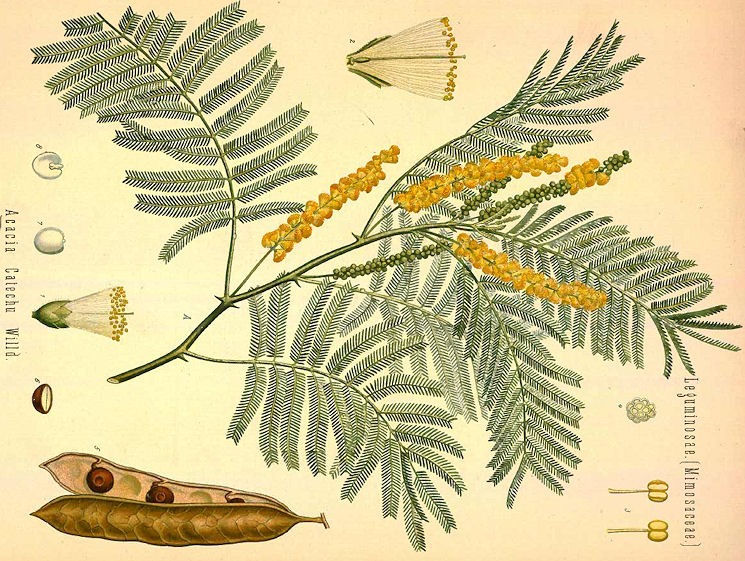
Abb.: खदिरः । Acacia catechu (L. f.) Willd. - Cachou-Akazie - Black Catechu
[Bildquelle: Köhler, 1883-1914]
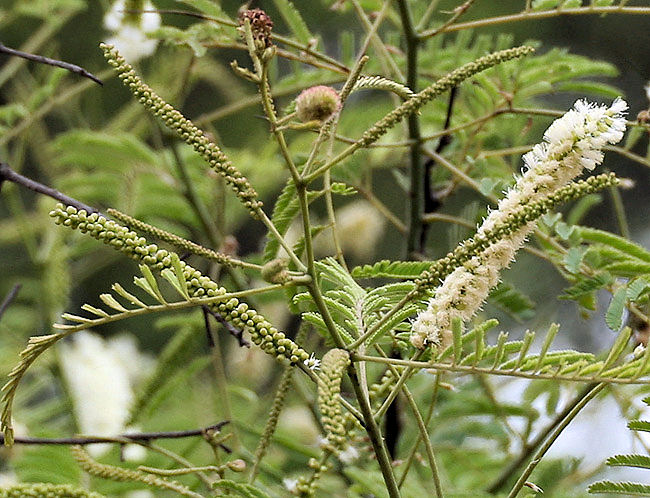
Abb.: दन्तधावनः । Acacia catechu (L. f.) Willd. - Cachou-Akazie - Black Catechu,
Hyderabad -
హైదరాబాద్ -
حیدرآباد, Andhra Pradesh
[Bildquelle: J. M. Garg / Wikipedia.
-- GNU FDLicense]
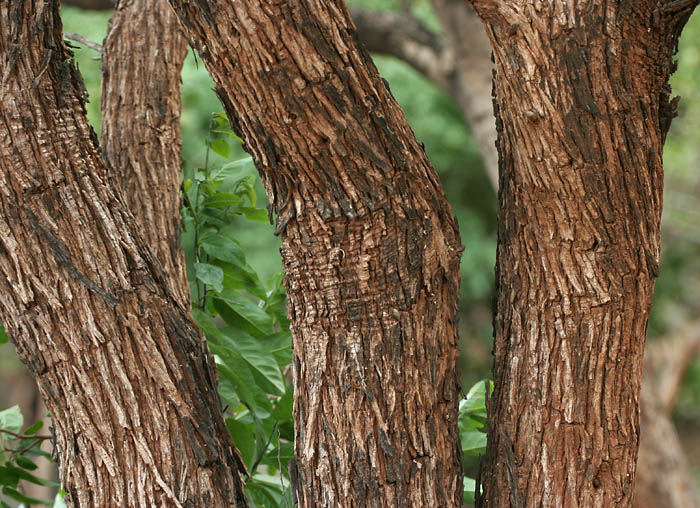
Abb.: बालतनयः । Acacia catechu (L. f.) Willd. - Cachou-Akazie - Black Catechu,
Hyderabad -
హైదరాబాద్ -
حیدرآباد, Andhra Pradesh
[Bildquelle: J. M. Garg / Wikipedia.
-- GNU FDLicense]
"Mimosa Catechu. Medical observ. v. 5. p. 151. t. 4.
Beng. Khira.
Khadira in Sanscrit and Kudhir the name of the extracts.
The last five species are nearly allied to each other, and require no small degree of attention to point out their differences in a short definition. Probably they are equally fit for yielding the extract now called Catechu. Flowering time the hot and rainy seasons. The seed ripens after the rains."
[Quelle: Roxburgh, William <1751-1815>: Flora indica, or, Descriptions of Indian plants / by the late William Roxburgh. -- Serampore : Printed for W. Thacker, 1832. -- Vol. 2, S. 563f.]
"Acacia Catechu (Willd.). Description.--Tree, 30-40 feet; [...]
Fl. June-Oct.
W. & A. Prod. i. 272.
A. Wallichiana, Dec.
Mimosa catechu, Linn. Supl.--Roxb. Fl. Ind. ii. 562.-- Cor. t. 175.
Malabar. Various parts of the Peninsula. Bengal. Delhi.
Medical Uses.—The substance formerly known as Terra Japonica is yielded by this tree. It is now better understood as one of the kinds of Catechu prepared in India—the word being derived from cate, a tree, and chu, juice. It is extracted from the unripe pods and old high-coloured wood, and the mode of preparation in some of the northern parts of India is minutely described by Dr Royle. The chips of the inner wood are put into an earthen pot over the fire; they are then boiled, and the clean liquor is strained off; when of sufficient consistence it is poured into clay moulds. This is usually of a pale-red colour, and in quadrangular pieces. 'Catechu has been successfully used in cases of intermittent fever in conjunction with infusion of Chiretta, in doses from ten to twelve grains. Dr A. Ross found it very useful in scurvy, both locally applied to the gums, as well as on the constitution. Finely-powdered Catechu has also been successfully used in ointments, mixed with other ingredients, in the treatment of obstinate ulcers and leprous affections.—Ainslie. Pharm. of India.
Economic Uses.—Catechu is used in Berar in the process of dyeing chintz and other cloths. It is occasionally mixed with plaster to increase its adhesion, and is also, in conjunction with certain oils, applied to beams, to preserve them against the white ants. The most celebrated Catechu is that obtained from Pegu, and this brings «£4 or £5 a^ton more than other astringent extracts. Catechu contains a greater proportion of tannin than other astringent substances, and it has been found that 1 lb. of this is equal to 7 or 8 lb. of oak- bark for tanning purposes. The manufactured article is brought down in considerable quantities from Berar and Nepaul, and thence to Calcutta, from whence it is exported to Europe. Other kinds of Catechu are prepared in India, the commonest of which is that from the nut of the Areca palm (F. Areca Catechu). As a timber, the wood of the tree is less hard and durable than that of other species of Acacia. It is of a red colour, heavy, close-grained, and brittle. It polishes well, and resists the attacks of white ants. It is used for agricultural purposes, sugar-mills, and pestles.—Roxb. Powel's Punj. Prod."
[Quelle: Drury, Heber <1819 - 1872>: The useful plants of India : with notices of their chief value in commerce, medicine, and the arts. -- 2d ed. with additions and corrections. London : Allen, 1873. -- xvi, 512 p. ; 22 cm. -- s.v.]
"ACACIA CATECHU, Willd. Catechu tree (Eng.)
[...]
History, Uses, &c.--Sanskrit writers under the name of Khadira mention two kinds of catechu, dark and pale, both prepared from the wood of the Acacia catechu, and these two kinds are still to be found in common use. The dark acacia catechu is in flat cakes of a dark brown colour and shining fracture, or in square cakes known as box catechu. The light catechu is a porous earthy-looking substance, somewhat lamineted and much more friable than the dark: it is used for chewing with betel leaves and areca nut, while the use of the dark kind is confined to industrial purposes. Dark catechu is made by evaporating a decoction of the wood until it becomes solid; in making the light kind the inspissation is stopped at a certain point, and the catechu is obtained as a deposit upon twigs which are placed in the liquid extract. The Hindus consider catechu to be astringent, cooling, and digestive, useful in relaxed conditions of the throat, mouth and gums, also in cough and diarrhoea. Externally they use it as an astringent and cooling application to ulcers, boils, and eruptions on the skin. A number of compound formulae for its administration will be found in Chakradatta, Sarangadhara, and the Baissajya Ratnāvali. Mahometan writers describe dark and light catechu, and their use in medicine for the purposes already mentioned. An account of the introduction of catechu into Europe will be found in the Pharmacographia. Other kinds of the drug which are imported into India by sea will be found described in the article upon Gambier. The gum of A. catechu has been noticed in the article upon Substitutes for gum arabic. In the Concans the juice of the fresh bark is given with Asafoetida in haemoptysis, and the flowering tops with cummin, milk and sugar in gonorrhoea.
[...]
Khersal or Khairsar. -From the wood of Acacia Catechu is obtained a substance which we have not seen any notice of in works on India Materia Medica. Khersal, or natural catechu, is obtained from cavities in the wood, and occurs in small irregular fragments like little bits of very pale catechu mixed with chips of reddish wood. This drug is collected by men who split firewood, and fetches a high price, as it is only occasionally met with; it has a sweetish astringent taste, and under the microscope is seen to be composed of minute needle-shaped crystals. When placed in water the colouring matter of the particles of wood mixed with the drug colour the water red, but the khersal remains undissolved; in boiling water it is completely soluble, but is thrown down in conglomerate masses of small needle-shaped crystals upon the water cooling; it is also soluble in rectified spirit, and is deposited in the same form on the spirit evaporating. In native practice this substance is valued as a remedy in relaxed conditions of the throat.
A similar substance has been brought to our notice by the Conservator of Forests for Malabar. It is a yellow crystalline deposit found in the wood of the Poon spar (Callophyllum tomentosum).
Kathbol. -Is a mixture of catechu and myrrh, which is frequently given to women after confinement as a tonic, and to promote the secretion of milk."
[Quelle: Pharmacographia indica : a history of the principal drugs of vegetable origin met with in British India / by William Dymock [1834-1892], C. J. H. Warden and David Hooper [1858-1947]. -- Bd. 1. -- London, 1890. -- S. 557ff.]
Mimosaceae (Mimosengewächse)
Bis 3 m hoher Strauch.
| 30. c./d. arimedo viṭkhadire kadaraḥ khadire site अरिमेदो विट्खदिरे कदरः खदिरे सिते ॥३० ख॥ Den विट्खदिर - viṭ-khadira m.: Vaiśya-Khadira (Acacia farnesiana (L.) Willd. 1806 - Antillen Akazie / Süße Akazie - Scented Wattle) nennt man अरिमेद - arimeda m.: Feindsfett |
Colebrooke (1807): "A fetid Mimosa."
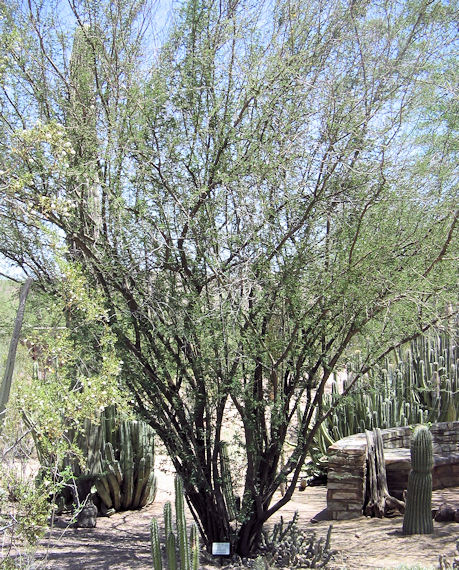
Abb.: विट्खदिरः । Acacia farnesiana (L.) Willd.
1806 - Antillen Akazie - Scented Wattle, Arizona USA
[Bildquelle: Don A.W. Carlson / Wikimedia. -- GNU FDLicense]
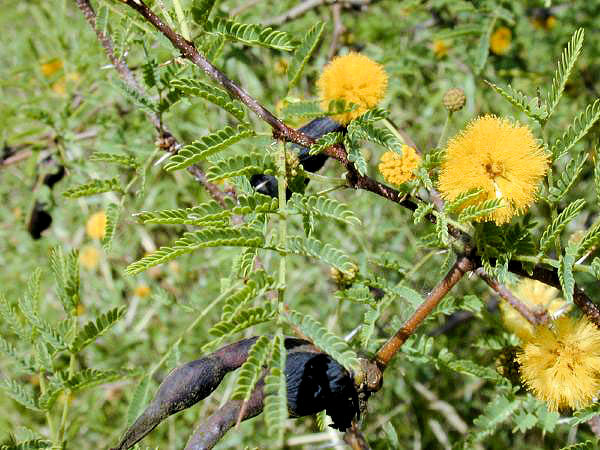
Abb.: विट्खदिरः । Acacia farnesiana (L.) Willd.
1806 - Antillen Akazie - Scented Wattle
[Bildquelle: USGS / Wikipedia. -- Public domain]
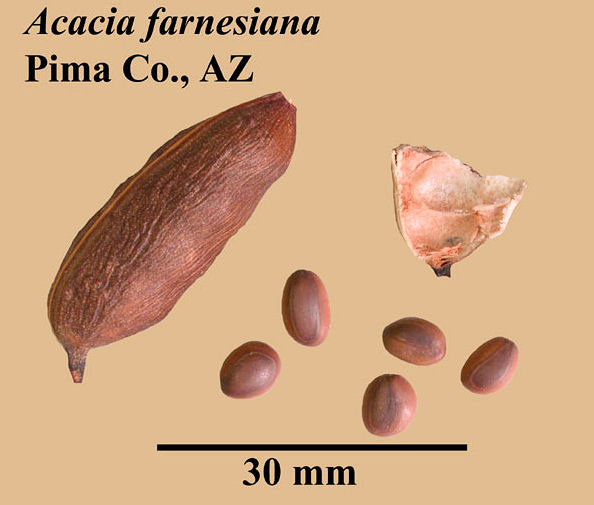
Abb.: अरिमेदः । Acacia farnesiana (L.) Willd.
1806 - Antillen Akazie - Scented Wattle
[Bildquelle: USGS / Wikipedia. -- Public domain]
"Mimosa Farnesiana. Linn. Syst. Veg. ed. 4. p. 916.
[...]
Acacia farnesiana. Willd. 4. p. 1083.
Sans. Arimeda. Vitkhira.
[...]
Sami. Asiat. Res. 4. p. 307, is this plant, though the specimens of the Sami tree sent to me by Capt. Wilford, belong to my Adenanihera aculeala. See Prosopis aculeata. Asiat. Res. 4. p. 405.
A native of every part of India. It flowers in the cold season."
[Quelle: Roxburgh, William <1751-1815>: Flora indica, or, Descriptions of Indian plants / by the late William Roxburgh. -- Serampore : Printed for W. Thacker, 1832. -- Vol. 2, S. 557.]
"Acacia Farnesiana(Willd.) Description.--Shrub or small tree, armed with stipulary thorns; [...]
Fl. Dec-Jan.
W. & A. Prod. i. 272 (under Vachellia)
Mimosa Farnesiana, Linn.--Roxb. Fl. Ind. ii. 557.
Bengal. Assam. Peninsula.
Economic Uses.—This small tree exudes a considerable quantity of useful gum. The wood is very hard and tough, and is much used for ship-knees, tent-pegs, and similar purposes. The flowers distilled yield a delicious perfume.—W. & A. Roxb."
[Quelle: Drury, Heber <1819 - 1872>: The useful plants of India : with notices of their chief value in commerce, medicine, and the arts. -- 2d ed. with additions and corrections. London : Allen, 1873. -- xvi, 512 p. ; 22 cm. -- s.v.]
"Acacia Farnesiana yields gum freely in the form of spheroidal tears and stalactiform masses ranging in colour from pale yellow to dark-reddish brown. The gum collected in the neighbourhood of Bombay and at Poona in the Deccan is only slightly soluble. On stirring up with water it partially dissolves, but after remaining a short time undisturbed it gelatinizes. The strained mucilage is precipitated or gelatinized by neutral and basic acetate of lead, perchloride of iron, and silicate of soda, but not by borax. It slightly reduces Fehling's solution.
Under a high power of the microscope, the gum is seen to be thickly interwoven with the minute hyphse and fructifications of a fungus probably belonging to the Ascomycetes. The fungus is composed of a brown parenchyma confining oil globules, and bearing oval-shaped gonidia divided into two cells by a transverse septum. The gonidia are supported on hyaline stems (sterigmata) arising from the hyphae. Debris of cells containing monoclinic crystals and interwoven with fungi are occasionally met with."
[Quelle: Pharmacographia indica : a history of the principal drugs of vegetable origin met with in British India / by William Dymock [1834-1892], C. J. H. Warden and David Hooper [1858-1947]. -- Bd. 1. -- London, 1890. -- S. 550.]
Mimosaceae (Mimosengewächse)
Bis 25 m hoher Baum.
| 30. c./d. arimedo viṭkhadire kadaraḥ khadire site 31. a./b. somavalko 'py atha vyāghrapuccha-gandharvahastakau
अरिमेदो विट्खदिरे
कदरः खदिरे सिते ॥३० ख॥ Bezeichnungen für den weißen Khadira:
|
Colebrooke (1807): "A white sort."
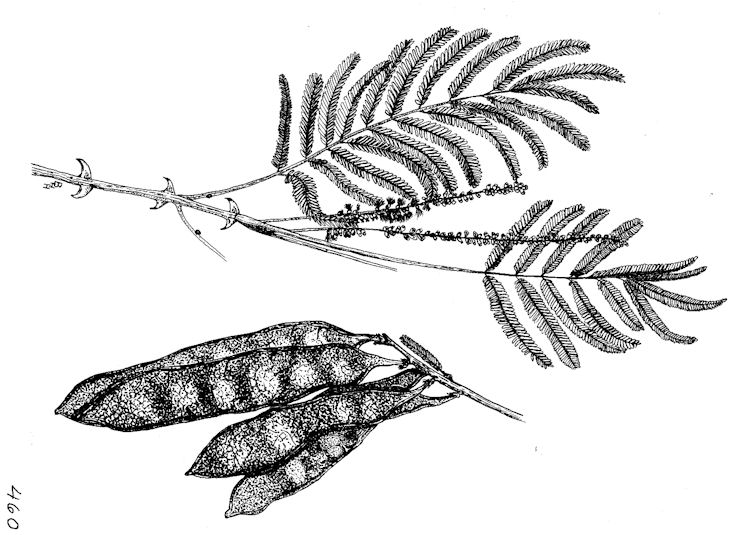
Abb.: कदरः । Acacia polyacantha Willd. 1806 - Vielstachlige
Akazie - Catechu Tree
[Bildquelle: USDA / Wikipedia. -- Public domain]
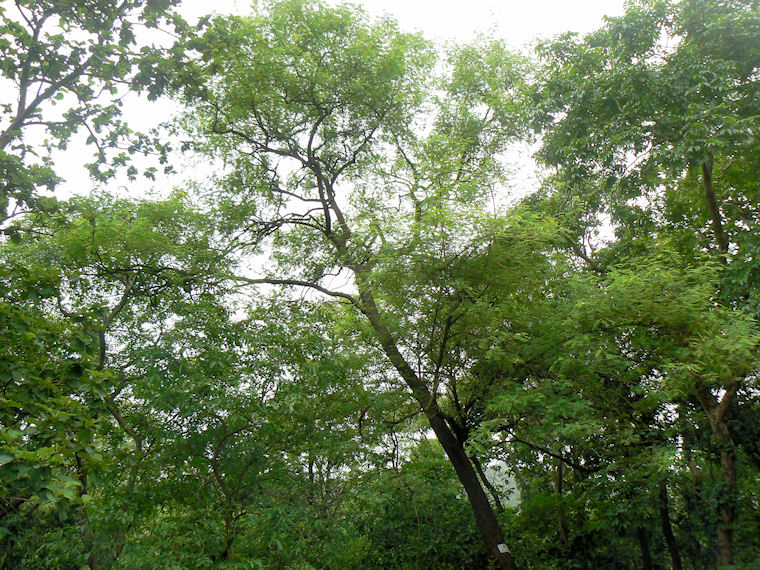
Abb.: कदरः । Acacia polyacantha Willd. 1806 - Vielstachlige
Akazie - Catechu Tree, Maharashtra
[Bildquelle: dinesh_valke. --
http://www.flickr.com/photos/dinesh_valke/1080411217/. -- Zugriff am
2010-10-24. --
Creative
Commons Lizenz (Namensnennung, keine kommerzielle Nutzung, keine
Bearbeitung)]
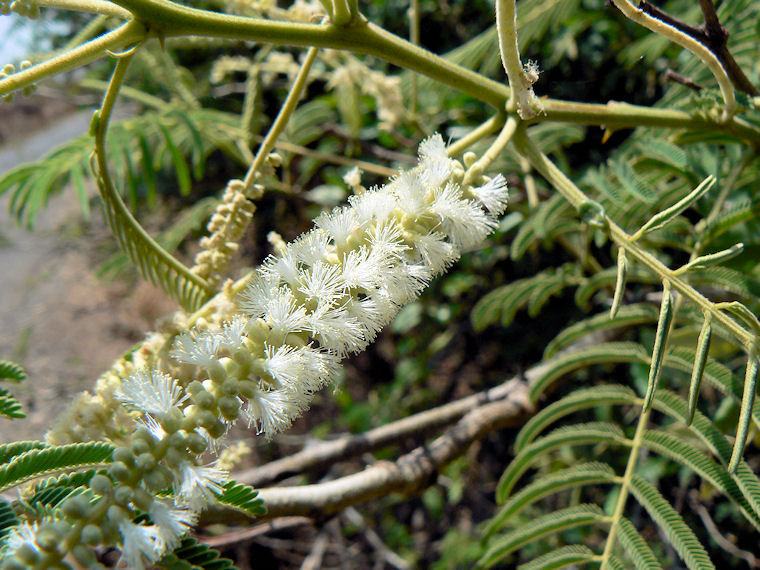
Abb.: कदरः । Acacia polyacantha Willd. 1806 - Vielstachlige
Akazie - Catechu Tree, Maharashtra
[Bildquelle: dinesh_valke. --
http://www.flickr.com/photos/dinesh_valke/517656743/. -- Zugriff am
2010-10-24. --
Creative
Commons Lizenz (Namensnennung, keine kommerzielle Nutzung, keine
Bearbeitung)]
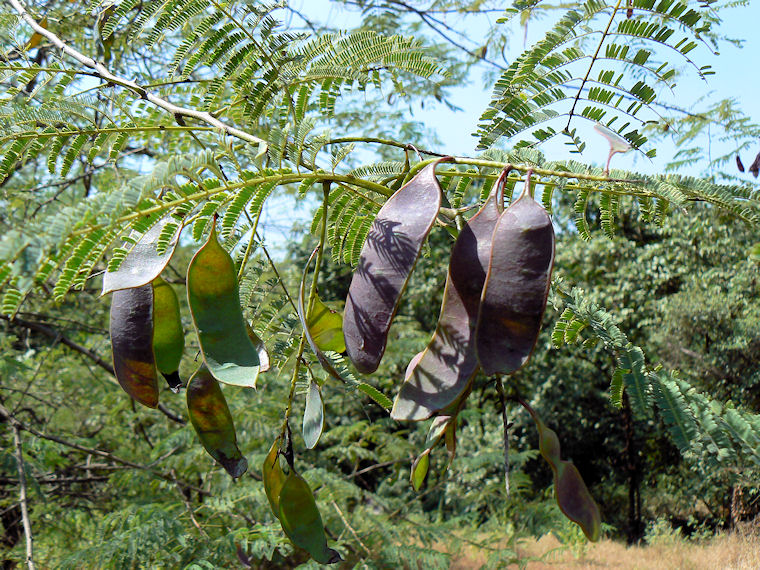
Abb.: कदरः । Acacia polyacantha Willd. 1806 - Vielstachlige
Akazie - Catechu Tree, Maharashtra
[Bildquelle: dinesh_valke. --
http://www.flickr.com/photos/dinesh_valke/1842336139/. -- Zugriff am
2010-10-24. --
Creative
Commons Lizenz (Namensnennung, keine kommerzielle Nutzung, keine
Bearbeitung)]
"Mimosa Suma. R. [...]
Acacia polycantha. Willd. 4. p. 1099.
Sans. Shumee.
[...]
A very common tree about Calcutta, and over Bengal, and is remarkably conspicuous on account of its white bark. Flowering time the rainy season. There is a large concave gland above the base of the petiole, and two or three between the last two or three pairs of pinnae."
[Quelle: Roxburgh, William <1751-1815>: Flora indica, or, Descriptions of Indian plants / by the late William Roxburgh. -- Serampore : Printed for W. Thacker, 1832. -- Vol. 2, S. 563.]
Euphorbiaceae (Wolfsmilchgewächse)
Mehrjähriges Kraut.
| 31. somavalko 'py atha vyāghrapuccha-gandharvahastakau eraṇḍa urubūkaś ca rucakaś citrakaś ca saḥ 32 a./b. cañcuḥ pañcāṅgulo maṇḍa-vardhamāna-vyaḍambakāḥ
सोमवल्क्यो
ऽप्य्
अथ व्याघ्रपुच्छ-गन्धर्वहस्तकौ । [Bezeichnungen für Ricinus communis L. 1753 - Palma Christi / Rizinus - Castor Oil Plant:]
|
Colebrooke (1807): "Palma christi. Ricinus communis."
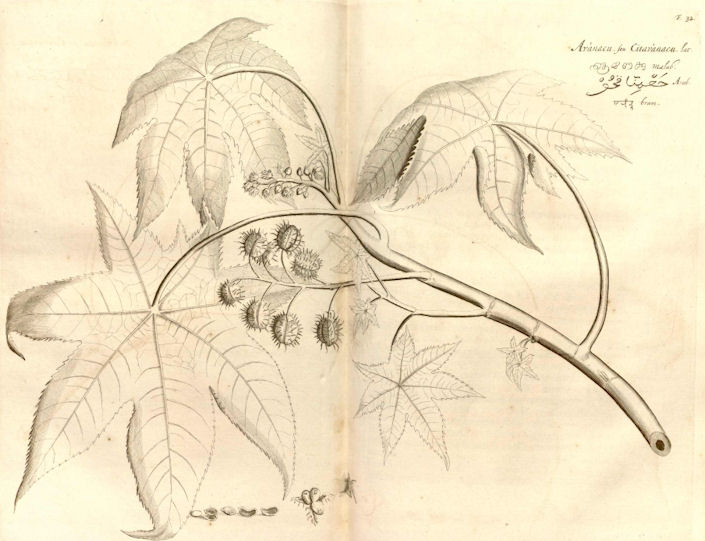
Abb.: वर्धमानः । Ricinus communis L. 1753 - Palma Christi /
Rizinus - Castor Oil Plant
[Bildquelle: Hortus malabaricus II. Fig. 32,
1679]
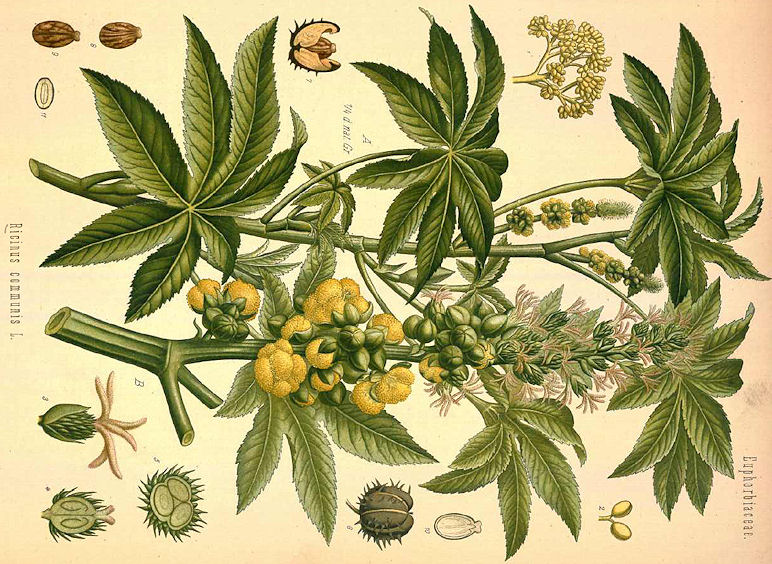
Abb.: वर्धमानः । Ricinus communis L. 1753 - Palma Christi /
Rizinus - Castor Oil Plant
[Bildquelle: Köhler, 1883-1914]
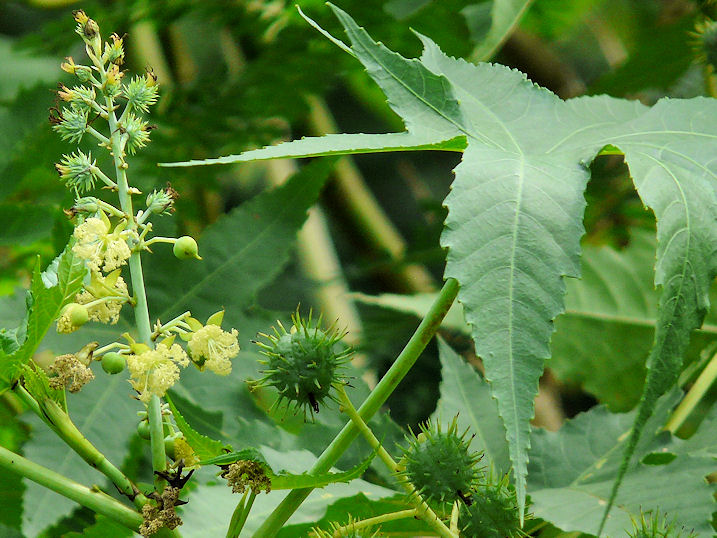
Abb.: चञ्चुः । Ricinus communis L. 1753 - Palma Christi /
Rizinus - Castor Oil Plant
[Bildquelle: dinesh_valke. --
http://www.flickr.com/photos/dinesh_valke/2878662691/. -- Zugriff am
2010-10-13. --
Creative
Commons Lizenz (Namensnennung, keine kommerzielle Nutzung, share alike)]
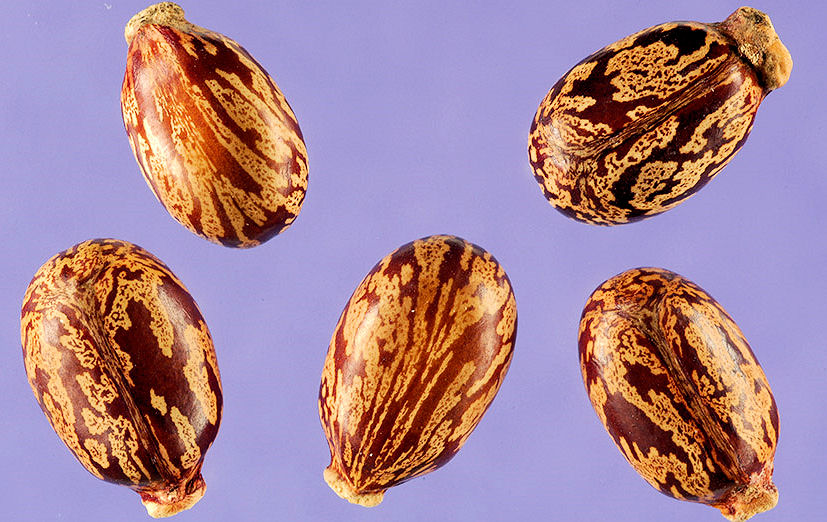
Abb.: चित्रकः । Ricinus communis L. 1753 - Palma Christi /
Rizinus - Castor Oil Plant
[Bildquelle: Steve Hurst / USDA. -- Namensnennung]
"Ricinus communis. Willd. iv. 564. [...]
Sans. Eranda.
[...]
Of this very useful plant, we have several varieties cultivated in India, some of them growing to the size of a pretty large tree, and of many years duration ; I have not seen any variety with smooth fruit.
On the leaves the domesticated Arrindy silk-worm (Phalacena Cynthia,) are fed. See Transactions of the Linnaean Society, vol. vii. p. 42."
[Quelle: Roxburgh, William <1751-1815>: Flora indica, or, Descriptions of Indian plants / by the late William Roxburgh. -- Serampore : Printed for W. Thacker, 1832. -- Vol. 3, S. 659f.]
"Ricinus communis (Linn.) N. O. Euphorbiaceae. Castor-oil plant.
Description.--Height 8-10 feet; root perennial; [...]
Fl. Nearly all the year.
Roxb. Fl. Ind. iii. 689.--Rheede ii. t. 32.
Cultivated.
Medical Uses.—There are two varieties of the Castor-oil plant which are known respectively as fructibus majoribus and minoribus. The oil of the former differs from the medicinal Castor-oil in having a heavy disagreeable smell, probably owing to the seeds being toasted previous to boiling, for the purpose of extracting the oil. The colour, too, is darker, and the nature is more gross. The real Castor- oil used in medicine is from the small-seeded variety. The lamp- oil of the former, like the Castor-oil, is of a purgative nature, but chiefly employed for lamps and in horse-medicine. The mode of preparation is given in the report on the fixed vegetable oils sent to the Madras Exhibition as follows : " The seeds having been partially roasted over a charcoal fire, both to coagulate the albumen and to liquefy the oil, are then pounded and boiled in water until the oil rises to the surface. The roasting process, however, gives it a deeper red colour and an empyreumatic odour. The price of this oil varies in different parts of the country from Ks. 1-10-0 to 3-13-6 per maund of 25 lb." Castor-oil was known in very early times to the Egyptians, and is mentioned in the second book of Herodotus. The plant is supposed to be indigenous to Barbary. In hot countries it is a perennial, in cold ones an annual or biennial plant. The skin of the seeds consists of three coverings, and it was for a long time believed even by Humboldt that the embryo of the seeds was the seat of the purgative principle alone, and that if that part were removed the seeds might safely be eaten. It has now, however, been proved, that although the active principle may exist in a greater quantity in the embryo, yet that it is found more or less throughout the entire seed. The use of the oil depends in a> great degree upon several circumstances, such as the mode of extraction, the maturity or otherwise of the seeds in the plant from whence they are procured, and so on. Other seeds, too, are frequently mixed with them. The application of heat was formerly resorted to in the extraction of the oil, and is still occasionally used, though quite unnecessary. The following is the process given by Ainslie for making a fine kind of Castor-oil for domestic purposes : u Take five seers of the small Castor-oil nuts and soak them for one night in cold water; next morning strain the water off and put the nuts into more water, and boil them in it for two hours, then strain off. The nuts are then to be dried in the sun for three days, after which to be well bruised in a mortar. Add to the nuts thus bruised ten measures of water, and put on to boil, stirring it all the time until all the oil appears at the top ; then carefully strained off and being allowed to cool, it will be fit for use. The quantity of nuts mentioned in the above recipe should yield one bottle of oil. If cocoa-nut water be used instead of common water, the oil has a paler and finer colour."
Another way of preparing the oil is given in the report of the Juries on the fixed vegetable oils sent to the Madras Exhibition. " The fresh seeds, after having been sifted and cleaned from dust, stones, and extraneous matters, are slightly crushed between two rollers, freed by hand from husks and coloured grains, and enclosed in clean gunny. They then receive a slight pressure in an oblong mould, which gives a uniform shape and density to the packets of seed. The ' Bricks,' as they are technically called, are then placed alternately with plates of sheet-iron in the ordinary screw or hydraulic press. The oil thus procured is received in clean tin pans, and water in the proportion of a pint to a gallon of oil being added, the whole is boiled until the water has evaporated: the mucilage will be found to have subsided and encrusted at the bottom of the pan, whilst the albumen, solidified by the heat, forms a white layer between the oil and the water. Great care must be taken on removing the pan from the fire the instant the whole of the water has evaporated, which may be known by the bubbles having ceased ; for if allowed to remain longer, the oil, which has hitherto been of the temperature of boiling water or 212°, suddenly rises to that of oil or nearly 600°, thereby heightening the colour and communicating an empyreumatic taste and odour. The oil is then filtered through blanket, flannel, or American drill, and put into cans for exportation. It is usually of a light straw colour, sometimes approaching to a greenish tinge. The cleaned seeds yield from 47 to 50 per cent of oil, worth in England from 4d. to 6d. per lb."
In France the fresh seeds are bruised and then put into a cold press. The oil thus expressed is allowed to stand some time to permit the albumen, mucilage, &c., to subside, or it is filtered to separate them more rapidly. The produce is equal to one-third of the seeds employed, and the oil possesses all its natural qualities. The oils made in France and Italy are much weaker than those procured from tropical countries. Another mode of obtaining the oil is to macerate the bruised seeds in cold alcohol, by which 6 oz. of oil are procured from every pound of the seeds. Castor-oil is soluble in pure sulphuric ether and alcohol. It also combines easily with alkaline leys, by which is formed a test of its purity. It is one of the best ways of overcoming the repulsive taste by mixing the oil with an alkaline ley, which alters the appearance of the oil, but does not destroy its purgative powers. Other ways of rendering the oil less unpleasant are by using lime-juice, orange-peel, coffee, gin, or an emulsion of the yolk of egg. Castor-oil is a mild laxative medicine, and among the Hindoos is used as a remedy in cutaneous affections externally applied. It is particularly recommended in rheumatism, lumbago, and habitual constipation, piles, and other diseases of the rectum. Alone or mixed with turpentine it is efficacious in expelling worms. Air should always be excluded to prevent rancidity, although when rancid it may be purified by calcined magnesia. The bark of the root is a powerful purgative, and when made into a ball about the size of a lime, in conjunction with chillies and tobacco-leaves, is an excellent remedy for gripes in horses. In Jamaica the oil is considered a valuable external remedy in cramps, pains arising from cold. The leaves heated and applied to the breasts, and kept on for 12 or 24 hours, will not fail to bring milk after child-birth. The same applied to the abdomen will promote the menstrual discharge. The seeds are used by the dyers to mix with colours and render them permanent. -The leaves are a favourite food of some silk-worms.—Ainslie. Simmonds. Lindley. Jury Rep. Mad. Exhib."
[Quelle: Drury, Heber <1819 - 1872>: The useful plants of India : with notices of their chief value in commerce, medicine, and the arts. -- 2d ed. with additions and corrections. London : Allen, 1873. -- xvi, 512 p. ; 22 cm. -- s.v.]
"RICINUS COMMUNIS, Linn.
Castor plant
[...]
History, Uses, &c.—The Castor plant is called in Sanskrit Eranda, Ruvu, Ruvuka and Uruvuka, and the red variety Raktairanda; the root and the oil obtained from the seeds have been used medicinally by the Hindus from a very remote period, and are mentioned by Susruta.
Both root and oil are described as purgative and useful in costiveness, flatulence, rheumatism, fever and inflammatory affections; on account of its efficacy in rheumatism the plan bears the synonym of Vatari (vata-ari). As a purgative the oil is directed to be taken with cow's urine or an infusion of ginger or the decoction of the ten roots known as dasamula (see Vol. I., p. 243). The seeds freed from the husks and germs, and boiled in milk and water, form a decoction which is given in rheumatism; a decoction of the root with carbonate of potash is also prescribed, and most compound medicines given in rheumatic and neuralgic affections contain the root. The leaves are applied to the breast to stop the secretion of milk, and, boiled with the root in goat's milk and water, they are used as a local application in ophthalmia. When applied to the abdomen they are popularly thought to promote the menstrual flow; in Govardhana (203), the halikavadhu, or "peasant woman," is represented as lying in pain upon the leaves of the Eranda.
In the proverbial language of the Indians the Castor plant is emblematic of frailty; they say:—Naukri arand ki jar hai (service is like the root of the Castor plant). The Arabs appear to have first become acquainted with the tree in India, as they call the seeds Simsim-el-hindi, "Indian Sesamum," and the plant Khirvaa, a word which signifies any weak or frail plant; the properties they attribute to it are also those mentioned by Sanskrit writers. Again, in the Saptasataka of Hala, we find the large and swelling breasts of the peasant girl likened to the Eranda leaf, and in Arabic we have the expression
applied to a beautiful and tender girl.
R. communis is the Bidanjir and Kinnatu of the Persians ; it also bears various local names, such as Gerchak in the Shahpur District, and Buzanjir, "goat's fig," in Khorasan.
Aitchison notices its cultivation round the borders of fields in the latter province, and in the Harirud District, for the sake of the oil which is used as a lamp oil, and says that the peasantry are unacquainted with its purgative properties. The plant was cultivated in Southern Europe at a very early date; it is the κικι of Herodotus, the κροτων of Theophrastus (H.P.i.,16; C.P. ii.), and the κικι or κροτων of Dioscorides (iv., 158), who observes that the name κροτωον is given to the seed on account of its resemblance to an insect known by that name (Ixodes Ricinus, Latr.). He also notices Castor oil and its medicinal use. It is the Ricinus or Cicus of Pliny (15, 7), "a tree which grows in Egypt in great abundance ; by some it is known as croton, by others as sili, and by others, again, as wild sesamum: it is not so very long since this tree was first introduced here. Eaten with food the oil is repulsive, but it is very useful for burning in lamps."
The Jews and Abyssinian Christians say that it was under this tree that Jonah sat, but in the English version the Hebrew word " Kikajon " is translated "gourd." For a history of the plant in Europe, the Pharmacographia may be consulted.
Mahometan medical writers describe two kinds, red and white: the red is said to be the most active. They consider the oil a powerful resolvent and purgative of cold humors, and prescribe it in palsy, asthma, colds, colic, flatulence, rheumatism, dropsy and amenorrhea ; of the seeds, 10 kernels rubbed down with honey are sufficient as a purge. A poultice of the crushed seeds is used to reduce gouty and rheumatic swellings, and inflammation of the breasts of women during lactation. The leaves have similar properties, but in a less degree. The fresh juice is used as an emetic in poisoning by opium ' and other narcotics; made into a poultice with barley meal it is applied to inflammatory affections of the eye. The root-bark is used as a purgative and alterative in chronic enlargements and skin diseases; it is also applied externally.
In modern medicine Castor oil is much valued as a non-irritant purgative ; a drop is sometimes dropped into the eye to allay irritation, and, strange to say, the leaves are applied locally in Europe to promote the secretion of milk, whereas in India the native practice of applying them to stop the secretion of milk is recognised in the Government hospitals under European superintendence. A fluid extract of the leaves has also been recommended in Europe as a lactagogue. As a purgative the oil is best administered in the £ early morning on an empty stomach, when about one drachm will usually be found sufficient, at other times at least half an ounce will be required. Various fluids have been recommended to conceal the taste of the oil, such as brandy, peppermint water, &c., but the decoction of fresh ginger, as used in India, is, we think, the best vehicle. The above remarks apply to cold drawn oil; the bazar oil extracted by boiling is more active, and, as it is not always carefully prepared, it may contain the acrid principle of the seed and give rise to disagreeable symptoms* The alleged antirheumatic properties of the plant so insisted upon by Hindu and Mahometan physicians are worthy of being tested by careful clinical observation."
[Quelle: Pharmacographia indica : a history of the principal drugs of vegetable origin met with in British India / by William Dymock [1834-1892], C. J. H. Warden and David Hooper [1858-1947]. -- Bd. 3. -- London, 1893. -- S. 301ff.]
"Ricinus. Ricinus, Trag. Matth. Fuch.
Ricinus vulgaris, C.B.J.B. Pit. Tournef.
Ricinus, sive Cataputia major vulgaris, Park.
Rikaion Prophetæ Jonæ, Alkaroa & Kerva Arabibus, Mira sole Italis, Guilland. epist.
Ricinus major, Eyst.
Ricinus, sive Palma Christi, vel Kiki, Ger.
Ricinus, Kerva Tripoli, Ranwolff.
Granum regium majus, Mesuæo.
Palma Christi, Cæs.
frantzösisch, Ricine.
teutsch, Creutzbaum, Wunderbaum, türckischer oder römischer Hanff, Zackenkörner.
Ist ein Gewächse, daß die Gestalt eines kleinen Baumes hat, und der Stengel erhebet sich auf sechs bis sieben Schuh, ist dick und holtzig, inwendig hol wie Rohr, oben ästig, von Farbe dunckelroth, mit einem weissen Staub, als wie mit Mehle überstreuet. Die Blätter sind zu Anfang rund, wann sie aber grösser werden, so werden sie eckigt und wie das Feigenlaub zertheilet, sind jedoch breiter und gantz linde anzufühlen. Die Blüten bestehen aus einem Hauffen bleicher Zäserlein, die nicht gar lange dauren, und weder Frucht noch Körner nach sich lassen. Die Früchte wachsen auf eben demselben Stamme, allein besonders, stehen als wie stachlichte und rauhe Träublein dran. Jedwede Frucht bestehet aus drey Capsuln oder Hülsen, in deren jeder ein ovalrunder oder länglichter Samen lieget, der ziemlich dicke ist, blaulicht und gefleckt auswendig sieht, mit weissen, zarten Marck erfüllet. Wann die Frucht recht zeitig ist, so kriegt sie Risse, daraus springen die Samen mit Gewalt. Die Wurtzel ist lang und dick, hart und weiß, voll Zaserwurtzeln. Dieses Gewächse wird in den Gärten gezogen, zum Theil wegen seiner Anmuth, und zum Theil, weil es die Maulwürffe soll vertreiben. Nachdem es an einem Orte steht, wird es auch hoch und starck: wie man dann in Spanien solche Ricinos zu sehen bekommt, die so dicke sind als wie ein Mann. Und in Candien werden sie so hoch, als grosse Bäume, daß man sie muß mit Leitern besteigen. Die Körner oder Samen werden zur Artzney gebrauchet: sie führen viel Oel und Saltz.
Sie purgieren alle Feuchtigkeiten aus dem Leibe mit heftiger Gewalt. Auf einmahl wird ein bis sechs Stück dererselbigen gebrauchet.
Aus den Körnern des Ricini, nachdem sie wol zerstossen worden, wird ein Oel gepresset und auf lateinisch Oleum de Kerva, Oleum cicinum, Oleum Ficus infernalis genennet.
Es purgiret, wann man auch nur damit den Magen und den Unterleib bestreichet: es tödtet die Würmer, vertreibt die Krätze, reiniget die Wunden, und stillet die Muttererstickung.
Aus America werden uns Ricinuskörner überbracht, die heissen auf lateinisch Grana Tiglia, frantzösisch, Graines de Tilli, auch Pignons d'Inde, weil sie den Pinien an Grösse und Gestalt gleich kommen; sie sind ein wenig dicker als die Zackenkörner. Sie wachsen in einer Hülse, die wie die am gemeinen Ricinus aussiehet, jedoch nicht stachlicht ist. Sie ist so dick als eine Nuß, dreyeckigt, röthlicht, auch bisweilen schwärtzlicht. Diese Hülse ist die Frucht von einem Ricinus, der wie ein Baum groß ist, und sich in Indien antreffen lässet. Sein Holtz ist zarte und gantz brüchig, die Blätter vergleichen sich, was die Gestalt betrifft, dem Feigenlaube, sind grüne und gar weich, stehen ohne Ordnung. Das Holtz und das Laub geben einen weissen Saft, wie Milch. Die Blüten bestehen aus vielen Zäserlein, und sehen sehr schön, wie Corallen. Es giebet allerhand Arten dieser indianischen Pinien.
Man soll diejenigen erwehlen, welche frisch und gantz sind, schwer, von Farbe grau oder gelblicht, von unangenehmen, sehr scharffen Geschmack: sie führen viel Oel und Saltz. Sie purgieren heftiglich von unten, und auch zuweilen von oben. Sie werden zur Wassersucht gebraucht, zum Schlage und zur Schlafsucht. Es wird die Helffte von einem Stück, auch wol zwey gantze auf einmahl gegeben.
Ricinus soll darum so genennet seyn, weil man will zwischen seiner Frucht und dem Gewürme gleiches Namens, das die Hunde und das Rindvieh pflegt zu plagen, will gefunden haben.
Palma Christi heisset es, weil seine Blätter einiger massen wie eine offne Hand aussehen sollen."
[Quelle: Lemery, Nicholas: Vollständiges Materialien-Lexicon. Zu erst in Frantzösischer Sprache entworffen, nunmehro aber nach der dritten, um ein grosses vermehreten Edition [...] ins Hochteutsche übersetzt / Von Christoph Friedrich Richtern, [...]. Leipzig: Johann Friedrich Braun, 1721. -- DVD-Ausgabe: Berlin : Directmedia Publ., 2007. -- s. v.]
Dorniger Baum.
| 32. c./d. alpā śamī śamīraḥ syāc chamī saktuphalā śivā अल्पा शमी शमीरः स्याच् छमी सक्तुफला शिवा ॥३२ ख॥ Die kleine Śamī heißt शमीर - śamīra m.: Śamīra. [Bezeichnungen für Prosopis cineraria (L.) Druce 1914 - Schraubenbohne - Mesquite:]
|
Colebrooke (1807): "A variety of the Sami." [32d:] "Sami or saen."
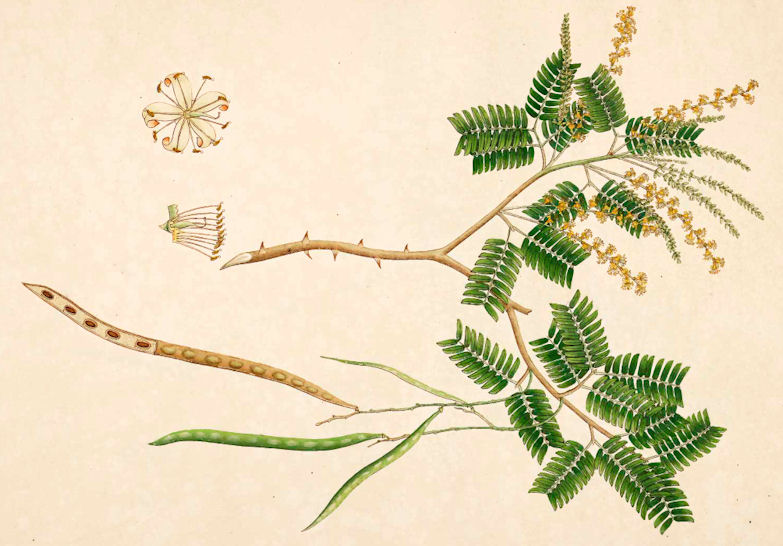
Abb.: शमी । Prosopis cineraria (L.) Druce 1914 -
Schraubenbohne - Mesquite (Roxburg: Prosopis spicigera)
[Bildquelle: Roxburgh. -- Vol I. -- 1795. -- Image courtesy Missouri Botanical
Garden. http://www.botanicus.org. --
Creative Commons Lizenz
(Namensnennung, keine kommerzielle Nutzung)]
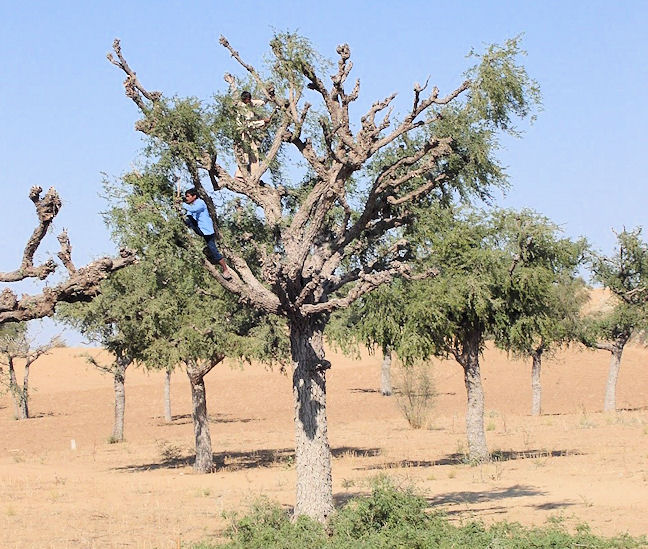
Abb.: शमी । Prosopis cineraria (L.) Druce 1914 -
Schraubenbohne - Mesquite
[Bildquelle. LRBurdak / Wikipedia. -- GNU FDLicense]
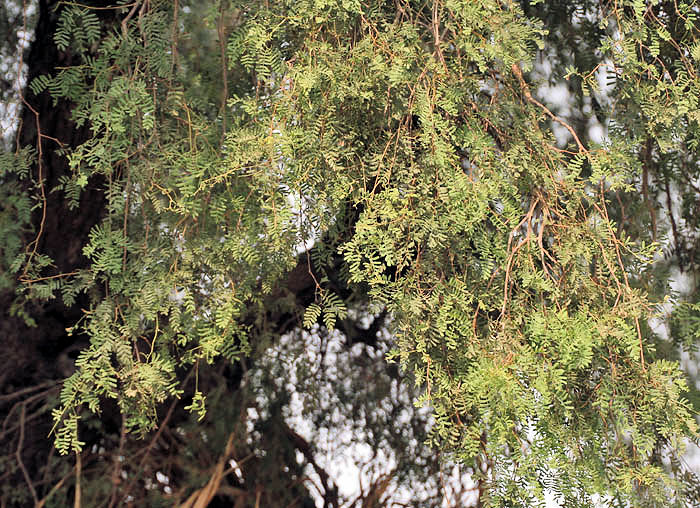
Abb.: शमी । Prosopis cineraria (L.) Druce 1914 -
Schraubenbohne - Mesquite, Hodal - होडाल,
Haryana
[Bildquelle: J. M. Garg / Wikipedia.
-- GNU FDLicense]
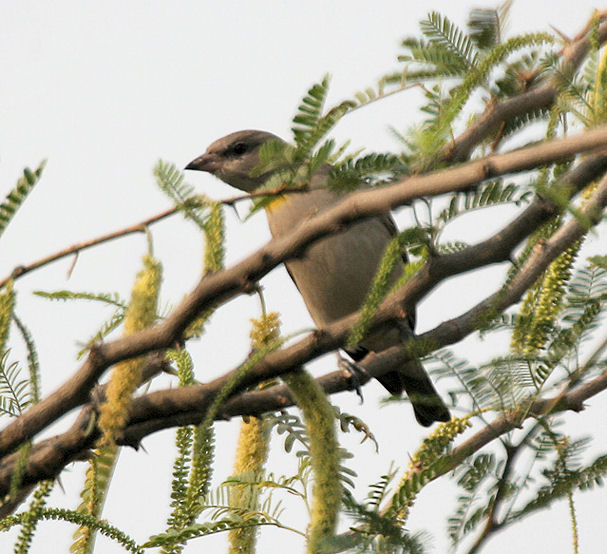
Abb.: सक्तुफला । Chestnut-shouldered Petronia (Petronia
xanthocollis) auf Prosopis cineraria (L.) Druce 1914 -
Schraubenbohne - Mesquite, Hodal - होडाल,
Haryana
[Bildquelle: J. M. Garg / Wikipedia.
-- GNU FDLicense]
"Adenanthera aculeata R [...]
Prosopis spicigera. Willd. 2. 547. R. Corom.pl. 1. N. 63. Somi, Wilford in Asiat. Res, 4, p. 3G3. Sir William Jones's Sami of the same vol. page 307, is very different ; viz. Mimosa farnesiana, a plant he never intended for Sami.
[...]
This grows to the size of a tree. It is a native of most parts of the coast of Coromandel, chiefly on low lands at a considerable distance from the sea ; it is also found in some parts of Hindoostan. It flowers during the cold and beginning of the hot seasons.
[...]
The pod of this tree is the only part used; it is about an inch in circumference, and from six to twelve long ; when ripe, brown and smooth, containing besides the seeds a large quantity of a brown mealy substance which the natives eat. Its taste is sweetish and agreeable ; it may therefore be compared to the Spanish Algaroba, or Locust tree (Ceratonia siliqua.)"
[Quelle: Roxburgh, William <1751-1815>: Flora indica, or, Descriptions of Indian plants / by the late William Roxburgh. -- Serampore : Printed for W. Thacker, 1832. -- Vol. 2, S. 371f.]
"Prosopis spicigera (Linn.) N. O. Leguminosae Description.--Somewhat arboreous, armed with scattered prickles, occasionally wanting; [...]
Fl. Dec.-Feb.
W. & A. Prod. i. 271.--Roxb. Cor. i. t. 63.
Adenanthera aculeata.--Roxb.
Coromandel. Guzerat. Delhi.
Economic Uses.—In Mysore this tree attains a large size. The timber is strong, hard, straight-grained, and easily worked. The pods contain a great quantity of mealy sweetish substance, which the natives eat.—(Roxb. Jury Rep. Mad. Exhib.) It is common throughout the Madras Presidency. The timber is dark red, close- grained, hard, and durable, superior to teak in strength, and is much used for building and other purposes. It is of very slow growth.— Bedd. Flor. Sylv. t. 56."
[Quelle: Drury, Heber <1819 - 1872>: The useful plants of India : with notices of their chief value in commerce, medicine, and the arts. -- 2d ed. with additions and corrections. London : Allen, 1873. -- xvi, 512 p. ; 22 cm. -- s.v.]
"Prosopis Spicigera.—The gum, which is unusually friable, occurs in small angular fragments of a yellowish colour, more or less deep, sometimes in large ovoid tears about two inches long, of an amber colour internally, but having a frosted or candied appearance externally from the presence of numerous minute cracks which cause the tears to crumble under pressure. With water it forms a rather dark coloured tasteless mucilage of about the same viscosity as gum arabic. The solution is precipitated by the normal acetate of lead and gelatinized by the basic acetate, also by ferric chloride, borax and alkaline silicates. It rather freely reduces Fehling's solution. This is a valuable gum, and appears to resemble, except in its behaviour to reagents, the Mezquite gum of Mexico and Texas, which is now coming into use in America." [Quelle: Pharmacographia indica : a history of the principal drugs of vegetable origin met with in British India / by William Dymock [1834-1892], C. J. H. Warden and David Hooper [1858-1947]. -- Bd. 1. -- London, 1890. -- S. 550.]
Dorniger Strauch oder kleiner Baum.
| 33. piṇḍītako marubakaḥ śvasanaḥ karahāṭakaḥ śalyaś ca madane śakrapādapaḥ pāribhadrakaḥ
पिण्डीतको मरुबकः श्वसनः करहाटकः । Bezeichnungen für मदन - madana m.: Berauscher, Catunaregam spinosa (Thunb.) Tirveng. - Emetic Nut:
|
Colebrooke (1807): "Mayan. Vangueria spinosa, R[oxb.]"
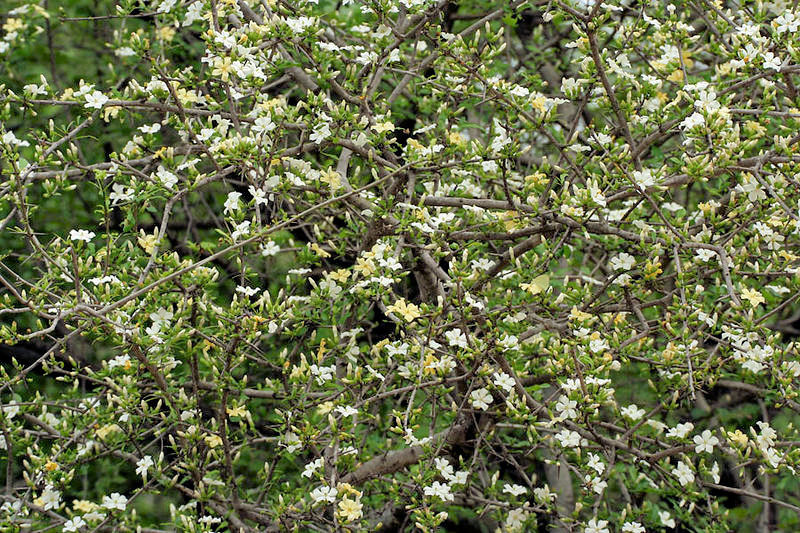
Abb.: मदनः । Catunaregam spinosa (Thunb.)
Tirveng. - Emetic nut, Hyderabad -
హైదరాబాద్ -
حیدرآباد, Andhra Pradesh
[Bildquelle: J. M. Garg / Wikipedia.
-- GNU FDLicense]
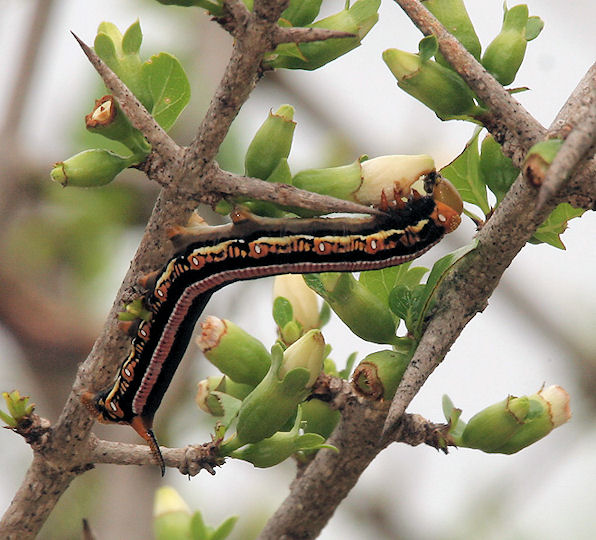
Abb.:
शल्यः । Raupe von Cephonodes hylas - Pellucid Hawk Moth auf Catunaregam spinosa (Thunb.)
Tirveng. - Emetic nut
[Bildquelle: J. M. Garg / Wikipedia.
-- GNU FDLicense]
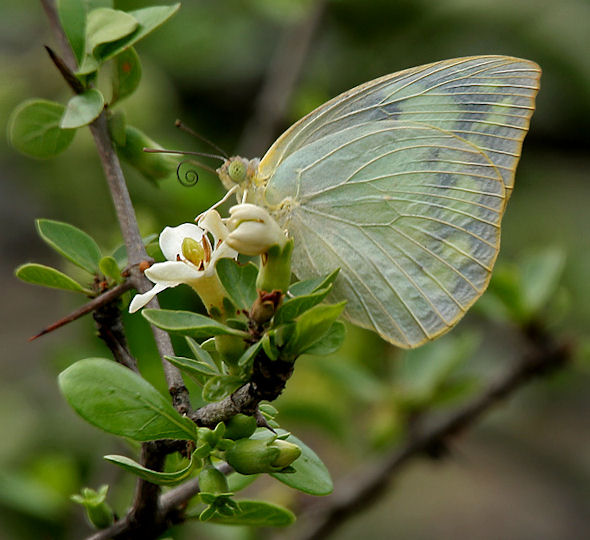
Abb.: मरुबकः । Common Emigrant - Catopsilia pomona
- auf Catunaregam spinosa (Thunb.)
Tirveng. - Emetic nut, Keesara - కీసర, Andhra Pradesh
[Bildquelle: J. M. Garg / Wikipedia.
-- GNU FDLicense]
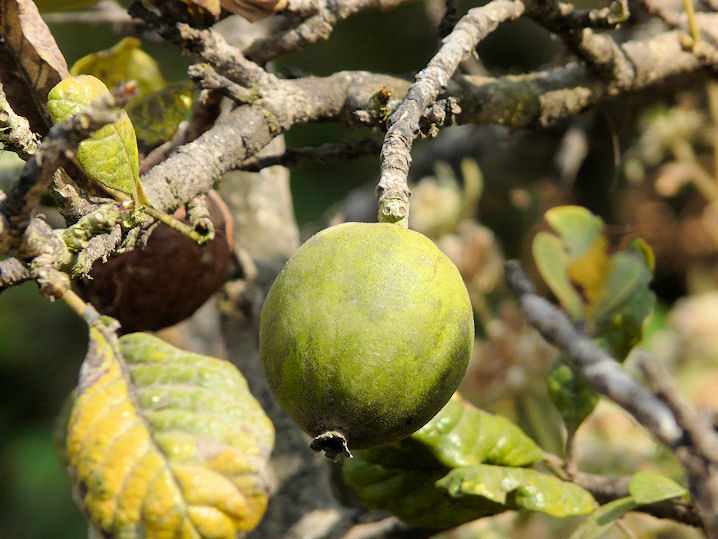
Abb.: पिण्डीतकः । Catunaregam spinosa (Thunb.)
Tirveng. - Emetic nut
[Bildquelle: dinesh_valke. --
http://www.flickr.com/photos/dinesh_valke/2273974391/. -- Zugriff am
2010-10-13. --
Creative
Commons Lizenz (Namensnennung, keine kommerzielle Nutzung, keine
Bearbeitung)]
"Vangueria spinosa. R.
Shrubby, armed with decussate spines.
Beng. Muyna.
A small tree or large bush ; a native of Bengal and also of China, I presume, as there are some plants in the Botanic garden brought thence. Flowering time the beginning of the hot season ; fruit ripe in three or four months afterwards.
[...]
Obs. The fruit is eaten by the natives. Its flowers come exceedingly near to those of my Canthium parviflorum, as does also the whole habit of the plant."
[Quelle: Roxburgh, William <1751-1815>: Flora indica, or, Descriptions of Indian plants / by the late William Roxburgh. -- Serampore : Printed for W. Thacker, 1832. -- Vol. 1, S. 536f.]
"Vangueria spinosa, Roxb., is the Pinda and Pinditaka of Sanskrit writers, who consider the fruit to be medicinal, and describe it as strengthening, cooling, and an expellant of phlegm and bile. It is a small tree or large bush, common in many parts of India, from Northern Bengal to Canara, which bears cymes of greenish flowers ; the fruit is a drupe, the size of a cherry, of a yellow colour when ripe, subglobose or turbinate, smooth and fleshy, pyrenes 4 to 5, woody, smooth." [Quelle: Pharmacographia indica : a history of the principal drugs of vegetable origin met with in British India / by William Dymock [1834-1892], C. J. H. Warden and David Hooper [1858-1947]. -- Bd. 2. -- London, 1891. -- S. 211.]
Pinaceae (Kieferngewächse)
Bis 35 m hoher Nadelbaum.
| 33. c./d. śalyaś ca madane śakrapādapaḥ pāribhadrakaḥ 34. bhadradāru drukilimaṃ pītadāru ca dāru ca pūtikāṣṭhaṃ ca sapta syur devadāruṇy atha dvayoḥ
शल्यश् च मदने
शक्रपादपः पारिभद्रकः ॥३३ ख॥ Sieben Bezeichnungen für देवदारु - devadāru n.: Götterholz, Cedrus deodara (Roxb.) G. Don 1830 - Himalaya-Zeder - Deodar:
|
Colebrooke (1807): "Deodar. In Bengal, Uvaria longifolia ; but properly seems to be a pine or fir."
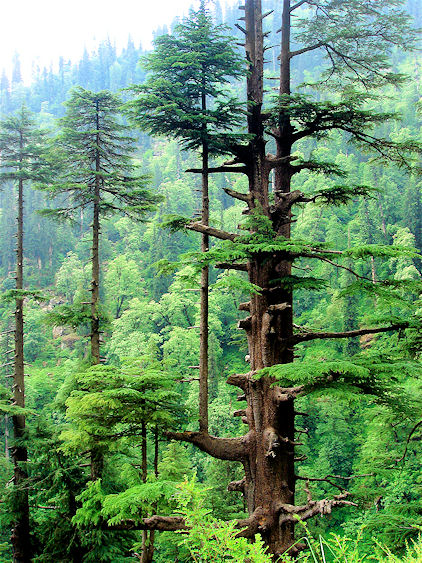
Abb.: शक्रपादपः । Cedrus deodara (Roxb.) G. Don 1830 - Himalaya-Zeder, Manali (मनाली) Sanctuary, Himachal Pradesh
[Bildquelle: ElPablo!. --
http://www.flickr.com/photos/98719591@N00/164693226/. -- Zugriff am
2010-10-11. --
Creative Commons Lizenz (Namensnennung)]
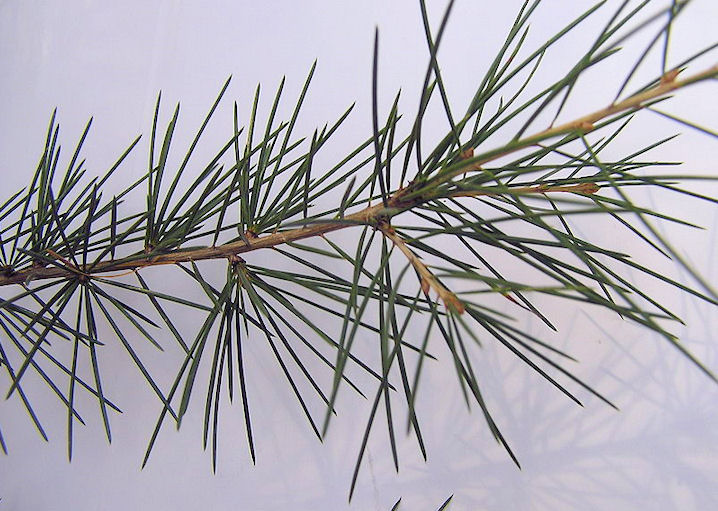
Abb.: पारिभद्रकः । Cedrus deodara (Roxb.) G. Don 1830 - Himalaya-Zeder
[Bildquelle: Alexander Dunkel / Wikimedia. --
Creative Commons
Lizenz (Namensnennung, share alike)]
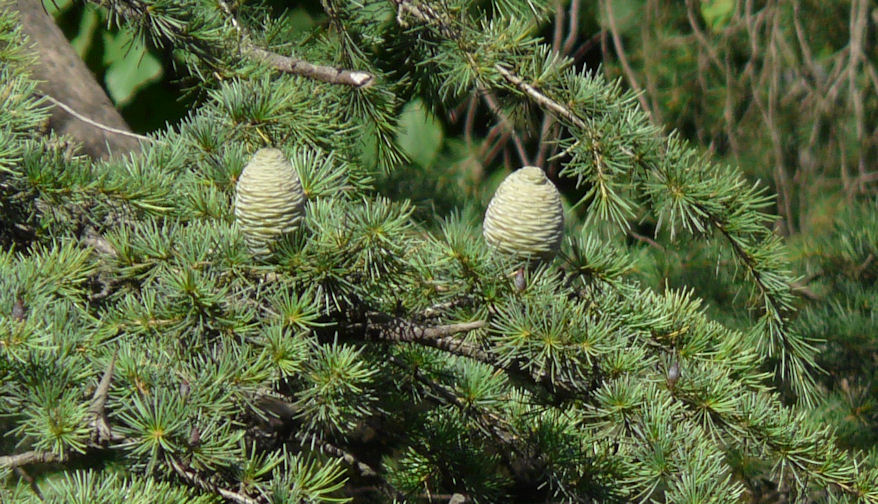
Abb.: देवदारु । Cedrus deodara (Roxb.) G. Don 1830 - Himalaya-Zeder,
Shimla -
शिमला,
Himachal Pradesh
[Bildquelle: dinesh_valke. --
http://www.flickr.com/photos/dinesh_valke/2558940004/. -- Zugriff am
2010-10-13. --
Creative
Commons Lizenz (Namensnennung, keine kommerzielle Nutzung, share alike)]
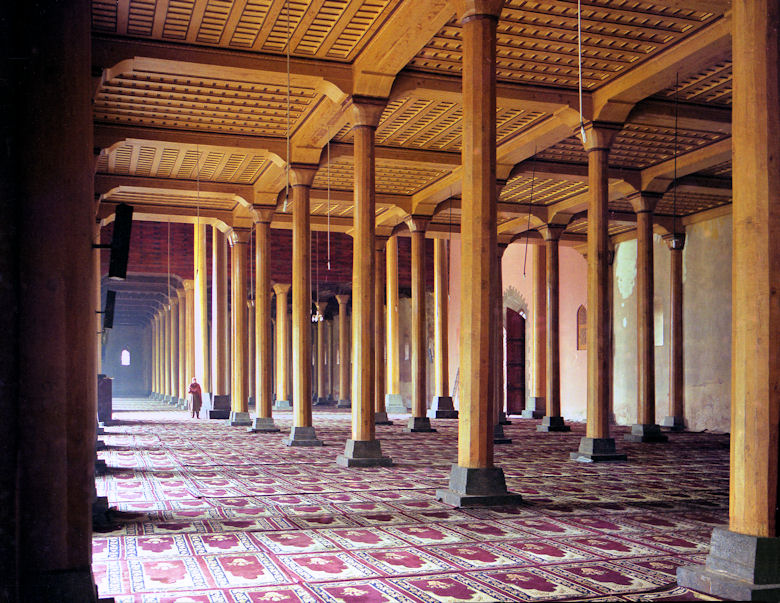
Abb.: पीतदारु । Pfeiler und Täfelung aus dem Holz von Cedrus deodara (Roxb.) G. Don 1830 - Himalaya-Zeder, Jamia Masjid جامعة
مسجد,
Srinagar - سری نگر, Kashmir, erbaut 1394 n. Chr.
[Bildquelle:
Lepley. --
http://www.flickr.com/photos/red_gloww/3106858868/. -- Zugriff am
2010-10-25. --
Creative
Commons Lizenz (Namensnennung, keine kommerzielle Nutzung, keine
Bearbeitung)]
"Pinus Devdara. R.
[...]
Devadaroo, or Devdar, is the name the tree is known by amongst the natives where it grows.
A tree of great size, a native of the mountains north of Rohilcund. It differs from P. Larix in many respects, but most conspicuously in being destitute of the bractes which project beyond the scales of the strobile or cone.
[...]
The tree is so exceedingly replete with resin, as to yield a very large proportion of tar. A manufactory of that article was lately begun, near the skirts of the Almora mountains by Mr. Gott.
Extract of a letter from that Gentleman, (Mr. Gott,) dated Kosupoor, 2nd November 1804, describing the Devdar pine.
" The only account I can give you of the Devdar pine, is from a variety of enquiries I have at times made of the natives. It grows a very considerable distance within the hills, none less than six days' journey, for a native. It does not appear to delight in a situation on the summit of mountains ; on the contrary it grows in valleys, and most abundantly in plains, on the side of large, or tops of small hills that are but little exposed. Its height is described to exceed twenty feet, and its bulk in proportion, from four to five feet in diameter; it grows very straight, and as regularly tapering as a fishing rod, with branches down to the ground."
[Quelle: Roxburgh, William <1751-1815>: Flora indica, or, Descriptions of Indian plants / by the late William Roxburgh. -- Serampore : Printed for W. Thacker, 1832. -- Vol. 3, S. 651f.]
"Pinus Deodara (Roxb.) N. O. Coniferae Deodar Pine.
Description.--Large tree; [...]
Roxb. Fl. Ind. iii. 651.--Dec. Prod. xvi. s. post, p. 408.
Cedrus deodara, Loudon (cum. fig.)
Abies deodara, Lindl.
Himalaya.
Medical Uses.—This species of pine yields a coarse fluid kind of turpentine (Kelon ka td9 Hind.), esteemed by the natives as an application to ulcers and skin diseases, as well as in the treatment of leprosy. Dr Gibson regards it as very effectual in this latter disease when given in large doses. It always acts as a diaphoretic, but is found very variable in its action,—in some cases a drachm causing vomiting; in others half an ounce inducing only slight nausea.—(Johnst. in Calc. Med. Phys. Trans., i. 41.) Dr Royle states that the leaves and twigs of the deodar are brought down to the plains, being much employed in native medicine.
Another species is the P. longifolia (Roxb.), which grows at elevations on the Himalaya from 2000 to 6000 feet. It is known by the native names Cheersullah, Sarul, and Thansa. The natives of Upper India obtain from it both tar and turpentine. The former is said to be equal to that obtained by a more refined process in Europe, and the turpentine is stated merely to require attention to render it equal to the imported article.—(Journ. As. Soc. Beng. ii. 249). Dr Cleghorn has furnished some valuable remarks on the manufacture of tar from this tree as well as from P. excelsa. He considers it fully equal to Swedish tar.—Agri. Hort. Soc. of India, 1865, xiv. p. i. App. p. 7.
Economic Uses.—The Deodar pine is highly valued for its timber, large quantities of which are annually felled for the railways and government purposes. Large forests of it exist on the Himalaya slopes, and especially in the Punjaub, along the banks of the Ravee, Beas, and other rivers. In the Chenab forests, too, they are plentiful. The P. excelsa, a tree in nowise inferior to the Deodar, grows in the same regions. The range within which the Deodar is found growing spontaneously extends from about 3000 to 9000 feet above the sea, though it rarely occurs so low as 3000 feet, and grows at a disadvantage at the highest elevation. Previous to the establishment of the Forest Conservancy, vast quantities of these valuable timber- trees were recklessly destroyed, and it has been found desirable to form plantations for fresh plants, which, in the Punjaub especially, have been carried out on a large scale. According to the Conservator's report (Feb. 1867) on the forests of the Chenab and Ravee divisions, there were only remaining of first-class deodars 17,500— viz., 12,000 in Chenab, and 5500 in the Ravee division. This diminution of the numbers formerly known to exist caused the Government to limit the number to be felled annually, and rules for this object are now strictly observed. Prices for good Deodar in the Punjaub, increasing in the case of logs under 20 feet in length, averaged from about eight annas in 1850 to one rupee per cubic foot in 1866. For the greater lengths, from 20 to 30 feet, which are very scarce, the rate of eleven annas has now risen at Lahore to Ks. 2, 8 ; at Attock the price is one rupee per cubic foot.—Govt. Reports, July 1866.
In Joonsar Bawur, situated between the native states under the Simla agency and the Rajah of Gurwhal's country, there are several line Deodar forests which were inspected by Dr Brandis in 1863, and reported upon by him. He found one beautiful forest of pure Deodar, which seemed to spring up with great vigour wherever it had a chance, and thousands upon thousands of young seedlings coming up as thick as corn in a field. In the Kotee forest the Deodar growth was perfectly extraordinary. Two of the old stumps, which were of huge size, though imperfect, showed that the trees in the twenty-one years of their life had attained a diameter of timber of 12 and 13 inches respectively. In another forest, in Lokan, there were counted in one spot, in about 4 acres, between 200 and 250 first-class trees of 6 feet girth, none of them under 100 feet in height, while many must have approached 200 feet The estimated contents of these nine forests of Joonsar Bawur were 34,000 first-class and 37,000 second-class Deodars. The above will - give some idea of the resources of these forests. These are exclusive of the P. excelsa (Cheel), which also abounds there, and the Cheer or P. longifolia. In Major Pearson's report upon the localities at the head of the Jumna river he states—"It would be difficult adequately to describe the enormous seas of Cheer forest which line its banks. The trees must be numbered by hundreds of thousands, many of them of a huge size. The same exists on the left bank of the Tonse, but higher up the river the Cheel (P. excelsa) takes the place of the Cheer, but the latter may be considered the chief tree. I believe, from inquiries, that if 15,000 or 20,000 logs can be got down to the river, there would be no difficulty in sawing up a lakh of sleepers per annum in these forests."—(Major Pearson's Report to Secy. to Govt., 5th Dec. 1869.) It may be interesting to mention here that the first conifer found in Southern India (Podocarpus) was discovered by Major Beddome in 1870 abundant on the Tinnevelly Hills."
[Quelle: Drury, Heber <1819 - 1872>: The useful plants of India : with notices of their chief value in commerce, medicine, and the arts. -- 2d ed. with additions and corrections. London : Allen, 1873. -- xvi, 512 p. ; 22 cm. -- s.v.]
"CEDRUS LIBANI, Barrel var. Deodars
[...]
History, Uses, &c.—This tree, in Sanskrit Devadaru, Suradaru, Suradruma "tree of the gods," yields the Bhadra kashtha "auspicious wood," Sneha-viddha "impregnated with oil," which is used as acarminative, diaphoretic, and diuretic by the Hindu physicians in fever, flatulence, inflammation, dropsy, urinary diseases, &c. It is chiefly used in combination with other medicines, as in the following diuretic mixture:—Take of Devadaru wood,, root of Moringa pterygosperma (Sigru), and Achyrantes aspera (Apamarga), one drachm each and reduce to a paste with cow's urine. To be given in ascites, (Chakradatta.) The wood is also ground to a paste with water and applied to the temples to relieve headache. A tar (Kilan-ka-tel) made by destructive distillation of the wood is a favourite remedy for skin diseases in Northern India; it is given internally in doses of about one drachm, and also applied locally. From the Sanskrit name Devadaru of this wood, it must not be confounded with the wood of Erythroxylon monogynum, known in Tamil as Devadarum, and which, on account of its odour, is called "Bastard Sandal." C. libani is the Deodar of Ibn Sina, who states that it is called Sanubar-el-hindi, and is useful in rheumatism, piles, palsy, epilepsy, gravel in the kidneys or bladder and prolapsus ani. Haji Zein-el-Attar states that its juice is used in Harrun (Afghanistan) to tan leather (he doubtless alludes to the tar which is used in the Punjab to dress the inflated skins used for crossing rivers).
Description.—The wood sold in the bazars is of a light yellowish-brawn colour, very heavy, and in thin sections translucent, owing to the large proportion of turpentine contained in it. It has an agreeable terebinthinate odour."
[Quelle: Pharmacographia indica : a history of the principal drugs of vegetable origin met with in British India / by William Dymock [1834-1892], C. J. H. Warden and David Hooper [1858-1947]. -- Bd. 3. -- London, 1893. -- S. 380f.]
Siehe:
Carakasaṃhitā: Ausgewählte Texte aus der Carakasaṃhitā / übersetzt und erläutert von Alois Payer <1944 - >. -- Anhang A: Pflanzenbeschreibungen. -- Cedrus deodara (Roxb.) G. Don. -- URL: http://www.payer.de/ayurveda/pflanzen/cedrus_deodara.htm
Bis 20 m hoher Baum.
| 34. c./d. pūtikāṣṭhaṃ ca sapta syur devadāruṇy atha dvayoḥ 35. pāṭaliḥ pāṭalāmoghā kācasthālī phaleruhā kṛṣṇavṛntā kuberākṣī śyāmā tu mahilāhvayā
पूतिकाष्ठं च सप्त स्युर् देवदा्रुण्य्
अथ द्वयोः ॥३४॥ [Bezeichnungen für Stereospermum colais (Buch. Ham. ex Dillon) Mabberley:]
|
Colebrooke (1807): "Trumpet flower. Bignonia suave-olens [=Stereospermum suaveolens DC.]."
1 कुबेराक्षी - kuberākṣī f.: Kuberas Auge
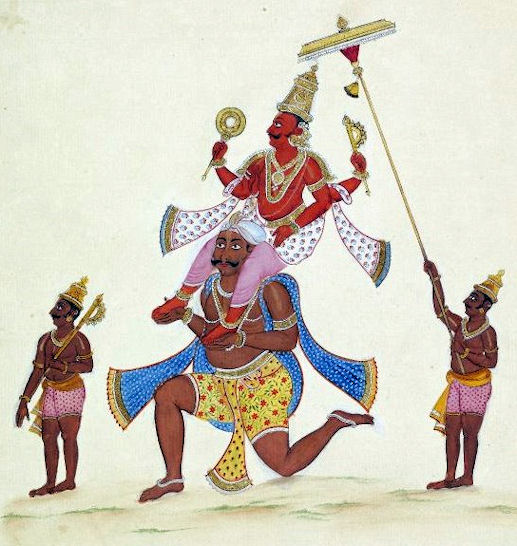
Abb.: Kubera, ca. 1820
[Bildquelle: Wikipedia. -- Public domain]
"KUVERA. In the Vedas, a chief of the evil beings or spirits living in the shades : a sort of Pluto, and called by his patronymic Vaiśravaṇa. Later he is Pluto in another sense, as god of wealth and chief of the Yakṣas and Guhyakas. He was son of Viśravas by Iḍāviḍā, but he is sometimes called son of Pulastya, who was father of Viśravas. This is explained by the Mahā-bhārata, according to which Kuvera was son of Pulastya, but that sage being offended with Kuvera for his adulation of Brahmā, "reproduced the half of himself in the form of Viśravas," and had Rāvaṇa and other children. (See Viśravas.) Kuvera's city is Alakā (also called Prabhā, Vasu-dharā, and Vasu-sthālī) in the Himālayas, and his garden Caitra-ratha on Mandara, one of the spurs of Mount Meru, where he is waited upon by the Kinnaras. Some authorities place his abode on Mount Kailāsa in a palace built by Viśva-karma. He was half-brother of Rāvaṇa, and, according to the Rāmāyaṇa and Mahā-bhārata, he once had possession of the city of Laṅkā in Ceylon, which was also built by Viśva-karma, and from which he was expelled by Rāvaṇa. The same authority states that he performed austerities for thousands of years, and obtained the boon from Brahmā that he should be immortal, one of the guardian deities of the world, and the god of wealth. So he is regent of the north, and the keeper of gold and silver, jewels and pearls, and all the treasures of the earth, besides nine particular Nidhis, or treasures, the nature of which is not well understood. Brahmā also gave him the great self-moving aerial car Puṣpaka (q.v.). His wife is Yakṣī, Cārvi, or Kauverā, daughter of the Dānava Mura. His sons are Maṇi-grīva or Varṇa-kavi and Nala-kubara or Māyu-raja, and his daughter Mīnākṣī (fish-eyed). He is represented as a white man deformed in body, and having three legs and only eight teeth. His body is covered with ornaments. He receives no worship. The name Ku-vera, as also the variant Ku-tanu, signifies vile body, referring to his ugliness. He is also called Dhana-pati, 'lord of wealth'; Icchā-vasu, 'who has wealth at will' ; Yakṣa-rāja, 'chief of the Yakṣas' ; Mayu-rāja, 'king of the Kinnaras' ; Rākṣasendra, 'chief of the Rākṣasas' ; Ratna-garbha, 'belly of jewels' ; Rāja-rāja, 'king of kings'; and Nara-rāja, 'king of men' (in allusion to the power of riches). From his parentage he is called Vaiśravaṇa, Paulastya, and Aiḍaviḍa or Aiḷaviḷa. As an especial friend of Śiva he is called Īśa-sakhi, &c."
[Quelle: Dowson, John <1820-1881>: A classical dictionary of Hindu mythology and religion, geography, history, and literature. -- London, Trübner, 1879. -- s.v. ]
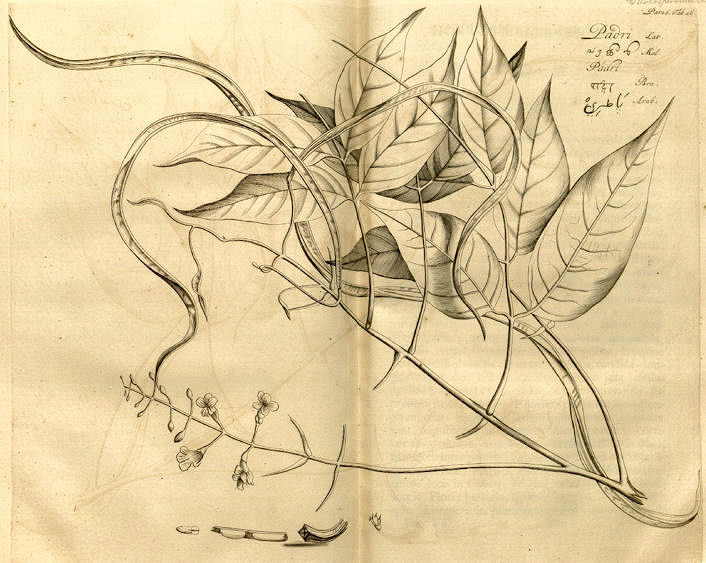
Abb.:
पाटला ।
Stereospermum colais (Buch. Ham. ex Dillon) Mabberley
[Bildquelle: Hortus malabaricus VI. Fig.
26,
1686]
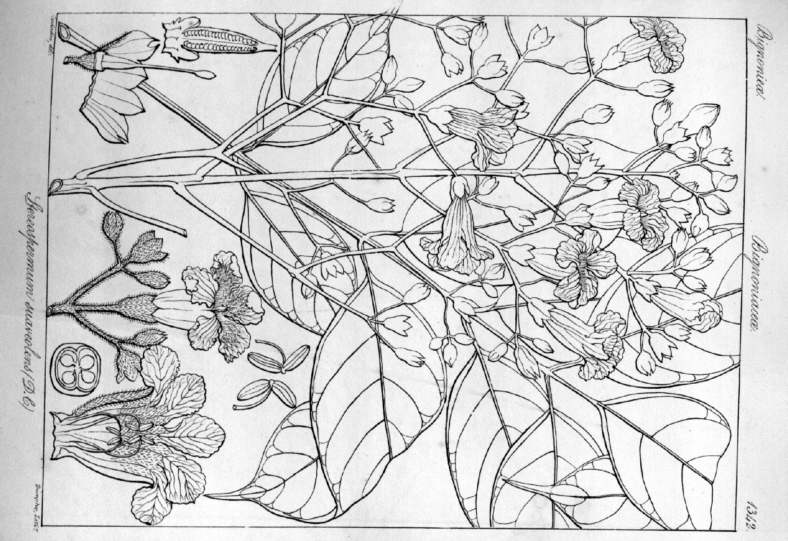
Abb.:
पाटला । Stereospermum colais (Buch. Ham. ex Dillon) Mabberley
[Bildquelle: Wight Icones IV, Tab. 195, 1850]
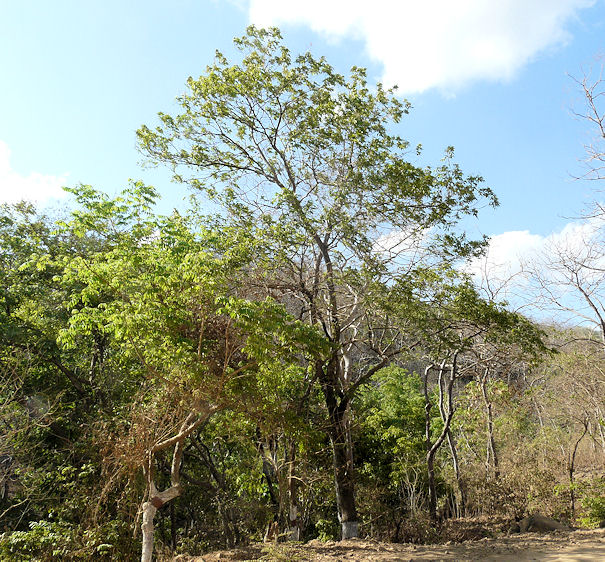
Abb.:
पाटला ।
Stereospermum colais (Buch. Ham. ex Dillon) Mabberley,
Maharashtra
[Bildquelle: dinesh_valke. --
http://www.flickr.com/photos/dinesh_valke/2499755244/. -- Zugriff am
2010-10-26. --
Creative
Commons Lizenz (Namensnennung, keine kommerzielle Nutzung, share alike)]
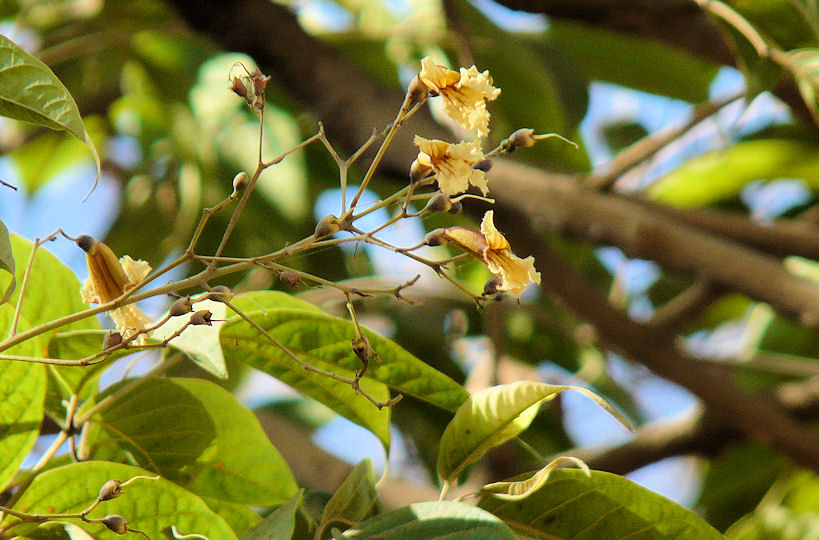
Abb.: पाटला ।
Stereospermum colais
(Buch. Ham. ex Dillon) Mabberley
[Bildquelle: dinesh_valke. --
http://www.flickr.com/photos/dinesh_valke/2499750454/. -- Zugriff am
2010-10-13. --
Creative
Commons Lizenz (Namensnennung, keine kommerzielle Nutzung, share alike)]
"Bignonia suaveolens. R.
[...]
Patali the Sanscrit name. See Asiatic Res. 291.
[...]
A middle sized tree, a native of Bengal, and of the southern parts of the Coromandel coast. Flowering time the hot season."
[Quelle: Roxburgh, William <1751-1815>: Flora indica, or, Descriptions of Indian plants / by the late William Roxburgh. -- Serampore : Printed for W. Thacker, 1832. -- Vol. 3, S. 104f.]
"The wood of the Stereospermum suaveolens (Roxb.) is strong and elastic, and is said to be good for making bows.--Jury Rep. Mad. Exhib." [Quelle: Drury, Heber <1819 - 1872>: The useful plants of India : with notices of their chief value in commerce, medicine, and the arts. -- 2d ed. with additions and corrections. London : Allen, 1873. -- xvi, 512 p. ; 22 cm. -- s.v. Stereospermum chelonides.]
"STEREOSPERMUM SUAVEOLENS, DC.
[...]
History, Uses, &c,—This tree is the Patala or Patali of Sanskrit writers, the flowers of which are said by the poets to so intoxicate the bee that he is unable to distinguish one flower from another. The tree is sacred to Durga, the wife of Siva. In the Nighantas it bears among other synonyms those of Kama-duti "Cupid's messenger," Madhu-duti "messenger of spring," Sthali, Ambu-vasini, and Tamra-pushpa "red flowered." Patala also signifies "light red" or " rose-coloured." It is described as cooling, sweet, diuretic, and tonic, and is recommended in dyspepsia, dropsy, cough, and heat of blood.
P. S. Mootoosawmy says that in Tanjore the flowers are taken in the form of a confection as an aphrodisiac. The flowers pounded with honey are said to stop troublesome hiccough, and the ashes of the bark are used in preparing alkaline ley and caustic pastes. The bark is in use throughout India from its being one of the ingredients in the Dasamula or "ten barks." (See Tribulus terrestris.) In parts of India where this tree is not found, various substitutes are allowed to be used. In Malabar and in the Concan S. chelonoides, DC., is used as Padri. (See Rheede, Hort. Mal. vi. t. 25 ; Ainslie, Mat. Ind. ii. p. 272.)"
[Quelle: Pharmacographia indica : a history of the principal drugs of vegetable origin met with in British India / by William Dymock [1834-1892], C. J. H. Warden and David Hooper [1858-1947]. -- Bd. 3. -- London, 1893. -- S. 20f.]
Siehe:
Carakasaṃhitā: Ausgewählte Texte aus der Carakasaṃhitā / übersetzt und erläutert von Alois Payer <1944 - >. -- Anhang A: Pflanzenbeschreibungen. -- Stereospermum suaveolens DC. -- URL: http://www.payer.de/ayurveda/pflanzen/stereospermum_suaveolens.htm
Verbenaceae (Eisenkrautgewächse)
Laubabwerfender, bis 2,5 m hoher Strauch.
| 35. c./d. kṛṣṇavṛntā kuberākṣī śyāmā tu mahilāhvayā 36. latā govandanī gundrā priyaṅguḥ phalinī phalī viṣvaksenā gandhaphalī kārambhā priyakaś ca sā
कृष्णवृन्ता कुबेराक्षी
श्यामा तु महिलाह्वया ॥३५ ख॥ [Bezeichnungen für Callicarpa macrophylla Vahl - Liebesperlenstrauch / Schönfrucht:]
|
Colebrooke (1807): "Priyangu. A fragrant seed so named."
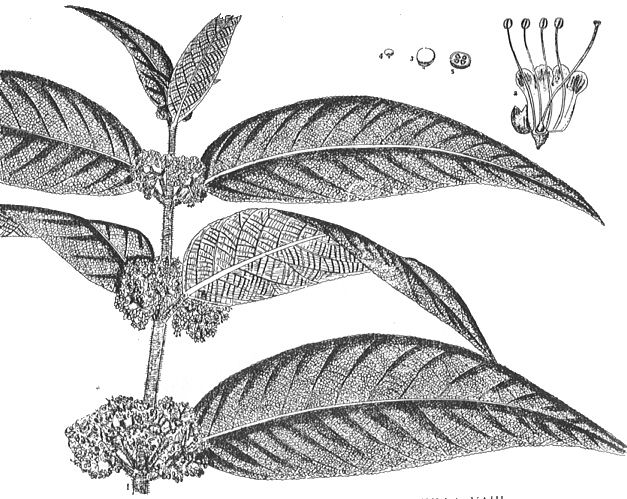
Abb.:
लत्ता । Callicarpa macrophylla Vahl -
Liebesperlenstrauch / Schönfrucht
[Bildquelle: Kirtikar-Basu, ©1918]
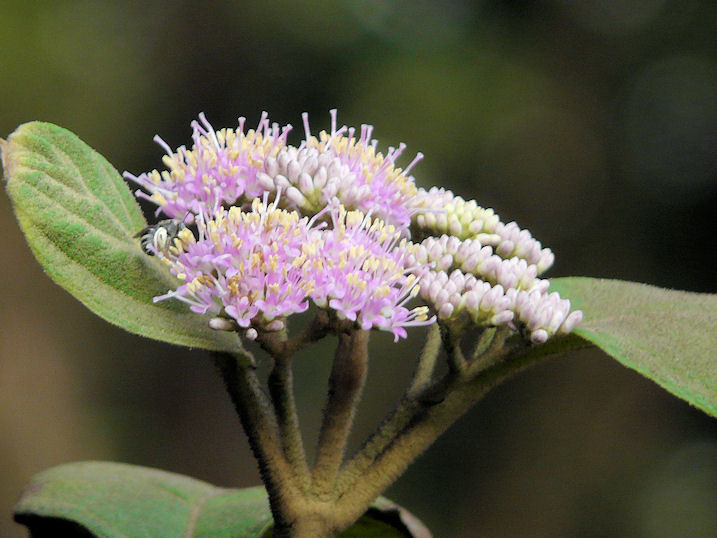
Abb.: प्रियकः । Callicarpa macrophylla Vahl -
Liebesperlenstrauch / Schönfrucht, Thane -
ठाणे,
Maharashtra
[Bildquelle: dinesh_valke. --
http://www.flickr.com/photos/dinesh_valke/2442297455/. -- Zugriff am
2010-10-13. --
Creative
Commons Lizenz (Namensnennung, keine kommerzielle Nutzung, keine
Bearbeitung)]
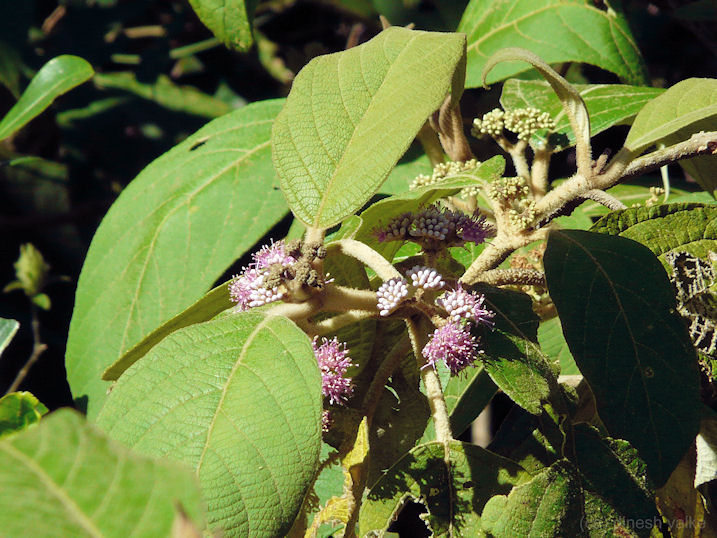
Abb.: गन्धफली । Callicarpa macrophylla Vahl -
Liebesperlenstrauch / Schönfrucht, Maharashtra
[Bildquelle: dinesh_valke. --
http://www.flickr.com/photos/dinesh_valke/3096008156/. -- Zugriff am
2010-10-26. --
Creative
Commons Lizenz (Namensnennung, keine kommerzielle Nutzung, share alike)]
"Callicarpa macrophylla. Vahl. Symbol, iii. 13. t. 53.
[...]
A native of Silhet and Chittagong.
A shrub, from four to eight feet in length."
[Quelle: Roxburgh, William <1751-1815>: Flora indica, or, Descriptions of Indian plants / by the late William Roxburgh. -- Serampore : Printed for W. Thacker, 1832. -- Vol. 1, S. 393.]
Siehe:
Carakasaṃhitā: Ausgewählte Texte aus der Carakasaṃhitā / übersetzt und erläutert von Alois Payer <1944 - >. -- Anhang A: Pflanzenbeschreibungen. -- Callicarpa macrophylla Vahl. -- URL: http://www.payer.de/ayurveda/pflanzen/callicarpa_macrophylla.htm
Bignoniaceae (Trompetenbaumgewächse)
Bis 12 m hoher Baum.
| 37. maṇḍūkaparṇa-patrorṇa-naṭa-kaṭvaṅga-ṭuṇṭukāḥ syonāka-śukanāsarkṣa-dīrghavṛnta-kuṭannaṭāḥ 38 a./b. śoṇakaś cāralātyaphalā tv āmalako triṣu
मण्डूकपर्ण-पत्रोर्ण-नट-कट्वङ्ग-टुण्टुकाः । [Bezeichnungen für Oroxylum indicum (L.) Kurz 1877 - Damoklesbaum - Midnight Horror:]
|
Colebrooke (1807): "Sonapat. Bignonia indica. [= Oroxylum indicum (L.) Kurz 1877]"
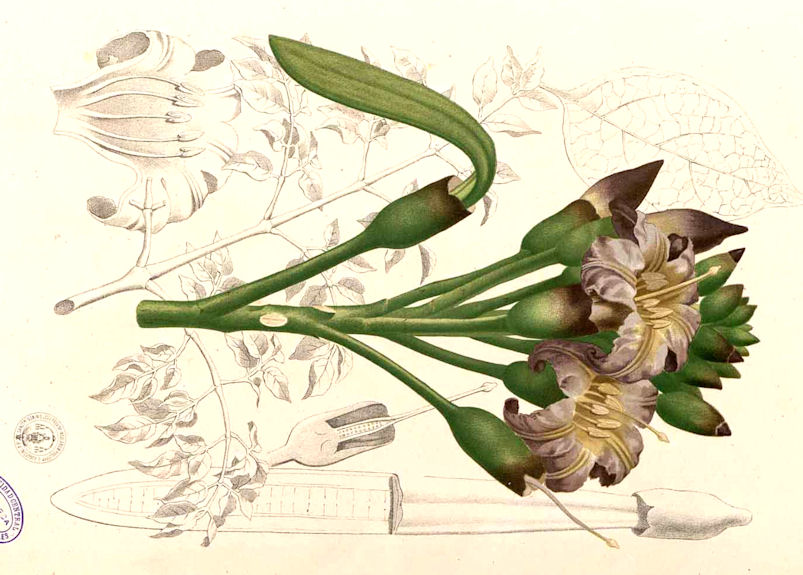
Abb.: मण्डूकपर्णः । Oroxylum indicum (L.) Kurz 1877 - Damoklesbaum
- Midnight Horror
[Bildquelle: Flora de Filipinas, 1880 / Wikipedia. -- Public domain]
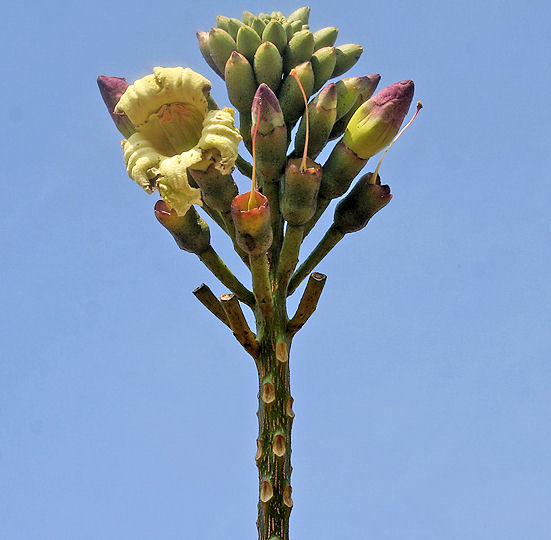
Abb.: दीर्घवृन्तः । Oroxylum indicum (L.) Kurz 1877 - Damoklesbaum
- Midnight Horror, Ranga Reddy
district - రంగా రెడ్డి జిల్లా,
Andhra Pradesh
[Bildquelle: J. M. Garg / Wikimedia.
-- GNU FDLicense]
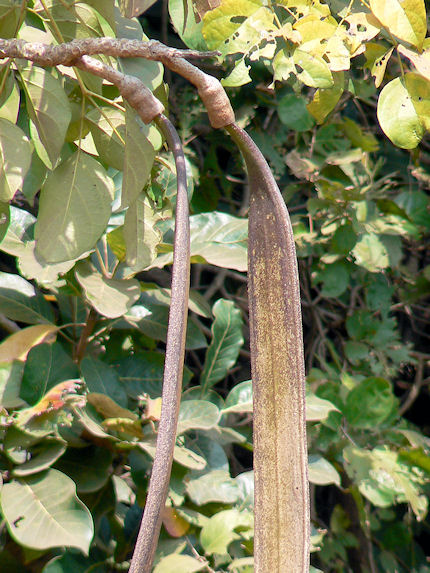
Abb.: नटः । Oroxylum indicum (L.) Kurz 1877 - Damoklesbaum
- Midnight Horror
[Bildquelle: dinesh_valke. --
http://www.flickr.com/photos/dinesh_valke/2128982316/. -- Zugriff am
2010-10-13. --
Creative
Commons Lizenz (Namensnennung, keine kommerzielle Nutzung, keine
Bearbeitung)]
"Bignonia indica. Willd. iii. 306.
[...]
Shyonaka, and Mundooka-purna, two of its Sanscrit names.
[...]
Is one of the tallest trees on the coast, grows up amongst the mountains chiefly. Flowering- time the beginning of the wet season. Seed ripens in January and February.
Trunk very straight, and very high, but thin in proportion.
[...]
The wood of this tree is said to be soft and spongy, so much as to render it unfit for use ; at least I have never been able to discover any that it is put to."
[Quelle: Roxburgh, William <1751-1815>: Flora indica, or, Descriptions of Indian plants / by the late William Roxburgh. -- Serampore : Printed for W. Thacker, 1832. -- Vol. 3, S. 110f.]
"OROXYLUM INDICUM, Vent.
[...]
History, Uses, &C.—This is a small tree, remarkable for its terminal spikes of large fleshy lurid flowers, which appear at the commencement of the rainy season, and are followed by very large, retrofracted, transversely compressed, somewhat curved pods, with the convexity upwards. The seeds are numerous, membranaceous, surrounded with a large, delicate, membranaceous wing. The leaves are supra-decompound, and from four to six feet long., The root-bark is of considerable importance in Hindu medicine, as it is an ingredient of the Dasamula (see Tribulus terrestris) ; it is considered to be astringent, tonic, and useful in diarrhcea and dysentery. Sarangadhara recommends the juice of Syonaka expressed from the roasted bark in combination with Mocharas (see Bomhax malabaricum) as a remedy in diarrhoea and dysentery. He also says that the root-bark boiled in Sesamum oil is a good application in otorrhoea. In the Nighantas the tree bears many synonyms, amongst which may be mentioned Prathu-simbih, "having broad pods," Suka-nasa, " having a nose like a parrot's beak," in allusion to the flower buds, Aralu, and Bhalluka-priya, "dear to bears." It is described as digestive, appetising, bitter, astringent, cold, pungent; a remedy for wind, phlegm, bile, and cough. The bark is much used by the agricultural classes as an application to the sore-backs of draught cattle. It is ground to a paste with water and an equal proportion of turmeric, and rubbed on the part. Rheede notices the use of the bark as an application to wounds, fractures, &c., and of the root in decoction in dropsy.
Dr. B. Evers states that the Gonds call the tree Jaimangal, and that they employ a decoction of the bark as a discutient application to rheumatic swellings. He says:—"I have made a trial of the powder and an infusion of the bark, and have found it to be most powerfully diaphoretic; the drug has slight anodyne properties; also a bath, prepared with the bark, I have frequently employed in rheumatism. Twenty-eight cases of acute rheumatism were treated with this drug, and in all the results have been most satisfactory. The dose of the powder is from 5 to 15 grains, thrice daily; of the infusion (1 ounce of bark to 10 ounces of boiling water) an ounce three times a day. Combined with opium it forms a much more powerful sudorific than the compound powder of ipecacuanha. The drug does not possess any febrifuge properties."—Indian Medical Gazette, February and March, 1875."
[Quelle: Pharmacographia indica : a history of the principal drugs of vegetable origin met with in British India / by William Dymock [1834-1892], C. J. H. Warden and David Hooper [1858-1947]. -- Bd. 3. -- London, 1893. -- S. 15f.]
Siehe:
Carakasaṃhitā: Ausgewählte Texte aus der Carakasaṃhitā / übersetzt und erläutert von Alois Payer <1944 - >. -- Anhang A: Pflanzenbeschreibungen. -- Oroxylum indicum (L.) Kurz. -- URL: http://www.payer.de/ayurveda/pflanzen/oroxylum_indicum.htm
Euphorbiaceae (Wolfsmilchgewächse)
Bis 18 m hoher, laubabwerfender Baum.
| 38. śoṇakaś cāralā
tiṣyaphalā tv āmalakī
triṣu amṛtā ca vayasyā ca triliṅgas tu bibhītakaḥ
शोणकश् चारला
तिष्यफला त्व् आमलकी त्रिषु ।३८ क। [Bezeichnungen für Phyllanthus emblica L. 1753 - Amblabaum - Emblic Myrobalan:]
|
Colebrooke (1807): "Emblic myrobalan. Phyllanthus emblica."
1 तिष्यफला - tiṣyaphalā f.: Tiṣya-Frucht
tiṣya 3: günstig, glückbringen; tiṣya m.: ein Nakṣatra (= Puṣya): γ, δ and θ Cancri ; der Mondmonat Pauṣa ; Kali-yuga
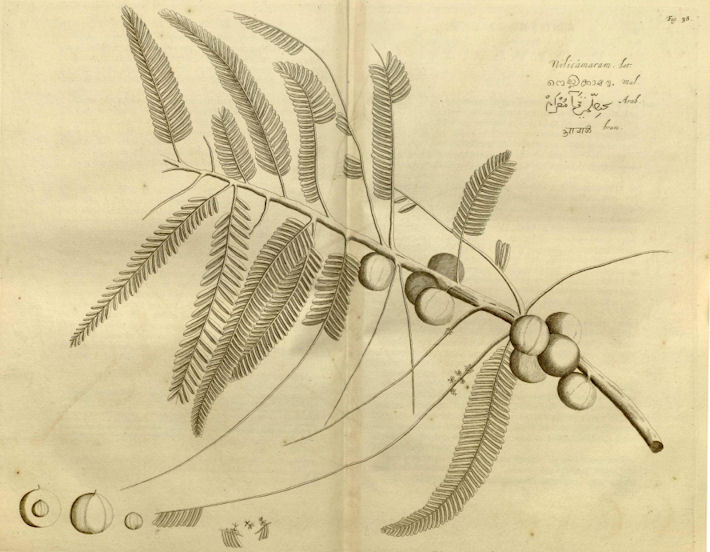
Abb.: आमलकी । Phyllanthus emblica L. 1753 - Amblabaum
- Emblic Myrobalan
[Bildquelle: Hortus malabaricus I. Fig. 38,
1678]
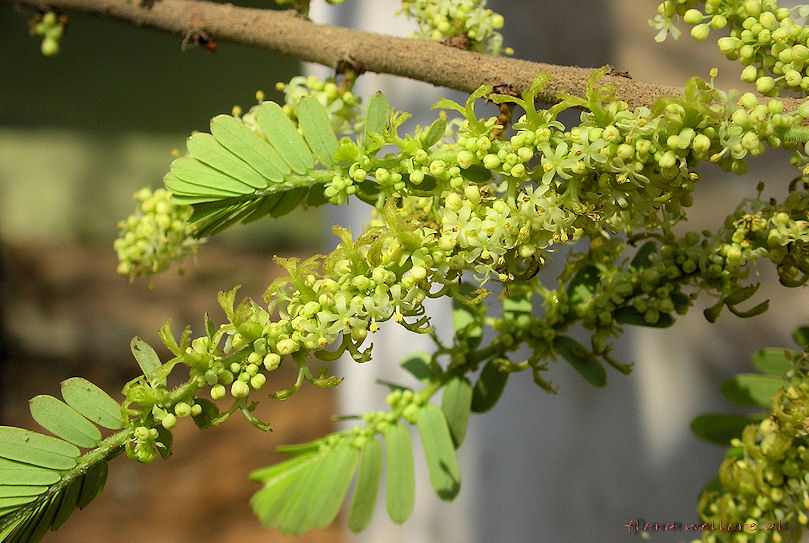
Abb.: आमलकी । Phyllanthus emblica L. 1753 - Amblabaum
- Emblic Myrobalan
[Bildquelle: Lalithamba. --
http://www.flickr.com/photos/45835639@N04/4628413513/. -- Zugriff am
2010-10-13. --
Creative Commons Lizenz (Namensnennung)]
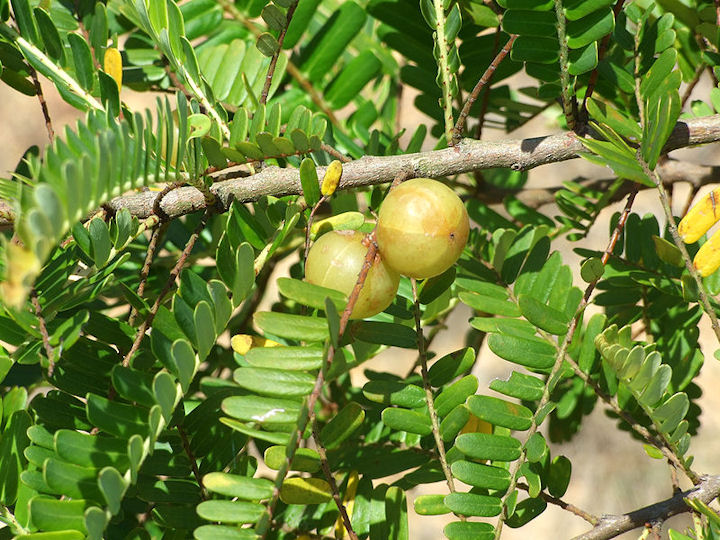
Abb.: तिष्यफला । Phyllanthus emblica L. 1753 - Amblabaum
- Emblic Myrobalan
[Bildquelle: Chong Fat / Wikimedia. --
GNU FDLicens]
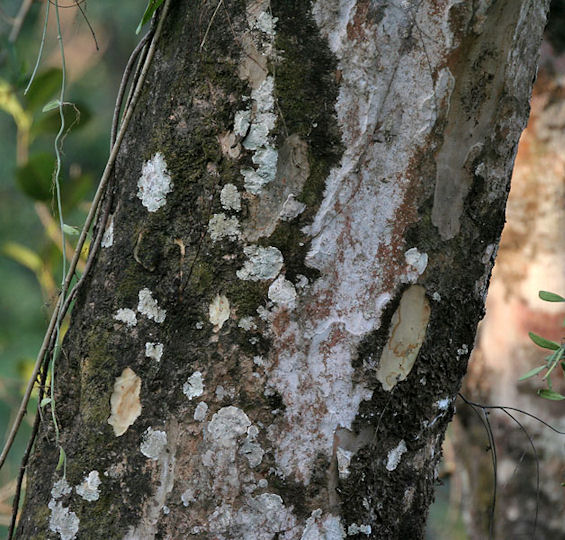
Abb.: वयस्या । Phyllanthus emblica L. 1753 - Amblabaum
- Emblic Myrobalan, Buxa National Park
- বক্সা জাতীয় উদ্যান,
West Bengal
[Bildquelle: J. M. Garg / Wikipedia.
-- GNU FDLicense]
"Phyllanthus Emblica. Willd. iv. 587. [...]
Sans. Amlaki. See Asiat. Res. iv. 308.
[...]
A pretty large tree, found cultivated in most parts of India, and also wild in forests. Flowers during the beginning of the hot season; fruit ripe in eight or nine months after.
[...]
The wood of this tree is hard and durable particularly under water. The bark is strongly astringent ; the natives employ it to cure diarrhoeas, and to tan leather. The fruit is at all times full of exceedingly sharp juice; it is eaten raw by the natives, although to an European, the taste is disagreeably acrid. They are pickled, and made into preserve with sugar, and also baked in tarts; by these means they are more reconcilable to our taste."
[Quelle: Roxburgh, William <1751-1815>: Flora indica, or, Descriptions of Indian plants / by the late William Roxburgh. -- Serampore : Printed for W. Thacker, 1832. -- Vol. 3, S. 671f.]
"Emblica officinalis (Gaertn.) N. O. Euphorbiaceae. Description.--Tree; [...]
Fl. April-Nov.--Wight Icon. t. 1896.
Phyllanthus emblica, Linn.--Roxb. Fl. Ind. iii. 671.--Rheede i. t. 38.
Coromandel. Malabar. Deccan. Bengal.
Medical Uses.—The seeds are given internally as a cooling remedy in bilious affections and nausea, and in infusion make a good drink in fevers. They are also used in diabetes. Infusion of the leaves is applied to sore eyes. Bark of the root mixed with honey is applied to aphthous inflammations of the mouth. The bark of the tree itself is astringent, and is used for tanning purposes. It is medicinally used in diarrhea. The fruit is occasionally pickled, or preserved in sugar. When dry it is said to be gently laxative. In the latter state the decoction is employed in fevers, and mixed with sugar and drunk in vertigo. The young leaves mixed with sour milk are given by the natives in dysentery. In Travancore the natives put the young branches into the wells to impart a pleasant flavour to the water, especially if it be impure from the accumulation of vegetable matter or other causes.—(Ainslie. Rheede.) Antiscorbutic virtues have been attributed to the fruits, which are known as the Emblic Myrobalans. The flowers are employed by the Hindoo doctors for their supposed refrigerant and aperient qualities. The bark partakes of the astringency of the fruit. Dr A. Boss prepared, by decoction and evaporation, from the root, an astringent extract equal to catechu both for medicine and the arts.—Pharm. of India.
Economic Uses.—This tree yields a valuable timber."
[Quelle: Drury, Heber <1819 - 1872>: The useful plants of India : with notices of their chief value in commerce, medicine, and the arts. -- 2d ed. with additions and corrections. London : Allen, 1873. -- xvi, 512 p. ; 22 cm. -- s.v.]
"PHYLLANTHUS EMBLICA, Linn. Emblic myrobalan
[...]
History, Uses, &c.--The fruit of this tree is the Dhātriphala, Amritaphala, Amalaka or Sriphala of the Nighantas, and is described as having all the properties of the chebulic myrobalan. It is used both fresh and dried; in the former condition it is considered to be refrigerant, diuretic and laxative; in the latter, astringent. It is pickled by the natives, and, on account of a peculiar flavour which it imparts, some of the forest tribes eat it before drinking water. A sherbet of the fruit, sweetened, with sugar or honey, is a favourite cooling drink for sick people; it is said to be diuretic. A country-side prescription for biliousness in the Concan is Avala, 4 massas, to be soaked all night in water, and in the morning to be pounded and mixed with a quarter seer of milk and flavoured with sugar and cumin. Emblic myrobalans are an ingredient in many compound preparations described in Sanskrit works. A selection of these prescriptions will be found in Dutt's Hindu Materia Medica; the following, translated from Chakradatta, may be taken as an example:-
"Dhātri lauha. -Take of powdered Emblic myrobalans 64 tolās, prepared iron 32 tolās, liquorice powder 16 tolās, mix them together, and soak in the juice of Tinospora cordifolia seven times successively. This preparation is given in jaundice, anaemia and dyspepsia, in doses of from 20 to 40 grains."
Mahometan physicians esteem this myrobalan equally with the Hindus; they describe it as astringent, refrigerant, cardiacal, and a purifier of the humours of the body. It is much prescribed by them in fluxes, and is also applied externally on account of its cooling and astringent properties. The Arabic name is Amlaj, and the Persian Amala. Ainslie states that the flowers, which have an odour resembling that of lemon peel, are supposed by the Vytians to have virtues of a cooling and aperient nature, and are prescribed in conjunction with other articles in the form of an electuary. (Mat. Ind., ii., p. 244.) In the Pharmacopoeia of India it is stated, upon the authority of Dr. Ae. Ross, that the root by decoction and evaporation yields an astringent extract equal to catechu, both for medicinal purposes and in the arts; the chips of the wood or small branches thrown into impure or muddy water, according to the same authority, clear it effectually. In the Concan the juice of the fresh bark, with honey and turmeric, is given in gonorrhoea.
[...]
Commerce. -Two kinds of Avala are found in commerce, one entire, and the other cut up, and the nut removed. The fruit is collected in many parts of India. Value, about Rs. 32 per candy of 7 cwts."
[Quelle: Pharmacographia indica : a history of the principal drugs of vegetable origin met with in British India / by William Dymock [1834-1892], C. J. H. Warden and David Hooper [1858-1947]. -- Bd. 3. -- London, 1893. -- S. 261ff.]
Siehe:
Carakasaṃhitā: Ausgewählte Texte aus der Carakasaṃhitā / übersetzt und erläutert von Alois Payer <1944 - >. -- Anhang A: Pflanzenbeschreibungen. -- Phyllanthus emblica L. -- URL: http://www.payer.de/ayurveda/pflanzen/phyllanthus_emblica.htm
"Myrobalani. Myrobalani, frantzösisch, Mirobolans, teutsch, Mirobalanen, sind Früchte, die so dicke wie die Pflaumen, und werden gedörrt aus Indien zu uns gebracht. Es giebet ihrer fünff Arten. Die ersten heissen Myrobalani citrini, die gelben: die andern Myrobalani Indici, die indischen: die dritten Myrobalani chebuli: die vierten Myrobalani emblici: und die fünfften Myrobalani bellirici.
Die Myrobalani citrini vel lutei, frantzösisch, Mirobalans citrins, teutsch, gelbe Mirobalanen, sind kleine länglichte oder ovalrunde Früchte, in Grösse der Oliven, auch etwas grösser, haben viel erhabene Ecken, sind hart, und beschliesset eine iede einen länglichten Stein. Sie wachsen auf einem Baume, der einem Pflamenbaume gar ähnlich sieht, doch aber Laub hat wie der Horltzgenbaum. Er wächset ohne Wartung in Indien, insonderheit um Goa rum. Diese Art wird am meisten unter allen zur Artzney gebrauchet, und soll genommen werden, wann sie fein völlig, schwer, harte und gelbröthlicht sind, einen anziehenden, ziemlich unangenehmen Geschmack haben.
Myrobalani Indici, sive nigri, sive Damasonii, frantzösisch, Myrobolans Indiens oder noirs, die indianischen oder schwartzen Mirobalanen, sind länglichte Früchte, so dick wie kleine Eckern, runtzlicht, und haben der Länge nach vier erhabene Ecken, sind übrigens sehr hart, inwendig hol und ohne Kern. Sie wachsen auf einem Baume, dessen Laub wie Weidenlaub aussiehet. Wann diese Frucht noch auf dem Baume steht, ist sie so dick wie eine Olive, zu anfangs grün, wird aber braun, wann sie zeitiget, hernach wird sie gar schwartz, von säuerlichen und anziehenden Geschmack.
Mirobalani Chebuli, Quebuli, Chepuli, Cepuli, frantzösisch, Myrobolans chebules, sind Früchte, so dicke wie die Datteln, länglicht, spitzig an dem Ende, wo sie an dem Baume hangen; eine hat als wie fünff Rippen, die machen gleichsam als wie so viel Ecken, sehen gelblichtbraun, und wachsen auf einem Baume, der so groß ist, als wie ein Pflaumenbaum, in Indien, ohne Wartung, um Decan und in Bengala. Seine Blätter sehen aus als wie das Phirschenlaub: die Blüten sehen als wie Sterne und röthlicht. Diese Mirobalanen soll man erwehlen, wann sie fein völlig und harte sind, von Farbe dunckelgelb, von Geschmack anziehend und in etwas bitter.
Myrobalani Emblici, Embelgi, Emblegi, Ambegi, de Seni, frantzösich, Myrobolans emblics, sind schier gantz runde Früchte, bey nah so dick wie die Galläpfel, auswendig rauh, und haben sechs erhabene Ecken oder Rippen, von Farbe sind sie braun oder dunckel: eine iede beschliesset einen Kern, der ist so groß wie eine kleine Haselnuß, und hat sechs Ecken, siehet gelb. Diese Frucht wächst auf einem Baume, der so hoch ist wie ein Palmenbaum, und hat lange, zart ausgekerbte Blätter, fast wie das Fahrenkraut. Diese Mirobalanen werden uns in vier Theil zerstücket, vom Kern gelöset und dörre zugeführt. Man soll sie erwehlen, wann sie reine sind, und ohne Kern, auswendig schwärtzlicht, und inwendig grau, anziehend von Geschmack, und etwas bitter. Die Indianer brauchen sie das Leder damit grün zu färben, und zu Bereitung der Dinte.
Myrobalani Bellerici, Belleregi, Bellilegi, Bellegu, frantzösisch, Myrobolans Bellerics, die Bellerischen Mirobalanen, sind Früchte, die so dicke sind wie die gemeinen Pflaumen, oval, oder fast gantz rund, hart und gelblicht, viel gleicher und nicht so gar eckigt als die andern, beschliessen eine iede einen länglichten Kern, wie eine Olive, der ist steinhart, ein wenig eckigt und weiß; dieser Kern enthält einen kleinen Nips. Der Baum, der diese Früchte bringt, ist so groß als wie ein Pflaumenbaum; sein Laub siehet wie das Lorbeerlaub, ist aber um ein gutes blässer: er wächst ungewartet. Die Bellerischen Mirobalanen soll man erwehlen, welche dicke sind, fein völlig und gantz, gelblicht von Farbe, gleich und lind anzufühlen; anziehend von Geschmack.
Alle diese Früchte führen viel Sal essentiale und Oel, nicht eben gar viel Erde und phlegma.
Alle Mirobalanen purgiren linde und halten an, schier als wie die Rhabarber. Doch werden die citrini absonderlich dienlich und gut erachtet, die gallhaftigen Feuchtigkeiten abzuführen; die indischen zu der melancholischen Feuchtigkeit, und die übrigen zum Schleim.
Myrobalanus kommt von μὺρον, unguentum, Salbe, und βἁλανος, glans, Eichel, Ecker, als ob es heissen solte, eine Eichel, zur Artzney dienlich, dieweil etliche Arten der Mirobalanen eine Eichelgestalt haben, und weil sie zur Artzney gebrauchet werden."
[Quelle: Lemery, Nicholas: Vollständiges Materialien-Lexicon. Zu erst in Frantzösischer Sprache entworffen, nunmehro aber nach der dritten, um ein grosses vermehreten Edition [...] ins Hochteutsche übersetzt / Von Christoph Friedrich Richtern, [...]. Leipzig: Johann Friedrich Braun, 1721. -- DVD-Ausgabe: Berlin : Directmedia Publ., 2007. -- s. v.]
Combretaceae (Flügelsamengewächse)
Bis 50 m hoher, laubabwerfender Baum.
| 38. c./d. amṛtā ca vayasyā ca triliṅgas tu
vibhītakaḥ 39. a./b. akṣas tuṣaḥ karṣaphalo bhūtāvāsaḥ kalidrumaḥ
अमृता च वयस्या च
त्रिलिङ्गस् तु विभीतकः ॥३८ ख॥ [Bezeichnungen für Terminalia bellirica (Gaertn.) Roxb. 1805 - Belerische Myrobalane - Belleric Myrobalan:]
|
Colebrooke (1807): "Beleric myrobalan. Terminalia belerica."
1 अक्ष - akṣa m.: Würfel: die Nuss von Terminalia bellirica wurde als Würfel beim Würfelspiel verwendet.
2 कर्षफल - karṣaphala m.: Karṣa-Frucht: evtl. nach der Gewichtseinheit Karṣa (ca. 12 g.)
3 कलिद्रुम - kalidruma m.: Kali-Baum: vermutlich nach dem schlechtesten Wurf (Kali) im Würfelspiel
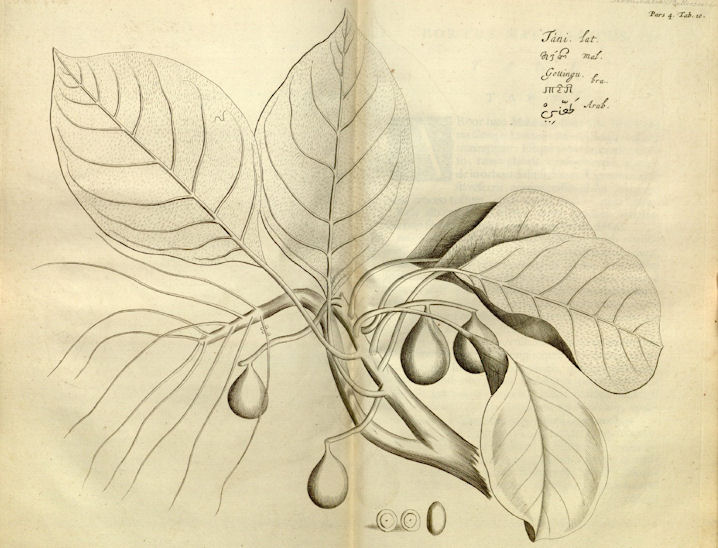
Abb.: विभीतकः । Terminalia bellirica (Gaertn.) Roxb. - Belerische Myrobalane -
Beleric Myrobalan
[Bildquelle: Hortus malabaricus IV. Fig. 10, 1683]
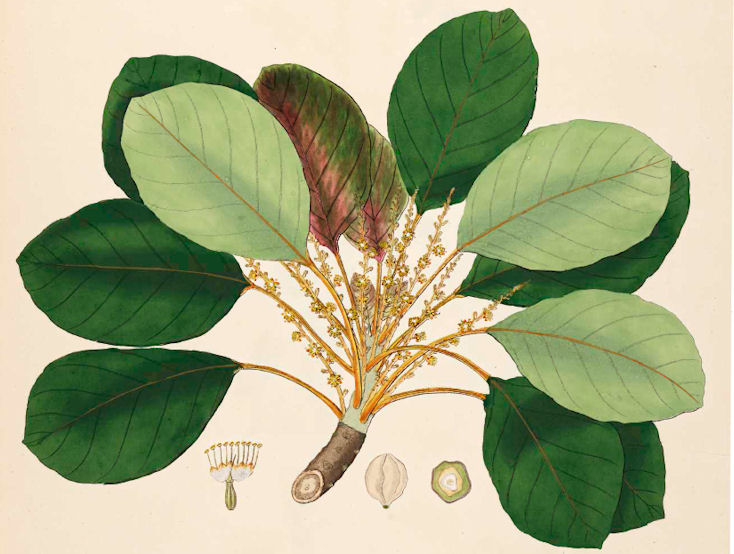
Abb.: विभीतकः । Terminalia bellirica (Gaertn.) Roxb. - Belerische Myrobalane -
Beleric Myrobalan
[Bildquelle: Roxburgh. -- Vol II. -- 1795. -- Image courtesy Missouri Botanical
Garden. http://www.botanicus.org. --
Creative Commons Lizenz
(Namensnennung, keine kommerzielle Nutzung)]
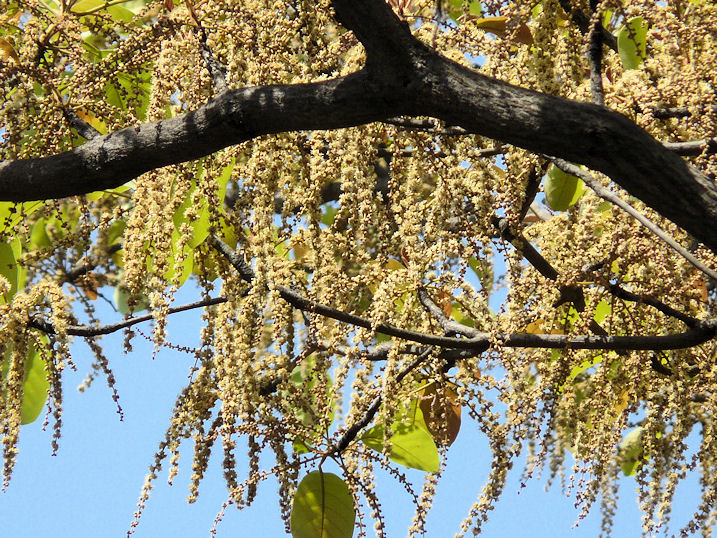
Abb.: विभीतकः । Terminalia bellirica (Gaertn.) Roxb. - Belerische Myrobalane -
Beleric Myrobalan, Karnala Bird Sanctuary,
Maharashtra
[Bildquelle: dinesh_valke. --
http://www.flickr.com/photos/dinesh_valke/3393795075/. -- Zugriff am
2010-10-13. --
Creative
Commons Lizenz (Namensnennung, keine kommerzielle Nutzung, share alike)]
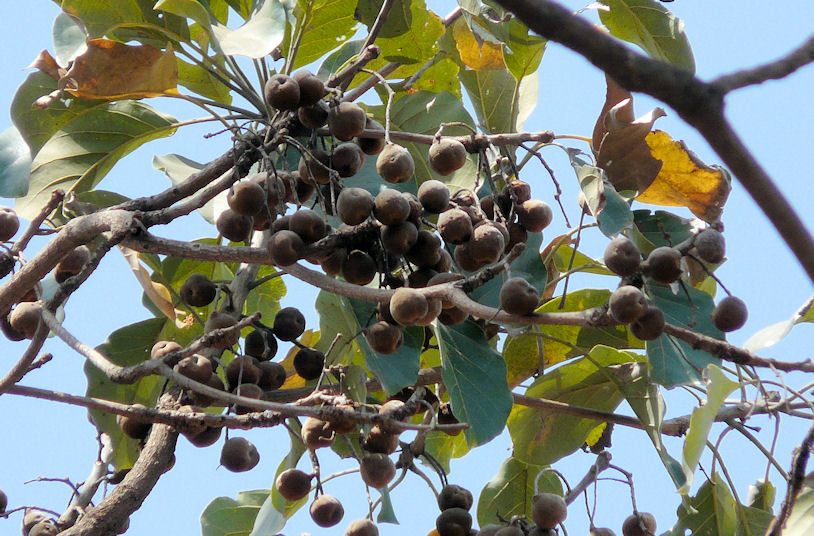
Abb.: कर्षफलः । Terminalia bellirica (Gaertn.) Roxb. - Belerische Myrobalane -
Beleric Myrobalan, Maharashtra
[Bildquelle: dinesh_valke. --
http://www.flickr.com/photos/dinesh_valke/3395011314/. -- Zugriff am
2010-10-13. --
Creative
Commons Lizenz (Namensnennung, keine kommerzielle Nutzung, share alike)]
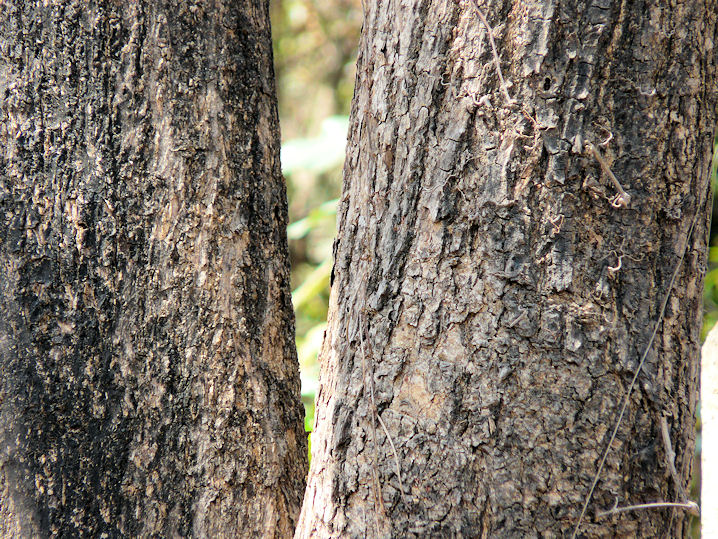
Abb.: भूतावासः । Terminalia bellirica (Gaertn.) Roxb. - Belerische Myrobalane -
Beleric Myrobalan, Maharashtra
[Bildquelle: dinesh_valke. --
http://www.flickr.com/photos/dinesh_valke/3394206467/. -- Zugriff am
2010-10-13. --
Creative
Commons Lizenz (Namensnennung, keine kommerzielle Nutzung, share alike)]
"Terminalia belerica. Corom. pl. 2. N. 198. [...]
Sans. Vibhituka.
[...]
It is a native of the mountainous parts of the Circars, growing to be one of the largest trees, with an erect trunk, and a very large spreading head. Flowering time the beginning of the hot season.
[...]
The kernels of the fruit are eaten by the natives ; they taste like filberts, but are reckoned intoxicating, when eaten in any quantity. Hereabouts they do not use any part of the fruit in medicine, so far as I can learn.
Wood white, rather soft, durable and seldom used.
From wounds in the bark, large quantities of an insipid gum issues, it much resembles Gum arabic, is perfectly soluble in water, burns away in the flame of a candle, with little smell, into black gritty ashes.
The flowers have a strong offensive smell, not unlike those of Sterculia foetida."
[Quelle: Roxburgh, William <1751-1815>: Flora indica, or, Descriptions of Indian plants / by the late William Roxburgh. -- Serampore : Printed for W. Thacker, 1832. -- Vol. 2, S. 431f.]
"Terminalia Bellerica (Roxb.) Belleric Myrobalen.
Description.--Tree, 100 feet; [...]
Fl. March-April.
W. & A. Prod. i. 313.--Wight Ill. i. t. 91.--Roxb. Fl. Ind. ii. 431.--Cor. ii. t. 198.--Rheede iv. t. 10.
Peninsula. Bengal.
Medical Uses.—A quantity of insipid gum, resembling Gum- Arabic, issues from the trunk when wounded; soluble in water, but inflammable, and will burn like a candle. The kernel of the nut is said to intoxicate if eaten in any great quantity. Mixed with honey it is used in ophthalmia. The fruit in its dried state is larger than a gall-nut, but not so regular in shape. It is astringent in taste, and is tonic and attenuant.—(Ainslie. Roxb.) It is also used in dropsy, diarrhoea, piles, and leprosy, as well as for coughs. In large doses it becomes a narcotic poison. The produce of a single tree will sometimes sell for 2000 rupees. The fruit ripens about October, and consists of a nut enclosed in a thin exterior rind. It is used as an aperient, and also forms a dingy yellow dye. The fruit is exported by traders from the plains, who generally contract for each tree according to the produce it bears. A single nut sometimes sells for a rupee.—(Barnes in Powel's Punj. Prod.) These fruits are procurable at a nominal cost throughout India; and when other aperients are not available, may safely be resorted to. Their astringency renders them valuable in the arts, as well as a substitute for galls for lotions, injections, and so on. Twining (Diseases of Bengal) gives a case of enlargement of the spleen where this medicine was used with the best effects.—Pharm. of India.
Economic Uses.—The wood is white and durable, good for working purposes, large chests, and shipbuilding.—Roxb."
[Quelle: Drury, Heber <1819 - 1872>: The useful plants of India : with notices of their chief value in commerce, medicine, and the arts. -- 2d ed. with additions and corrections. London : Allen, 1873. -- xvi, 512 p. ; 22 cm. -- s.v.]
"TERMINALIA BELERICA, Roxb. [...]
History, Uses, &C.—This tree, in Sanskrit Vibhita and Vibhitaka (fearless), is avoided by the Hindus of Northern India, who will not sit in its shade, as it is supposed to be inhabited by demons. Two varieties of T. belerica arc found in India, one with nearly globular fruit. 1/2 to 3/4 inch in diameter, the other with ovate and much larger fruit. The pulp of the fruit (Beleric myrobalan) is considered by Hindu physicians to be astringent and laxative, and is prescribed with salt and long pepper in affections of the throat and chest. As a constituent of the triphala (three fruits), i.e., emblic, beleric and chebulic myrobalans, it is fed in a great number of diseases, and the kernel is sometimes used as an external application to inflamed parts. On account of its medicinal properties the tree bears the Sanskrit synonym of Anila-ghnaka, or "wind-killing". According to the Nighantas the kernels are narcotic.
Mahometan writers describe Balilaj (the beleric myrobalan) as astringent, tonic, digestive, attenuant, and aperient, and useful as an astringent application to the eyes. As long as the doctrines of the Arabian school prevailed, myrobalans were used medicinally in Europe, havin being introduced by the Arabs from India.
The
μυροβαλανοσ of the classical Greek and Latin writers was a fruit from which the perfumers obtained oil for their unguents. According to Theophrastus, the outer cortical portion was pounded to extract the oil, as that part only was sweet smelling. It is uncertain what this fruit was, but it appears to have been something similar to that of the African oil palm (Elaeis guineensis), the outer fleshy coating of which yields an oil of the consistence of butter, having a rather pleasant violet-like odour when fresh. The later Greek physicians apply the terms μυροβαλανοσ and μυρεψικοσ to Indian myrobalans.T. belerica produces a quantity of gum of the Bassora type, which is collected and mixed with soluble gums for sale as country gum.
[...]
Commerce.—Myrobalans are one of the principal forest products of India; they are collected in large quantities on Government account, and yearly auctions are held by the Forest Conservancy Department. Both chebulic and beleric myrobalans are largely exported for tanning and dyeing. The exports from the whole of India were .—In 1885-86, 706,000 cwts., valued at 30 lakhs of rupees ; in 1886-87, 597,000 cwts., valued at 23 lakhs of rupees ; in 1887-88, 678,000 cwts., valued at 25 lakhs of rupees."
[Quelle: Pharmacographia indica : a history of the principal drugs of vegetable origin met with in British India / by William Dymock [1834-1892], C. J. H. Warden and David Hooper [1858-1947]. -- Bd. 2. -- London, 1891. -- S. 5f.]
Combretaceae (Flügelsamengewächse)
Bis 30 m hoher, laubabwerfender Baum.
| 39. c./d. abhayā tv avyathā pathyā kāyasthā pūtanāmṛtā 40. a./b. harītakī haimavatī cetakī śreyasī śivā
अभया त्व् अव्यथा पथ्या कायस्था पूतनामृता ॥३९ ख॥ [Bezeichnungen für Terminalia chebula (Gaertn.) Retz. 1789 - Chebulische Myrobalane - Chebulic Myrobalan:]
|
Colebrooke (1807): "Yellow myrobalan. Terminalia citrina [(Gaertn.) Roxb. ex Fleming]."
Terminalia chebula (Gaertn.) Retz. - Chebulische Myrobalane - Chebulic Myrobalan
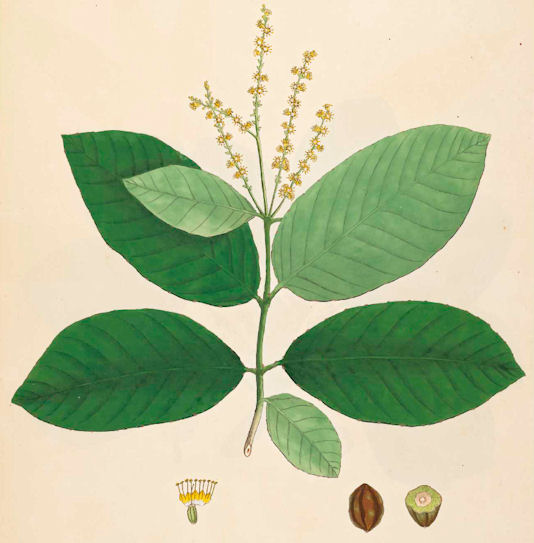
Abb.: अभया । Terminalia chebula (Gaertn.) Retz. - Chebulische Myrobalane -
Chebulic Myrobalan
[Bildquelle: Roxburgh. -- Vol II. -- 1795. -- Image courtesy Missouri Botanical
Garden. http://www.botanicus.org. --
Creative Commons Lizenz
(Namensnennung, keine kommerzielle Nutzung)]
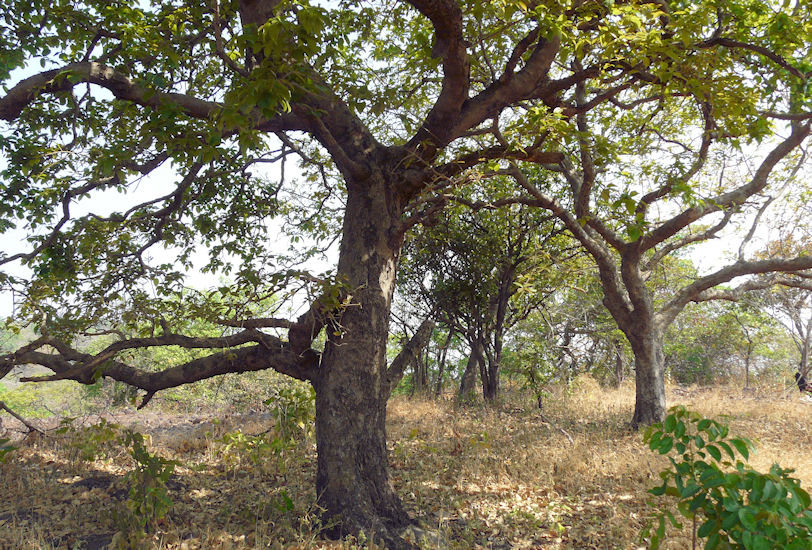
Abb.: हरीतकी । Terminalia chebula (Gaertn.) Retz. - Chebulische Myrobalane -
Chebulic Myrobalan, Mahuli, Thane -
ठाणे,
Maharashtra
[Bildquelle: dinesh_valke. --
http://www.flickr.com/photos/dinesh_valke/3309173970/. -- Zugriff am
2010-10-13. --
Creative
Commons Lizenz (Namensnennung, keine kommerzielle Nutzung, share alike)]
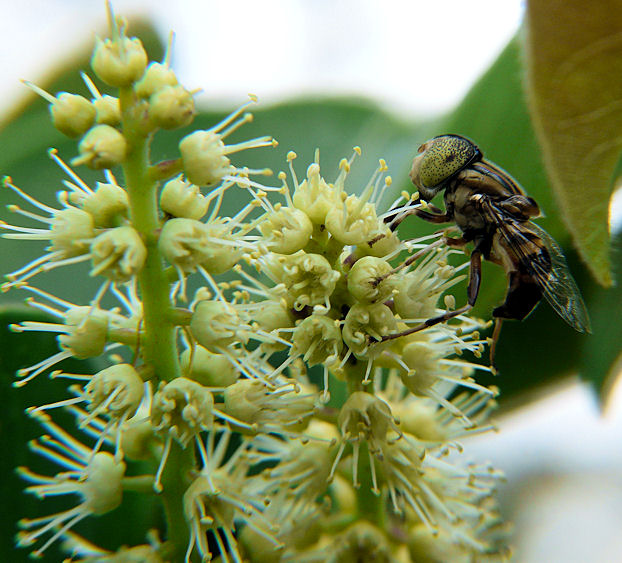
Abb.: हरीतकी । Terminalia chebula (Gaertn.) Retz. - Chebulische Myrobalane -
Chebulic Myrobalan, Mahuli, Thane -
ठाणे,
Maharashtra
[Bildquelle: dinesh_valke. --
http://www.flickr.com/photos/dinesh_valke/3308328291/. -- Zugriff am
2010-10-13. --
Creative
Commons Lizenz (Namensnennung, keine kommerzielle Nutzung, share alike)]
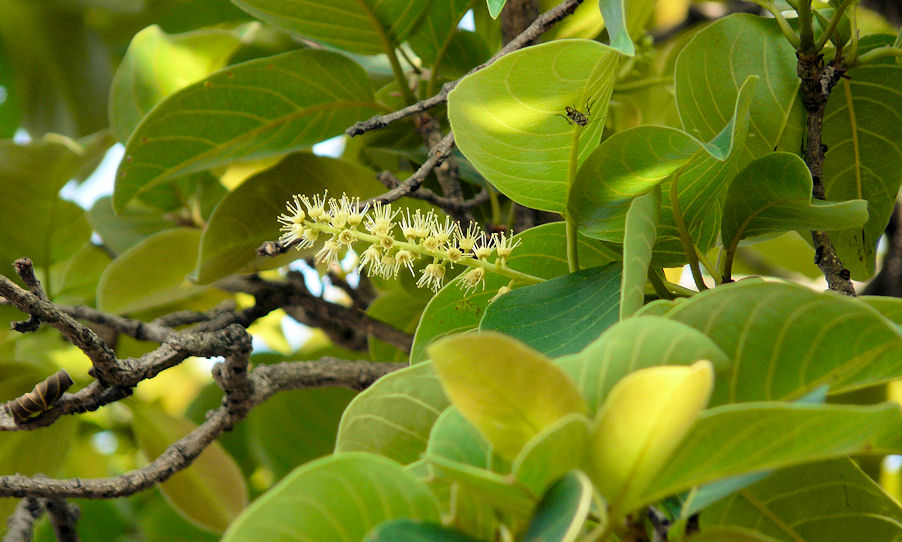
Abb.: हैमवती । Terminalia chebula (Gaertn.) Retz. - Chebulische Myrobalane -
Chebulic Myrobalan, Mahuli, Thane -
ठाणे,
Maharashtra
[Bildquelle: dinesh_valke. --
http://www.flickr.com/photos/dinesh_valke/3308342459/. -- Zugriff am
2010-10-13. --
Creative
Commons Lizenz (Namensnennung, keine kommerzielle Nutzung, share alike)]
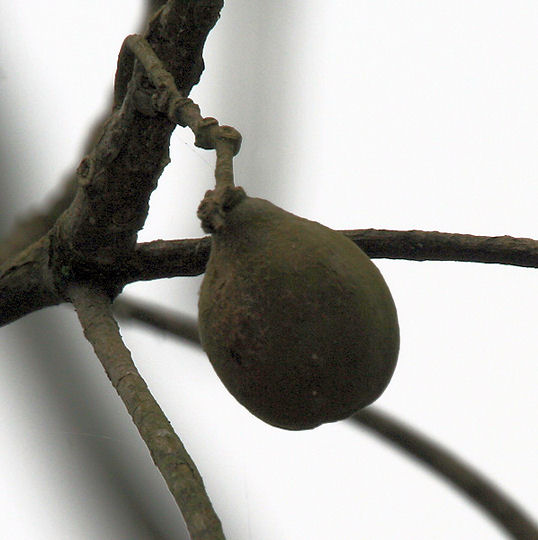
Abb.: पथ्या । Terminalia chebula (Gaertn.) Retz. - Chebulische Myrobalane -
Chebulic Myrobalan, Buxa National Park
- বক্সা জাতীয় উদ্যান,
West Bengal
[Bildquelle: J. M. Garg / Wikipedia.
-- GNU FDLicense]
"Terminalia chebula. Willd. 4. 969.
[...]
Sans. Haritaka.
[...]
Zengi, or Zunguhar, the black or Indian myrabolans, and for the Asiatic synonyms of the other varieties, see Dr. Fleming's paper at page 181, in the 11th. volume of the Asiatic Researches above quoted.
A large tree, a native of the forests of India, from Cape Comorin, to the mountains which bound the plains of Bengal, Oude, &c. on the north. Flowering time in Bengal, the hot season. The seed ripens in November and December.
[...]
The tender leaves, while scarce unfolded, are said to be punctured by an insect, and its eggs deposited therein, which by the extravasation of the sap, become enlarged into hollow galls of various shapes and sizes, but rarely exceeding an inch in diameter. They are powerfully astringent, and make as good ink as oak galls. They also yield the chintz painters on the Coast of Coromandel, their best and most durable yellow. They are called by the Tamuls Kadu kai, and by the Telingas Aldicai, and are very like the Faba Bengalensis of our Materia Medica."
[Quelle: Roxburgh, William <1751-1815>: Flora indica, or, Descriptions of Indian plants / by the late William Roxburgh. -- Serampore : Printed for W. Thacker, 1832. -- Vol. 2, S. 434f.]
"Terminalia Chebula (Roxb.) Description.--Tree, 40-50 feet; [...]
Fl. March-April.
W. & A. Prod. i. 313.--Roxb. Fl. Ind. ii. 433.--Cor. ii. t. 197.
Terminalia reticulata, Roth.
Peninsula. Bengal.
Medical Uses.—The Kadukai (gall-nuts) well rubbed with an equal proportion of catechu is used in aphthous complaints, and considered a valuable remedy. The unripe dried fruits, which are the Indian or black myrobolan (Kooroovillah-kadukai, Tam. and Mal.) of old writers, and which are sold in the Northern Provinces in Bengal, are recommended as purgative by the natives.—(Ainslie.) The gall-like excrescences found on the leaves, caused by the deposited ova of some insect* are held in great repute as an astringent by the natives. They are very efficacious remedies in infantile diarrhoea, the dose for a child under a year old being one grain every three hours. It has been administered in many instances with the greatest benefit.—(Pharm. of India.) The price and supposed efficacy of the fruit increase with the size; one weighing six tolahs would cost about 20 rupees. It acts internally as aperient, externally as an astringent applicati6n to ulcers and skin diseases.—Powel's Punj. Prod.
Economic Uses.—The outer coat of the fruit of this tree mixed with sulphate of iron makes a very durable ink. The galls are found on the leaves, and are produced by insects puncturing the tender leaves. With them and alum the best and most durable yellow is dyed, and in conjunction with ferruginous mud, black is procured from them. The fruit is very astringent, and on that account much used by the Hindoos in their arts and manufactures. The timber is good, of a yellowish-brown colour. It is used for agricultural purposes and for building. It attains its full size in thirty years.—Roxb."
[Quelle: Drury, Heber <1819 - 1872>: The useful plants of India : with notices of their chief value in commerce, medicine, and the arts. -- 2d ed. with additions and corrections. London : Allen, 1873. -- xvi, 512 p. ; 22 cm. -- s.v.]
"TERMINALIA CHEBULA, Retz. [...]
History Uses, &c.—There are several varieties of this tree, some of which have probably been produced by cultivation. T. citrina, Roxb., is considered by some to be a separate species. Dutt (Hindu Materia Medica) informs us that Chebulic myrobalans, in Sanskrit: Haritaki, Abhaya, and Pathya, were highly extolled by the ancient Hindus as a powerful alterative and tonic. They have received the names of Pranada or lifegiver, Sudha or nectar, Bhishakpriya or Physician's favourite and so forth. A mythological origin has also been attributed to the tree. "It is said that when Indra was drinking amrita, in heaven a drop of the fluid fell on the earth and produced the plant." On this account it is called Shakra-srishta " created by Indra."
Indian writers describe seven varieties of Haritaki, which however are nothing more than the same fruit in different stages of maturity. Very large fruit are considered particularly valuable, and fetch a fancy price. Chebulic myrobalans are considered to be laxative, stomachic, tonic, and alterative. They are prescribed alone or in combination with Emblic and Beleric myrobalans in a vast number of diseases, chiefly those affecting the chest and abdomen. The three myrobalans together are called triphala or the three-fruits in Sanskrit. Various original receipts for their administration will be found in Dutt's Hindu Materia Medica.
Myrobalans were known to the early Arabian writers, and through them to the Greek writer Actuarius, who mentions five kinds. Nicolas Myrepsicus also notices them. The author of the Makhzan-el-Adwiya, on the subject of chebulic myrobalans, says that the very young fruit, about the size of cumin seeds, are called Halileh-i-zira ; when about the size of a grain of barley, Halileh-i-jawi; when of the size of a raisin, Halileh-i-zangi or Halileh-i-hindi ; when half arrived at maturity and yellowish, Halileh-i-chini ; when still further advanced, Halileh-i-asfar; and lastly, when quite mature, Halileh-i-kabuli. Of these six varieties of chebulic myrobalans, the second, third, and last only are in general use for medicinal purposes, the fourth and fifth, also known as Rangsri har or hirade, are chiefly used by tanners. The Mahometans, like the Hindus, attribute a great many fanciful properties to the drug; shortly, we may say, that the ripe fruit is chiefly used as a purgative, and is considered to remove bile, phlegm, and adust bile; it should be combined with aromatics, such as fennel seeds, caraways, &c. The Arabs say,—"Halileh is in the stomach like an intelligent housewife, who is a good manager of the house." The unripe fruit (Halileh-i-hindi or Himaja) is most valued on account of its astringent and aperient properties, and is a useful medicine in dysentery and diarrhoea ; if should also be given with aromatics. Locally it is applied as an astringent. The first and second kind are supposed to have the same properties as the third in a less degree, and the forth and fifth the same as the sixth in a less degree.
The best way of administering myrobalans as a purgative is to make an infusion or decoction of from 2 to 4 drachms of fruit pulp with the addition of a pinch of caraway seeds and a little honey or sugar.
Ainslie notices their use as an application to aphthae. In the Pharmacopoeia of India, Dr. Waring mentions his having found six of the mature fruit an efficient and safe purgative, producing four or five copious stools, unattended by griping, nausea or other ill effects ; probably those used by him were not of the largest kind. Dr. Hove in his account of a visit to the Myrobalan Plantation at Bungar in the Concan in 1787, states that he found one fruit a sufficient purgative, though the manager of the plantation told him that two were generally used. Twining (Diseases of Bengal, Vol. I., p. 407,) speaks very favourably of the immature fruit (Halileh-i-zangi) as a tonic and aperient in enlargements of the abdominal viscera. We have found them a useful medicine in diarrhoea and dysentery, given in doses of a drachm twice a day. Recently, M. P. Apery has brought to the notice of the profession in Europe the value of these black myrobalans in dysentery, choleraic diarrhoea, and chronic diarrhoea; he administers them in pills of 25 centigrams each, the dose being from 4 to 12 pills or even more in the 24 hours. (Journ. de Pharm. et de Chim. Feb. 1st, 188S.)
Roxburgh states that the tender leaves, while scarce unfolded, are said to be punctured by an an insect, and its eggs deposited therein, which by the extravasation of the sap, become enlarged into hollow galls of various shapes and sizes, but rarely exceeding an inch in diameter. They are powerfully astringent, and make as good ink as oak galls. They also yield the chintz painters on the coast of Coromandel their best and most durable yellow. They are called by the Tamils Kadu-cai-pu, and by the Telingas Aldicai, (Fl. Ind. II., 435.) In the Pharmacopceia of India they are noticed on the authority of the Rev. J. Kearns of Tinnevelly as a valuable astringent in diarrhoea. The Himalayan tribes eat the kernels of this myrobalan, and use the fruit as a remedy for sore throat under the name of Khoki."
[Quelle: Pharmacographia indica : a history of the principal drugs of vegetable origin met with in British India / by William Dymock [1834-1892], C. J. H. Warden and David Hooper [1858-1947]. -- Bd. 2. -- London, 1891. -- S. 1-3.]
Siehe:
Carakasaṃhitā: Ausgewählte Texte aus der Carakasaṃhitā / übersetzt und erläutert von Alois Payer <1944 - >. -- Anhang A: Pflanzenbeschreibungen. -- Terminalia chebula (Gaertn.) Retz. -- URL: http://www.payer.de/ayurveda/pflanzen/terminalia_chebula.htm
Terminalia citrina (Gaertn.) Roxb. ex Fleming
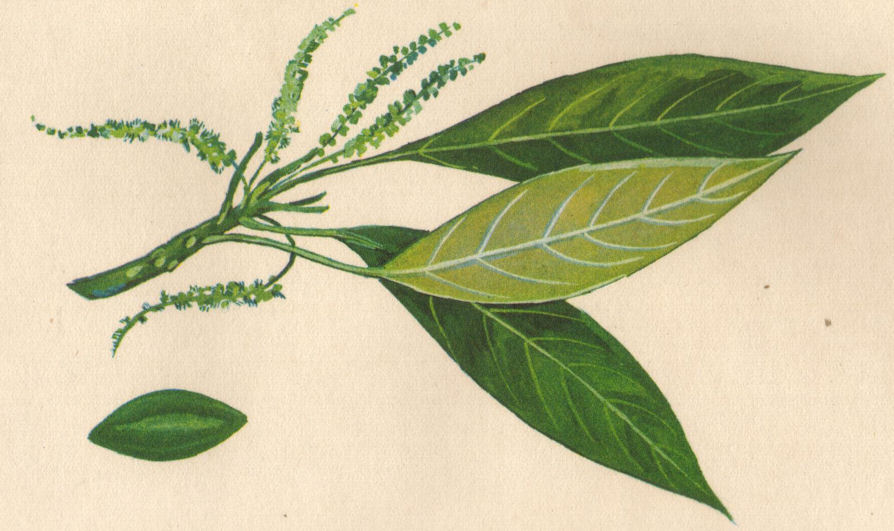
Abb.: Terminalia
citrina (Gaertn.) Roxb. ex Fleming
[Bildquelle:
http://www.tuninst.net/MyanMedPlants/TIL/famC/Combretaceae.htm. -- Zugriff
am 2010-10-13]
"Terminalia citrina. Roxb. [...]
A very large, and tall timber tree, a native of the various extensive forests on the eastern frontier of Bengal where it is called Hurituki ; it blossoms there in April and May, and the seed ripens in November.
The fruit of this, like that of T. chebula, is an article of import in Hindoo Materia Medica and generally, I believe, pass under the same name, so much alike are they, and for the most part employed as gentle purgatives.
Trunk straight, and of very great size. Branches spreading, but not much crowded. Bark rather scabrous that of the young shoots strongly marked with light coloured, elevated specks ; wood much like mahogany, but finer grained ; a beautiful specimen sent to me by Mr. Smith of Silhet, was accompanied with the following words :
"This piece of wood is from a tree which I bought ; it was eighty feet long, one straight body or trunk, and was nine feet in circumference. This wood is very hard, no insect will touch it.""
[Quelle: Roxburgh, William <1751-1815>: Flora indica, or, Descriptions of Indian plants / by the late William Roxburgh. -- Serampore : Printed for W. Thacker, 1832. -- Vol. 2, S. 435f.]
Pinaceae (Kieferngewächse)
Bis 50 m hoher Nadelbaum.
| 40. c./d. pītadruḥ saralaḥ pūtikāṣṭhaṃ cātha drumotpalaḥ पीतद्रुः सरलः पूतिकाष्ठं चाथ द्रुमोत्पलः ॥४० ख॥ [Bezeichnungen für Pinus roxburghii Sarg. 1897 - Chir-Kiefer - Chir Pine:]
|
Colebrooke (1807): "Sural. A tree which yields a resin."
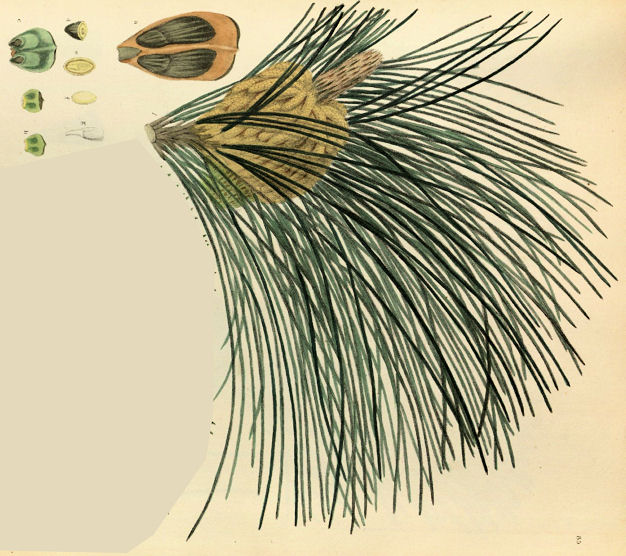
Abb.: सरलः । Pinus roxburghii Sarg. 1897 - Chir-Kiefer - Chir Pine
[Bildquelle: Royle, J. Forbes <1799-1858>: Illustrations of the botany and other
branches of the natural history of the Himalayan Mountains :and of the flora of
Cashmere. -- Vol 2: Plates. -- London : Allen, 1839. -- Pl. 85.]
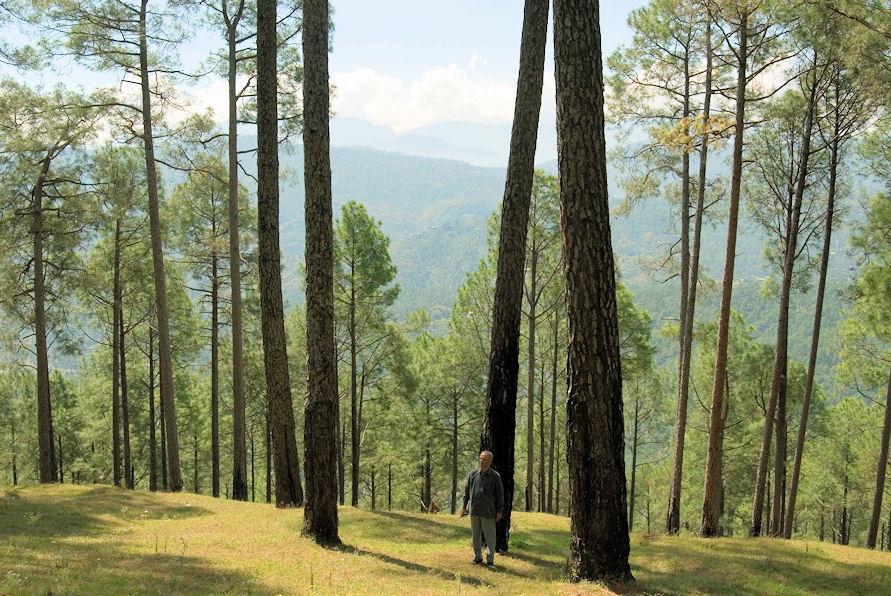
Abb.: सरलः । Pinus roxburghii Sarg. 1897 - Chir-Kiefer - Chir Pine,
Ranikhet - रानीखेत, Uttaranchal
[Bildquelle: Sanjoy Ghosh / Wikimedia. --
Creative Commons
Lizenz (Namensnennung)]
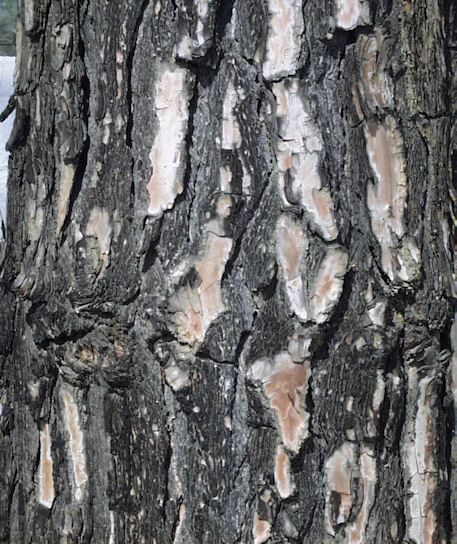
Abb.: सरलः । Pinus
roxburghii Sarg. 1897 - Chir-Kiefer - Chir Pine
[Bildquelle: Paul venter / Wikipedia. -- Public domain]
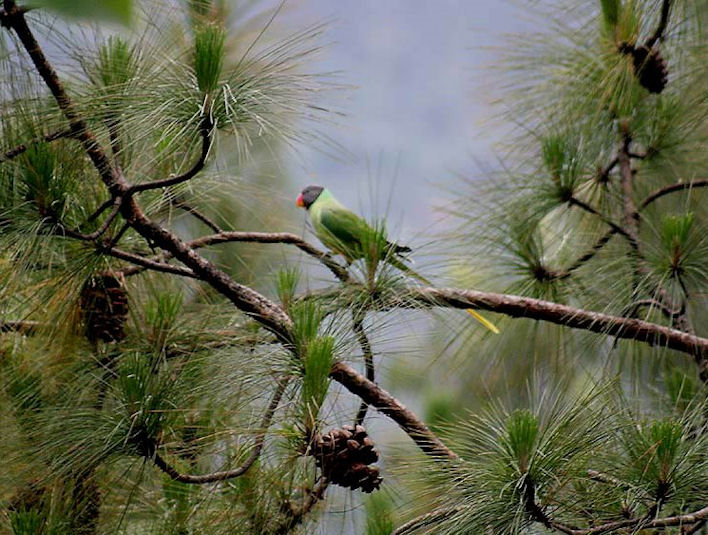
Abb.:
पूतिकाष्ठम् । Slaty-headed Parakeet - Psittacula himalayana - auf
Pinus roxburghii Sarg. 1897 - Chir-Kiefer - Chir Pine,
Kullu - कुल्लू, Himachal Pradesh
[Bildquelle: J. M. Garg / Wikipedia.
-- GNU FDLicense]
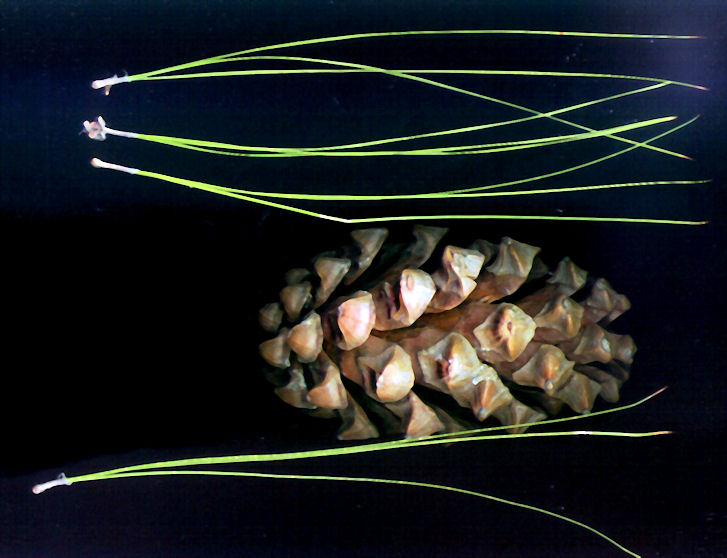
Abb.: Pinus roxburghii Sarg. 1897 - Chir-Kiefer - Chir Pine
[Bildquelle: Paul venter / Wikipedia. -- Public domain]
"PINUS LONGIFOLIA, Roxb.
[...]
History, Uses, &C.—The wood, in Sanskrit Sarala, and the turpentine Sarala-drava, are mentioned as medicinal in Sanskrit works; plasters, ointments, and pastiles for fumigations are directed to be made from the turpentine. The latter, under the name of Ganda-biroja, or, more correctly, Gandahbirozah, is found in all the Indian bazaars, and appears to have all the properties of ordinary turpentine, though differing from it in odour. It is chiefly used as a pectoral plaster like the pitch plaster of Europe, but it has also a reputation in veterinary practice as a remedy for mange. The Vaids obtain from it by distillation without water a limpid sherry-coloured oil having the peculiar odour of the drug, which they call Khanno oil in the Deccan; it is in much repute as a remedy for gleet or long-standing gonorrhoea.
Collection.—The Chir Pine, which is a large tree of Afghanistan and the North-West Himalayas, is the chief source of this turpentine. Atkinson, who describes its collection in Gurhwal and Kumaon, says that it is there called Birja and Lisha or Lassa and that there are two kinds collected, viz., the natural exudation and Bakhar-birja, which is obtained by making incisions in the sap-wood. The yield of a tree thus treated is said to be from 10 to 20 lbs. the first year, and about one-third the quantity the second year, after which the tree either dies or is blown down. (Atkinson, Brandis.)"
[Quelle: Pharmacographia indica : a history of the principal drugs of vegetable origin met with in British India / by William Dymock [1834-1892], C. J. H. Warden and David Hooper [1858-1947]. -- Bd. 3. -- London, 1893. -- S. 378.]
Siehe:
Carakasaṃhitā: Ausgewählte Texte aus der Carakasaṃhitā / übersetzt und erläutert von Alois Payer <1944 - >. -- Anhang A: Pflanzenbeschreibungen. -- Pinus roxburghii Sarg. -- URL: http://www.payer.de/ayurveda/pflanzen/pinus_roxburghii.htm
| 40. c./d. pītadruḥ saralaḥ pūtikāṣṭhaṃ cātha drumotpalaḥ 41. a./b. karṇikāraḥ parivyādho lakuco likuco ḍahuḥ
पीतद्रुः सरलः पूतिकाष्ठं
चाथ द्रुमोत्पलः ॥४० ख॥ [Bezeichnungen für ???:]
|
Colebrooke (1807): "Caniyar. Pterospermum acerifolium [(L.) Willd.] or [=] Pentapetes acerifolia [L.] [Malvaceae (Malvengewächse). Bis 20 m hoher Baum.]."
Pterospermum acerifolium (L.) Willd.
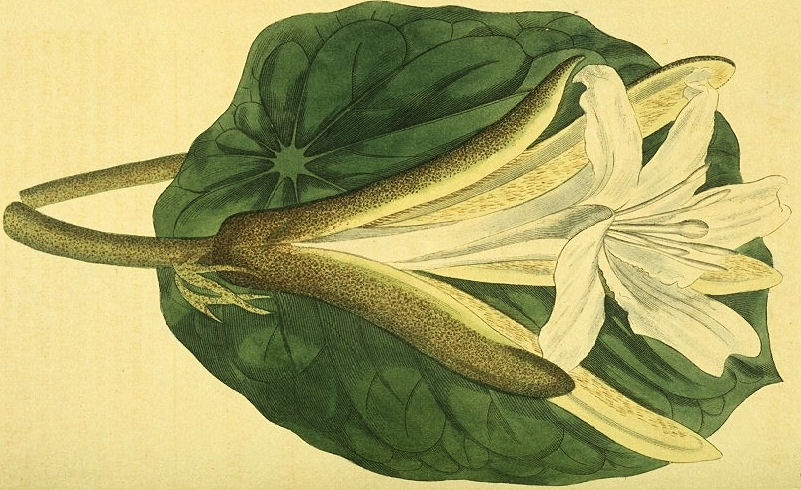
Abb.: द्रुमोत्पलः । Pterospermum
acerifolium (L.) Willd.
[Bildquelle: The Botanical Magazine 1803
/ Wikimedia. -- Public domain]
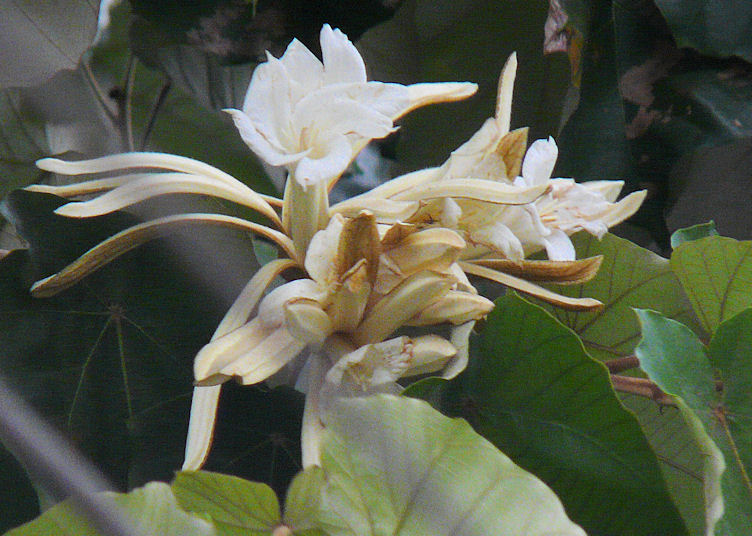
Abb.:द्रुमोत्पलः । Pterospermum
acerifolium (L.) Willd., Maharashtra
[Bildquelle: dinesh_valke. --
http://www.flickr.com/photos/dinesh_valke/2673877681/. -- Zugriff am
2010-10-13. --
Creative
Commons Lizenz (Namensnennung, keine kommerzielle Nutzung, share alike)]
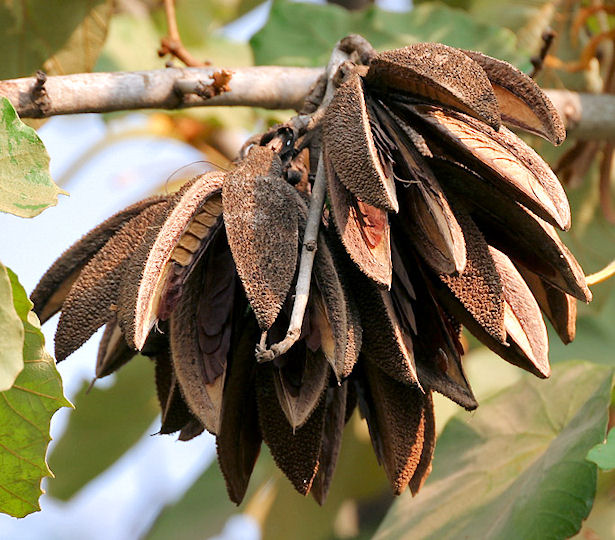
Abb.: परिव्याधः । Pterospermum
acerifolium, Hyderabad -
హైదరాబాద్ -
حیدرآباد, Andhra Pradesh
[Bildquelle: J. M. Garg / Wikipedia.
-- GNU FDLicense]
"Pterospermum acerifolium. Willd, iii. 729, &c.
[...]
Pentapetes acerifolia. Linn. Cavan. &c.
Kurnikara, the Sanscrit name.
[...]
I cannot say where the tree is indigenous; in Bengal, it is found in the gardens only, and is yet but twenty-five or thirty feet high ; but seems to be naturally a very large tree. Flowering time, the beginning of the hot season.
[...]
The flowers, like those of P. suberifolium, render water gelatinous."
[Quelle: Roxburgh, William <1751-1815>: Flora indica, or, Descriptions of Indian plants / by the late William Roxburgh. -- Serampore : Printed for W. Thacker, 1832. -- Vol. 3, S. 158f.]
Moraceae (Maulbeergewächse)
Bis 9 m hoher, laubabwerfender Baum.
| 41. a./b. karṇikāraḥ parivyādho lakuco likuco ḍahuḥ कर्णिकारः परिव्याधो लकुच्चो लिकुच्चो डहुः ।४१ क। [Bezeichnungen für Artocarpus lakoocha Roxb. - Monkey jack:]
|
Colebrooke (1807): "Barahal. Artocarpus lokutsha (lucucha), R[oxb]."
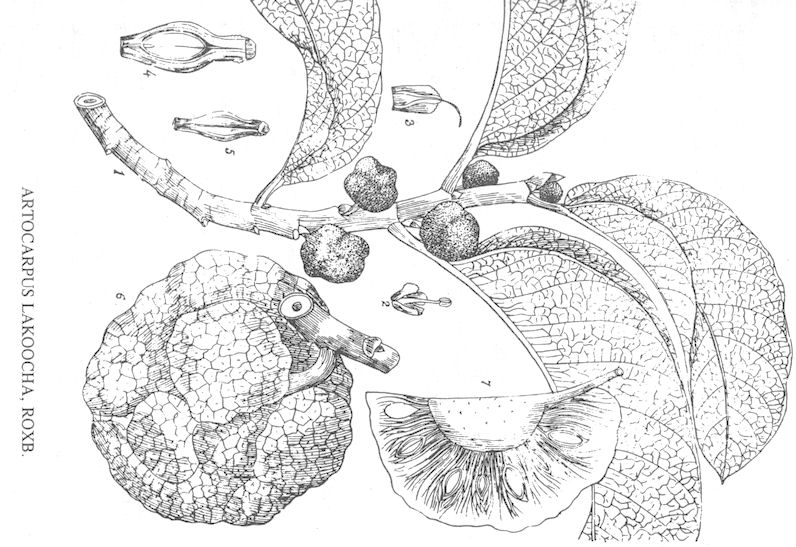
Abb.: लकुच्चः । Artocarpus lakoocha Roxb. - Monkey jack
[Bildquelle: Kirtikar-Basu, ©1918]
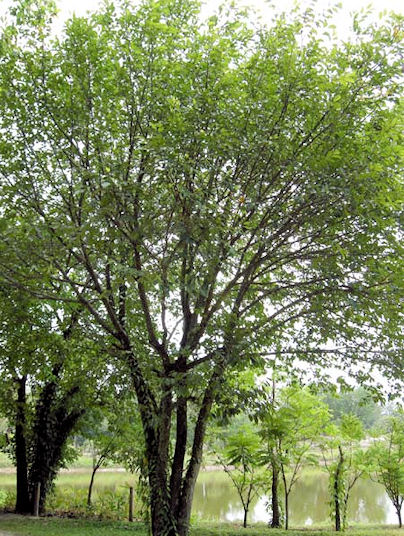
Abb.: लकुच्चः ।
Artocarpus lakoocha Roxb. - Monkey jack
[Bildquelle: iGarn / Wikimedia. -- Public domain]
"Artocarpus Lukoocha. Roxb. [...]
Sans. Lukoocha.
[...]
Found in the gardens in the vicinity of Calcutta, and is common all over Bengal. Leaves deciduous during: the cold season, appearing again with the flowers in March about the beginning of the hot season.
It is so far as 1 have seen, a tree of a middling size, with a short but thick trunk, and a very large spreading head.
[...]
The natives eat the fruit ; to an European the taste will generally be found disagreeable. The male spadix is acid, and astringent ; the natives eat them in their curries. The roots dye yellow. The whole tree and unripe fruit, like A. incisus, and integrifolia, contain much tenacious milky juice."
[Quelle: Roxburgh, William <1751-1815>: Flora indica, or, Descriptions of Indian plants / by the late William Roxburgh. -- Serampore : Printed for W. Thacker, 1832. -- Vol. 3, S. 524f.]
"The juice of Artocarpus Lakoocha, Roxb., or one or two of the seeds, is a popular purge in Bengal; the tree is the Dahu of Sanskrit writers."
[Quelle: Pharmacographia indica : a history of the principal drugs of vegetable origin met with in British India / by William Dymock [1834-1892], C. J. H. Warden and David Hooper [1858-1947]. -- Bd. 3. -- London, 1893. -- S. 355.]
Moraceae (Maulbeergewächse)
Bis 20 m hoher, immergrüner Baum.
| 41. c./d. panasaḥ kaṇṭakiphalo niculo hijjalo 'mbujaḥ
पनसः कण्टकिफलो निचुलो हिज्जलो ऽम्बुजः ॥४१ ख॥ [Bezeichnungen für Artocarpus heterophyllus Lam. 1789 - Jackfruchtbaum - Jackfruit Tree:]
|
Colebrooke (1807): "Bread fruit or Jaca tree. Artocarpus integrifolia [= Artocarpus heterophyllus Lam. 1789]."
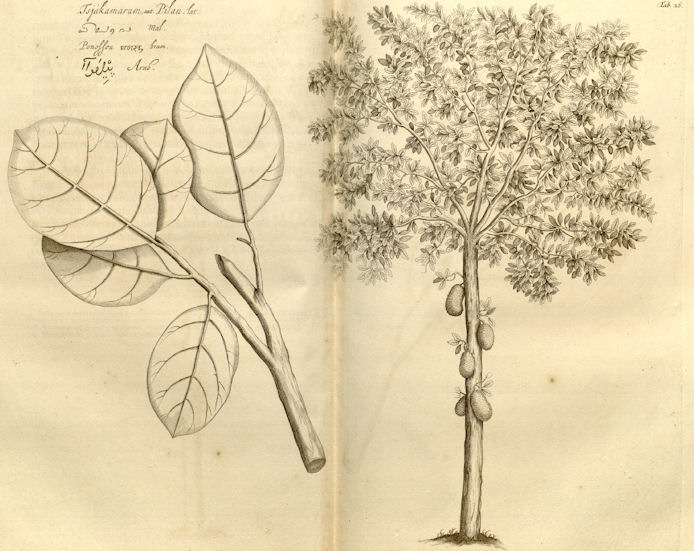
Abb.: कण्टकिफलः । Artocarpus heterophyllus Lam. 1789 -
Jackfruchtbaum - Jackfruit Tree
[Bildquelle: Hortus malabaricus III. Fig. 26, 1682]
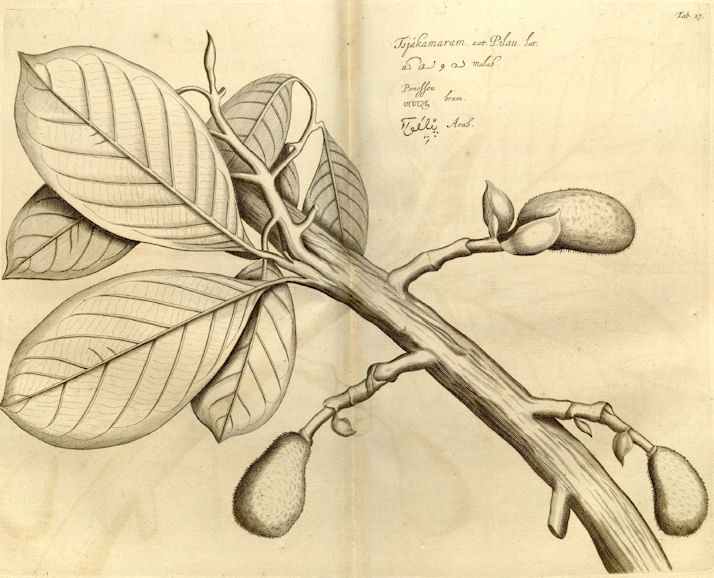
Abb.: कण्टकिफलः । Artocarpus heterophyllus Lam. 1789 -
Jackfruchtbaum - Jackfruit Tree
[Bildquelle: Hortus malabaricus III. Fig. 27, 1682]
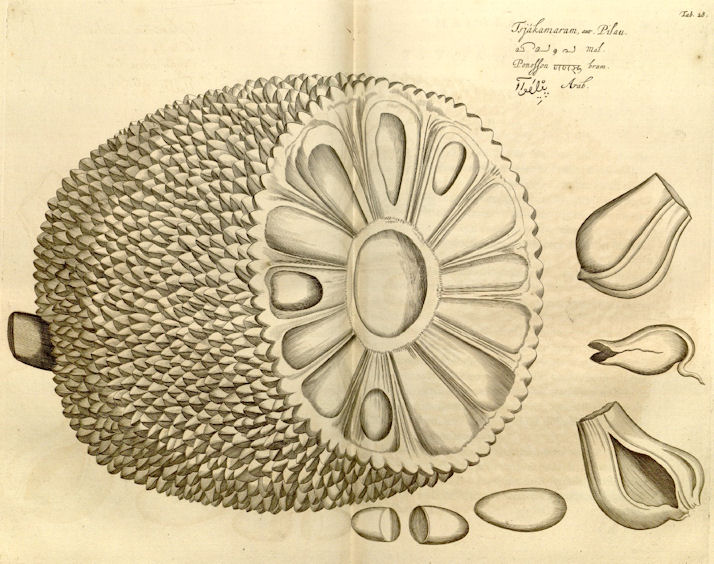
Abb.: कण्टकिफलः । Artocarpus heterophyllus Lam. 1789 -
Jackfruchtbaum - Jackfruit Tree
[Bildquelle: Hortus malabaricus III. Fig. 28, 1682]
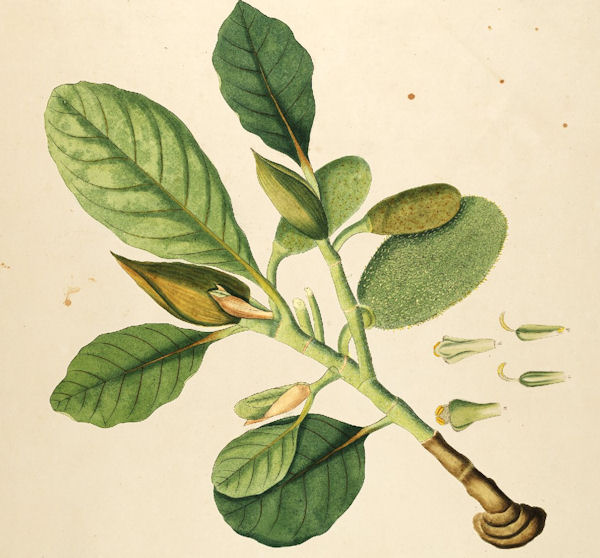
Abb.: कण्टकिफलः । Artocarpus heterophyllus Lam. 1789 -
Jackfruchtbaum - Jackfruit Tree (Roxburgh: Artocarpus integrifolia)
[Bildquelle: Roxburgh. -- Vol III. -- 1819. -- Image courtesy Missouri Botanical
Garden. http://www.botanicus.org. --
Creative Commons Lizenz
(Namensnennung, keine kommerzielle Nutzung)]
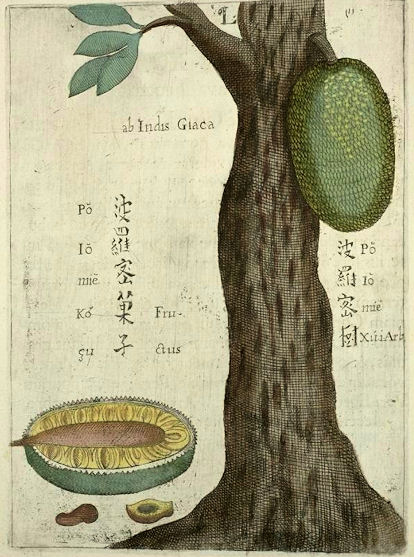
Abb.: कण्टकिफलः । Artocarpus heterophyllus Lam. 1789 -
Jackfruchtbaum - Jackfruit Tree
[Bildquelle: Michał Piotr Boym SJ (ca.
1612–1659): Flora sinensis, 1656. -- Public domain]
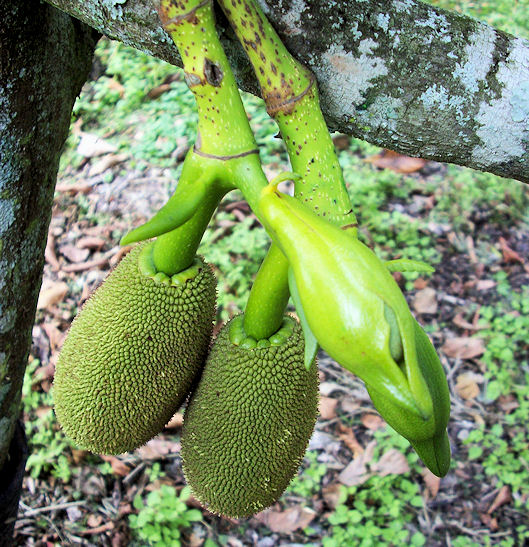
Abb.: पनसः । Blüten des Jackfruchtbaums - Artocarpus
heterophyllus Lam., links: weibliche Blüte, rechts männliche Blüte
[Bildquelle: I likE plants. --
http://www.flickr.com/photos/i_like_plants/3247854045/. -- Zugriff am
2010-10-02. --
Creative Commons Lizenz (Namensnennung)]
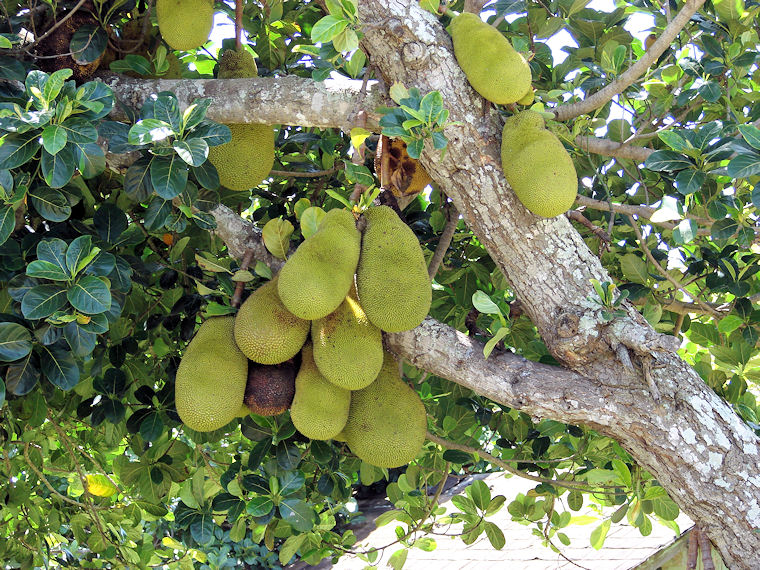
Abb.: कण्टकिफलः । Artocarpus heterophyllus Lam. 1789 -
Jackfruchtbaum - Jackfruit Tree, Hawaii
[Bildquelle: Forest & Kim Starr. --
http://www.hear.org/starr/images/image/?q=070403-6454&o=plants. -- Zugriff
am 2010-10-11. --
Creative Commons Lizenz (Namensnennung)]
"Artocarpus integrifolia. Willd. iv. 184. [...]
It is much cultivated throughout Southern India, and all the warmer parts of Asia ; where it is wild or originally from, I know not. On the coast of Coromandel, it does not in general attain to any great height, from thirty to forty feet may be reckoned a high tree, but with a very large, ramous, dense, shady head, particularly when it stands detached from other trees, and a short thick trunk, about twelve feet high ; flowering time the cold season, fruit ripe in four or five months afterwards.
[...]
For a more particular account of the fruit, see Gaertner on Seeds, vol. I .page 344. 346. tab. 71. and 72. all that is intended by this description, is to give a tolerable idea of the parts of fructification.
The fruit of this tree is so universally known, that it is unnecessary for me to say any thing respecting its excellence, as well as that the seeds, when roasted, are not inferior to the best chestnuts. In Ceylon, where the tree grows most plentifully, and where the fruit attains to its greatest size, the inhabitants make them a very considerable article of their diet.
The wood comes near to mahogany in appearance, and is much used for making- furniture, in Ceylon and some other
parts of India.
The Indians of those parts prepare their best bird-lime from the tenacious white juice, which abounds in all the uneatable parts of the fruit, and in the young tender parts of the tree. It flows freely from recent wounds."
[Quelle: Roxburgh, William <1751-1815>: Flora indica, or, Descriptions of Indian plants / by the late William Roxburgh. -- Serampore : Printed for W. Thacker, 1832. -- Vol. 3, S. 522ff.]
"Artocarpus integrifolius (Linn.) Indian Jack-tree
Description.--Large tree; [...]
Fl. Nov.-Dec.
Roxb. Flor. Ind. iii. 522.--Cor. iii. t. 250.--Rheede iii. t. 26-28.--Wight Icon. t. 678.
A. heterophylla, Lam.
Malabar. Peninsula. Bengal.
Economic Uses.—The timber of this tree, so well known as the Jack-wood, is much esteemed for making furniture of all kinds, for which it is well adapted. At first it is somewhat pale, but afterwards assumes a darker tinge approaching to mahogany, and when polished becomes one of the best fancy woods for tables, chairs, and frames. The root of the older trees is dark-coloured, and admirably adapted for picture-frames and carving-work of all kinds. Like others of the same family, the tree abounds in viscid, milky juice. The fruit, which grows to an enormous size, and hangs by a peduncle springing from the trunk, is a favourite article of food among the natives. There are several varieties, but what is called the honey- jack is by far the sweetest and best. The seeds when roasted are also much prized as a diet among the poorer classes. The leaves are given to goats and other cattle, and are said to be very fattening. In Travancore the Jack-tree is a monopoly, and yields an annual tax to the Sircar. The wood yields an abundant yellow dye, the sawdust being generally boiled for this purpose. The kernels contain a quantity of oil. The tree, if planted in stony soil, grows short and thick; if in sandy ground, tall and spreading ; and if the roots happen to come in contact with water, the tree will not bear fruit. Bird-lime is manufactured from the juice. The word Jack is a corruption from the Sanscrit word " Tchackka," which means the fruit of the tree. The situation of the fruit varies with the age of the tree, being first borne on the branches, then on the trunk, and in very old trees on the roots. In Travancore the mode of propagation is as follows : The natives put the whole fruit in the ground, and when the seeds germinate and grow up they tie the stems together with straw, and by degrees they form one stem, which will bear fruit in six or seven years.—(Roxb.) The other species worthy of mention are the A. Chaplasha, a native of Chittagong and the forests east of Bengal. It grows to be an immense tree, and canoes for river use are made from the trunk. The timber is also useful for other purposes, especially when required for anything under water. The A. lakoocha is a native of Bengal. The roots are used for dyeing yellow. The male spadix is acid and astringent, and is eaten by the natives in their curries.—(Roxb. J. Grah.) The A. Echinata is a large tree, growing on the Neilgherries, and yielding a good timber, but hitherto little known."
[Quelle: Drury, Heber <1819 - 1872>: The useful plants of India : with notices of their chief value in commerce, medicine, and the arts. -- 2d ed. with additions and corrections. London : Allen, 1873. -- xvi, 512 p. ; 22 cm. -- s.v.]
"The juice of Artocarpus integrifolia, the well-known Jack tree, in Sanskrit Panasa, heated over the fire, is a popular cement for joining broken China and stoneware. The deposit from the milky juice is insoluble in water, partly soluble in alcohol, and entirely so in benzol. It is a variety of caoutchoue, and in the natural state can be used as a birdlime, or as a cement for broken articles; after being washed in boiling water it becomes harder, and may be used for all the ordinary purposes of India-rubber. The yellow dye which is obtained from the wood is of a resinous nature, and may be extracted by boiling water or alcohol." [Quelle: Pharmacographia indica : a history of the principal drugs of vegetable origin met with in British India / by William Dymock [1834-1892], C. J. H. Warden and David Hooper [1858-1947]. -- Bd. 3. -- London, 1893. -- S. 355.]
Lecythidaceae (Topffruchtgewächse)
Bis 8 m hoher, immergrüner Baum.
| 41. c./d. panasaḥ kaṇṭakiphalo niculo hijjalo 'mbujaḥ
पनसः कण्टकिफलो निचुलो हिज्जलो ऽम्बुजः ॥४१ ख॥ [Bezeichnungen für Barringtonia acutangula (L.) Gaertn.:]
|
Colebrooke (1807): "Hijjal. Eugenia acutangula [= Barringtonia acutangula (L.) Gaertn.]."
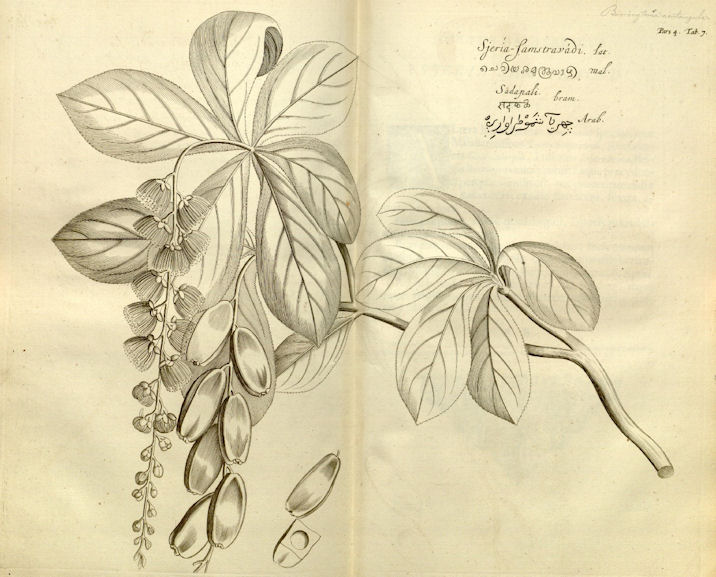
Abb.: हिज्जलः । Barringtonia acutangula (L.) Gaertn.
[Bildquelle: Hortus malabaricus IV. Fig. 7, 1683]
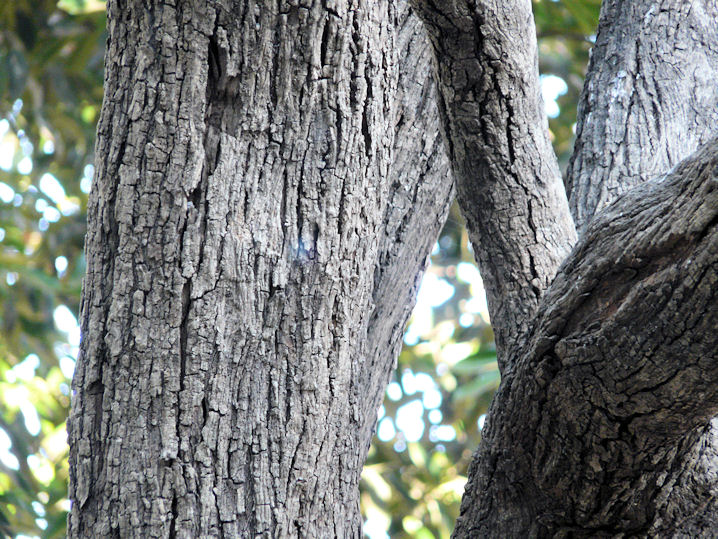
Abb.: हिज्जलः । Barringtonia acutangula (L.) Gaertn.
[Bildquelle: dinesh_valke. --
http://www.flickr.com/photos/dinesh_valke/2208823659/. -- Zugriff am
2010-10-13. --
Creative
Commons Lizenz (Namensnennung, keine kommerzielle Nutzung, keine
Bearbeitung)]
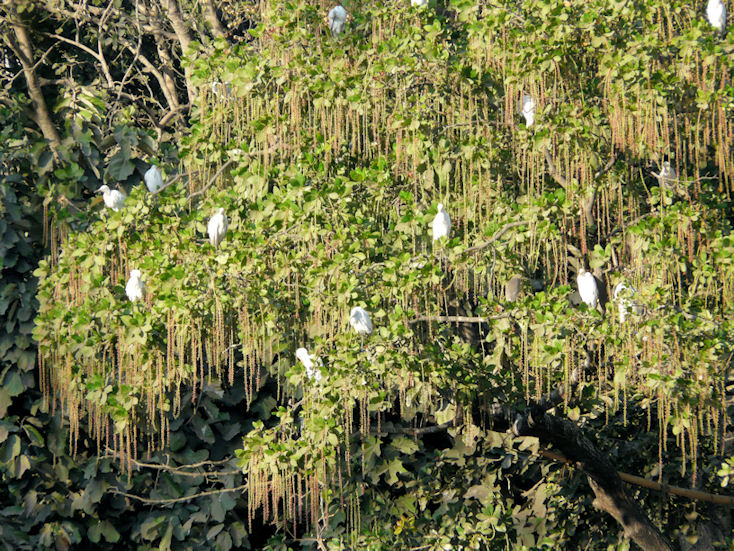
Abb.: अम्बुजः । Barringtonia acutangula (L.) Gaertn.,
Maharashtra
[Bildquelle: dinesh_valke. --
http://www.flickr.com/photos/dinesh_valke/2209691022/. -- Zugriff am
2010-10-26. --
Creative
Commons Lizenz (Namensnennung, keine kommerzielle Nutzung, keine
Bearbeitung)]
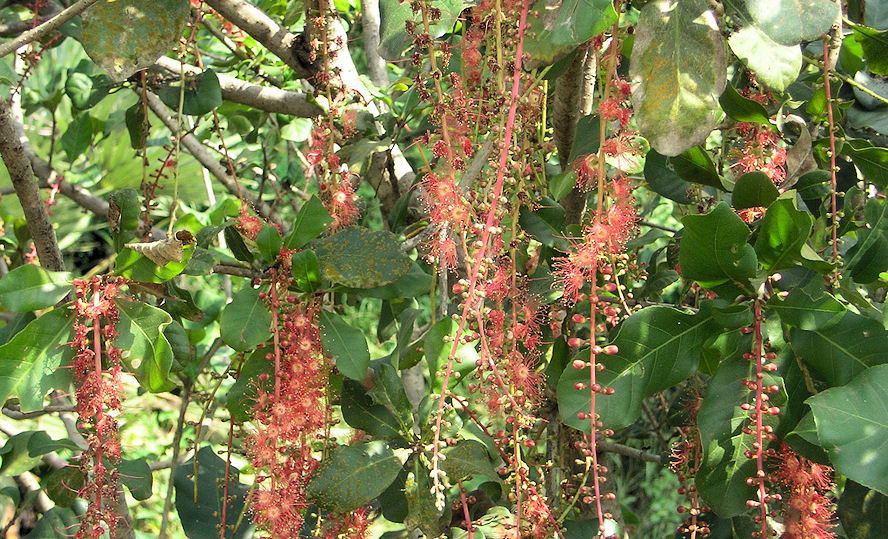
Abb.: हिज्जलः । Barringtonia acutangula (L.) Gaertn.
[Bildquelle: Lalithamba. --
http://www.flickr.com/photos/45835639@N04/5020725612/. -- Zugriff am
2010-10-13. -- Creative
Commons Lizenz (Namensnennung)]
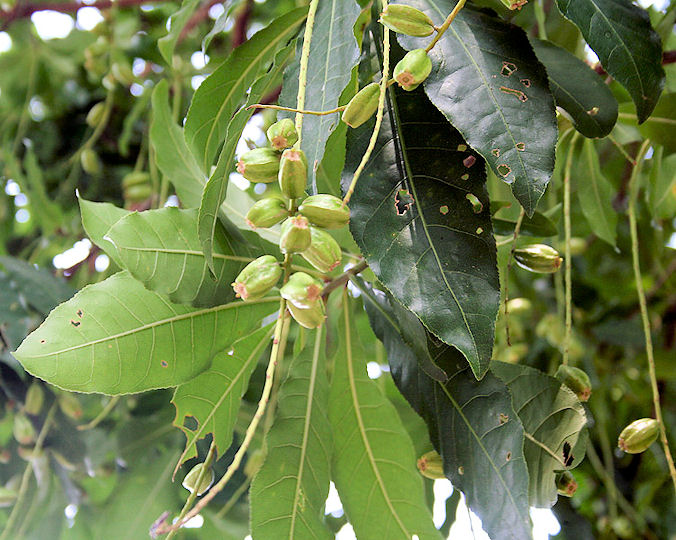
Abb.: हिज्जलः । Barringtonia acutangula (L.) Gaertn.,
Kolkata -
কলকাতা,
West Bengal
[Bildquelle: J. M. Garg / Wikipedia. -- GNU FDLicense]
"Barringtonia acutangula. R.
[...]
Eugenia acutangula. Linn. sp. pi. ed. Willd. 2. 966.
Stravidium. Juss. gen. pi. 361.
Ijul, the Sanscrit name.
[...]
This species is common in most parts of India ; it grows to be a large handsome tree, in appearance it is more like a regular, well-shaped, middle-sized Oak, than any other tree I have ever met with. It flowers about the beginning of the wet season. Its long pendulous racemes, of scarlet-coloured flowers give it at that time a most elegant appearance. Bark dark-coloured, scabrous, tough and thick."
[Quelle: Roxburgh, William <1751-1815>: Flora indica, or, Descriptions of Indian plants / by the late William Roxburgh. -- Serampore : Printed for W. Thacker, 1832. -- Vol. 2, S. 635f.]
"Barringtonia acutangula (Gaertn) N. O. Myrtaceae. Description.--Tree; [...]
Fl. April-May.
W. & A. Prod. i. 333.--Rheede iv. t. 7.--Roxb. Fl. Ind. ii. 635.
Eugenia acutangula, Linn. sp.
Bengal. Peninsula. Travancore.
Medical Uses.—The root is bitter, and said to be similar to Cinchona, but also cooling and aperient. The seeds are very warm and dry, and are used as an aromatic in colic and parturition.— Powell's Punj. Prod.
Economic Uses.—The wood is hard and of a fine grain, red, and equivalent to mahogany.—(M'Clelland.) It is suited for ordinary work."
[Quelle: Drury, Heber <1819 - 1872>: The useful plants of India : with notices of their chief value in commerce, medicine, and the arts. -- 2d ed. with additions and corrections. London : Allen, 1873. -- xvi, 512 p. ; 22 cm. -- s.v.]
"Barringtonia acutangula, Gaertn. [...]
This is an evergreen tree of moderate size, called by Sanskrit writers Hijja or Hijjala. The fruit is spoken of as Samudra-phala and Dhātriphala or "nurse's fruit," and is one of the best known domestic remedies. When children suffer from a cold in the chest, the seed is rubbed down on a stone with water and applied over the sternum, and if there is much dyspnoea a few grains with or without the juice of fresh ginger are administered internally and seldom fail to induce vomiting and the expulsion of mucus from the air passages. To reduce the enlarged abdomen of children it is given in doses of from 2 to 3 grains in milk. Rumphius states that the roots are used to kill fish, and this use of the bark is known in most parts of India. The fish are said to be not unwholesome.
Barringtonia racemosa has similar properties, the bark, root and seed being bitter. Ainslie states that in Java and in Ternate the seeds are used for intoxicating fish. The powdered seeds of these plants induce sneezing."
[Quelle: Pharmacographia indica : a history of the principal drugs of vegetable origin met with in British India / by William Dymock [1834-1892], C. J. H. Warden and David Hooper [1858-1947]. -- Bd. 2. -- London, 1891. -- S. 17f.]
Moraceae (Maulbeergewächse)
Strauch oder kleiner Baum.
| 42. a./b. kākodumbarikā phalgur malayūr jaghahalā काकोदुम्बरिका फल्गुर् मलयूर् जघनेफला ।४२ क। [Bezeichnungen für Ficus hispida L. f. 1782 - Flussfeige - River Fig:]
|
Colebrooke (1807): "Opposite leaved fig-tree. Ficus oppositifolia, R[oxb] [=Ficus hispida L. f.]."
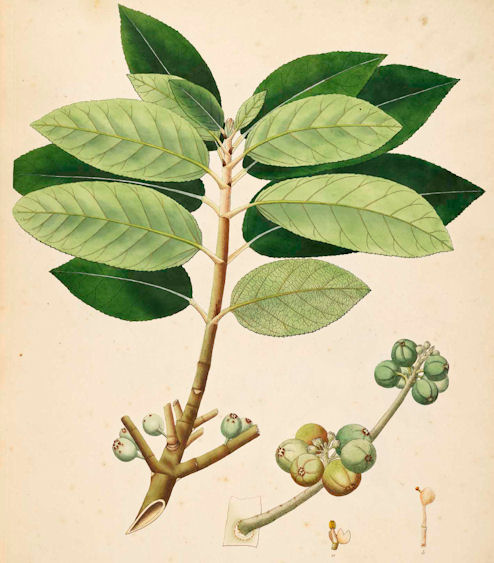
Abb.: काकोदुम्बरिका । Ficus hispida L. f. - Flussfeige - River Fig
[Bildquelle: Roxburgh. -- Vol II. -- 1795. -- Image courtesy Missouri Botanical
Garden. http://www.botanicus.org. --
Creative Commons Lizenz
(Namensnennung, keine kommerzielle Nutzung) (Roxb. = Ficus oppositifolia)]
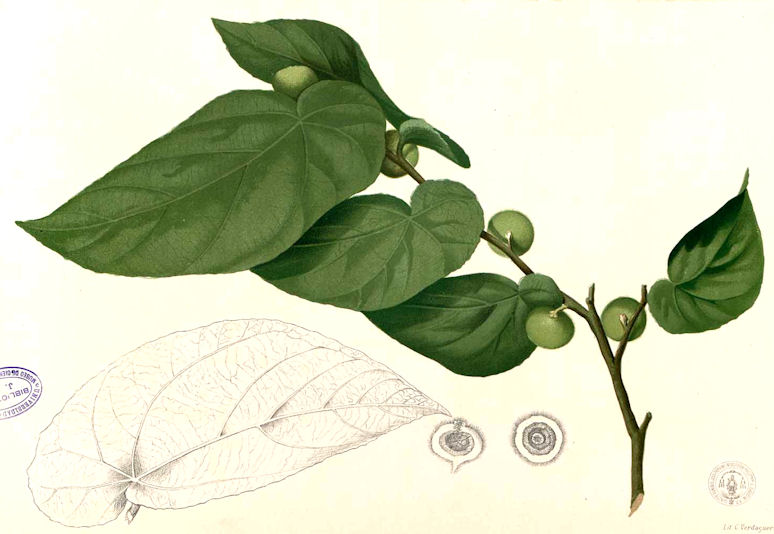
Abb.: मलयूः । Ficus hispida L. f. - Flussfeige - River Fig
[Bildquelle: Flora de Filipinas, 1880 / Wikipedia. -- Public domain]
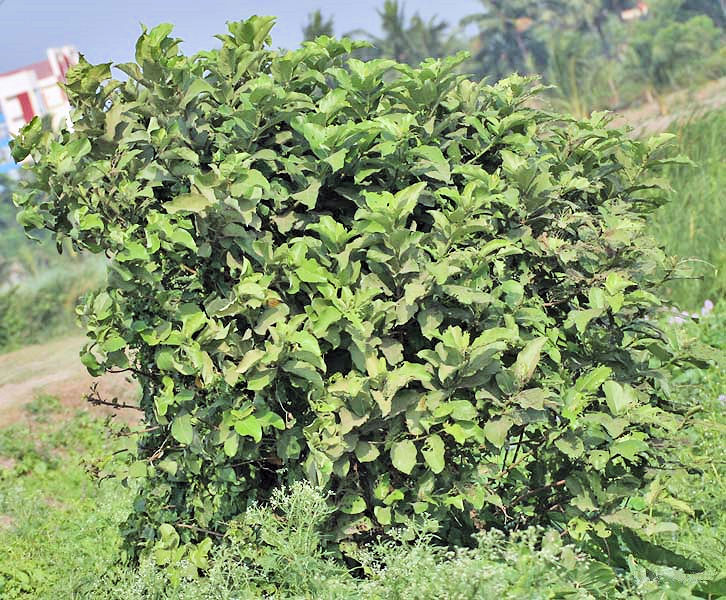
Abb.: काकोदुम्बरिका । Ficus hispida L. f. - Flussfeige - River Fig,
Kolkata - কলকাতা, West
Bengal
[Bildquelle: J. M. Garg / Wikipedia.
-- GNU FDLicense]
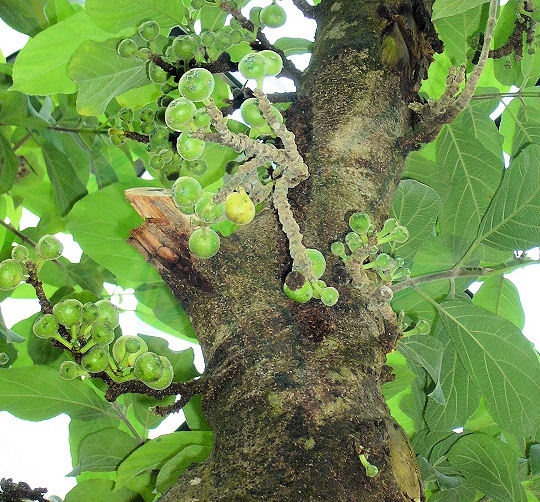
Abb.: जघनेफला । Ficus hispida L. f. - Flussfeige - River Fig
[Bildquelle: Netrider1964 / Wikimedia. --
Public domain]
"Ficus oppositifolia. Willd. iv. 1151. Corom. pl. ii. N. 124.
[...]
Sans. Kako-Doomburiku,
[...]
A small tree, a native of the banks of rivulets, and other places, where the soil is moist and rich, common about Calcutta.
[...]
This species is productive of much tenacious milky juice on being wounded. The fruit is not often eaten, nor is the tree used for any purpose that I know of."
[Quelle: Roxburgh, William <1751-1815>: Flora indica, or, Descriptions of Indian plants / by the late William Roxburgh. -- Serampore : Printed for W. Thacker, 1832. -- Vol. 3, S. 561f.]
"Ficus oppositifolia (Willd.) Description.--Small tree; [...]
Roxb. Flor. Ind. iii. 561.--Cor. t. 124.--Wight Icon. t. 638,
Covellia oppositifolia, Gaspar.
Banks of rivulets in Peninsula and Bengal.
Medical Uses.—The fruit, seeds, and bark are possessed of valuable emetic properties. The best form of administration appears to be the seed of the ripe fruit, dried and preserved from moisture in stoppered bottles. The bark is also a good anti-periodic and tonic. The F. polycarpa possesses the same medicinal properties.—Pharrn. of India."
[Quelle: Drury, Heber <1819 - 1872>: The useful plants of India : with notices of their chief value in commerce, medicine, and the arts. -- 2d ed. with additions and corrections. London : Allen, 1873. -- xvi, 512 p. ; 22 cm. -- s.v.]
"Ficus hispida, Linn. Wight Ion. tt. 638, 641, the F. daemonum Koenig, is the Kakodumbara or Kakodumbarika, "crows' fig," of Sanskrit writers, and is stated in Mandapal's Nighanta to have the same properties as F. glomerata. It is the Kat-gular of Hindustan, the Kako-dumar of Bengal, the Bokhera or Dhed-umbar of Bombay, and the Pe-attis of Madras. Rheede says that the fruit boiled in goat's milk is used in hepatic obstruction; it has been brought to notice by Mr. M. Sheriff on account of its emetic properties. The shrub has opposite, cuneate, oblong leaves, which are scabrous above and downy beneath. The fruit is like a small fig and very downy; it usually grows from the stem near or beneath the ground; an interesting description of it by Dr. G. King forms one of the series of Scientific Mewmoirs by Medical Officers of the Army of India, published at the Government Printing Press, Calcutta. In Bombay and the Concan the powdered fruit heated with a little water is made into a lep, or poultice, which is applied to buboes, which it either disperses or brings rapidly to maturity. The fruit is also given to milch-cattle to dry up their milk.
The emetic properties of the plant are due to the presence of saponin."
[Quelle: Pharmacographia indica : a history of the principal drugs of vegetable origin met with in British India / by William Dymock [1834-1892], C. J. H. Warden and David Hooper [1858-1947]. -- Bd. 3. -- London, 1893. -- S. 346f.]
Meliaceae (Mahagonigewächse)
Bis 12 m hoher, laubabwerfender Baum.
| 42. c./d. ariṣṭaḥ sarvatobhadra-hiṅguniryāsa-mālakāḥ 43. a./b. picumandaś ca nimbe 'tha picchilāguru śiṃśapā
अरिष्टः सर्वतोभद्र-हिङ्गुनिर्यास-मालकाः ॥४२ ख॥ Bezeichnungen für निम्ब - nimba m.: Nimba, Melia azedarach L. 1753 - Indischer Zederachbaum - Bead Tree:
|
Colebrooke (1807): "Nimb. Nimba azadaracta or Melia azadirachta."
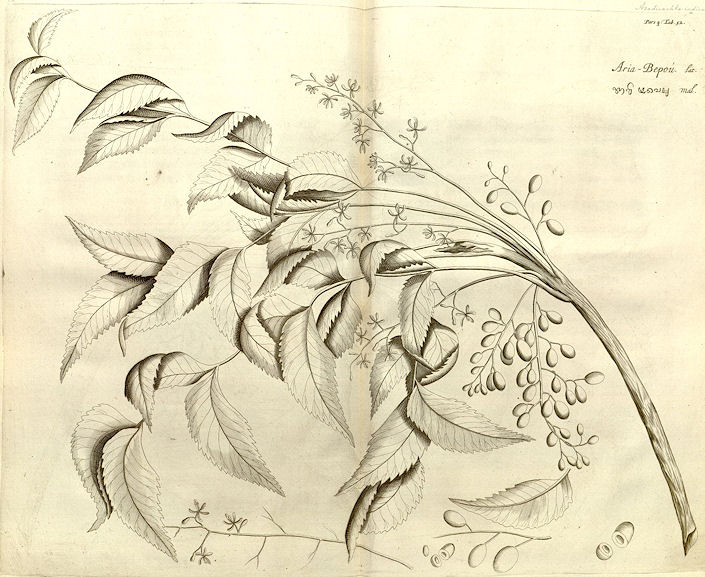
Abb.: Melia azadirachta L. -
Indian Lilac
[Bildquelle: Hortus malabaricus IV. Fig. 52, 1683]
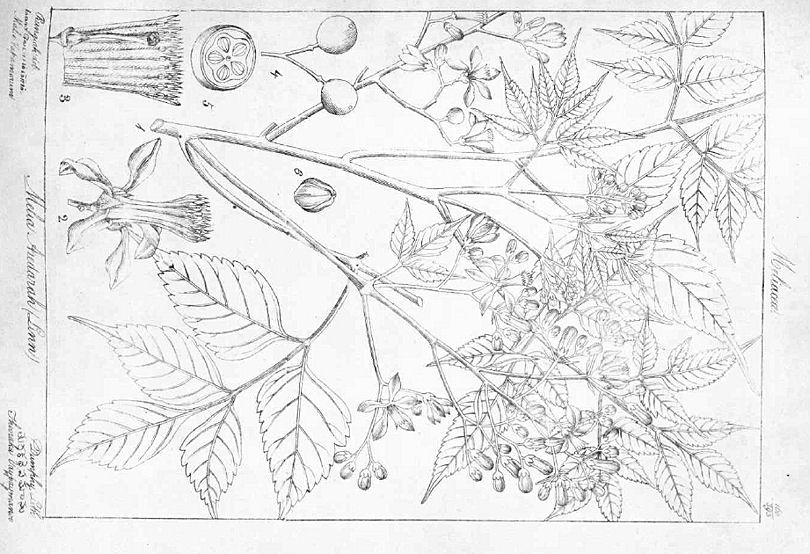
Abb.: निम्बः । Melia azedarach L. 1753 -
Indischer Zederachbaum - Bead Tree
[Wight Icones I, Tab. 160, 1840]
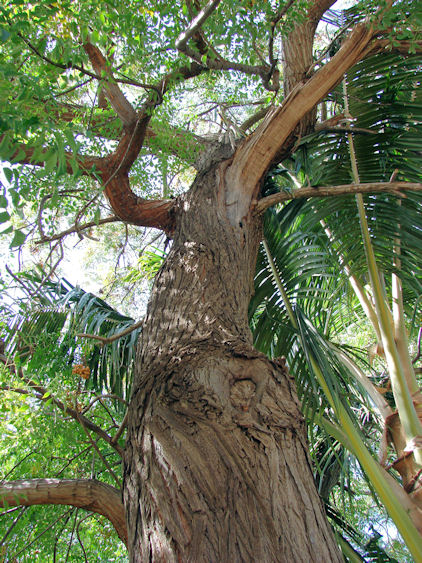
Abb.: निम्बः । Melia azedarach L. 1753 -
Indischer Zederachbaum - Bead Tree, Hawaii
[Bildquelle: Forest Starr & Kim Starr. --
http://www.hear.org/starr/images/image/?q=070302-4985&o=plants. -- Zugriff
am 2010-10-12. --
Creative Commons Lizenz (Namensnennung)]
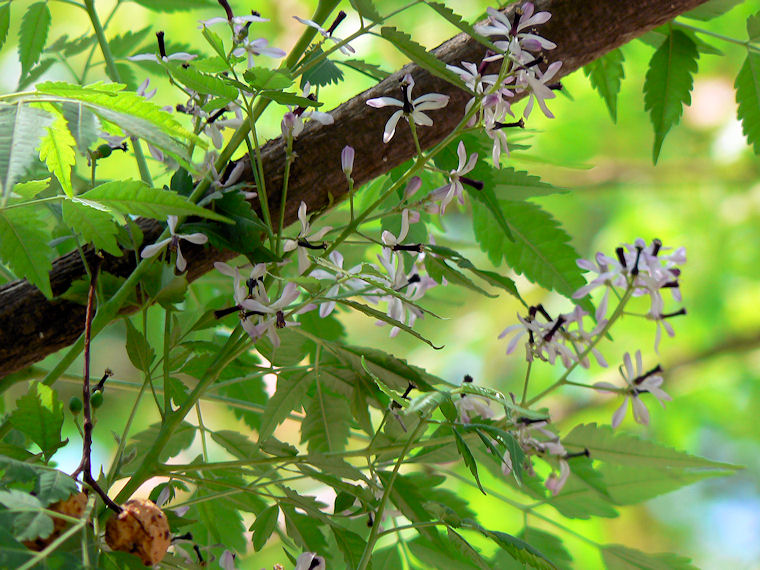
Abb.: निम्बः । Melia azedarach L. 1753 -
Indischer Zederachbaum - Bead Tree, Mumbai -
मुंबई,
Maharashtra
[Bildquelle: dinesh_valke. --
http://www.flickr.com/photos/dinesh_valke/429546268/. -- Zugriff am
2010-10-13. --
Creative
Commons Lizenz (Namensnennung, keine kommerzielle Nutzung, keine
Bearbeitung)]
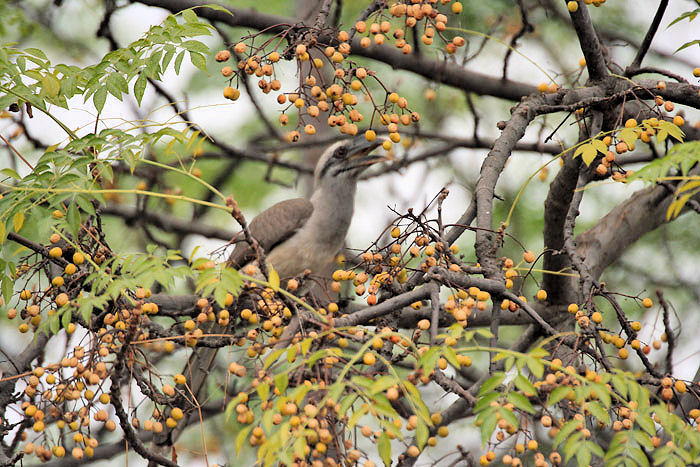
Abb.: सर्वतोभद्रः । Indian Grey Hornbill (Ocyceros
birostris) auf Melia azedarach L. 1753 -
Indischer Zederachbaum - Bead Tree, Roorkee -
रुड़की, Uttarakhand
[Bildquelle: J. M. Garg / Wikipedia. -- GNU FDLicense]
"Melia azadiracta. Willd. 2. 559. [...]
Sans. Nimba.
[...]
A middling sized, very common, beautiful, and very useful tree. Flowering time the hot season. It differs flora all the other species known to me in having a one-celled, one-seeded nut, though the germ has uniformly five-cells, with one or two ovula in each."
[Quelle: Roxburgh, William <1751-1815>: Flora indica, or, Descriptions of Indian plants / by the late William Roxburgh. -- Serampore : Printed for W. Thacker, 1832. -- Vol. 2, S. 394]
"Melia azederach (Linn.) N. O. Meliaceae. Common Bead-tree or Persian Liliac.
Description.--Tree, 40 feet; [...]
Fl. March.
W. & A. Prod. i. 117.--Wight Icon. t. 160.
Common in the Deccan. Concans. N. India.
Medical Uses.—The pulp surrounding the seeds is said to he poisonous, and, mixed with grease, is reputed to kill dogs. This, however, is doubtful The root, which is nauseous and bitter, is used in North America as an anthelmintic. A valuable oil is procured from them.—(Ainslie. Lindley.) Melia azederach has been considered poisonous from the time of Avicenna; but it is only in larger doses that its fruit can be considered as such. Loureiro recognises the utility of azedarach in worm cases, and Blume states that both it and M. azadirachta are employed in Java as anthelmintics. A decoction of the leaves is said to be astringent and stomachic, and also to be injurious to insects, and employed with success against porrigo.—Royle.
Economic Uses.—The mature wood is hard and handsomely marked, and might be used for many economical purposes. The tree has been naturalised in the south of Europe.—Jury Rep. Mad. Exhib."
[Quelle: Drury, Heber <1819 - 1872>: The useful plants of India : with notices of their chief value in commerce, medicine, and the arts. -- 2d ed. with additions and corrections. London : Allen, 1873. -- xvi, 512 p. ; 22 cm. -- s.v.]
"MELIA AZADIRACHTA, Linn. Indian Lilac
[...]
History, Uses, &c.--This tree, in Sanskrit Nimba and Arishta, is a native of India, and is cultivated in all parts of the country on account of its medicinal properties. The leaves, bark and other products of the Neem have been articles of the Hindu Materia Medica from a very remote period, and are mentioned in the Ayurveda of Suśruta. The bark is considered to be bitter, tonic, and astringent. The leaves are added to poultices to disperse glandular tumours, and are used generally as a discutient; beaten into a pulp they are applied to pustular eruptions, more especially to the eruption of small-pox; their juice is anthelmintic, and is given in a variety of diseases, such as jaundice, prurigo, boils, &c. Chakradatta recommends a poultice of the leaves mixed with Sesamum seeds for unhealthy ulcerations. The fruit is described as purgative, emollient, and anthelmintic. The oil of the seeds is applied to suppurating scrofulous glands, is given in leprosy, rheumatism, and a variety of diseases. It is vermifuge, and is a remedy for mange in dogs. It has been used in the manufacture of soap. As the oil contains a marked amount of sulphur, neem oil soap might possibly be useful in cutaneous affections in which a mild sulphuretted application is indicated. The beneficial effects of the oil when rubbed into the skin in rheumatism is doubtless due to the presence of organically combined sulphur. The gum is said to have stimulant properties. The young trees tapped yield a saccharine juice, which when fermented is used as a stomachic; several observers have noticed that in certain years this juice appears to flow with unusual abundance.
The dried flowers are used as a tonic after fever, and under the name of Pancha-nimba, a medicine is prepared which contains the flowers, fruit, leaves, bark, and root of the tree, of each 15 parts, and one part each of a number of other drugs. The nimba is also one of the Pancha-tikta or five bitters. The air waved with a Neem branch is supposed to be a cure for syphilis. The insane are passed through a cleft of the tree, or a stem which having parted and re-united forms a circular opening. Buchanan, in his "Journey through Mysore," relates that- "Once in two or three years the Coramās of a village make a collection among themselves, and purchase a brass pot, in which they put five branches of Melia Azadirachta and a cocoanut. This is covered with flowers and sprinkled with sandalwood water. It is kept in a small temporary shed for three days, during which time the people feast and drink, sacrificing lambs and fowls to Marima, the daughter of Siva; at the end of the three days they the pot into the water." This practice is known in other parts of India as 'ghaṭasthāpana' (Ghatasthapan), and is considered to avert ill luck and disease. Amongst certain castes the leaves of the Neem are placed in the mouth on their return from funerals as an emblem of grief. Five to eight leaves are eaten by all Hindus on the first day of the New Year, and are supposed to ensure freedom from disease; when amrita (ambrosia) was being conveyed to heaven from the lower world for the use of the gods, it is believed that a few drops if it fell on this tree. For an account of the mythology of amrita, see De Gubernatis, Myth. des Plantes I., p. 32.
This useful tree naturally attracted the attention of the Mahometans upon their arrival in the country, and they named it Azaddarakht-i-Hindi, from its resemblance to the Melia Azadarach or Persian Lilac. The author of the Makhzan-el-Adwiya is careful to point out that the Indian Neem is not found in Persia. He describes the Neem and Azaddarakht separately, giving Bakayan as the Indian name for the latter. The Mahometans use the different products of the Neem in the same manner as the Hindus, and like them consider it to be cold and dry. Amongst European physicians, Wight says, "The leaves beaten to a pulp, and externally applied, act like a charm in removing the most intractable forms of psora and other pustular eruptions." Dr. White, of Bombay, has recommended the bark as a febrifuge; others have spoken favourably of the leaves as a local application t oulcers and certain obstinate skin diseases. Dr. Hove (1787) thus speaks of the Neem tree: -"The Gentoos here worship this tree, and their barren women invoke and perform the same ceremonies round it every morning as they usually do in the other Pergunnahs about the Ficus religiosa. The leaves are of a powerful bitter, and they use a strong decoction with great success in intermittents, and which I usually drank for my liver complaint and found myself much relieved by it." He also notices the use of the gum by lying-in women. (Hov‚, account of Mitampoor.) From recent experience detailed in the Pharmacopoeia of India, it would appear that the opinion of the natives of India regarding the medicinal properties of the different parts of this tree is substantially correct. The bark is now official in the abovementioned Pharamacopoeia.
[Quelle: Pharmacographia indica : a history of the principal drugs of vegetable origin met with in British India / by William Dymock [1834-1892], C. J. H. Warden and David Hooper [1858-1947]. -- Bd. 1. -- London, 1890. -- S. 322ff.]
Melia Azedarach, Linn.
Persian Liliac,
[...]
History, Uses, &c.--The Persian Lilac was probably introduced into the southern parts of India by the Mahometans. Haji Zein says that in Tabristan it is called Takhak, and in Shiraz Taghak, both corruptions of Tāk, its proper Persian name. It is native of the sub-Himalayan tracts, and is called in Sanskrit Mahanīmba and Himadruma. The Hindus do not appear to have paid much attention to it, but it has been described by Ibn Sina in his second book under the name of Azaddarakht, and has long been used by the Arabs and Persians, who consider it to be hot and dry, and to have deobstruent, resolvent, and alexipharmic properties. The flowers and leaves are applied as a poultice to relieve nervous headache. The juice of the leaves administered internally is said to be anthelmintic, antilithic, diuretic, and emmenagogue, and is thought to resolve cold swellings, and expel the humours which give rise to them. The bark and leaves are used internally and externally in leprosy and scrofula. A poultice of the flowers is said to kill lice and cure eruptions of the scalp. The fruit has poisonous properties, but nevertheless is prescribed in leprosy and scrofula, and is worn as a necklace to avert contagious diseases. In China it is used as a vermifuge.
Loureiro states that the Chinese boil the berries in wine and then make a decoction of them, which has no injurious effects. The leaves and bark they use in itch and other skin diseases.
The root-bark of M. azedarach is placed in the secondary list of the United States Pharmacopoeia as an anthelmintic. It has a bitter, nauseous taste, and yields its virtues to boiling water. It is administered in the form of decoction (4 ozs. of the fresh bark to 2 pints of water, boiled to one pint), of which the dose for a child is a tablespoonful every third hour until it sensibly affects the bowels or stomach, or a dose may be given morning and evening for several days and then be followed by a cathartic."
[Quelle: Pharmacographia indica : a history of the principal drugs of vegetable origin met with in British India / by William Dymock [1834-1892], C. J. H. Warden and David Hooper [1858-1947]. -- Bd. 1. -- London, 1890. -- S. 330f.]
Fabaceae (Hülsenfrüchtler)
Bis 25 m hoher, laubabwerfender Baum.
| 43. a./b. picumandaśca nimbe 'tha picchilāguruśiṃśapā 43 c./d. kapilā bhasmagarbhā sā śirīṣas tu kapītanaḥ
पिचुमन्दश् च निम्बे
ऽथ
पिच्छिलागुरुशिंशपा ।४३ क। [Bezeichnungen für Dalbergia sissoo Roxb. ex DC. 1825 - Ostindisches Rosenholz - Rosewood Tree:]
|
Colebrooke (1807): "Siso. Dalbergia sissoo." [43c:] "Another sort. Some make these terms synonymous with the preceeding."
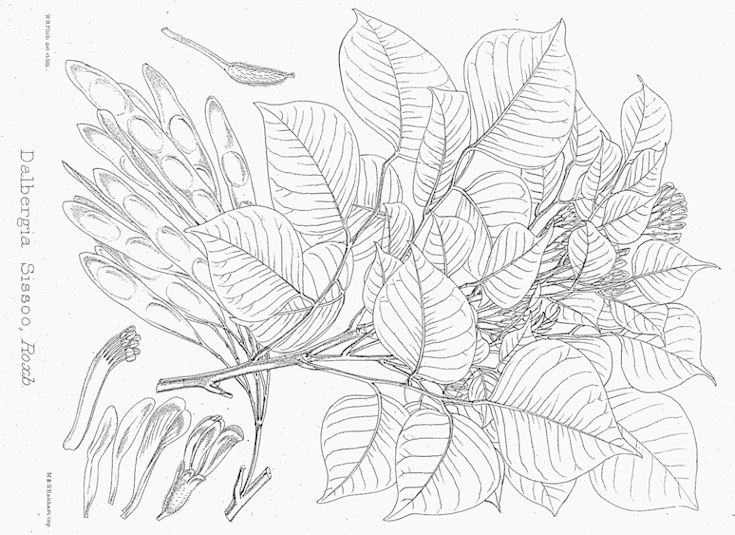
Abb.:
अगुरुशिंशपा । Dalbergia sissoo Roxb. ex DC. 1825 - Ostindisches Rosenholz - Rosewood Tree
[Bildquelle: Brandis 1874 / Wikipedia.
-- Public domain]
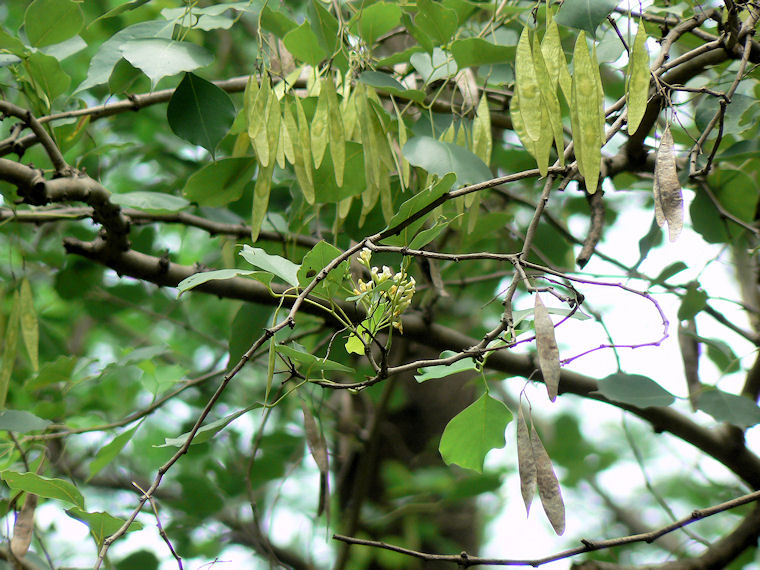
Abb.: पिच्छिला । Dalbergia sissoo Roxb. ex DC. 1825 - Ostindisches Rosenholz - Rosewood Tree, Sanjay Gandhi National Park - संजय गांधी राष्ट्रीय उद्यान, Maharashtra
[Bildquelle: dinesh_valke. --
http://www.flickr.com/photos/dinesh_valke/588615299/. -- Zugriff am
2010-10-13. --
Creative
Commons Lizenz (Namensnennung, keine kommerzielle Nutzung, keine
Bearbeitung)]
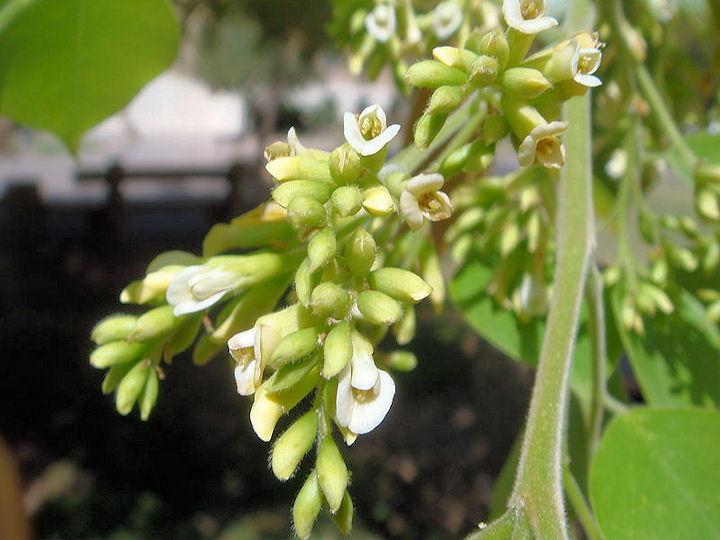
Abb.: अगुरुशिंशपा । Dalbergia sissoo Roxb. ex DC. 1825 - Ostindisches Rosenholz - Rosewood Tree,
Arizona
[Bildquelle:
Miwasatoshi
/ Wikimedia. -- GNU FDLicense]
"Dalbergia Sissoo. Roxb. [...]
Sans. Shingshupa.
Hind, and Beng. Sissoo.
A native of Bengal, and of the adjoining provinces to the northward, Flowering time the beginning of the hot season; the seed ripens about the close of the year.
[...]
This tree yields the Bengal ship-builders their crooked timbers and knees. It is tolerably light, remarkably strong, but unfortunately not so durable as could be wished. It answers well for various other economical purposes ; the colour, a light greyish brown, with darker coloured veins. Upon the whole I scarcely know any other tree that deserves more attention. for when its rapid growth in almost every soil, its beauty, and uses are taken into the account, few trees can be compared with it."
[Quelle: Roxburgh, William <1751-1815>: Flora indica, or, Descriptions of Indian plants / by the late William Roxburgh. -- Serampore : Printed for W. Thacker, 1832. -- Vol. 3, S. 223f.]
"Dalbergia sissoo (Roxb.) Description.--Tree, 50 feet; [...]
Fl. April-July.
W. & a. Prod. i. 264.--Roxb. Fl.Ind. iii. 223.
Coromandel. Guzerat. Bengal.
Economic Uses.—The timber is light and remarkably strong, of a light grayish-brown colour. It is good for ordinary economical purposes. It is much used in Bengal for knees and crooked timber in ship-building, as well as for gun-carriages and mail-carts. Its great durability combines to render it one of the most valuable timbers known. There are few trees which so much deserve attention, considering its rapid growth, beauty, and usefulness. It grows rapidly, is propagated and reared with facility, and early attains a good working condition of timber. Plantations have been recommended along the channels of the northern Annicuts.—(Roxb. Jury Rep. Mad. Exhib.) It attains its full size in fifty years. It is said to be proof against the attacks of white ants. The timber is very good for gun-carriages, and in some parts is largely used in dockyards. Also for saddles, boxes, and all furniture. A boat built from it is said to last twenty years. The raspings of the wood are said to be officinal, being considered alterative.—(Stewart's Punj. Plants.) Another species of Dalbergia yielding timber is the D. sissoides.— Roxb."
[Quelle: Drury, Heber <1819 - 1872>: The useful plants of India : with notices of their chief value in commerce, medicine, and the arts. -- 2d ed. with additions and corrections. London : Allen, 1873. -- xvi, 512 p. ; 22 cm. -- s.v.]
Mimosaceae (Mimosengewächse)
Bis 30 m hoher Baum.
| 43 c./d. kapilā bhasmagarbhā sā śirīṣas tu kapītanaḥ 44. a./b. bhaṇḍilo 'py atha cāmpeyaś campako hemapuṣpakaḥ
कपिला भस्मगर्भा सा
शिरीषस् तु कपीतनः ॥४३ ख॥ [Bezeichnungen für Albizia lebbeck (L.) Benth. 1844 - Lebbekbaum - Siris Tree:]
|
Colebrooke (1807): "Siris. Mimosa seereessa (sirisha). R[oxb]."
Albizia lebbeck (L.) Benth. 1844 - Lebbekbaum - Siris Tree
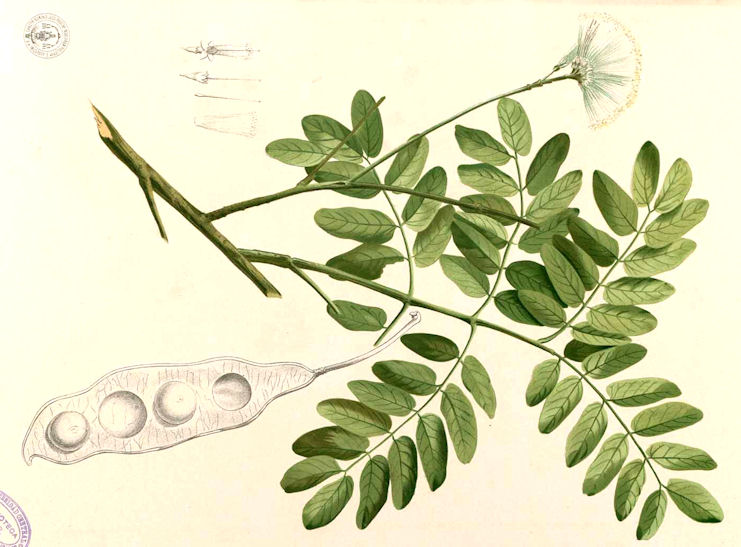
Abb.: शिरीषः । Albizia lebbeck (L.) Benth. 1844 - Lebbekbaum
- Siris Tree
[Bildquelle: Flora de Filipinas, 1880 / Wikipedia. -- Public domain]
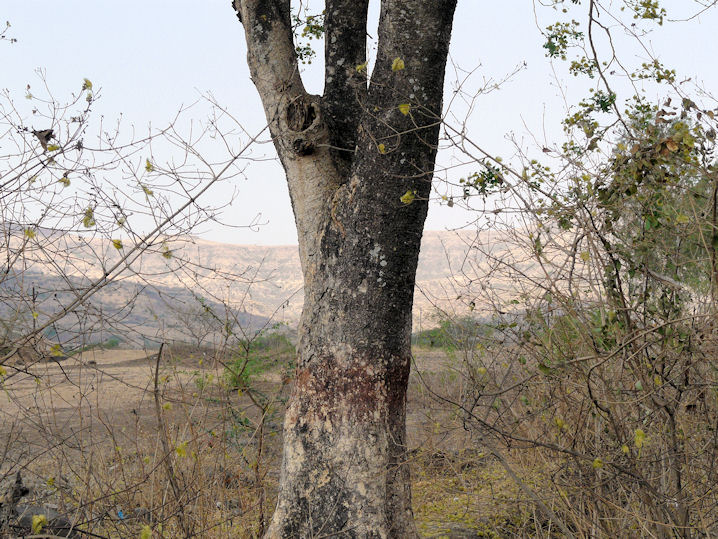
Abb.: कपीतनः । Albizia lebbeck (L.) Benth. 1844 - Lebbekbaum
- Siris Tree, Purandar Taluk -
पुरंदर तालुका,
Maharashtra
[Bildquelle: dinesh_valke. --
http://www.flickr.com/photos/dinesh_valke/3351341667/. -- Zugriff am
2010-10-13. --
Creative
Commons Lizenz (Namensnennung, keine kommerzielle Nutzung, share alike)]
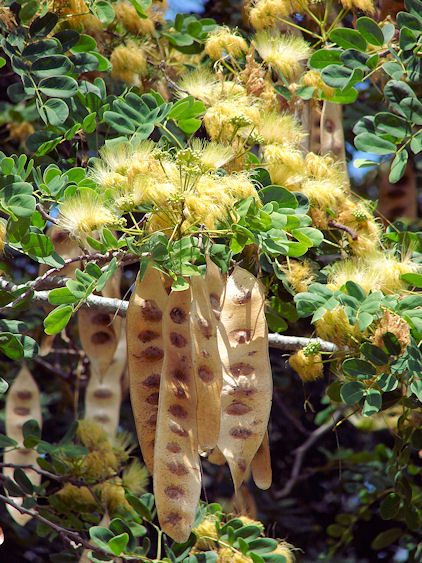
Abb.:
भण्डिलः । Albizia lebbeck (L.) Benth. 1844 - Lebbekbaum
- Siris Tree, Hawaii
[Bildquelle: Forest & Kim Starr. --
http://www.hear.org/starr/images/image/?q=080531-4752&o=plants. -- Zugriff
am 2010-10-11. -- --
Creative Commons
Lizenz (Namensnennung)]
"Mimosa Sirissa. R. [...]
Sirisha, or Shirish in Sanscrit and Bengalee.
This tree is very common in every part of India; all soils and situations seem to please it equally. It grows to be a pretty large tree, but with a short thick trunk covered with ash-coloured bark. It has a very extensive but thin head. Flowering time the hot and rainy season ; the greatest part of its leaves drop during the cold season.
[...]
The wood of this tree, is much like that of M. Xylocarpa, and equally serviceable. The flowers are very fragrant. I have often seen large masses of very pure gum upon it."
[Quelle: Roxburgh, William <1751-1815>: Flora indica, or, Descriptions of Indian plants / by the late William Roxburgh. -- Serampore : Printed for W. Thacker, 1832. -- Vol. 2, S. 544f.]
"Albizia Lebbek (Benth.) Sirissa tree.
Description.--Tree, 30-40 feet, unarmed; [...]
Fl. Aug.-Sept.
Acacia speciosa, Willd.--W. & A. Prod. i. 275.
Mimosa Sirissa, Roxb. Fl. Ind. ii. 554.
Travancore. Coromandel.
Medical Uses.—The seeds are used by the natives in the treatment of piles, and as an astringent in diarrhoea. The flowers are employed in the cure of boils, eruptions, and swellings, and act as antidotes to poisons. The leaves are useful in ophthalmia, and the powdered bark in ulcers, and especially in snake-wounds. The oil extracted from the seeds is given in cases of white leprosy.—Powell's Punj. Prod.
Economic Uses.—A considerable quantity of gum is yielded by this tree, valuable for many ordinary purposes. The timber is very durable, hard, and close-grained, and is employed for furniture. It is of a light colour, and is well adapted for picture-frames and similar work. In Northern India it is considered unlucky to employ the timber in house-building.—(Roxb. Rep. Mad. Exhib.) It is a frequent tree by roadsides, and has a large and umbrageous head. The tree is pollarded, and the cuttings used as firewood. It is now extensively planted on the Ganges Canal. It is of rapid growth, and flourishes in almost any soil. The leaves afford good fodder for cattle.—Bomb. Govt. Rep. 1863."
[Quelle: Drury, Heber <1819 - 1872>: The useful plants of India : with notices of their chief value in commerce, medicine, and the arts. -- 2d ed. with additions and corrections. London : Allen, 1873. -- xvi, 512 p. ; 22 cm. -- s.v.]
"ALBIZZIA LEBBEK, Benth. The Siris tree
ALBIZZIA ODORATISSIMA, Benth.
[...]
History, Uses, &c.--Both trees are known to the natives of India by the same vernacular names, and both are called in Sanskrit Sirisa and Kapitana, and bear the synonyms of Suka-pushpa, Suka-druma, and Suka-priya, "dear to parrots," and Mridu-pushpa, "having soft flowers." According to the Nighantas Siris has cold, tonic, and alterative properties. The author of the Makhzan-el-Adwiya gives a detailed description of the two trees as varieties of one and the same plant, and says that he has been given to understand that the Arabs have named the tree Sultān-el-ashjar, and that the Persian call it Darakht-i-Zakariya. He states that the juice of the leaves is applied to the eyes to cure night-blindness, a decoction being at the same time given internally. A decoction of the bark is used as a mouth-wash to strengthen the gums. One masha of the powdered bark with three or four tolās of melted butter taken daily is an excellent tonic and alterative. A water is also distilled from the bark which is used for the same purposes. The flowers are supposed to be retentive of the seminal fluid. One dirhem of the powdered seeds with two dirhems of sugar-candy in a glass of warm milk taken daily is said to thicken the seminal fluid. A paste made with the seeds is applied to reduce enlarged cervical glands. The seeds are also used in the preparation of collyria. According to Baden-Powell, Stewart, and Madden A. Julibrissin has similar properties. In Madras the bark of A. Lebbek is much used by fishermen for tanning their nets. The heartwood, which is dark brown, hard, and fairly durable, is used for various industrial purposes."
[Quelle: Pharmacographia indica : a history of the principal drugs of vegetable origin met with in British India / by William Dymock [1834-1892], C. J. H. Warden and David Hooper [1858-1947]. -- Bd. 1. -- London, 1890. -- S. 561f.]
Albizia odoratissima (L. f.) Benth. 1844
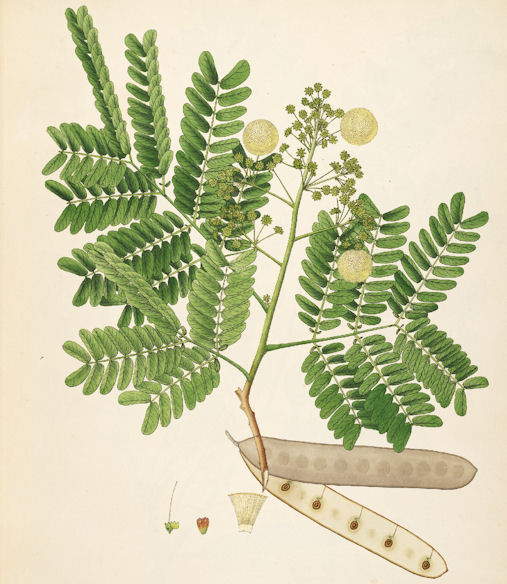
Abb.: Albizia odoratissima (L. f.) Benth. 184+4
[Bildquelle: Roxburgh. -- Vol II. -- 1795. --
Pl. 120. -- Image courtesy Missouri Botanical Garden.
http://www.botanicus.org. --
Creative Commons Lizenz
(Namensnennung, keine kommerzielle Nutzung)]
Zu 2.6. vanauṣadhivargaḥ II, Vers 44 - 62